

Venezuela Travel Guide
Your ultimate venezuela travel guide, with tips, and things to see and things to do in venezuela. great for first-time and returning travelers..
Rich with culture, history, and friendly locals, Venezuela is a chance to see something different.
Located on the northern coast of South America, it is filled with many white-sand beaches, blue waters, and natural wonders, making it a great getaway.
Fans of the outdoors will love Angel Falls, the highest waterfall in the world, or Pico Bolívar, the highest mountain in Venezuela.
As English is not spoken here as much, it presents a great opportunity to immerse yourself in a new language.
This Venezuela travel guide will help you plan your next vacation.
Popular Guides
5 Unexpected Reasons to Visit Venezuela
Our Highlight
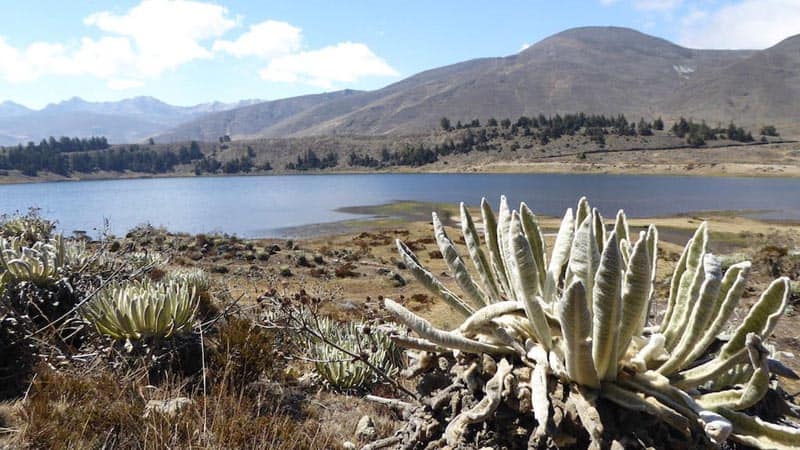
Table of contents
Table of Contents
Fast Facts about Venezuela
- Power voltage is 120V at 60 Hz.
- Venezuela’s currency is the Venezuelan Bolívar and 1 Bolívar is equal to 0.100125 USD.
- The best way to get around Venezuela is by taxi or bus.
- You will need to get a Venezuelan Tourist Visa prior to visiting, as well as a US passport valid for at least 6 months after your stay.
- Crime can and does happen here, so keep valuables close to you and avoid being out at night.
- Popular network providers in Venezuela include Digitel, Movilnet, and Movistar Mobile. Prepaid SIM cards can be purchased through any of these networks. Note that your phone needs to be unlocked in order to use a SIM card, meaning you will probably have to contact your current mobile provider to change your settings to unlocked.
- Venezuela has a sales tax rate of 16%.
Things to See and Do in Venezuela
- Canaima National Park: Fans of natural wonders will love the Canaima National Park. Declared a World Heritage Site, this park is the sixth-biggest national park in the world and is full of beautiful landscapes, diverse fauna, table-top mountains, and cliffs. Points of interest include Angel Falls (the highest waterfall in the world) and Mount Roraima (the highest of the table-top mountains). This park also has camping spots.
- Parque El Agua: Come see Venezuela’s first waterpark. Whether you want to relax in the lazy river or venture through numerous waterslides (including the 18-meters high Churun Meru), this is sure to be a fun day for the whole family.
- Morrocoy National Park: Set on the Caribbean coast of Venezuela, this island is perfect for those looking for a getaway. Relax on white-sand beaches, explore numerous cays (including the very popular Cayo Sombrero), look for dolphins, whales and green sea turtles, and stroll through the nearby towns.
- National Pantheon of Venezuela: Come learn more about Venezuela’s history at this landmark in Caracas. Created in 1870, this mausoleum is now a final resting place for many of the heroes of South America, and also contains historical works of art, including a four-thousand-piece crystal chandelier.
- Teleférico de Caracas: Take a cable lift and enjoy beautiful aerial views of Caracas while you ride to the El Ávila Mountain. Once on top, explore the El Ávila National park, grab a bite to eat, or go to the skating rink.
Venezuela Travel Guides
- 32 of The Tallest Mountains in the World by Continent
- All You Need to know about the Top 10 Best Hikes in South America
Accommodation
Budget: You can find some cheaper hotels at around 200 to 400 Bolívars per night. These hotels come with private rooms, Wi-Fi, and sometimes the hotel’s restaurant and bar.
Mid-Range: For mid-range hotels, expect to pay between 500 to 800 Bolívars per night and enjoy private rooms and suites, an outdoor pool, fitness centers, and one (or more) restaurants inside the hotel.
High-End: Upscale hotels can go from 1,000 to 2,500 Bolívars per night. Amenities include outdoor pools, saunas, massage and salon services, airport transportation, a gift shop, and banquet rooms.
Check out our favorite booking platforms Booking.com , Tripadvisor and VRBO for the best deals on accommodation.
The Best Ways to Get Around Venezuela
Getting to venezuela:.
Getting to Venezuela: The Simón Bolívar International Airport is the main airport for getting to Caracas, the capital of Venezuela, and is just 13 miles from the city center. The La Chinita International Airport is an alternative airport located in Maracaibo (northwest Venezuela), and is just over 9 miles from the downtown area.
Flights: You can check for the best flights to Venezuela on Skyscanner .
Transportation:
Train: The train system for passengers is nonexistent.
Bus: Buses are a cheap way to get around Venezuela and can be found in all major cities and towns. You can find buses for short trips with very cheap fares, as well as buses for long-distance trips that come with their own air-conditioning. You can also look for por puestos, which are essentially a ride share service that operates like a bus. Caracas also has its own metro system that runs frequently, with a typical fare costing less than 5 Bolívars.
Taxis: Taxis are another good way to get around and come with cheap fares compared to other countries. As they do not operate on a meter, it is a good idea to ask around about typical fares so you can negotiate the price with the driver. You can take a taxi for an individual trip or, if you know where you will be traveling, you can contact a travel agency and arrange private taxi transfers between cities.
Rent a car: To rent a car in Venezuela, you need to be at least 21 years old and have a U.S. driver’s license. Prices start at around 400 to 600 Bolívars a day.
You can also compare prices here
When to go To Venezuela
- Venezuela, with its tropical climate, has two seasons: wet and dry. The wet season is between May and October and is considered the best time to see Angel Falls due to the increase in rainfall. March through May are the warmest months in Caracas. For those who want to pursue outdoor activities like hiking, November is a good month to visit due to the warmer temperatures and the start of the dry season. If you’re going to Los Llanos, October may give you the best chance to see wildlife.
Where to Stay in Venezuela
Hotel Waldorf: Stay in this beautiful 3.5-star hotel in Caracas. Its prime location makes it a quick trip to the local movie theaters and beauty shops, as well as the Government Palace. Afterwards, relax in an air-conditioned room or suite, head to the fitness center, lounge in the swimming pool and terrace area, or dine at the sky bar and restaurant.
InterContinental Maracaibo: Featuring beautiful views of the Maracaibo Lake, this four-star hotel is just minutes away from the Vereda del Lago park and the Aguamania waterpark, and just a thirty-minute drive to the La Chinita Airport. InterContinental’s amenities include complimentary breakfast, an Italian restaurant with 2 bars, and an outdoor pool and hot tub. Languages spoken at this hotel include English.
Lidotel Hotel Boutique Barquisimeto: Come stay at this four-star hotel in Barquisimeto. Featuring a grand piano in the lobby and beautiful artwork in the rooms, this stylish hotel also includes a fitness center and outdoor pool, complimentary breakfast, free Wi-Fi, flat-screen TVs in each room, and the hotel’s own restaurant. The Lidotel also includes a private and secure walkway to the nearby shopping mall with many stores.
What to Pack for Venezuela
- Sunscreen: Protect your skin from the beautiful sun with some sunscreen.
- Spanish Phrasebook: As many people do not speak English, bringing a phrasebook to help with translations will help you out.
- Swimsuit: With so many beaches and waters to explore, make sure to bring a swimsuit with you.
See our packing tips: packing tips
Venezuela Travel Guide: Best Booking Resources
Whenever we travel to we make sure to start with these companies. We have tried a lot of different ones over the years and all of these have consistently proven to be the best when it comes to offering great prices.
We have used every one of these personally and continue to do so.
- Booking.com : This is our go site to when comparing prices for accommodation. It usually has the cheapest prices, especially in Europe and we love their interface. Not to mention you get free cancellation and you are guaranteed the best price.
- Trip Advisor : What we like about Trip Advisor is that we can look at all the reviews and then book our accommodation. TripAdvisor is where we go when we want to compare prices with multiple accommodation providers.
- VRBO : is the main search engine we use when we are looking for a home or apartment rental. It can sometimes be cheaper than hotels and it is the best way to stay in areas that offer a more local feel.
- Hostelworld : With one of the largest databases of hostels in the world, Hostelworld is the go-to site when you are looking for budget accommodation.
- Skyscanner : This is the first place we check for flights. It consistently comes back with the cheapest and best options. It allows us to compare a lot of airlines to get the best price.
- Rome 2 Rio : If you want to see how to get somewhere by plane, train, bus, ferry or car Rome2Rio lays it all out for you as well as related costs.I love how they show it all to you on a Google Map and it works offline.
- Get Your Guide: For all your day trip and city guide needs, we use Get Your Guide. It has the world’s largest collection of things to do with more than 30,000 activities in 7500 destinations.
- World Nomads Insurance: When traveling to Italy you should always have travel insurance. We have found the best bang for your buck is by far World Nomads.
Venezuela Travel Guide: Related Articles
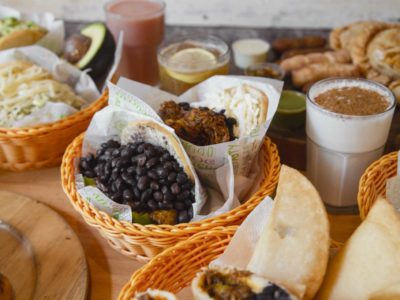
Venezuelan Food: 17 Dishes to try in Venezuela or at Home
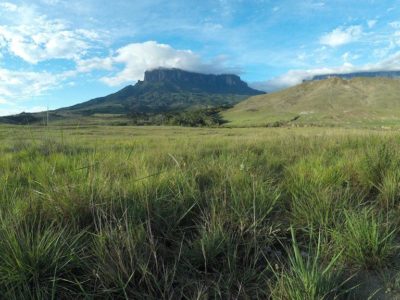

No videos yet!
Click on "Watch later" to put videos here
Venezuela Travel Guide – Everything You Need to Know

Venezuela, a country of stunning natural beauty and diverse landscapes, beckons travelers with its rich cultural heritage and vibrant traditions. Nestled in northern South America, this South American gem boasts the towering Andes Mountains, pristine Caribbean coastlines, and the mesmerizing wonders of the Amazon Rainforest. From exploring the vibrant streets of Caracas to unwinding on idyllic beaches and embarking on thrilling adventures in the wild, Venezuela offers a myriad of experiences for the adventurous traveler. Explore the country’s unique mix of cultures, savor its flavorful cuisine, and discover its remarkable biodiversity in the heart of Latin America.
What’s the Best Time to Visit? 📅
The best time to visit Venezuela as a tourist largely depends on your preferences and the type of experiences you seek, as the country has diverse climates and attractions. Here are two distinct seasons to consider:
- Dry Season (December to April): This is generally the most popular time to visit Venezuela. During the dry season, you can expect pleasant weather with clear skies and minimal rainfall. It’s an excellent time for outdoor activities, hiking, and exploring the country’s natural wonders, such as Angel Falls and Canaima National Park. Coastal areas, including the Caribbean beaches, are also great for sunbathing and water sports during this period.
- Rainy Season (May to November): The rainy season in Venezuela can bring heavy rains and occasional flooding, especially in low-lying areas. However, this period is ideal for birdwatching, as migratory birds flock to the country’s wetlands and rainforests. The lush landscapes and waterfalls are at their most impressive during the rainy season. Keep in mind that some roads and outdoor activities may be disrupted by rain.
It’s important to note that Venezuela’s climate can vary from region to region due to its diverse geography. Coastal areas have a tropical climate, while the Andes Mountains experience cooler temperatures. The Amazon Rainforest region is hot and humid year-round.
Before planning your trip, check the specific weather conditions for the regions you intend to visit and consider your preferred activities. Additionally, keep abreast of travel advisories and the current political and safety situation in Venezuela, as this can affect your travel plans.
What’s the Best Way to Get Around? 🚌
Getting around Venezuela as a tourist can be both an adventure and a logistical challenge due to the country’s varying geography and infrastructure. Here are the main transportation options for travelers in Venezuela:
- Domestic Flights: Domestic flights are a popular and convenient way to cover long distances quickly. Major cities like Caracas, Maracaibo, Valencia, and Mérida have airports with regular flights. Smaller towns and remote areas may have limited or seasonal flight options.
- Buses: Buses are a common mode of transportation for both short and long journeys within Venezuela. There are various types of buses, including luxury coaches and local buses. The quality and comfort of buses can vary, so choose reputable bus companies for long-distance travel.
- Collectivos: These shared vans or minibuses operate on fixed routes and are a cost-effective way to travel within cities and to nearby towns. They can be crowded but offer a more flexible schedule than buses.
- Taxis: Taxis are widely available in cities, and they can be an efficient way to get around, especially for short distances. Ensure that the taxi has a working meter, or agree on the fare in advance. In some areas, shared taxis (colectivos) are common.
- Motorcycle Taxis: Motorcycle taxis, known as “mototaxis,” are a popular mode of transportation in some cities and towns. Negotiate the fare before the ride and prioritize safety by wearing a helmet.
- Car Rentals: Renting a car can provide flexibility, especially for exploring remote areas and national parks. However, road conditions can vary, and driving in Venezuela may require familiarity with local traffic rules and safety precautions.
- Ferries: If you plan to visit islands or coastal areas, ferries are available. Popular destinations include Margarita Island and Los Roques Archipelago.
- Trains: Venezuela has limited passenger train services, and they are not commonly used by tourists for transportation. Trains may be more of a scenic experience than a practical means of travel.
- Walking: In cities and towns, walking can be a pleasant way to explore local neighborhoods and attractions. Be aware of traffic and pedestrian safety.
- Cable Cars: Some areas, such as Mérida, offer cable car systems that provide stunning views of the surrounding landscapes. These are more of a tourist attraction than a mode of transportation.
It’s important to note that the political and economic situation in Venezuela can affect transportation services and safety. Travelers should stay informed about the current conditions, follow any travel advisories, and exercise caution when moving around the country.
Additionally, while traveling within Venezuela, always carry essential items like water, snacks, and cash, as access to services may be limited in some regions. Be prepared for unexpected delays and changes in plans, and prioritize safety in all your travel choices.
What’s the Official Language?
The official language of Venezuela is Spanish. Here are some basic Spanish phrases and words that can be helpful for tourists:
- Hello – Hola (oh-lah)
- Good morning – Buenos días (bway-nos dee-ahs)
- Good afternoon – Buenas tardes (bway-nas tar-days)
- Good evening / Good night – Buenas noches (bway-nas noh-chays)
- Please – Por favor (por fah-vor)
- Thank you – Gracias (grah-syahs)
- Yes – Sí (see)
- No – No (noh)
- Excuse me / I’m sorry – Perdón (pair-don)
- What is your name? – ¿Cómo te llamas? (koh-moh teh yah-mahs?)
- My name is [Your Name] – Me llamo [Your Name] (meh yah-moh [Your Name])
- How much is this? – ¿Cuánto cuesta esto? (kwan-to kwesta eh-sto?)
- Water – Agua (ah-gwah)
- Food – Comida (koh-mee-dah)
- Bathroom / Toilet – Baño (bahn-yoh)
- Help – Ayuda (ah-yoo-dah)
- I don’t understand – No entiendo (noh en-tee-ehn-doh)
- I need assistance – Necesito ayuda (neh-seh-see-toh ah-yoo-dah)
- Where is…? – ¿Dónde está…? (don-deh ehs-tah…?)
- I’m lost – Estoy perdido/a (ehs-toy pair-dee-doh/ah)
Learning some basic Spanish phrases can enhance your travel experience in Venezuela, as many Venezuelans may have limited proficiency in English, especially in rural areas. Being able to communicate in Spanish will help you navigate and interact more easily with locals.
Where to Stay? 🏨
Venezuela offers a range of accommodation options for tourists, from luxury hotels to budget-friendly guesthouses and hostels. Where you choose to stay depends on your budget, travel itinerary, and preferences. Here are some popular places to consider when looking for accommodation in Venezuela:
- Caracas: As the capital and largest city, Caracas has a wide selection of hotels, including upscale options in the Altamira and Las Mercedes neighborhoods. It’s a convenient base for exploring the city’s cultural attractions and museums.
- Margarita Island: Known for its stunning beaches, Margarita Island offers a variety of beachfront resorts, boutique hotels, and vacation rentals. Popular areas to stay include Playa El Agua and Playa Parguito.
- Los Roques Archipelago: If you’re looking for an idyllic beach getaway, consider staying in one of the eco-lodges or posadas on Los Roques. This national park is famous for its white-sand beaches and crystal-clear waters.
- Canaima National Park: For a unique experience, stay in a camp or lodge within Canaima National Park. It’s the gateway to Angel Falls and offers an opportunity to immerse yourself in the natural beauty of the region.
- Mérida: This Andean city is popular among travelers for its outdoor activities and cultural attractions. Mérida has a range of accommodations, from boutique hotels to hostels catering to backpackers.
- Maracaibo: The second-largest city in Venezuela, Maracaibo offers various hotels and guesthouses. It’s known for its lively atmosphere and the famous Maracaibo Lake.
- Puerto La Cruz: This coastal city along the Caribbean coast has numerous beachfront resorts and hotels, making it a suitable destination for relaxation and water activities.
- Andes Region: If you’re interested in exploring the Andes Mountains and its beautiful landscapes, consider staying in towns like San Cristóbal or Trujillo, where you can find guesthouses and lodges.
- Amazon Region: Lodges and eco-friendly accommodations are available for those exploring the Amazon Rainforest in southern Venezuela.
- Small Coastal Towns: Along the Caribbean coast, there are charming small towns and fishing villages where you can find budget-friendly accommodations, providing an authentic and peaceful experience.
- Hostels and Guesthouses: Throughout Venezuela, you can find hostels and guesthouses that cater to backpackers and budget-conscious travelers. These are often more affordable options with a communal atmosphere.
Keep in mind that the political and economic situation in Venezuela has affected the availability and quality of accommodations in some areas. Before booking, research the current status of the accommodation, read reviews, and check for any travel advisories. It’s advisable to book accommodations in advance, especially during peak tourist seasons, and carry sufficient cash, as credit card acceptance may be limited in some places.
What to Eat? 🍽️
Venezuela boasts a rich culinary heritage, with a variety of delicious dishes that reflect its diverse culture and ingredients. Here are some must-try Venezuelan foods for tourists:
- Arepas: These versatile and iconic Venezuelan snacks are made from cornmeal and can be stuffed with a variety of fillings such as cheese, shredded beef, chicken, or beans. They are a staple of Venezuelan cuisine and come in various shapes and sizes.
- Pabellón Criollo: This traditional Venezuelan dish consists of shredded beef, black beans, white rice, and fried plantains. It’s often accompanied by a simple salad or avocado.
- Empanadas: Venezuelan empanadas are savory turnovers filled with ingredients like ground beef, cheese, chicken, or seafood. They’re deep-fried to crispy perfection and make for a popular street food snack.
- Cachapas: Cachapas are thick, sweet corn pancakes made from fresh corn kernels. They are usually served with cheese or a slice of salty cheese, creating a delightful sweet-savory combination.
- Tequeños: These are cheese-filled sticks or rolls wrapped in thin dough and fried until golden brown. Tequeños are a popular appetizer or snack in Venezuela.
- Hallaca: Often prepared during the Christmas season, hallacas are a type of tamale made with a cornmeal dough filled with a mixture of meat, olives, capers, raisins, and spices. The hallaca is wrapped in plantain leaves and boiled.
- Caraotas Negras: This dish features black beans cooked with spices, including onions, bell peppers, and garlic. It’s often served as a side dish with rice and meat.
- Chicha: A traditional Venezuelan drink made from fermented rice or maize. It can be sweet or slightly fermented and is often flavored with cinnamon or vanilla.
- Pepitona: A popular seafood dish, pepitona features small, marinated sea snails served with a tangy sauce. It’s a coastal delicacy.
- Pescado Frito: Enjoy a taste of the Caribbean with deep-fried fish, often served with sides like coconut rice, fried plantains, and a zesty garlic sauce.
- Ajiaco: This hearty soup features a variety of vegetables and meats, including beef, chicken, and pork. It’s seasoned with spices and herbs, making it a flavorful comfort food.
- Tizana: A refreshing fruit punch made with a mix of tropical fruits, such as papaya, watermelon, and pineapple, served with ice and sometimes a splash of rum.
- Dulce de Lechosa: A sweet treat made from green papaya cooked with sugar and spices until it becomes a thick, syrupy dessert.
- Cachito: A savory pastry filled with ham or other ingredients, perfect for breakfast or a quick snack.
- Quesillo: A Venezuelan flan dessert made from condensed milk, eggs, sugar, and vanilla, often drizzled with caramel sauce.
Exploring Venezuelan cuisine is an integral part of experiencing the country’s culture. Whether you’re dining at a local restaurant, enjoying street food, or savoring traditional dishes, you’ll find a rich tapestry of flavors to delight your taste buds.
What to See? 🔍
Venezuela is blessed with an array of stunning natural landscapes, historic sites, and vibrant cities that offer a wide range of must-see attractions for tourists. Here are some of the top places to visit in Venezuela:
- Angel Falls: The world’s highest uninterrupted waterfall, Angel Falls is a breathtaking natural wonder located in Canaima National Park. You can take guided tours to witness this awe-inspiring sight.
- Canaima National Park: This UNESCO World Heritage Site is renowned for its dramatic tabletop mountains, lush jungles, and pristine waterfalls. Explore the park’s diverse ecosystems, including the Gran Sabana region.
- Mérida: This charming Andean city is known for the Mérida Cable Car, one of the world’s highest cable cars. It offers stunning views of the Andes Mountains and opportunities for hiking and adventure sports.
- Los Roques Archipelago: An idyllic Caribbean paradise, Los Roques is famous for its white sandy beaches, crystal-clear waters, and excellent snorkeling and diving. It’s a protected national park and marine reserve.
- Margarita Island: This island in the Caribbean Sea boasts beautiful beaches, including Playa El Agua and Playa Parguito. It’s a popular destination for relaxation and water sports.
- Morrocoy National Park: A coastal gem, Morrocoy National Park features a labyrinth of cays, islets, and pristine beaches. It’s an ideal spot for boating, snorkeling, and sunbathing.
- Roraima: Trek to Mount Roraima, one of the table mountains known as tepuis. This challenging adventure offers unique landscapes and the opportunity to explore unique flora and fauna.
- Orinoco Delta: Discover the biodiversity of the Orinoco Delta by taking boat tours through its intricate network of waterways. It’s a paradise for birdwatchers and nature enthusiasts.
- Medanos de Coro National Park: Explore the vast sand dunes of Medanos de Coro, a surreal desert landscape located near the city of Coro. Sandboarding is a popular activity here.
- Historic Cities: Visit the historic cities of Coro and Ciudad Bolívar, both UNESCO World Heritage Sites, to admire well-preserved colonial architecture and learn about Venezuela’s history.
- Parque Nacional Henri Pittier: Venezuela’s first national park, Henri Pittier offers a diverse range of flora and fauna, along with hiking trails and beautiful beaches.
- Caracas: The capital city of Venezuela, Caracas is home to cultural attractions such as the National Pantheon, Bolívar Square, and numerous museums.
- Cerro Autana: An isolated tabletop mountain in the Amazon Rainforest, Cerro Autana is a remote and challenging destination for adventurous trekkers.
- Cueva del Guácharo National Park: Explore the cave system in this park, home to thousands of oilbirds (guácharos). Guided tours take you deep into the caves to witness these unique nocturnal birds.
- La Gran Sabana: This vast savannah region in southeastern Venezuela is known for its unusual flat-topped mountains, known as tepuis. Explore the indigenous Pemon villages and stunning landscapes.
Remember to check the current safety and travel advisories before planning your visit to Venezuela, as the country has faced challenges in recent years. Additionally, it’s advisable to travel with a local guide, especially when visiting remote or less-developed areas.
What to Do? 📸
Venezuela offers a wide range of exciting and enriching experiences for tourists. Here are some must-do activities and things to enjoy during your visit to this diverse South American country:
- Visit Angel Falls: Witness the world’s highest uninterrupted waterfall, Angel Falls, by taking a guided tour to Canaima National Park. The hike and boat trip to the falls offer incredible views.
- Explore Canaima National Park: Immerse yourself in the beauty of this UNESCO World Heritage Site, known for its tabletop mountains, stunning landscapes, and indigenous Pemon culture.
- Hike Roraima: Embark on a challenging trek to Mount Roraima, one of Venezuela’s iconic table mountains (tepui), to experience unique landscapes and a sense of adventure.
- Enjoy the Beaches: Relax on the Caribbean beaches of Margarita Island, Los Roques, and Morrocoy National Park. Try water sports like snorkeling, diving, and windsurfing.
- Go Wildlife Watching: Explore Venezuela’s diverse ecosystems and spot unique wildlife, including jaguars, capybaras, caimans, and various bird species in national parks and reserves.
- Try Traditional Venezuelan Cuisine: Savor delicious Venezuelan dishes like arepas, pabellón criollo, cachapas, and empanadas. Don’t forget to try local specialties in each region.
- Experience Mérida Cable Car: Take a thrilling ride on the Mérida Cable Car, one of the world’s highest cable cars, and enjoy panoramic views of the Andes Mountains.
- Visit Los Llanos: Explore the vast plains of Los Llanos, where you can go on wildlife safaris, ride horses, and experience the traditional cowboy culture of Venezuela.
- Discover Orinoco Delta: Take boat tours through the intricate waterways of the Orinoco Delta, where you can observe wildlife and learn about the indigenous Warao culture.
- Sandboard in Medanos de Coro: Try sandboarding on the dramatic sand dunes of Medanos de Coro National Park near Coro. It’s a thrilling and unique experience.
- Explore Historic Cities: Visit UNESCO-listed cities like Coro and Ciudad Bolívar to admire colonial architecture and learn about the country’s history.
- Go Birdwatching: Venezuela is a paradise for birdwatchers, with diverse avian species found in national parks and rainforests. Don’t forget your binoculars.
- Stargaze in the Andes: Head to the Andes region, such as Mérida, for excellent stargazing opportunities. The clear mountain skies make it ideal for astronomy enthusiasts.
- Discover Indigenous Culture: Learn about the indigenous cultures of Venezuela by visiting Pemon villages in the Gran Sabana or Warao communities in the Orinoco Delta.
- Enjoy Traditional Music and Dance: Attend local festivals and events to experience traditional Venezuelan music genres like joropo and salsa, and witness lively dance performances.
- Cave Exploration: Explore the underground world of Venezuela by visiting caves like Cueva del Guácharo National Park, known for its oilbirds (guácharos).
- Climb Cerro Autana: For the ultimate adventure, embark on a challenging trek to the remote Cerro Autana, an isolated tepui in the Amazon Rainforest.
- Take a Boat Tour to Remote Islands: Discover remote islands and pristine beaches by taking boat tours to places like Los Testigos and Cubagua Island.
- Learn About Cocoa Production: Visit cocoa plantations and learn about the process of making chocolate, an important part of Venezuela’s agricultural heritage.
- Immerse in the Amazon Rainforest: Explore the diverse ecosystems of the Amazon Rainforest, from wildlife watching to learning about medicinal plants from indigenous guides.
Before planning your activities in Venezuela, it’s essential to check the current travel advisories, safety conditions, and any specific requirements for certain destinations or activities. Additionally, consider the seasonal variations in weather when planning outdoor adventures.
Culture and Safety 🦺
Traveling to Venezuela as a tourist can be a rewarding experience, but it’s important to be aware of the local culture and take safety precautions due to certain challenges in the country. Here are some cultural and safety tips for tourists in Venezuela:
- Respect Local Customs: Venezuelans are generally warm and welcoming. Politeness and respect for local customs are appreciated. Greet people with a friendly “Hola” (hello) and use polite titles such as “Señor” (Mr.) or “Señora” (Mrs.) when addressing individuals.
- Learn Basic Spanish: While some Venezuelans may speak English, especially in tourist areas, having a basic understanding of Spanish can enhance your experience and facilitate communication with locals.
- Dress Modestly: In urban areas, casual attire is generally acceptable. However, in more conservative or rural areas, it’s advisable to dress modestly and avoid revealing clothing.
- Be Respectful of Religion: Venezuela has a predominantly Catholic population, and religious traditions are significant. Be respectful when visiting churches and religious sites.
- Tipping: Tipping is customary in restaurants, and a tip of around 10% is generally appreciated. Tipping for other services, such as guided tours or hotel staff, is also customary.
- Safety in Numbers: It’s often safer to explore cities and attractions in groups or with a guide, especially in less touristy areas.
- Photography: Always ask for permission before taking photos of people, especially in indigenous communities or sensitive areas. In some cases, photography may be restricted.
- Stay Informed: Keep up-to-date with the latest travel advisories and safety information for Venezuela. The political and economic situation in the country can affect safety conditions.
- Avoid Risky Areas: Some areas of Venezuela may have higher crime rates and security concerns. Research your destination and be cautious when traveling in unfamiliar neighborhoods, particularly at night.
- Use Reputable Transportation: Choose well-established and reputable transportation providers, especially when using taxis or public transportation. Always confirm the fare or use metered taxis.
- Carry a Copy of Documents: Make photocopies of your passport, visa, and important documents, and keep them in a separate location from the originals. Leave a copy with a trusted contact at home.
- Money Safety: Be cautious when handling money and avoid displaying large sums of cash in public. Use ATMs in well-lit and secure locations.
- Avoid Political Protests: Steer clear of political demonstrations, rallies, and gatherings, as these can become volatile. Stay informed about any planned protests in the area.
- Stay Hydrated and Informed: Venezuela’s tropical climate can be hot and humid. Stay hydrated, use sunscreen, and be prepared for varying weather conditions.
- Emergency Numbers: Familiarize yourself with local emergency contact numbers for medical services, authorities, and your embassy or consulate.
- Travel Insurance: Ensure you have comprehensive travel insurance that covers medical emergencies, evacuations, and theft or loss of belongings.
- Use Caution at Border Areas: If traveling near Venezuela’s borders, be aware of potential security risks and immigration requirements. Check the latest information regarding border crossings.
While Venezuela offers many attractions and cultural experiences, it’s essential to exercise caution and stay informed during your visit. Be flexible with your travel plans, as conditions can change rapidly. Always prioritize your safety and well-being while exploring this beautiful country.
In conclusion, Venezuela captivates tourists with its breathtaking natural landscapes, rich cultural tapestry, and warm hospitality. From the Andes Mountains to the Caribbean coast, this South American nation offers diverse experiences for travelers. However, it’s crucial to consider safety and be mindful of the current political and economic situation in the country. With proper planning and precautions, visitors can uncover the hidden treasures of Venezuela, making it a rewarding and unforgettable destination for those seeking adventure and exploration.
You may also like

State of Palestine Travel Guide – Everything You Need to Know

South Sudan Travel Guide – Everything You Need to Know

Democratic Republic of the Congo Travel Guide – Everything You Need to Know
Travel destinations.
- Experiencing Australia 20
- Experiencing Cambodia 5
- Experiencing China 24
- Experiencing Cruise 6
- Experiencing France 5
- Experiencing Germany 3
- Experiencing Indonesia 10
- Experiencing Italy 11
- Experiencing Japan 10
- Experiencing Korea 7
- Experiencing Malaysia 6
- Experiencing Maldives 7
- Experiencing Myanmar 10
- Experiencing New Zealand 17
- Experiencing Singapore 15
- Experiencing Switzerland 4
- Experiencing Taiwan 14
- Experiencing Thailand 18
- Experiencing Vietnam 5
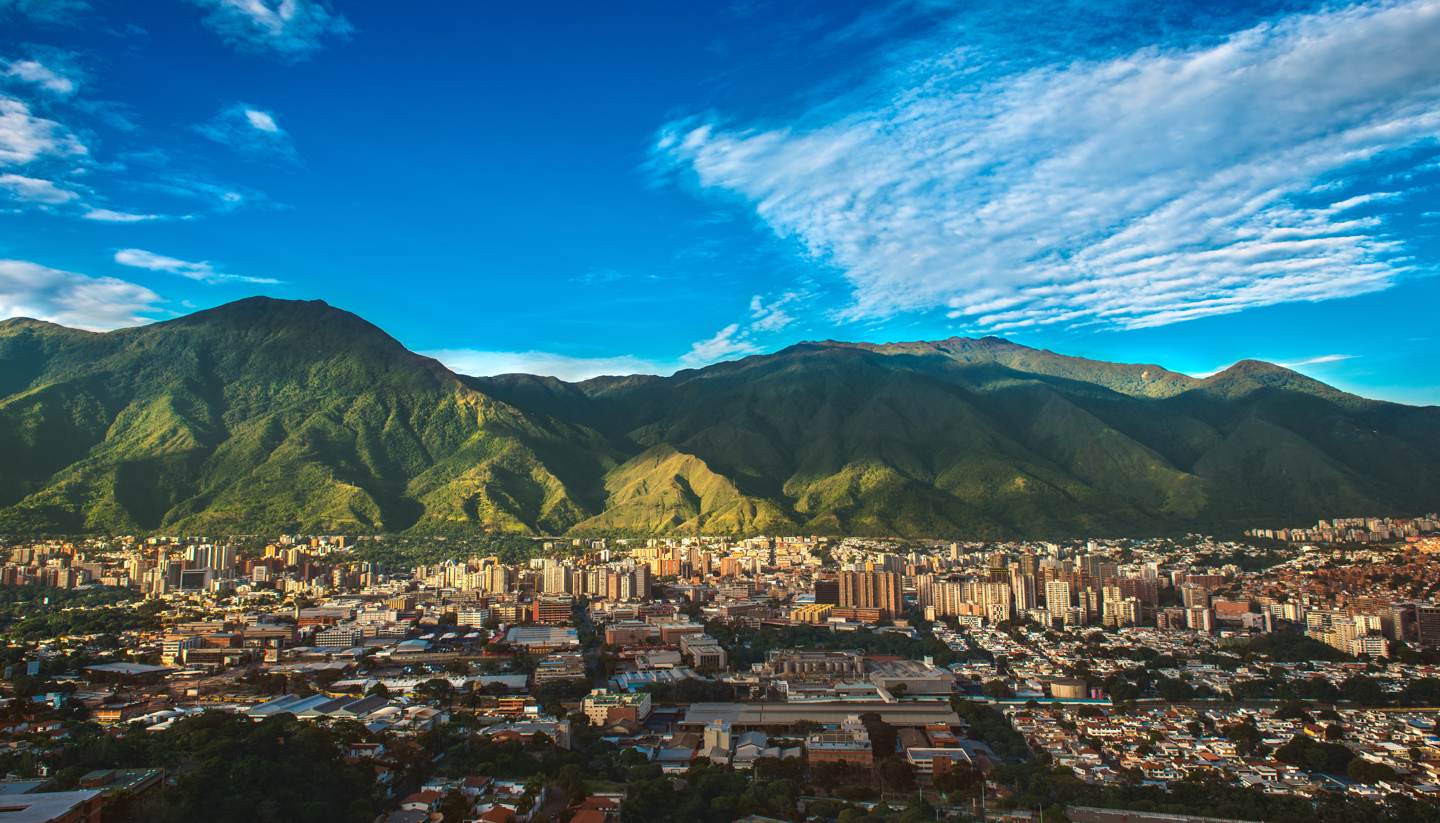
Introducing Venezuela
About venezuela.
- Images of Venezuela
- History, language & culture
- Weather & geography
- Doing business & staying in touch
Plan your trip
- Travel to Venezuela
- Where to stay
While you’re there
- Things to see & do
- Shopping & nightlife
- Food & drink
- Getting around
Before you go
- Passport & visa
- Public Holidays
- Money & duty free
Book your flights
- Caracas Simón Bolívar International Airport
Cruise Locations
- Isla Margarita
Venezuela travel guide
With its reputation for violence and political instability, many travellers opt to give Venezuela a wide berth. But those brave enough to visit this feisty South American nation will discover a country of extraordinary diversity and abundant natural beauty; a land of lofty Andean peaks, mysterious Lost World plateaus, wildlife rich rainforests, vibrant cities and idyllic Caribbean islands. At the heart of all this lies Caracas, Venezuela’s thronging capital. A hotchpotch of hillside favelas, crumbling colonial buildings and glistening skyscrapers, the city has much to offer visitors; there’s a fine collection of museums, galleries and historic monuments, not to mention a pulsating nightlife. Even the food’s good, nowadays. But for all its appeal, most of Venezuela’s attractions lie beyond the capital city, hidden away in national parks and reserves which cover an impressive 40% of the country.
The lush tropical lowlands of Los Llanos harbour abundant wildlife, with eco-conscious hatos (ranches) offering safaris to view caiman, puma, anaconda, capybara, hundreds of birds and much more. Then there are the table-top mountains of the Guyana Highlands, whose summits loom over golden savannahs and bristle with prehistoric flora and fauna. These towering peaks spawn dramatic waterfalls, including the awesome Angel Falls, officially the world’s highest.
Those with an appetite for adventure can be sated with an excursion into the virgin rainforest of Amazonas, Venezuela’s least-visited region, where indigenous communities cling onto traditional lives in the jungle. Alternatively, head to Mérida to tackle the soaring Andean peaks or go piranha fishing in the Orinoco, South America’s second longest river, which empties into the wildlife-rich wetlands of the Orinoco Delta.
Beyond that, the clear waters of the Caribbean lap onto Venezuela’s stunning coastline, where numerous offshore islands provide ample opportunities for reef diving, partying and pandering to pleasure. Amongst them the Los Roques archipelago, which is the epitome of Caribbean island idyll and a very long way from the unsavoury headlines of the mainland.
912,050 sq km (352,144 sq miles).
31,518,855 (UN estimate 2016).
32.1 per sq km.
Interim-President Juan Guaidó since 2019.
Travel Advice
The Foreign, Commonwealth & Development Office ( FCDO ) provides advice about risks of travel to help British nationals make informed decisions. Find out more about FCDO travel advice .
Areas where FCDO advises against travel
Your travel insurance could be invalidated if you travel against FCDO advice.
Within 80km of the Venezuela-Colombia border
FCDO advises against all travel to within 80km (50 miles) of the border with Colombia. Drug traffickers and illegal armed groups are active along the border area with Colombia and there is a risk of criminal kidnapping.
Zulia State
FCDO advises against all travel to Zulia State, which has prolonged power cuts, water shortages, violence and local conflict.
Within 40km of the Venezuela-Brazil border
FCDO advises against all travel to within 40km (25 miles) of the border with Brazil. Drug traffickers and illegal armed groups are active along the border area with Brazil and there is a risk of criminal kidnapping.
All other areas of Venezuela
FCDO advises against all but essential travel to the remaining areas of Venezuela, due to ongoing crime and instability.
Before you travel
No travel can be guaranteed safe. Read all the advice in this guide and see support for British nationals abroad for information about specific travel topics.
Follow and contact FCDO travel on Twitter , Facebook and Instagram . You can also sign up to get email notifications when this advice is updated.
Travel insurance
If you choose to travel, research your destinations and get appropriate travel insurance . Insurance should cover your itinerary, planned activities and expenses in an emergency.
This advice reflects the UK government’s understanding of current rules for people travelling on a full ‘British citizen’ passport from the UK, for the most common types of travel.
The authorities in Venezuela set and enforce entry rules. If you’re not sure how these requirements apply to you, contact the Venezuelan Embassy in the UK (in Spanish).
COVID-19 rules
There are no COVID-19 testing or vaccination requirements for travellers entering Venezuela.
Passport validity requirements
To enter Venezuela, your passport must have an ‘expiry date’ at least 6 months after the date you plan to leave.
Check with your travel provider that your passport and other travel documents meet requirements. Renew your passport if you need to.
You will be denied entry if you do not have a travel document or try to use a passport that has been reported lost or stolen.
If you’re a resident in Venezuela, your passport must be valid at the time of your arrival. Your residence visa or permit must also be valid.
Visa requirements
If you arrive by air, you can stay for up to 90 days visa-free on a ‘tourist card’, issued on arrival. You must show your return or onward travel ticket.
If you’re arriving overland or by sea, you may need to get a visa in advance. Contact the nearest Venezuelan embassy or consulate for advice.
You can apply for an extension of up to 90 days before your tourist card and entry stamp expire. Apply and pay the fee at any SAIME (immigration service) office (in Spanish). If you live in Venezuela, you must apply at the main regional SAIME office of the state where you are living.
If you overstay your allowed time, you may be arrested and fined when leaving Venezuela.
Dual nationality
If you’re a Venezuelan dual national, you must use your Venezuelan identity documents for entry and departure of the country. The authorities may not allow you to depart Venezuela if you are not in possession of a valid Venezuelan passport, as required by law.
Travelling with children
Children travelling unaccompanied, with a guardian, or with one parent, must provide a travel permit from the non-travelling parent(s). This permit is available from the nearest local SAREN (Servicio Autónomo de Registros y Notarías) office, or the respective Court for Children and Adolescents.
If the child is resident overseas, you can get the permit from the nearest Venezuelan embassy or consulate .
The child should carry this travel permit while travelling within the country and also at time of departure from Venezuela. Children may be denied exit from the country otherwise.
Vaccination requirements
At least 8 weeks before your trip, check the vaccinations and certificates you need in TravelHealthPro’s Venezuela guide .
Depending on your circumstances, this may include a yellow fever certificate.
Customs rules
There are strict rules about goods you can take into or out of Venezuela (in Spanish). You must declare anything that may be prohibited or subject to tax or duty.
You must declare any goods, including personal luggage, worth more than 1,000 US dollars. You may have to pay import tax if your goods appear to be new.
Taking money into Venezuela
Declare cash or travellers cheques worth 10,000 US dollars or more when entering Venezuela. You must pay tax on the excess.
Local banknotes are in short supply. Most people use card payments, bank transfers and US dollars instead. You may need to attempt debit or credit card transactions several times due to poor connectivity.
If you find your bank cards do not work, you can arrange for friends and family overseas to deposit funds through Western Union and pick up the deposited funds at any Grupo Zoom branch.
You should also read FCDO ’s overall travel advice and regional risks advice .
There is a high threat of terrorist attack globally affecting UK interests and British nationals, including from groups and individuals who view the UK and British nationals as targets. You should remain vigilant at all times.
UK Counter Terrorism Policing has information and advice on staying safe abroad and what to do in the event of a terrorist attack. Find out how to reduce your risk from terrorism while abroad .
Terrorism in Venezuela
Terrorist attacks in Venezuela cannot be ruled out.
Political and economic situation
The UK does not accept the legitimacy of the current administration put in place by Nicolás Maduro. National presidential elections are due to be held in 2024.
Basic public services including health care and security, and the supply of electricity, water and fuel, have deteriorated in the last decade. Prolonged power cuts affect living conditions and cut mobile networks and internet. There are serious shortages of everyday essentials. Consider storing tinned food and water.
Avoid political rallies and demonstrations, as they may turn violent and the police and army use tear gas and buckshot to control crowds. Monitor developments closely and keep up to date with this travel advice.
Commercial flights to and from Venezuela remain very limited. Caracas International Airport is often affected during power failures, causing what few flights there are to be delayed or cancelled. Keep in close contact with your airline or travel agent to see if your flight is affected.
Venezuela has one of the highest murder rates in the world. Armed robbery, mugging, carjacking and burglary are all very common and often accompanied by extreme violence. Do not resist an attacker. Remain alert and avoid displaying electronics or valuables while on the street or in a vehicle.
Private security services are becoming standard for business and official visitors and residents. Armoured vehicles are commonly used in Caracas, especially after dark and for transport to and from the airport.
Avoid public transport. A number of robberies at gunpoint have taken place on the Caracas metro. There are regular reports of passengers being robbed on public buses.
Use pre-booked taxis only. Hotels will normally book a taxi from a reputable company or supply their own service.
Laws and cultural differences
Personal id.
Always carry identification with you. You can carry copies of the photo page of your passport and your entry stamp. Keep your passport in a safe place where you can access it quickly if you need to. Local security forces may ask you to show ID at any time, particularly at police checkpoints. If you cannot produce it, you could be arrested and detained pending an investigation.
Illegal drugs and prison sentences
Drug trafficking is a serious crime in Venezuela. Detection methods are sophisticated, and drug traffickers should expect to be arrested. Conviction leads to a lengthy prison sentence of between 8 and 15 years. Conditions in Venezuelan jails are harsh and dangerous, and among the worst in the region.
Using cameras and binoculars in secure areas
It is illegal to photograph military or strategic installations, including military airports and the presidential palace. Avoid plane spotting.
Networks and internet
Internet service is generally slow as high speed connections are not widely available. Mobile network operators run modern 4G (LTE) networks in most major cities, while they also operate slower legacy 3G (WCDMA) networks for their nationwide voice and data services.
Power cuts can affect mobile signals and internet across the whole country, including Caracas. Keep in contact with your airline or travel agent as flights can be delayed or cancelled when there are power cuts.
LGBT+ travellers
Same-sex relationships are not illegal. However, showing affection in public will most likely be frowned on by locals and may draw negative attention from the police and other security forces. Venezuelan law does not recognise same-sex partnerships, so same-sex partners have no rights as next of kin.
Read more advice for LGBT+ travellers .
Age of consent
The age of consent in Venezuela is 18 and sex with anyone 17 and under is illegal. Offenders face long jail sentences.
Outdoor activities
Swimming safety.
The waters of the Caribbean can be deceptive. There are strong currents and undertows in some areas that can make swimming hazardous. Lifeguards and warnings are not normally in place.
Transport risks
Travelling to and from maiquetia airport, caracas.
Be especially vigilant around Maiquetia airport as this is a known hotspot for criminal activity, from low-level pickpocketing to armed robberies. You could be targeted at the arrival or departure terminals, at the airport’s car park and during travel to or from the airport. If you show signs of wealth this could lead to targeting by criminals.
You are at most risk when travelling to and from the airport at night. There have been armed robberies on buses on this route. Ideally, arrange for friends, business contacts or your tour operator to meet you at the airport. If that’s not possible, consider travelling by licensed taxi from the official taxi rank outside the arrivals hall. Do not accept offers of transport in the arrivals hall and do not get into a taxi if there are passengers already in the car.
The National Guard carries out random drug and security checks at Maiquetia Airport, particularly on departure. Departing passengers are sometimes asked to accompany an officer to a local hospital for an X-ray. Beware of bogus security officials. If you’re in any doubt ask other airline or airport staff.
Road travel
If you are planning to drive a hire car or a UK vehicle, see information on driving abroad .
You can use a UK photocard driving licence to drive in Venezuela for up to one year, and after that you will need a Venezuelan driving licence. If you still have a paper driving licence, you may need to update it to a photocard licence or get the correct version of the international driving permit (IDP) as well.
Heavy rains and lack of maintenance can affect road conditions. Get local advice about your route before you set out, leave plenty of time for your journey and keep to the main roads. Avoid travelling after dark. All vehicles must carry a spare tyre, wheel block, jack and reflector triangle.
Fuel shortages are common across all parts of the country. You must pay a set amount of US dollars for the amount of fuel you need, rather than simply filling up the tank. Pay the correct price, as petrol stations do not usually give any change. You should check the local situation ahead of any travel.
There are regular police and National Guard checkpoints throughout the country. Drive slowly through these and stop if asked. There have been reports of attempts by the police and National Guard to extract bribes for traffic offences, so ask for a written record giving details of the offence and the officer’s details.
Driving under the influence of alcohol is illegal but common, especially at weekends. Many vehicles are in poor condition and drivers routinely ignore red lights.
If you’re in a traffic accident, you must stay at the scene until the traffic police arrive. Police can seize your vehicle if you cannot show them your insurance documents, driving licence and passport. You can show a copy of your passport as long as you can show both the photo page and the entry stamp. Insurance companies will not pay claims on vehicles that have been moved without a police accident report.
The UK Air Safety List ( ASL ) lists all known airlines in Venezuela that do not meet international safety standards and are banned from operating commercial air services to and from the UK. Check the ASL when considering which airlines to fly with. The list is maintained by the Department for Transport, based on advice from the UK Civil Aviation Authority . The UK Civil Aviation Authority .
Check whether your tour operator has concerns about airlines in Venezuela.
There have been incidents of piracy and armed robbery in and around Venezuela’s waters, especially east of Puerto La Cruz and in waters between Venezuela and Trinidad and Tobago. Avoid these areas if possible, or follow advice for British nationals on piracy and armed robbery at sea .
Extreme weather and natural disasters
The hurricane season runs from June to November and affects parts of northern Venezuela. Follow the weather reports on local TV and radio. You can also monitor weather updates online from the World Meteorological Organization and the US National Hurricane Center . Always follow the advice of the local authorities.
During the rainy season from May to November there may be flooding in low-lying areas (for example, the Llanos) and in some valleys in the Andes, mainly in Merida State. There may be disruption to transport, services and infrastructure.
Earthquakes
There is a risk of earthquakes in Venezuela. These are mostly tremors but there are occasionally more serious quakes. Monitor media reports and follow the advice of the local authorities. The US Federal Emergency Management Agency website has advice about what to do before, during and after an earthquake .
This section has safety advice for regions of Venezuela. It only covers regions where FCDO has specific advice.
You should also read FCDO ’s overall travel advice and safety and security advice .
Within 80km of the Venezuela-Colombia border
FCDO advises against all travel to within 80km (50 miles) of the border with Colombia. Drug traffickers and illegal armed groups are active along the border area with Colombia and there is a risk of criminal kidnapping. Crossing the border from Colombia can be a lengthy process.
FCDO advises against all travel to Zulia State, which borders Colombia and is subject to prolonged power cuts, water shortages, violence and local conflict.
FCDO advises against all travel to within 40km (25 miles) of the border with Brazil. Drug traffickers and illegal armed groups are active along the border area with Brazil and there is a risk of criminal kidnapping. Crossing the border from Brazil can be a lengthy process.
Check the situation ahead of any travel to Canaima National Park and the Gran Sabana area of Bolívar State. Occasionally, protests by locals have led to the closure, sometimes for days, of Canaima airport. Main road closures may include parts of Road 10 between El Callao and the Venezuela-Brazil border.
FCDO advises against all but essential travel to the remaining areas of Venezuela. Almost all states outside Caracas are experiencing increased crime and instability, including prolonged power cuts as well as water and fuel shortages and a general lack of essential services.
During power cuts or in an unstable security situation, the British Embassy may be limited in the assistance that it can provide.
Before you travel check that:
- your destination can provide the healthcare you may need
- you have appropriate travel insurance for local treatment or unexpected medical evacuation
This is particularly important if you have a pre-existing health condition or are pregnant.
Emergency medical number
Call 911 and ask for an ambulance.
Nationwide ambulance services like AeroAm (in Spanish) can help you get back to Caracas or other major cities if you’re in an accident.
Contact your insurance company quickly if you’re referred to a medical facility for treatment.
Vaccinations and health risks
At least 8 weeks before your trip check:
- the latest information on recommended vaccinations and health risks in TravelHealthPro’s Venezuela guide – these include yellow fever, dengue and schistosomiasis (a parasitic infection)
- where to get vaccines and whether you have to pay on the NHS travel vaccinations page
Altitude sickness is a risk in parts of Venezuela, mainly in the Andean region of the country: Mérida, Táchira and Trujillo states. Read more about altitude sickness on TravelHealthPro .
The legal status and regulation of some medicines prescribed or bought in the UK can be different in other countries.
Read best practice when travelling with medicines on TravelHealthPro .
The NHS has information on whether you can take your medicine abroad .
The Venezuelan Pharmaceutical Federation has reported a shortage of 80% of medical supplies due to the economic crisis. Make sure you bring enough medication for your stay, including extra medication in case your return is delayed.
Healthcare facilities in Venezuela
Medical facilities in Venezuela vary widely in quality. In large cities, private clinics provide acceptable care for routine treatments but are vulnerable to acute shortages of medical supplies and medicines. More complex treatments may require evacuation. Make sure you have adequate travel health insurance and accessible funds to cover the cost of any medical treatment abroad and repatriation.
Public health facilities are poor, with frequent shortages of medicines and funding. Ambulance services in remote areas are unreliable and hospitals often lack adequate medical supplies and equipment.
FCDO has a list of English-speaking doctors in Venezuela .
There is also guidance on healthcare if you’re living in Venezuela .
Travel and mental health
Read FCDO guidance on travel and mental health . There is also mental health guidance on TravelHealthPro .
The Foreign, Commonwealth & Development Office ( FCDO ) cannot provide tailored advice for individual trips. Read this travel advice and carry out your own research before deciding whether to travel.
Emergency services in Venezuela
Telephone: 911 (ambulance, fire, police)
Contact your travel provider and insurer
Contact your travel provider and your insurer if you are involved in a serious incident or emergency abroad. They will tell you if they can help and what you need to do.
Refunds and changes to travel
For refunds or changes to travel, contact your travel provider. You may also be able to make a claim through insurance. However, insurers usually require you to talk to your travel provider first.
Find out more about changing or cancelling travel plans , including:
- where to get advice if you are in a dispute with a provider
- how to access previous versions of travel advice to support a claim
Support from FCDO
FCDO has guidance on staying safe and what to do if you need help or support abroad, including:
- finding English-speaking lawyers , funeral directors and translators and interpreters
- dealing with a death in Venezuela
- being arrested or imprisoned in Venezuela
- getting help if you’re a victim of rape or sexual assault
- getting help if you’re a victim of crime
- what to do if you’re in hospital
- if you’re affected by a crisis , such as a terrorist attack
Contacting FCDO
Follow and contact FCDO travel on Twitter , Facebook and Instagram . You can also sign up to get email notifications when this travel advice is updated.
You can also contact FCDO online .
Help abroad in an emergency
If you’re in Venezuela and you need emergency help from the UK government, contact the British Embassy in Caracas .
FCDO in London
You can call FCDO in London if you need urgent help because something has happened to a friend or relative abroad.
Telephone: 020 7008 5000 (24 hours)
Find out about call charges
Risk information for British companies
The Overseas Business Risk service offers information and advice for British companies operating overseas on how to manage political, economic, and business security-related risks.

Book a Hotel
© Columbus Travel Media Ltd. All rights reserved 2024

10 BEST Places to Visit in Venezuela in 2024 (Plus Tips)
- Last Updated: February 6, 2024
From Angel Falls to Mount Roraima, these are the best places to visit in Venezuela!
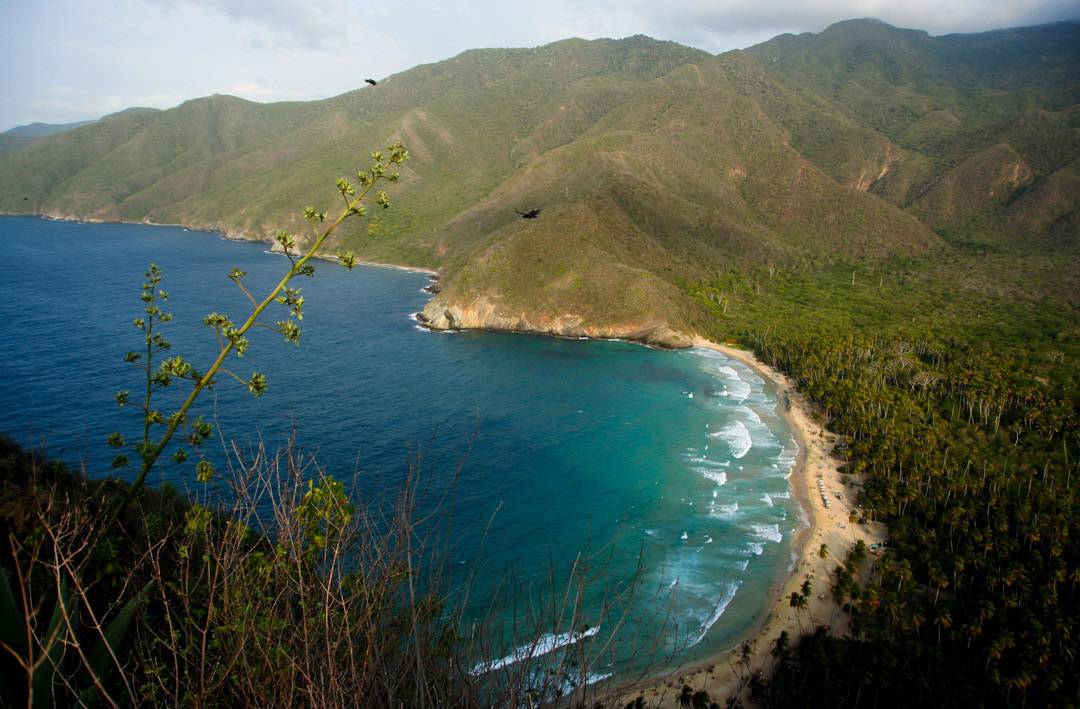
Venezuela’s economic problems, bad reputation and political uncertainty haven’t helped in the development of tourism to this Caribbean country in South America.
The truth is that, as one of the largest oil producers in the world, the government has focused most of its efforts on the exploitation of oil fields, sometimes to the detriment of other economic activities.
However, the reality could be very different. Venezuela is a jewel to discover, a virtually unexplored territory with places of incomparable beauty.
From paradisiacal beaches to impenetrable jungles to vertigo-inducing routes through the Andean highlands, the possibilities for visitors are almost endless.
Table of Contents
1) Salto Angel
2) the amazon rainforest, 3) cayo sombrero, 4) mount roraima, 5) the orinoco delta, 6) los llanos, 8) puerto colombia, 9) los médanos de coro national park, 10) parque mochima national park, 1) bring dollars or euros, 2) stay safe, 3) relax and enjoy, top places to visit in venezuela.
If you’re feeling like an adventure to one of the most beautiful countries on the planet, then don’t miss out on these amazing places to visit in Venezuela.
Angel Falls , at 979 meters high, proudly boasts being the highest waterfall in the world. Located in the Venezuelan Gran Sabana, this is a place holding a sacred character for the natives. It is, without a doubt, the biggest out of all Venezuela tourist attractions.
To get there, you’ll have to navigate up the Carrao River, right in the heart of Canaima Park, until you reach the base of the falls. Inscribed on the UNESCO World Heritage list in 1994 , this park offers hundreds of cascades of equal beauty, as well as wild rivers and red-water lagoons.
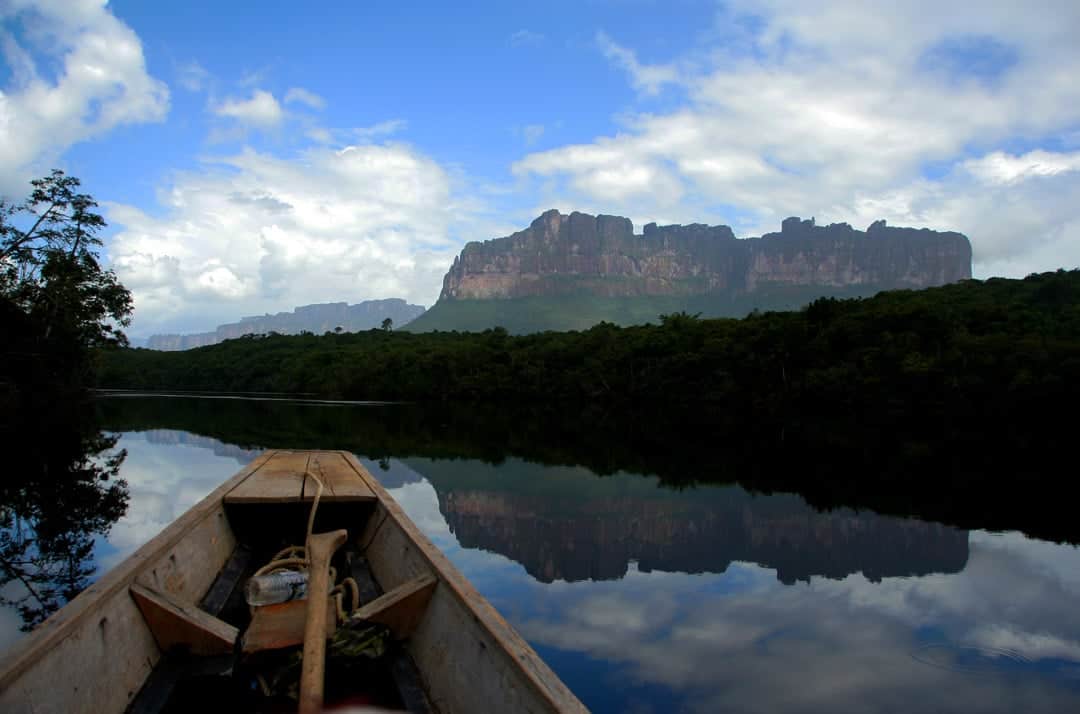
Mystical and legendary, this dense and humid territory is the largest jungle in the world. Visitors can venture along its rivers to find wild animals, lush plants and tribes that have barely changed their traditions in the last 500 years. The Amazon rainforest is one of the best things to see in Venezuela.
Although uncontrolled logging and the construction of dams are seriously threatening the future of this ecosystem, it’s still possible to visit several protected reserves and enjoy one of the seven new natural wonders of the world. Definitely an amazing spot on the list of places to visit in Venezuela.
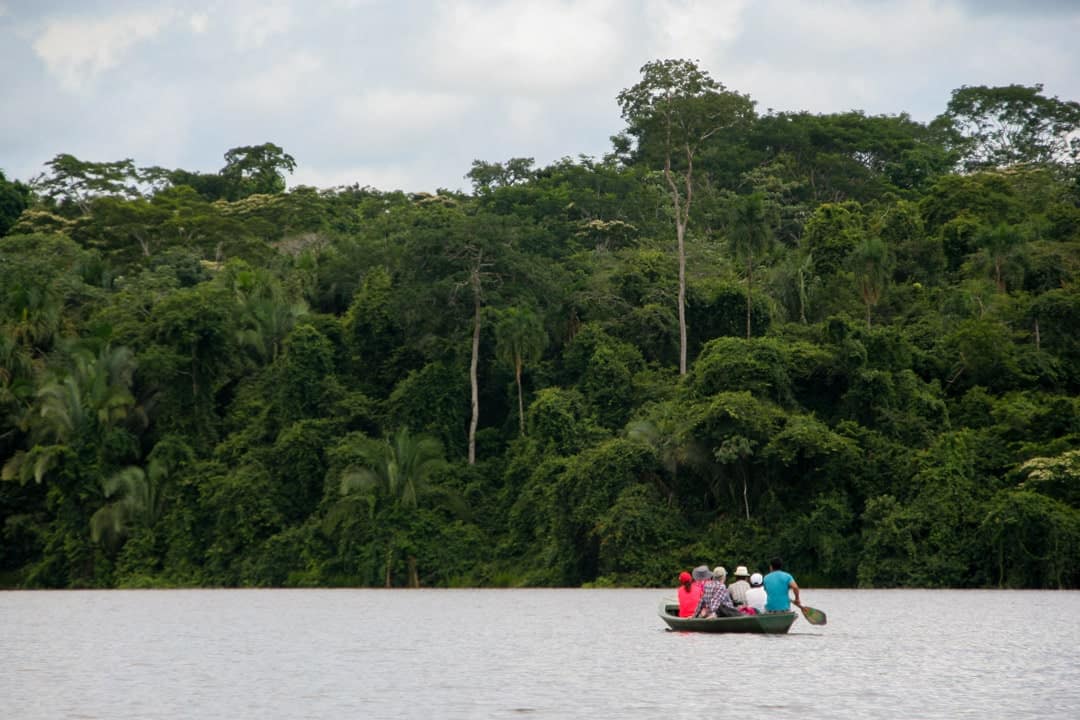
Because Venezuela’s coasts are completely bathed by the Caribbean Sea, it’s no surprise that there are plenty of amazing islands and beaches to visit.
When you think about a paradisiacal destination, you probably envision yourself lying in the shade of a palm tree on a white-sand beach with turquoise water, right?
That’s the exact description of Cayo Sombrero, a tiny island located a few kilometres off the coast of Chichiriviche, in Morrocoi National Park.
Enjoy the peace of this place with no infrastructure, houses, restaurants or hotels. You can easily arrange a boat to get you there, and agree on a time so they can pick you up.
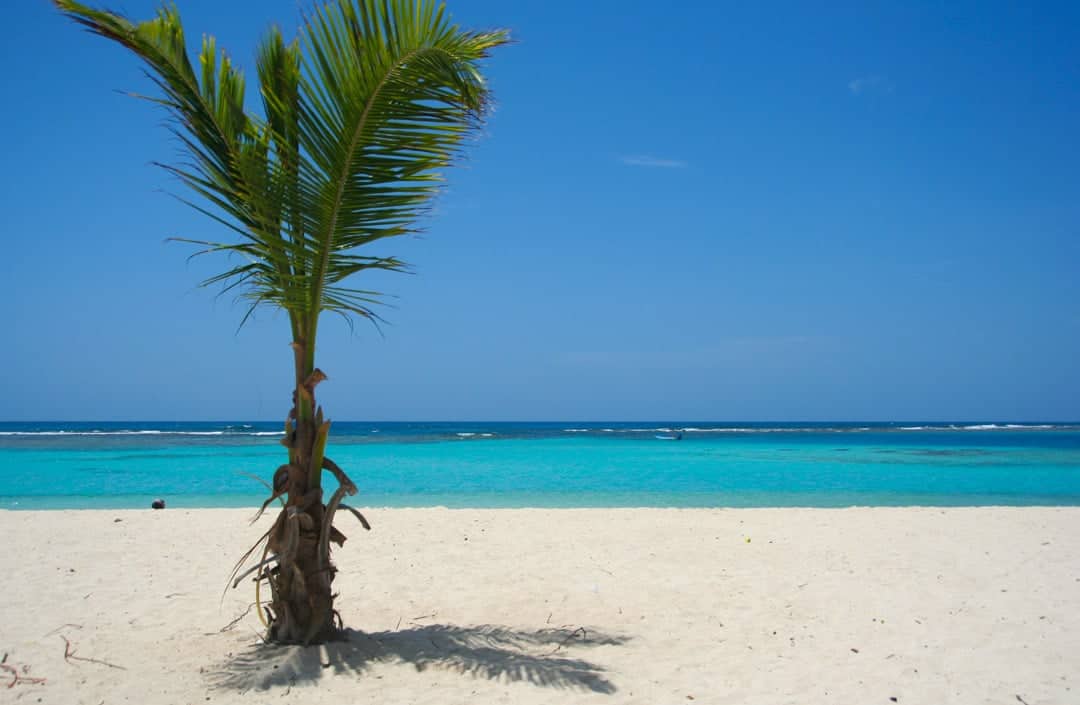
Mount Roraima, called Tepuy Roraima by the indigenous population, is a majestic table-shaped mountain located right on the triple border point of Venezuela, Brazil and Guyana.
The hike will take at least five days to complete. You’ll have to cross wild rivers and walk along steep paths before enjoying amazing views from the summit.
Once you’re on the top, the extravagant rock formations will certainly make you feel like you’re on another planet. It’s easy to understand why this mount inspired Sir Arthur Conan Doyle to write his famous novel “ The Lost World “.
For all avid hikers, Mount Roraima is one of the Venezuela attractions they can’t miss!
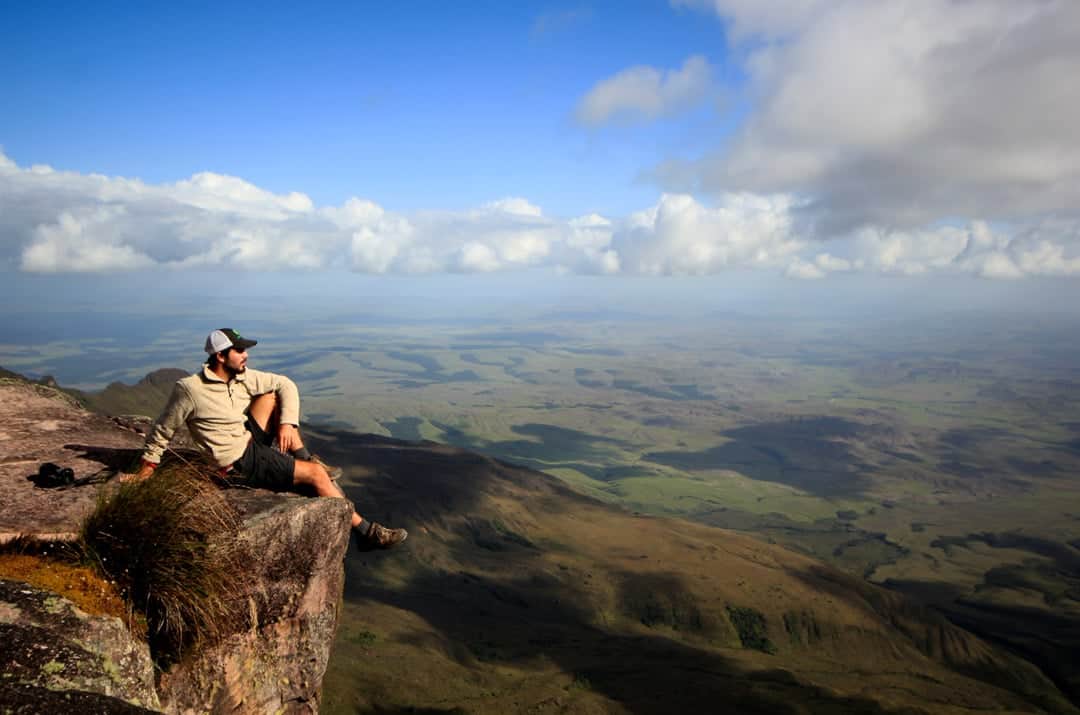
The beautiful Orinoco River, one of the most important in South America and the third largest river in the world after the Amazon and Congo, has been a subject of study by dozens of explorers since Christopher Columbus documented its existence in 1498.
The delta region, formed mainly by materials the river washed away and by mudslides from nearby volcanoes, attracts all kinds of adventurers looking for wildlife, flora and fauna.
The delta is an important starting point for jungle expeditions, during which you can see alligators, anacondas and even jaguars if you’re lucky enough.
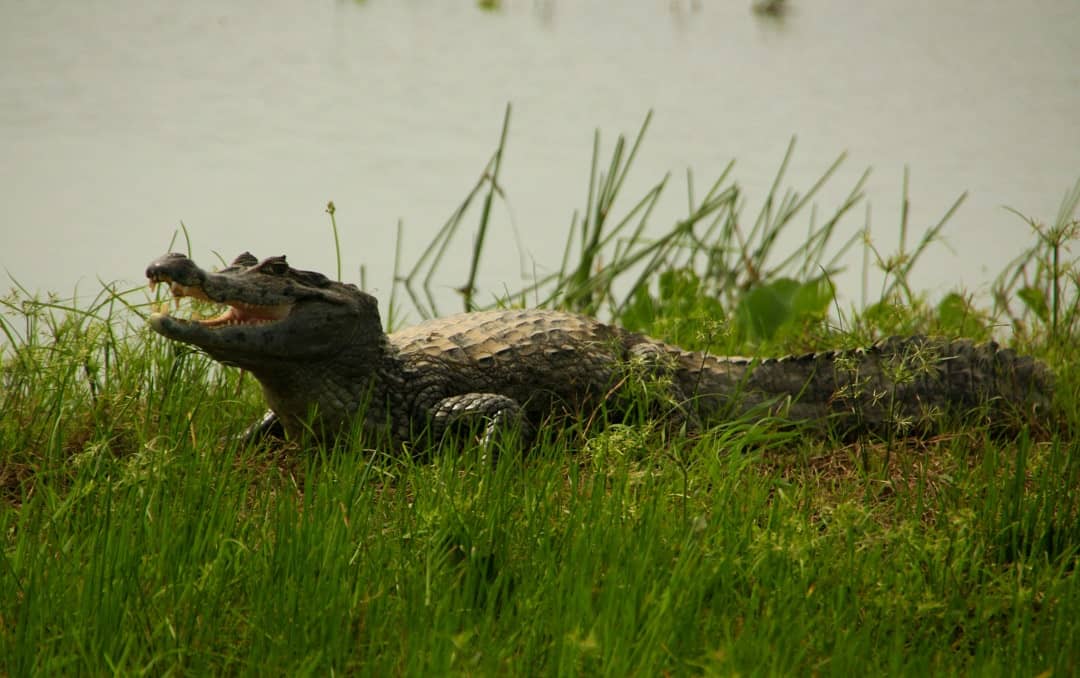
This huge savannah is to South America what the Serengeti is to Africa: a wild extension where animals are the real lords. You can take a multi-day safari and watch hundreds of birds, caimans, deer, capybaras, sloths and more.
Although the region’s activity involves mainly cattle ranching and oil production, eco-tourism is growing in Los Llanos and more visitors have the chance to take in its natural beauty.
When traveling to South America, Los Llanos must be included in your itinerary – it’s one of the best things to do in Venezuela.
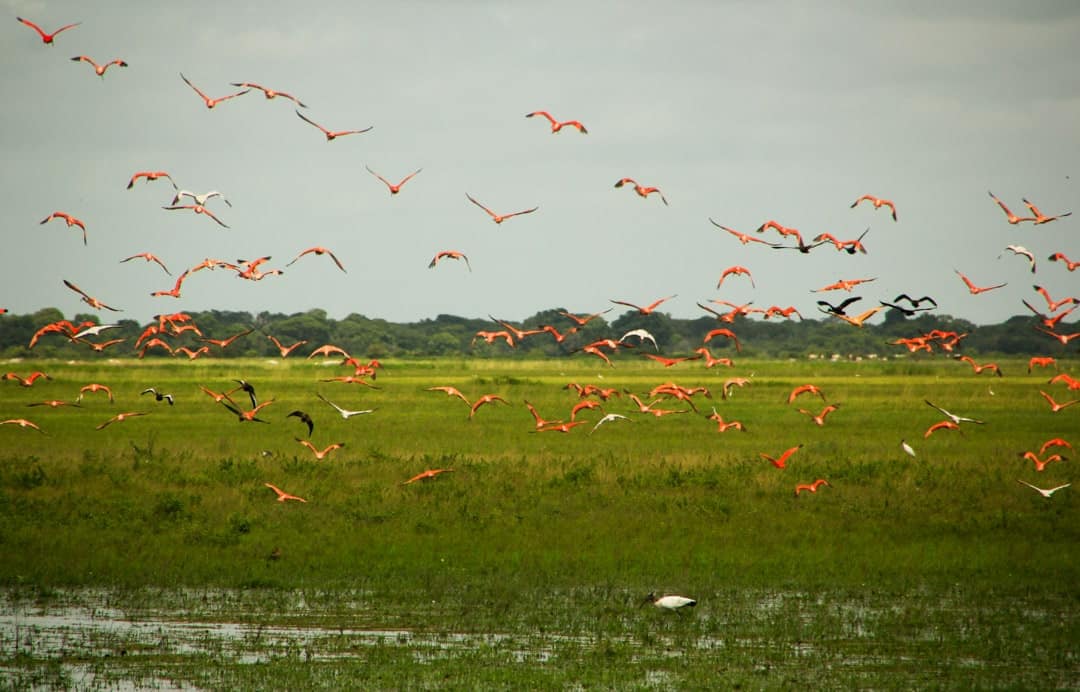
Venezuela’s attractions go beyond tropical jungles and dream beaches. The Andean Range, the mountainous backbone that so drastically affects the climate of the continent, also creates amazing landscapes in the land of Simon Bolivar.
Merida is the most important city in the Venezuelan Andean region, and it’s an excellent starting point for visiting the nearby colonial towns.
It is known as the adventure capital of the country, and it offers a wide variety of activities for all preferences. Adrenaline junkies will find top-class hiking, rafting, paragliding and rock climbing.
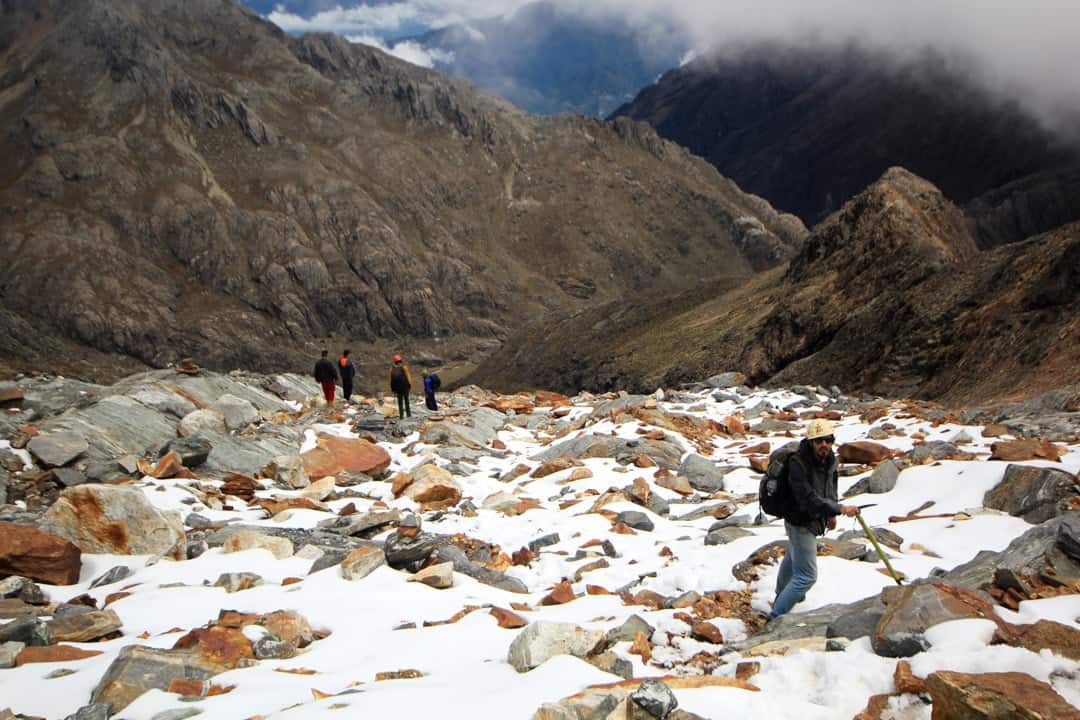
Located on the coast of the Henri Pittier National Park, this small village is characterized by steep mountains, extensive beaches and friendly people.
The beaches are not like those of white sand and turquoise water, but they still have a special charm. It’s a region with strong waves, cliffs that dominate the landscape, and local fishermen who make their living out on the rough waters.

The landscapes and ecosystems in Venezuela are so varied that it’s possible to find a desert in the northwest region of the country.
Located in the Falcón state, Medanos de Coro National Park is a dry setting of large dunes that are the products of erosion and the whims of incessant trade winds.
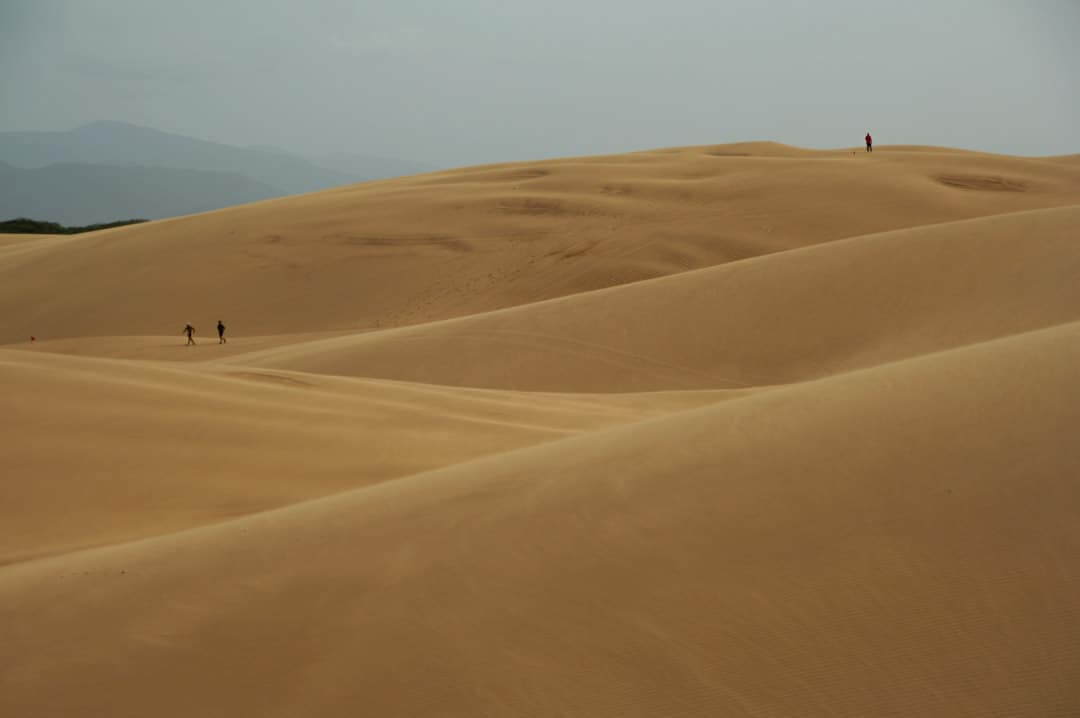
When one arrives at Mochima National Park, one immediately feels the magic of a place where it seems as though time has not passed.
Located between the states of Sucre and Anzoátegui in the eastern part of the country, this park contains a long coast of beaches and islands with pristine water.
The beautiful sunsets and the tranquility of its villages make Mochima one of the most attractive destinations on the Caribbean coast.
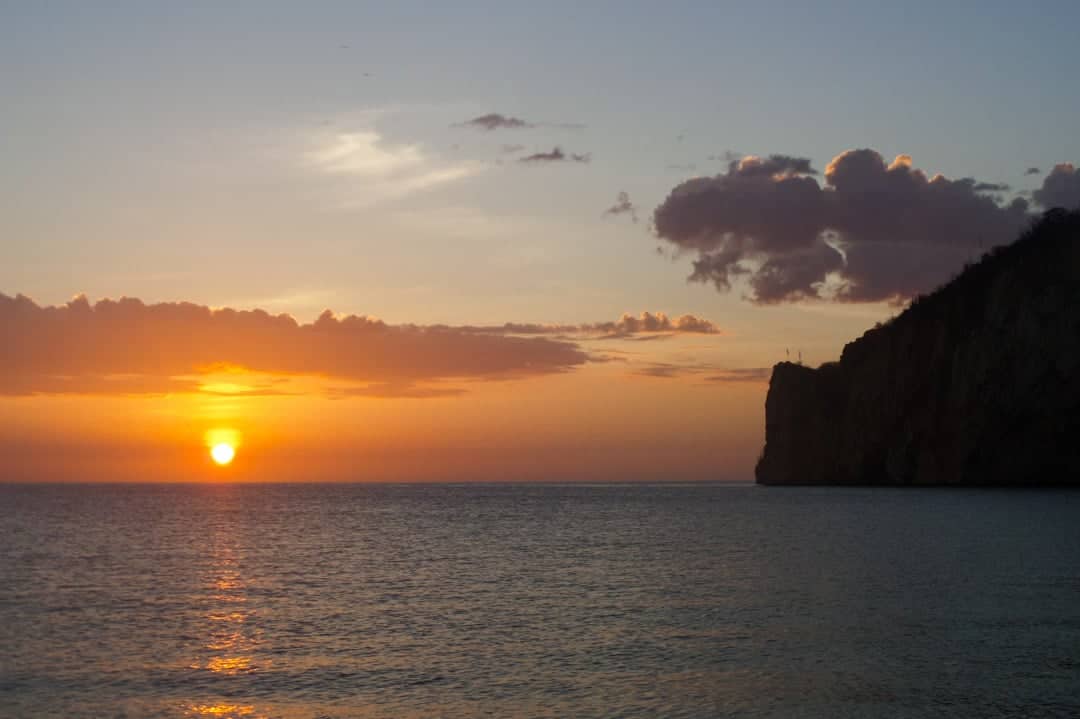
Tips For Visiting Venezuela
Now that I’ve inspired you to pack your bags and travel to this South American nation, here are our best travel tips for visiting Venezuela.
Venezuela has one of the world’s craziest economic systems. While the local people can’t buy more than a few dollars a year, they still need dollars or euros to travel out of the country and to conduct certain transactions. Therefore, the dollar black market is big business there.
Don’t get money from an ATM. You’d get the official exchange rate, and that would ruin you. Bring dollars or euros and change them on the black market.
When I say black market, don’t imagine guys in an alley, dealing with opium or AK-47s. Many people change dollars in Venezuela. Ask in your hostel or in any jewelry store and you will have your money changed in a matter of minutes.
We all know that the current situation in Venezuela is not the best. However, the places on this list are safe to visit if you take the normal precautions. The countryside is still relatively safe.
Avoid visiting big cities like Caracas, Valencia, Maracaibo, etc. If you need to stay in a city, try to make those visits as short as you can. Stay away from big concentrations, protests and other public demonstrations.
Don’t trust military officers. If your bus is stopped at a military checkpoint, hide your money in your underwear. They could ask if you have money with you.
Show them a few bolivares and tell them that’s all you have. Don’t show them your dollars because you might “lose” some of them.
Despite the bad reputation, Venezuela is an incredible country that offers just about anything you can imagine. The people are friendly and the landscapes are unbelievable.
Use common sense and avoid big cities, and everything should be alright!
Miguel Travelsauro
Hi, We’re Alesha and Jarryd!

We’ve been traveling the world together since 2008, searching for the planet’s best destinations and adventures.
Love Travel?
Sign up for our free weekly newsletter for the best travel tips, ideas and deals!
We respect your privacy. Unsubscribe at any time.
READ MORE...
Getting Around Magnetic Island – ‘How to’ Transportation Guide
The ultimate guide to the best magnetic island beaches and bays, the perfect magnetic island day trip itinerary [2024 guide], related posts, ker and downey shinde camp review – okavango delta safari, 4 thoughts on “10 best places to visit in venezuela in 2024 (plus tips)”.
Hoe do you get in? they currently not issuing visas.
I can’t stress this enough! Do not, I’ll repeat it, Do not travel to these places, not now at least, Venezuela is in a constant turmoil, you can’t trust the Police nor the Government to protect you, if anything should happen, you would be left on your own! I’m not JOKING! Venezuela is the third most dangerous Country in the World and it has out of the 15 most dangerous cities in the World, 6 within the list, including the most dangerous one been Caracas, the third been Valencia and the fifth been Barquisimeto; it would be inevitable not to have to find yourself in one of those cities trying to get to your destination; so, I’ll make myself very clear again, DO NOT TRAVEL TO VENEZUELA! Not now. That’s all I have to say.
All these places are a must visit in Venezuela. Also I would say the Angel Falls are the best to see in these country.
Awesome. Thank you for your comment and tip. 🙂
Leave a comment Cancel reply
Save my name, email, and website in this browser for the next time I comment.
- Skip to content
- Skip to footer
Luxury Hotel & Destination Photographer
Editorial and Commercial Travel, Lifestyle, and Destination Photography and Videography
The Best 2-Week Venezuela Travel Itinerary – The Ultimate Guide
South America , Venezuela / May 22, 2023 by christin.theilig
Discover the hidden treasures of Venezuela’s Caribbean Coast in this two-week Venezuela travel itinerary. In a land of enchantment and contrasts, expect to encounter pristine beaches fringed by lush jungles, colonial towns nestled amidst breathtaking landscapes, and vibrant cities coexisting with serene fishing villages.
Immerse yourself in the wonders of this captivating country with my comprehensive two-week Venezuela travel itinerary, curated to showcase the best of Northern Venezuela. From indulging in luxury accommodations to embarking on thrilling offbeat adventures, get ready to say ‘yes’ to every extraordinary experience that awaits you.
(Updated Jan 2024)

Venezuela, a country located in South America, is known for its rich and diverse offerings.
Venezuela has a fascinating history, being the birthplace of Simon Bolivar, a key figure in South America’s fight for independence. It also boasts impressive colonial architecture, such as the UNESCO World Heritage sites of Coro and Ciudad Bolivar.
The country is blessed with breathtaking natural wonders, including Angel Falls, the world’s tallest waterfall, and the stunning landscapes of Canaima National Park.
Venezuelan culture is a vibrant mix of indigenous, African, and European influences. The Venezuelans are known for their warmth, hospitality, and zest for life, and despite facing challenges, they maintain a positive spirit and are proud of their cultural heritage. One of the parts that stood out while traveling the country is how easy it was to connect!
Join me on this remarkable journey and let the magic of Venezuela unfold before your eyes in this travel itinerary!
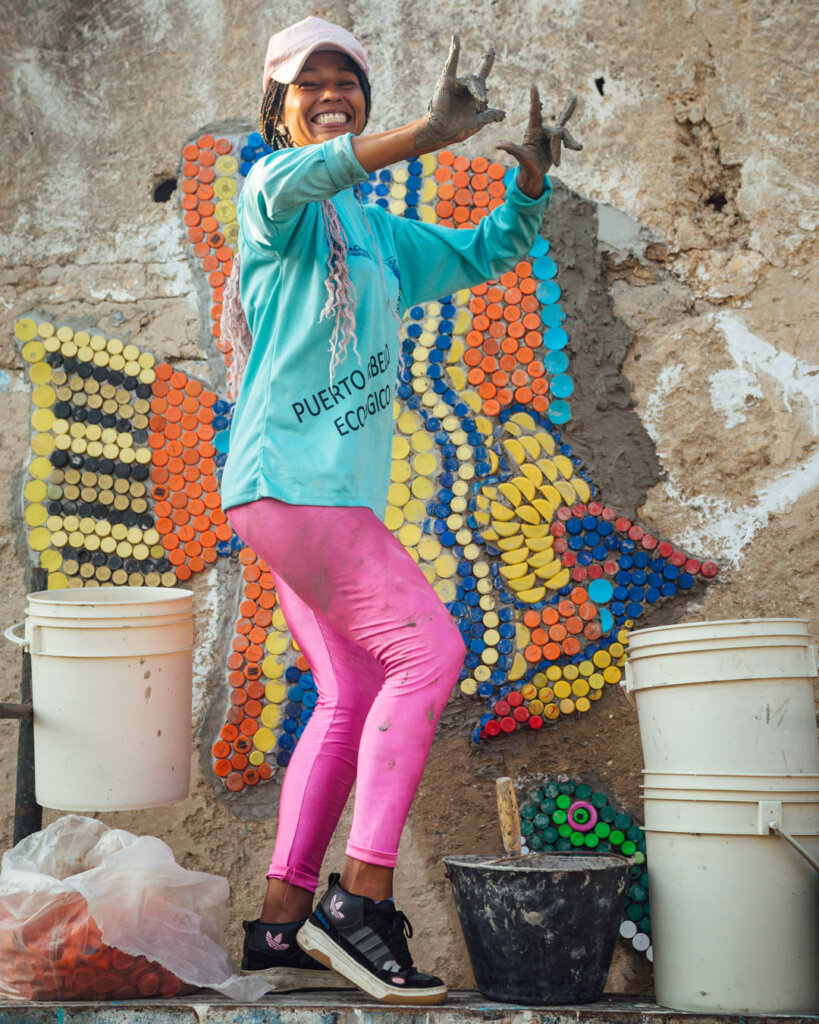
Venezuela Travel Itinerary: Quick Overview & FAQ
Is venezuela safe to travel.
Venezuela has been through some tough years, and traveling to this country is probably not for the inexperienced. As with every destination, but probably even more so in South America, it’s wise to ask locals how to behave in a way that keeps you safe, where not to go etc.
In places such as Coro, Morrocoy, Puerto Cabello and Choroni – all towns relying on local tourism – I was assured that it’s safe. I could walk around freely after sunset, have my belongings on me and take photos on the street.
In places such as Caracas, even in the city center I found it to be very relaxed and have not had a bad feeling. However, I did follow the suggestion of locals and wore my backpack at the front (especially in the busy metro) and stayed in East Caracas, which was said to be the safest.
In areas such as Chacao in East Caracas, is where all the embassies are, and walking after dawn was still a safe thing to do – also because there were still many other people in the streets.
Do I need a Visa for Venezuela?
If you are from an EU Member state you don’t need a visa and can visit Venezuela for up to 90 days. Other countries of South America, Japan, South Africa, Russia, or the United Kingdom (among others) also don’t need a visa. As things change a lot, it’s best to check for your specific situation. Citizens from America need to apply for a visa at the Venezuelan Embassy in America beforehand – there is no visa on arrival.
To enter without any issues you should have a booking confirmation of your hotel for the first day(s), a confirmation of paymen t of the hotel, and perhaps an Invitation Letter from the hotel. Also, make sure to have proof of an onward flight ticket .
The money situation in Venezuela is still a tricky one. While the bolivar is the official currency of the country, four years of hyperinflation made it almost worthless. Only recently you can now also own and pay in US Dollars . When I visited the current rate was: US$1 = Bs. 24.65 (10th May 2023)
Keep in mind that your foreign Visa/Mastercard will (most likely) not work on ATM’s in Venezuela. In some cases, you might be able to pay with your card in a hotel or restaurant, if there is a machine (‘ Hay Punto’ ).
The easiest way to avoid any problems is to bring all your money in cash , in small notes of 5, 10, and 20 bills. Change is hard to come by, many places cannot change notes of 50 or 20 ie. in a local restaurant.
Venezuelans pay online, via Zelle or bank transfer – hence having US Dollars in cash is still something new and reserved to a few.
If you have an American bank account, I’d recommend you to register for Zelle (similar to PayPal). With Zelle you will easily be able to pay in restaurants, bus terminals and many other shops.
Do I need a VPN for Venezuela?
While it is not mandatory to use a VPN in Venezuela, some people choose to use it for various reasons. A VPN like Express VPN can provide additional security and privacy by encrypting your internet connection and masking your IP address, which can be useful when accessing sensitive information or when browsing the internet in countries with stricter online censorship – as is the case in Venezuela.
In Venezuela, there have been occasional reports of internet restrictions and limited access to certain websites and platforms.
How to get around Venezuela
Taxi – a common mode of transportation within Venezuelan cities. It’s recommended to use registered and licensed taxis, preferably booked through reputable companies or arranged by your accommodation. Venezuela doesn’t have Uber or DiDi but similar ride-sharing apps called Ridery and Yummy Rides .
Always exercise caution and use reputable taxi services for safety reasons!
Bus – a popular means of transportation for both short and long distances within Venezuela. There are different types of buses available, ranging from public buses to private companies offering intercity services. Public buses are typically more affordable but may be crowded and have varying levels of comfort.
As another safety measure, I did not use night buses and made to sure to arrive in daylight to my next destination.
Plane – For traveling between cities or covering longer distances, domestic flights are a convenient option in Venezuela. Several airlines such as Conviasa operate domestic routes, connecting major cities and popular destinations.
Check for your best flight connections from Panama City with Copa or Colombia with Wingo directly to Caracas!

Day 1: Maracaibo (Arrival)
Let’s start your Venezuela two-week travel itinerary in one of Venezuela’s most significant cities. Maracaibo, a once vibrant city in Venezuela, holds great significance as a hub of cultural heritage, economic activity, and natural wonders. Nestled on the shores of Lake Maracaibo, the largest lake in South America, it offers breathtaking sunsets and the mesmerizing phenomenon of Catatumbo Lightning.
Maracaibo’s strategic location in the oil-rich region has fueled its growth as a key player in Venezuela’s oil industry. With its blend of historic architecture and modern developments, the city showcases a captivating fusion of past and present.
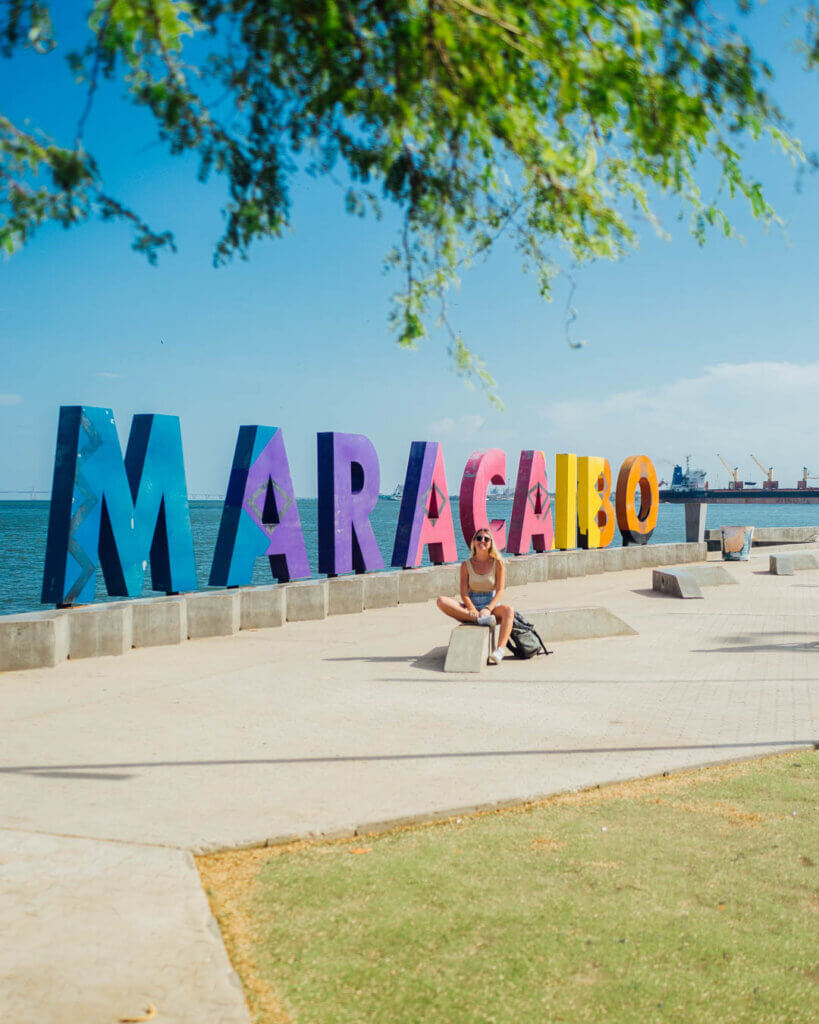
Explore La Vereda del Lago Park and stroll along the Malecon, a scenic waterfront promenade offering picturesque views of Lake Maracaibo, lined with restaurants, bars, and shops.
From there it’s only a short drive to the city center. Wander through Maracaibo’s colonial streets, admire the architecture, and visit landmarks like Plaza Bolivar, the Municipal Palace, and Santa Lucia Church.
When I visited the city on a Sunday, the center and especially around Calle Carabobo (which is famous for its colourful colonial houses) was extremely deserted. It could have been the heat or the fact it was Sunday – but my taxi driver suggested to not wander around alone.
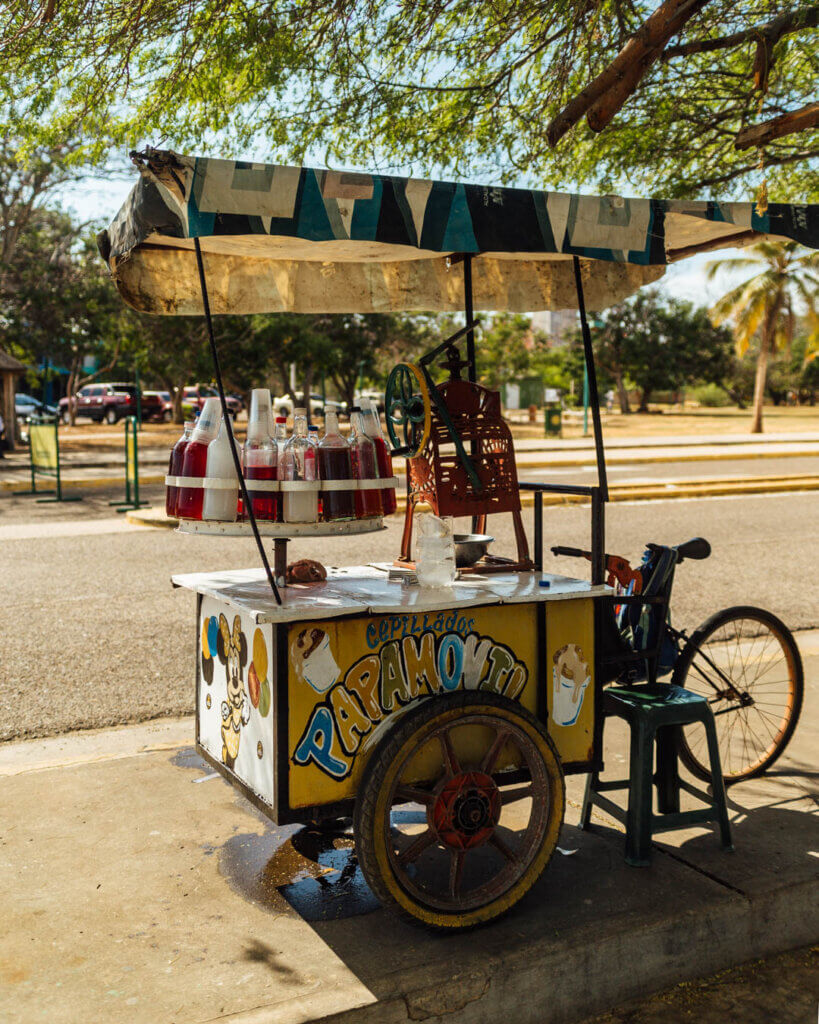
Where to stay in Maracaibo
Ragazza Suites in a good part of Maracaibo, offers a family environment and economic room options. The owners was super helpful, always there for questions and organized my taxi to the bus terminal. The price per double room started at 22 USD with a bathroom.
Day 2: Maracaibo to Adicora, Coro
Coro, the entrance to Venezuela’s most northern point is a spectacle in itself. The desert vibes begin once you leave town, greeted by huge dunes covering half of the street. A 60-minute drive leads you to the peaceful town of Adicora. Known as one of South America’s top kite surf spots, it’s a wonderful place to unwind.
Quiet and sleepy during the week, the kite surf enthusiasts and nearby locals flock to the beaches. In the past, many Germans, Dutch and Italians arrived here, settling back in the days, when many of the colonial buildings still belonged to them. A true highlight of every travel itinerary for Venezuela!
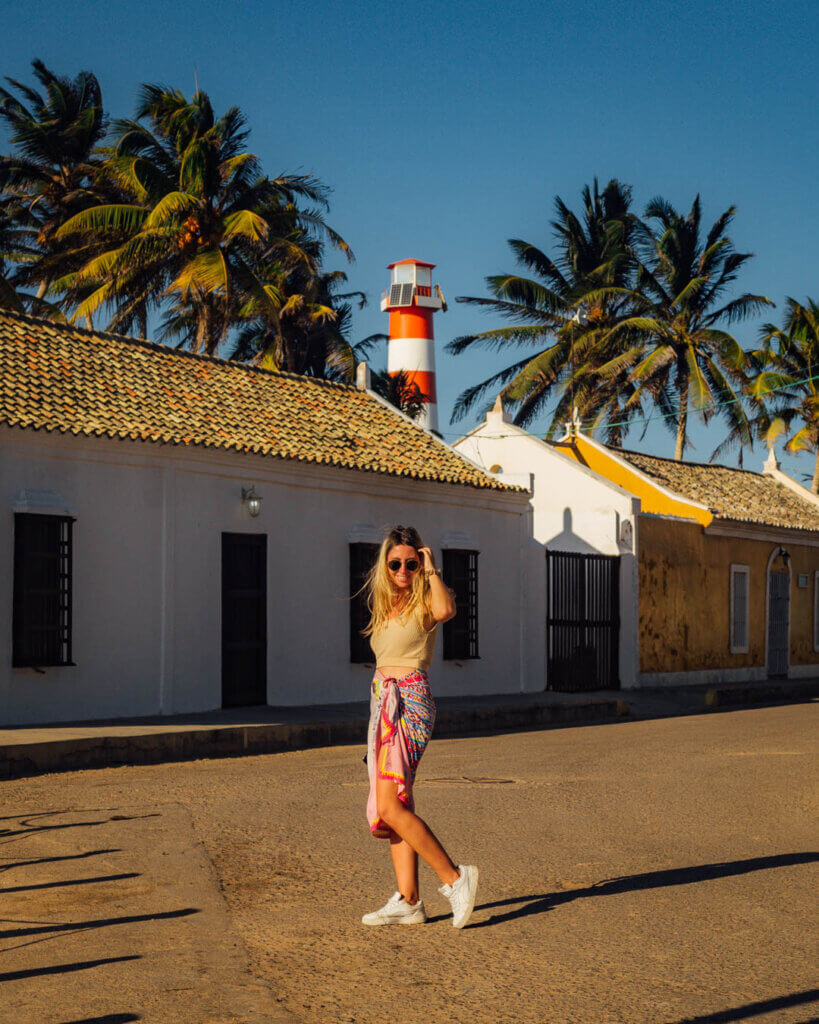
How to get from Maracaibo to Coro
Leave Maracaibo in the early morning hours to arrive in Coro before 2 pm to catch the next bus. The ride can be 4-5 hours long, prolonged by police checks and random pullovers to pick up new passengers. The price for the bus was 10 US$. Once in Coro change to a public or take a shared taxi for the one-hour ride to Adicora. Cost for the taxi cost 5 US$.
Where to Stay in Adicora, Coro
30 Nudos – your best option for a mix of eco focus & unique design! If you’re after having a sustainable hotel plus the chance to learn how to kite surf, 30 Nudos is your best choice!
Your room is an old shipping container that might have traveled as much as you and features a comfy terrace with a hammock. They’ve got their own kitesurfing school by the ocean which is the ideal place to learn or to improve your skills. From weekly DJ nights and a knowledgeable kite-surf team this makes a unique place to stay!
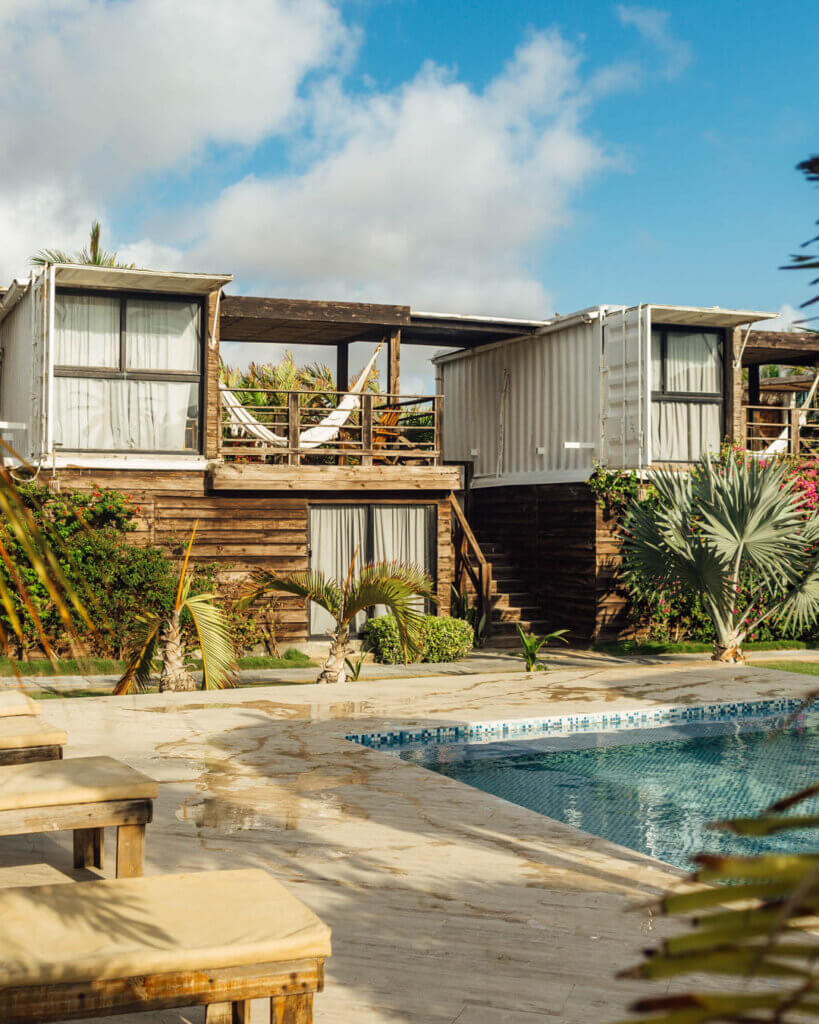
Apartahotel Hipocampo – the first hotel in Adicora that was tailored to kitesurfing holidays, offers spacious, serviced apartments with dining room and kitchen. As part of your stay, you can enjoy daily Venezuelan breakfast and a great restaurant that opens for dinner.
It’s just a short 5-minute walk to the beautiful beach, ideal to also wander around the village. From relaxing by the idyllic pool to the best staff – this is a fantastic option for longer stays and kitesurfing holidays!

Day 3: Adicora
Start your day with a traditional Venezuelan breakfast and maybe even try ray for the first time! As tours aren’t really a thing, you can ask your hotel if they can put you in touch with a trusted taxi service. From Adicora it’s about a one-hour ride up north that will lead you past lagoons full of flamingos, pinkish salt flats (and kids who want to explain you the history of it), abandoned hotels and long stretches of sand.
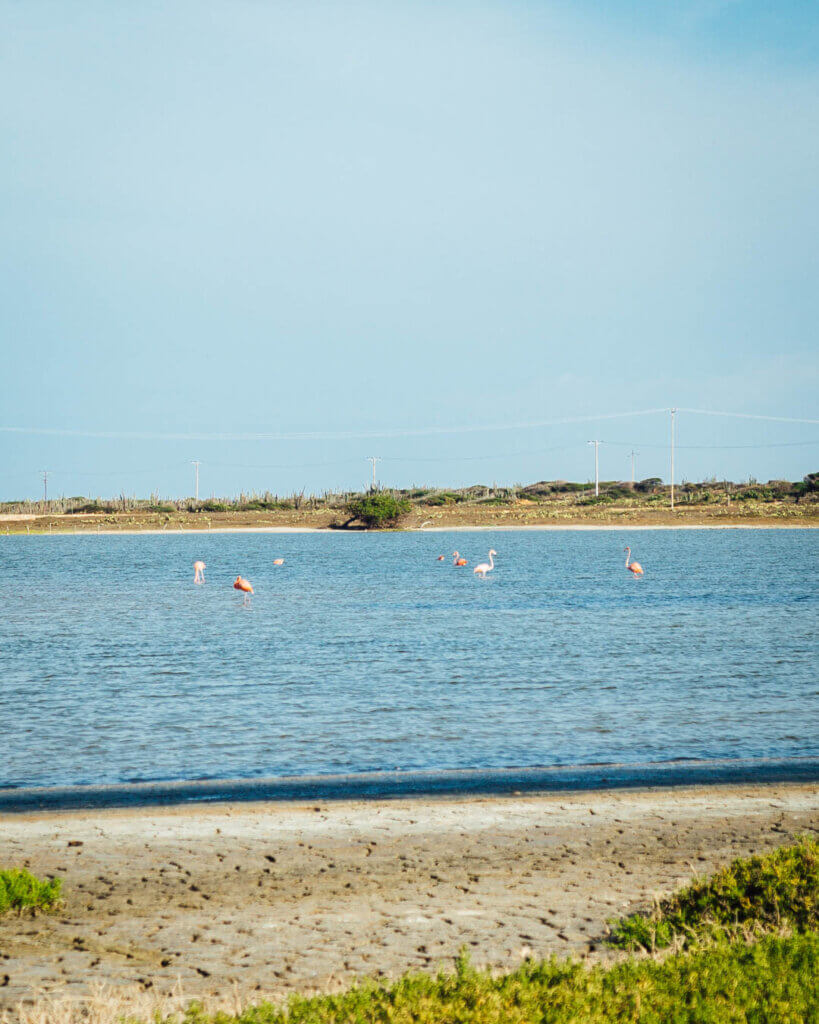
If you reach the lighthouse, you have officially made it to the most northern point of Venezuela. On a clear day, you can even see Aruba in the distance. Drive a little further and you will encounter a single, large sand dune – right by the ocean and a top highlight of any Venezuela travel itinerary.
Head back home, and take a stroll through the sleepy town. Its not unusual to hear that many of the colonial houses you see by the beachfront have or had, owners from different countries.
To end the day, head to Posada Rosada Restaurant for some of the best-grilled fish, patacones and sunset views! Expect to pay around 12 US$ for a fish and 2$ for two beers.
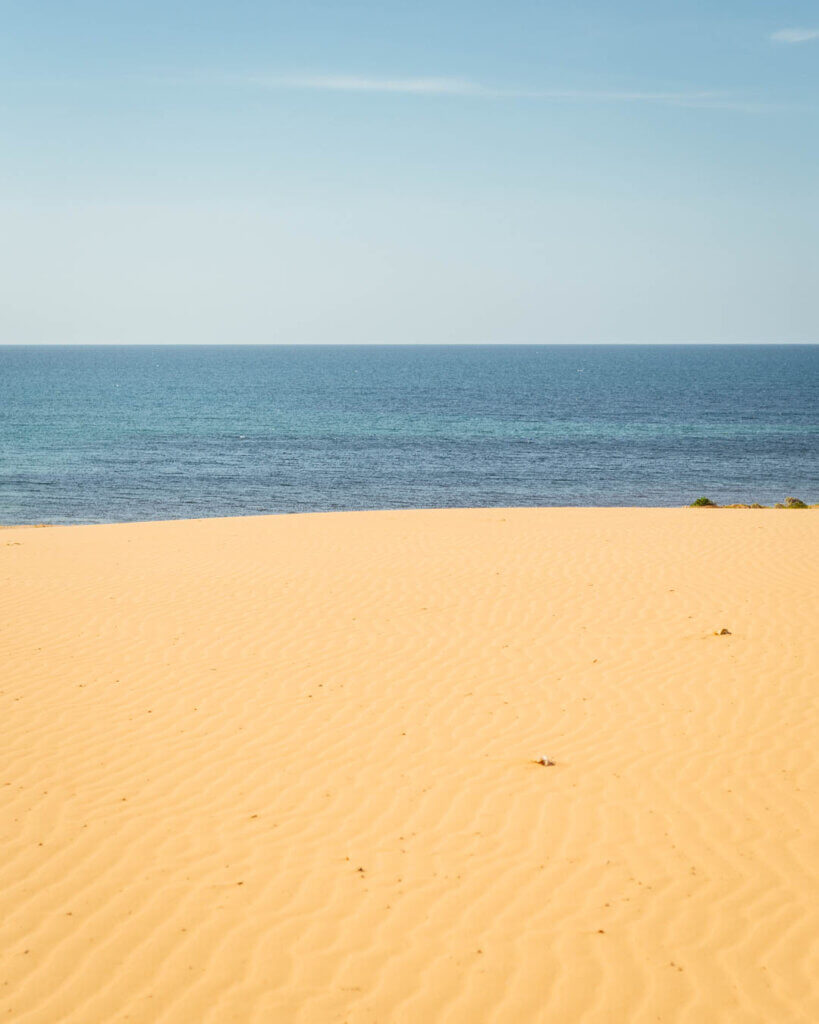
Day 4: Adicora
As Adicora is one of South America’s kite surfing hot spots it should be on your list to try it out! Along the coast are many kite surf schools that offer introductory courses as well as packages.
In the afternoon make sure to visit the local beach for some downtime and beautiful sheltered water to swim. There are many sunchairs you can hire and locals will likely flock to the beach once it hits 4 pm!

Day 5: Adicora to Morrocoy
Situated on the Caribbean Coast of Venezuela, Morrocoy is a piece of heaven that you shouldn’t skip when planning your Venezuela travel itinerary. Its idyllic white-sandy beaches, crystal clear water, and tropical islets are what beach dreams are made of.
Adding Morrocoy to your Venezuela travel itinerary guarantees an unforgettable experience of sun-soaked bliss and natural beauty.
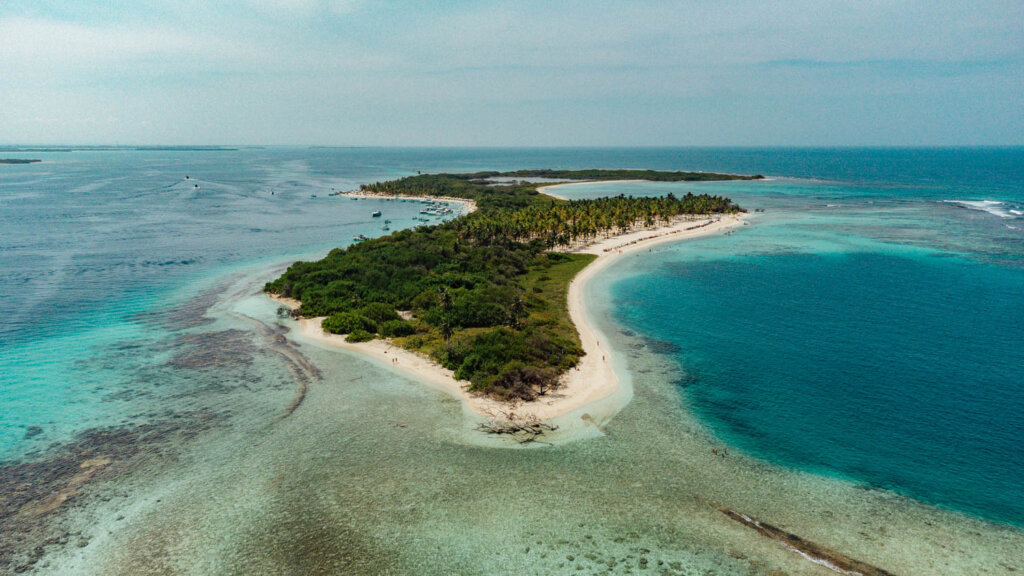
How to get from Adicora to Morrocoy
Taxi + Bus – right in town is a bus station that connects the peninsula with Coro. You can either wait for a bus to pass or take a shared taxi back to Coro which should cost about 5$.
In Coro, you will take a bus that heads towards Valencia, but get off at Tucacas. The bus will cost about 10 US$ and can take some 3-5 hours.
Where to Stay in Morrocoy
Tuqueque Lodge – this ultimate adventure hotel sits within the Morrocoy National Park and is a true adventure hotel. With only 3 cabins, this is as boutique as it gets. They serve the most wonderful breakfast, elaborated 4-course dinner plus the tastiest coffee. I absolutely loved their attention to detail, their personalized service and how they made me feel so at home.
A two-night stay in this eco-luxury lodge gives you access to an excursion in their private speedboat including a cooler with beverages & drinks for the day.
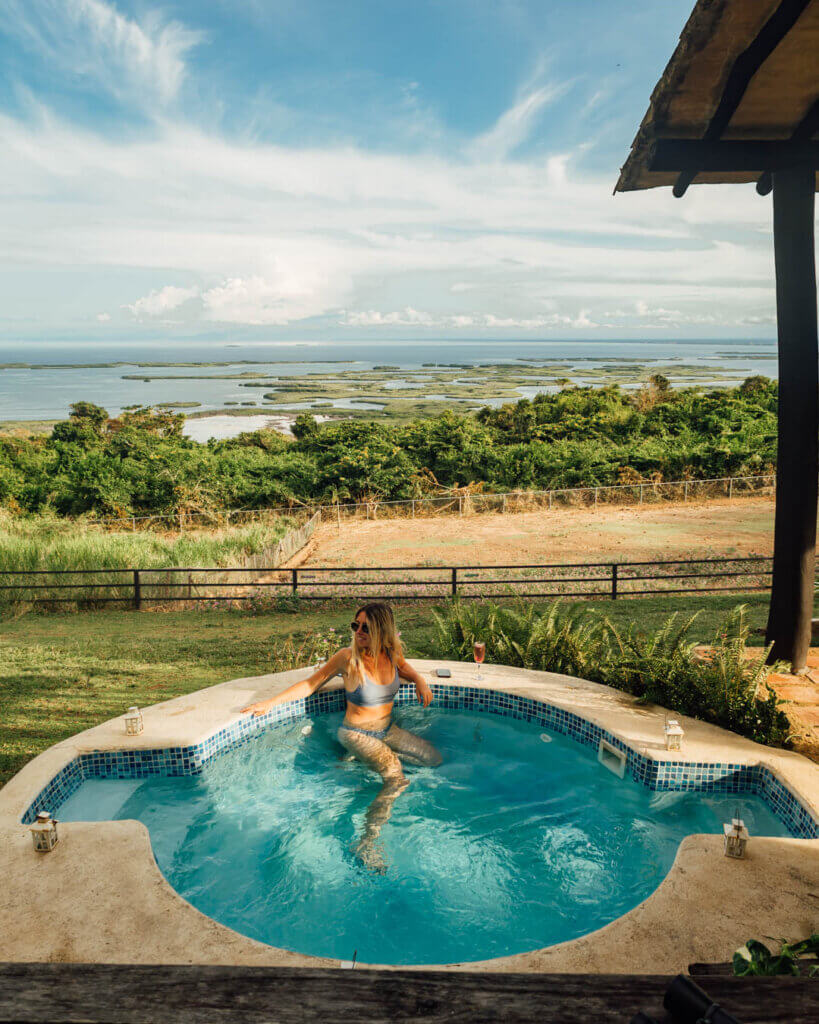
El Solar de la Luna – sitting on top of a hill, the views from this unique posada is top notch. Greeted by owner Pedro, you’ll be staying in one of 7 uniquely decorated rooms, all with an eco-focus. As a founding member of the Circuito de Excellencia, you’ll be welcomed with a tasty drink and can enjoy an outstanding 4-course dinner and sumptuous breakfast during your stay.
The service is impeccable, with an amuse bouche, Chilenian wine, and a mix of Venezuelan or international dishes that vary from day to day. Your stay will include a comfortable air-conditioned transfer, to and from the harbor to catch a speedboat to the nearby Cayos.
Booking top hotels that include transfers, dinner and extra experiences will highly improve the overall experience within your Venezuela travel itinerary!
Check out my luxury hotel portfolio if you want to see what I can capture for your hotel!
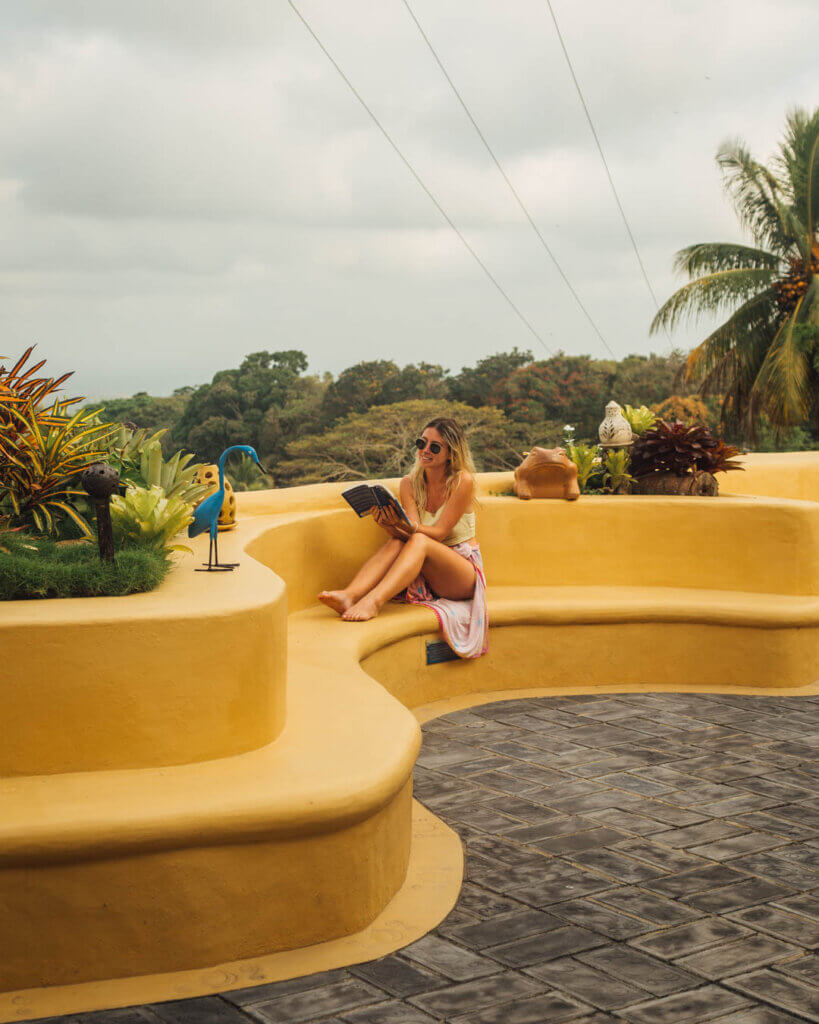
Day 6: Morrocoy National Park
The Morrocoy National Park is known for its mangroves, tropical islets, and beaches near the coast. It’s from the park itself where the lanchas (speedboats) leave to visit the Cayos. Here you can either rent a boat yourself or join a public one.
Prices ranged from 70-100 US$ per day for the whole boat and depending on which island(s) you want to visit. The public boat costs around 10-20$ and visits only one island.
On your first day in Morrocoy, rent a boat or join a public trip to explore one of the Cayos. The local’s top destination is Cayo Sombrero – and it’s truly stunning! Bring a cooler with some drinks and lots of reef-safe sunscreen and you’re good to go!
Return in the late afternoon to your hotel and unwind from a beach-filled day, salty hair and sunkissed skin.

Day 7: Morrocoy National Park
Chichirivichi.
Chichiriviche, a nearby town to Tucacas and Morrocoy, is a popular alternative destination for Venezuelans. The town offers attractive package deals at hotels, which include breakfast, dinner, and a boat trip to nearby cays like Cayo Sal and Cayo Muerto. It’s a convenient and enjoyable option for a memorable getaway.
Cayo Sal is a fantastic Cayo to visit, featuring lots of shade from the palm-fringed beach to having watersport activities available. The beach is truly spotless and friendly vendors are selling Venezuelan oysters, drinks and other dishes.
I’d recommend you bring enough water!

If you’re enjoying this itinerary, make sure to have a look at my Unusual Colombian two-week itinerary !
Day 8: Tucacas, Morrocoy to Puerto Cabello
Many things didn’t come to mind when I thought of Venezuela, so discovering a picturesque seaside town with vibrant colonial houses was such a surprise. Little did I know that Puerto Cabello, a hidden gem on the Caribbean Coast, would become a highlight of my Venezuela travel itinerary.
Puerto Cabello has a rich history and played a significant role during Venezuela’s struggle for independence from Spanish colonial rule. It was the site of various battles and witnessed key events in Venezuelan history.
With its charming architecture, stunning beaches, and historical center boasting houses that have withstood the test of time for over 400 years, Puerto Cabello is a must-visit destination on any Venezuelan travel itinerary.
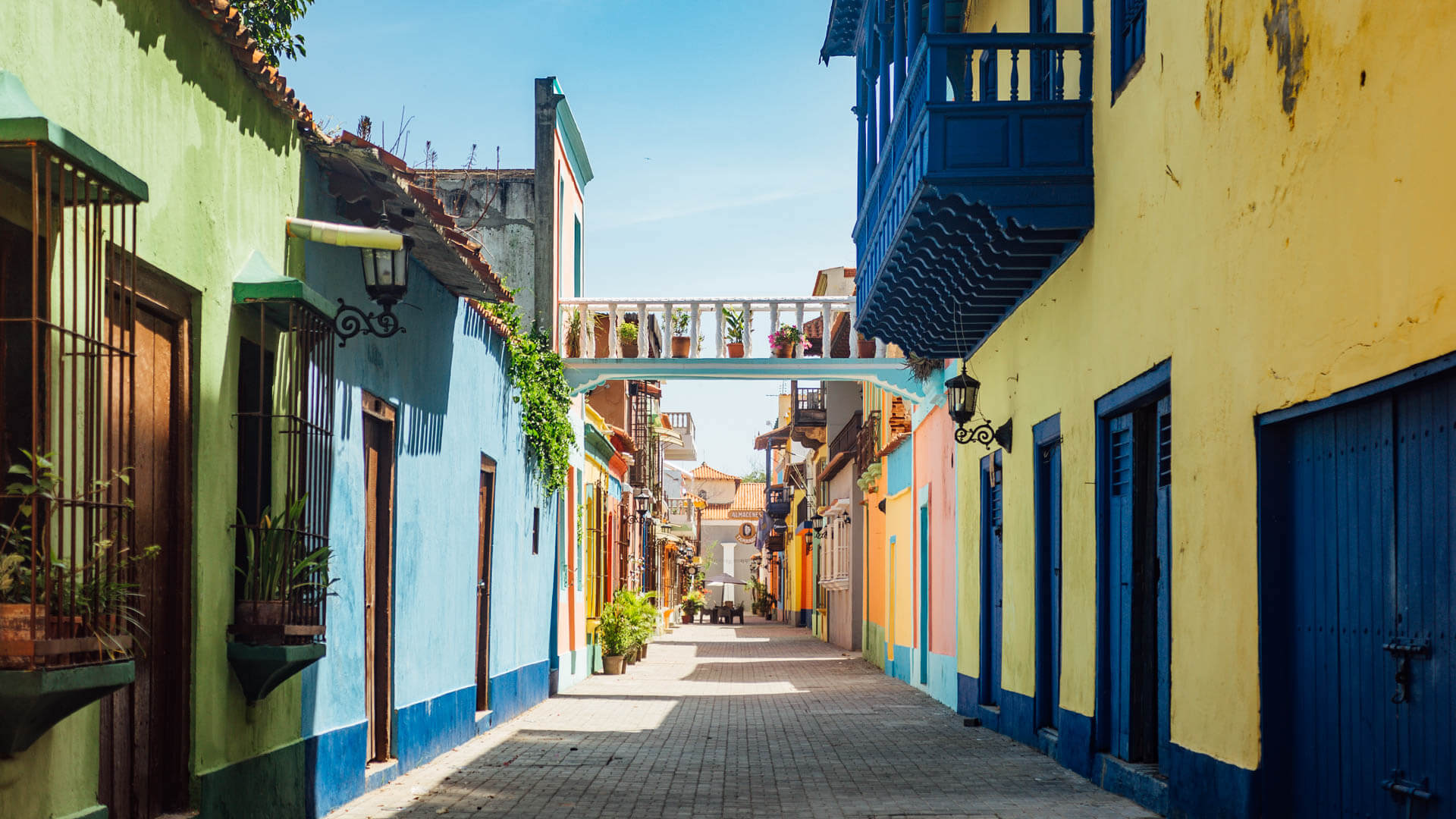
How to get from Tucacas, Morrocoy to Puerto Cabello
Regular buses are heading from Tucacas towards the village of Moron. The ticket costs 2 US$ and takes about an hour. From there, you take another bus to Puerto Cabello which should be another 2-3 US$.
I’d suggest contacting your hotel in advance and organizing them to pick you up or send a trusted taxi.
If you have time in the afternoon, definitely head for a stroll along the promenade and marvel at the stunning house front. Walk towards the marina and visit Playa Sonrisa while sipping on some local drinks in the beach bars.
Where to stay in Puerto Cabello
Posada Santa Margarita – as part of Circuito de Excelencia, they are a collection of three colonial houses, that are more than 250 years old. From unique interior, princess-like rooms with treasure chests, a grand pool room, a terrace with an ocean view, and a pool – it’s one of the most unique places you can stay in.
A stay can include breakfast and some of the best staff that helps with anything you need! In your free time, have a look at their newly opened gallery that features the hotels owner’s father, an important figure in Puerto Cabello’s history.

Day 9: Isla Larga
Isla Larga should deserve an extra spotlight on your Venezuelan travel itinerary. This unique island, just off the coast of Puerto Cabello boats an incredibly idyllic, pink beach!
Two striking shipwrecks that are visible from the beach itself, make this island one of a kind in Venezuela!
To reach the stunning Isla Larga, start your journey by taking a taxi or a local bus to the embarkation point in Ganango. From there, board a lancha—a small motorized boat—that will ferry you across the water to the island. The crossing itself is an exciting and adventurous experience, as the high reef acts as a natural barrier between the open ocean and the island.
For a fee of around 10 US dollars, you can enjoy a full day in this pristine paradise before the boat returns to pick you up around 4 pm, ensuring you have ample time to relax and explore the island’s wonders.
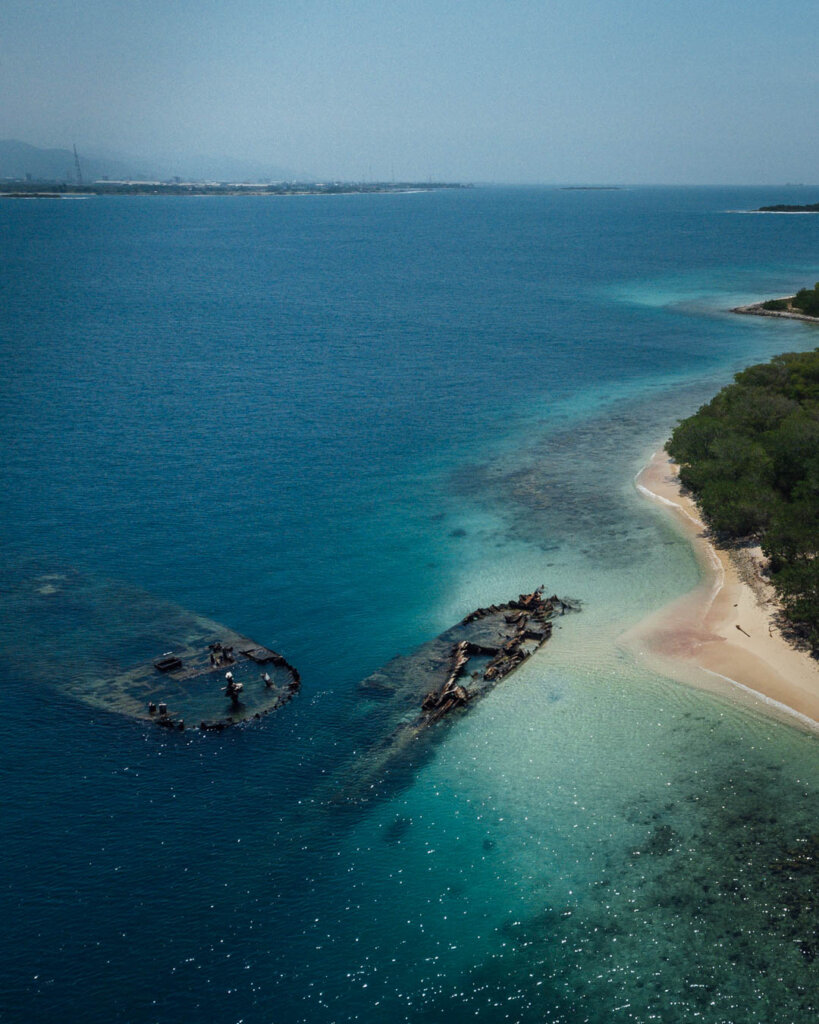
Upon arrival, find your ideal spot under the shade of the umbrellas, where you can unwind and bask in the island’s natural beauty. Alternatively, venture further towards the shipwreck area, where you can lounge under the trees and immerse yourself in the tranquil ambiance of the surroundings.
Don’t forget to bring your snorkel gear, as the highlight of Isla Larga is the opportunity to explore the captivating shipwrecks beneath the crystal-clear waters. Dive into the vibrant underwater world and witness the fascinating marine life that has made these shipwrecks their home.
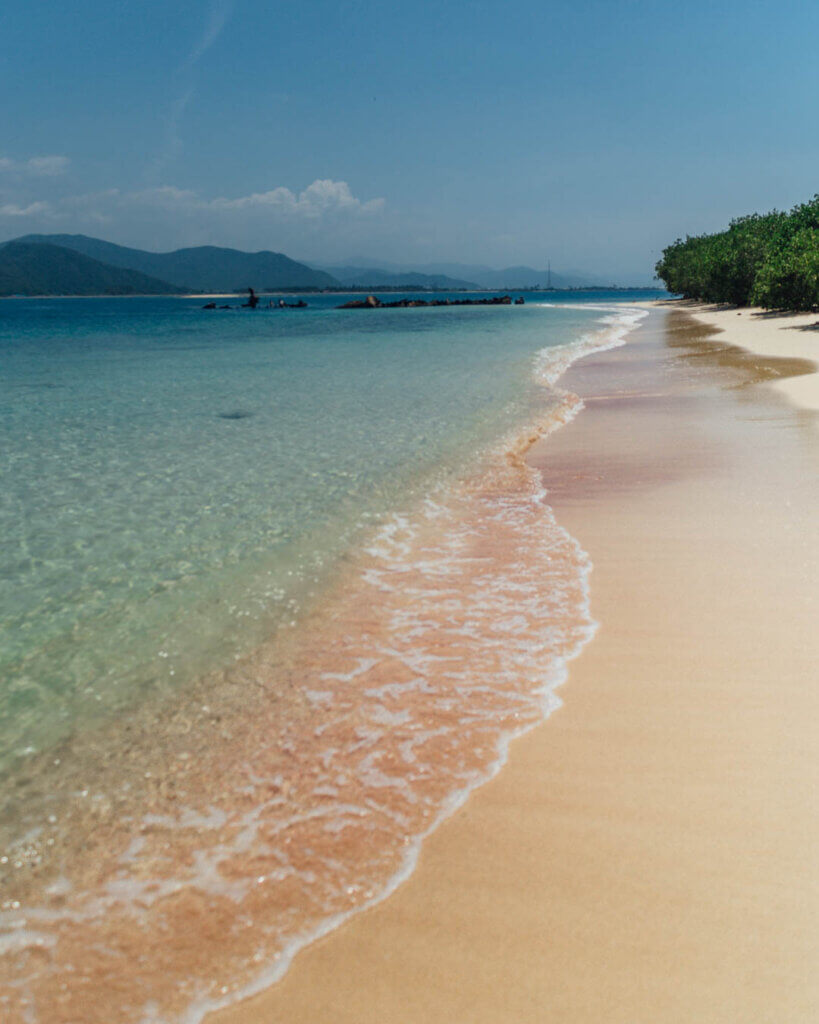
Day 10: Puerto Cabello – Cacao Finca
Begin your day in Puerto Cabello by exploring the charming historical center, which boasts a rich 400-year-old history. Take a leisurely stroll along the promenade, admiring the colorful colonial architecture.
For a unique cultural experience, make your way to the nearby stadium, where you can marvel at the colorful eco-marine mural crafted entirely from bottle caps. It’s a fascinating display of art and sustainability.
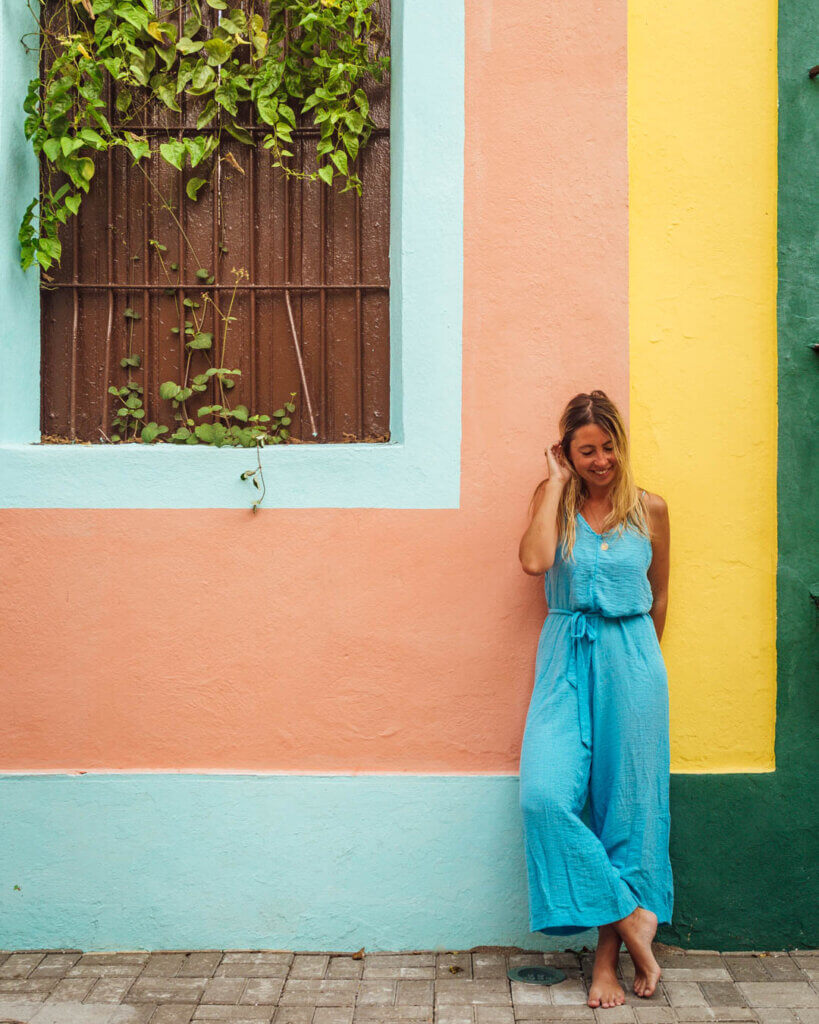
In the afternoon, venture out of the town and ascend the mountain to Hacienda Luna Clara, where you can immerse yourself in a captivating Cacao Experience, adding a unique touch to your Venezuela travel itinerary. This interactive experience takes you back to Colonial times, offering insights into the growth, processing, and roasting of cacao.
Learn about the traditional methods employed and savor the aroma of freshly roasted cacao. Indulge your senses by tasting the rich flavors of the roasted cacao and savor the final product, perhaps even with closed eyes. It’s a truly delightful experience that allows you to appreciate the journey from bean to chocolate.
Check the Parque Termatico out here @cacaolaexperiencia !

Day 11: Puerto Cabello to Choroni
It’s time to leave Puerto Cabello and head towards the wild jungle-like region of Choroni. Choroní is a small coastal town located in the Aragua state of Venezuela. It is known for its beautiful beaches, lush vegetation, and relaxed atmosphere, making it a popular tourist destination within the country.
Choroni offers picturesque landscapes, including palm-fringed beaches, crystal-clear waters, and nearby tropical rainforests.

How to get from Puerto Cabello to Choroni
I suggest leaving Puerto Cabello no later than 10 am. Buy a ticket to ideally Maracay or if no buses are available, to Valencia. This trip should cost around 2 $US. In Valencia change to a bus heading to Maracay. The trip will also be about 2 $US.
In Maracay, you have the option to take a public bus that heads to Choroni. Keep in mind these buses only leave when full and it can take a few hours if it’s low season. Alternatively, you can take a shared taxi for 7 $US.
The trip will take you for about 3 hours through windy mountain roads.
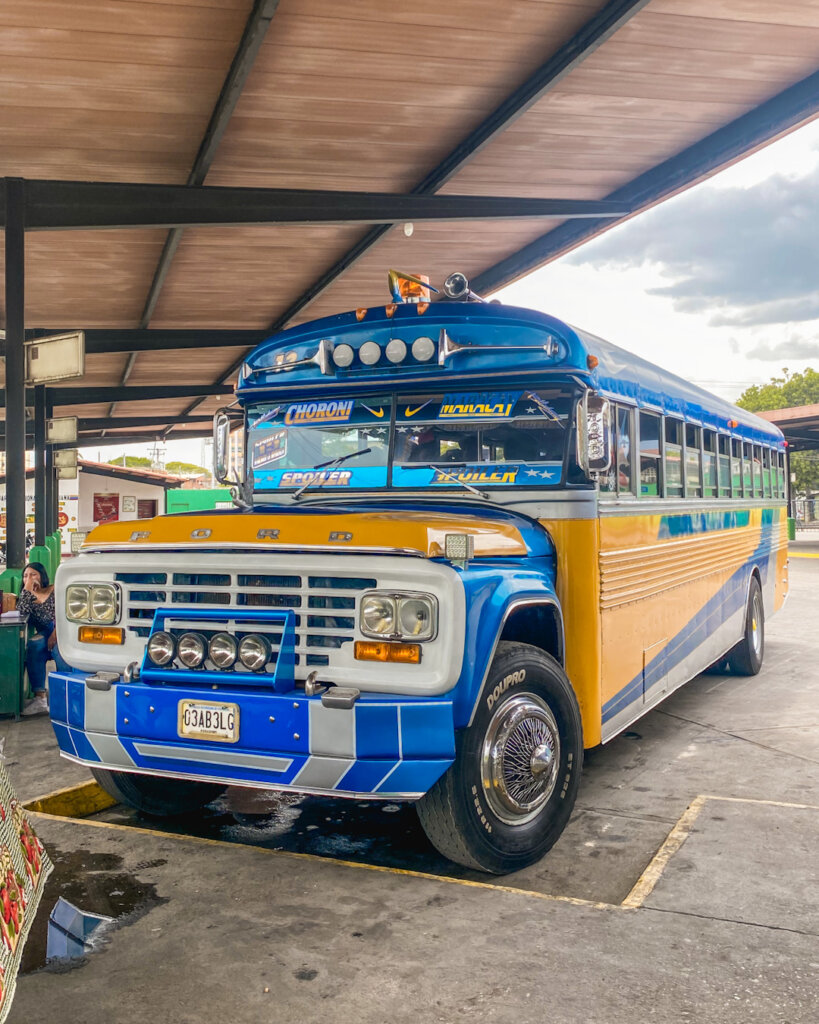
Where to stay in Choroni
Posada Bequeve – situated by a river, is an absolute gem to stay in. Its original hacienda has been around for over 20 years, now combining the old with new elements. Your stay will include a delicious breakfast and fusion-inspired multi-course dinner that will leave no room for wishes!
The unique decoration, its focus on sustainability and the wonderful staff make this posada a true highlight on every trip to Choroni!
TIP – if you head to Los Roques, they’ve got another one there!
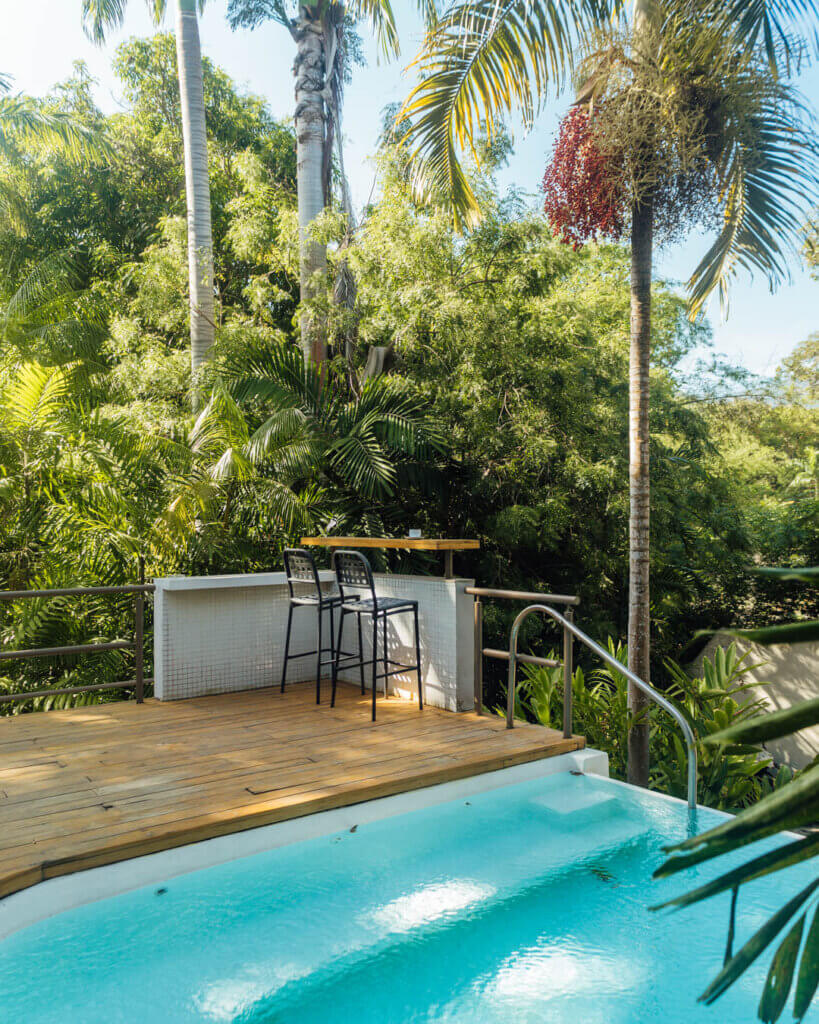
Day 12: Choroni
The town of Choroni, nestled amidst lush tropical vegetation and dense forests, sets the stage for unforgettable outdoor adventures as part of your Venezuela travel itinerary. The nearby Henri Pittier National Park, Venezuela’s oldest national park, offers opportunities for hiking, birdwatching, and exploring the diverse flora and fauna of the region.
Choroní is known for its breathtaking beaches with turquoise waters and powdery golden sands. In the morning, don’t miss the chance to visit Playa Grande, the main beach in Choroni, where you can soak up the picturesque scenery, swim in the inviting waters, and bask in the warm sun.

In the afternoon, head to its quaint town center. Choroní’s town center features charming colonial-style architecture, with colorful buildings, cobblestone streets, and small artisan shops. Exploring the town’s narrow streets and interacting with the friendly locals can provide a glimpse into the region’s history and daily life.
Just before sunset, head up the hill to the Christ statue for some of Choroni’s best viewpoints. The boat-filled river below, and the mountains in the distance it make watching the sunset so much more special!
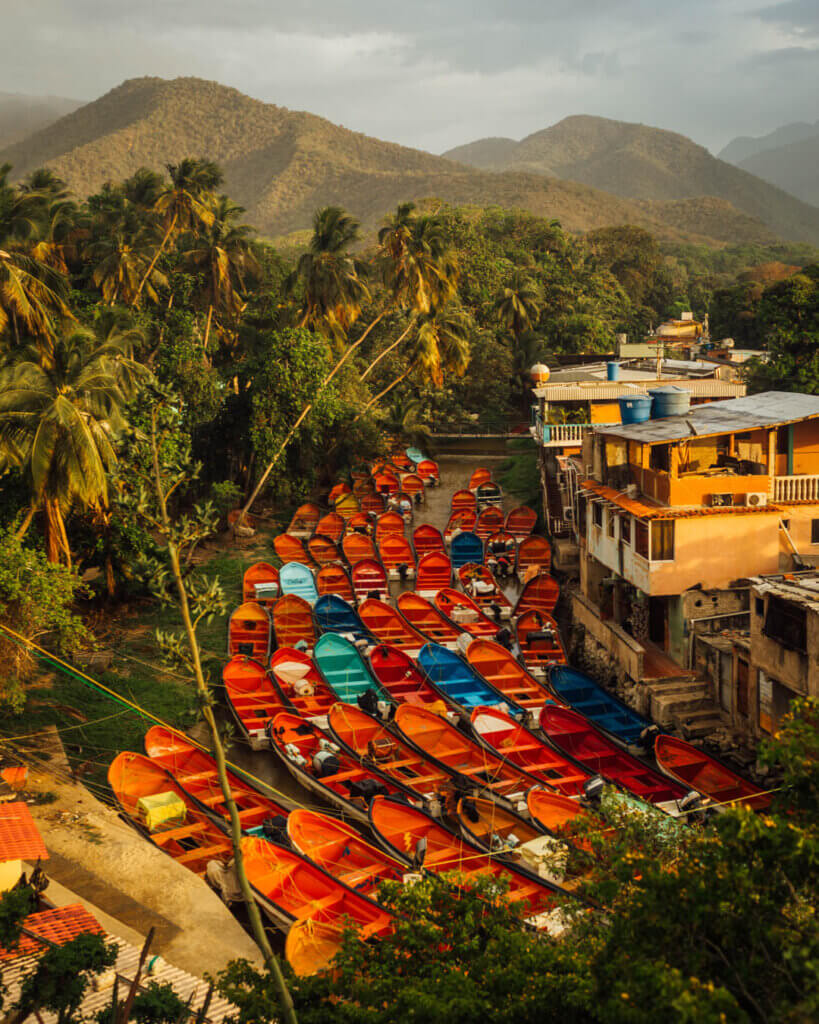
Day 13 Choroni to Caracas
As you near the end of your Venezuela travel itinerary, make sure to save time for a visit to Caracas, the dynamic capital city. Nestled in a picturesque valley surrounded by majestic mountains, Caracas is a bustling metropolis that serves as the final stop of your journey.
It’s the perfect place to soak in the political, cultural, and economic heartbeat of the country. With a population of over three million people, it serves as the country’s political, cultural, and economic center.
While Caracas has much to offer, it’s important to stay informed about the current situation and travel advisories in Venezuela!

How to get from Choroni to Caracas
Get to the bus terminal of Choroni before 11 am for your best chance of arriving in Caracas in daylight. As the buses need to fill up, I’d suggest you take a shared taxi for 7 US$ back to Maracay. In Maracay you can find many buses that leave to Caracas regularly. The trip will cost about 4-5 US$ and ends at La Bandera Terminal. The whole trip can take between 6-7 hours.
Near the bus station is also a metro stop which is your best bet to get into the city cheaply. It’s fine to walk this stretch as many people head the same way.
The metro in Caracas usually works by paying with a Venezuelan card. I have been waived every time as nobody accepted the price of 10 Bolivares in cash.

Where to stay in Caracas
Caracas, like any large city, has areas with varying levels of safety. It is crucial to prioritize safety when choosing a place to stay in Caracas. The Altamira and Las Mercedes neighborhoods are generally considered safer areas for tourists. These neighborhoods have a higher concentration of hotels, restaurants, embassies and shopping centers and are known for their relatively safer environment.
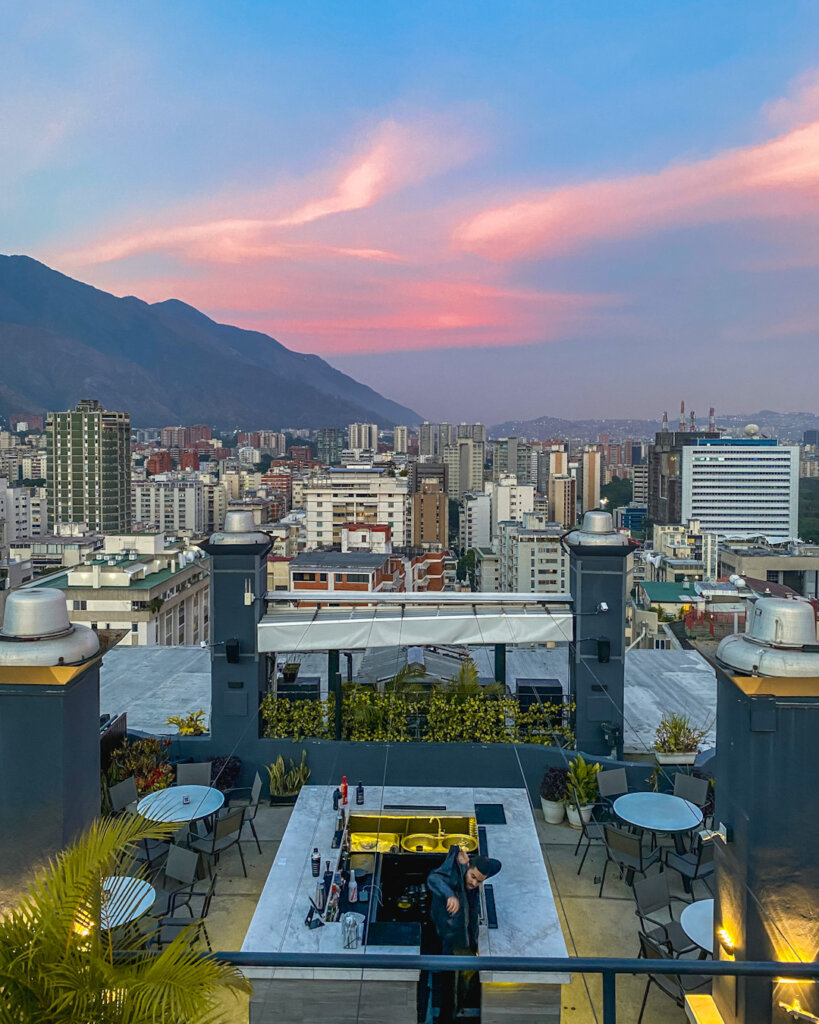
Day 14: Caracas
Caracas has a fascinating history dating back centuries. It was founded in 1567 and played a significant role in Venezuela’s struggle for independence from Spanish rule. Historical landmarks like the Caracas Cathedral, Bolivar Square, and the birthplace of Simon Bolivar, the liberator of several South American countries, showcase the city’s historical importance.
To start your day of exploring, head towards the center of Caracas and get off at Bellos Artes metro station. The city is home to numerous museums, art galleries, theaters, and cultural centers that showcase Venezuelan art, history, and performing arts.
TIP: If you visit from Thursday-Sunday you should be lucky and the museums are open for visitors!
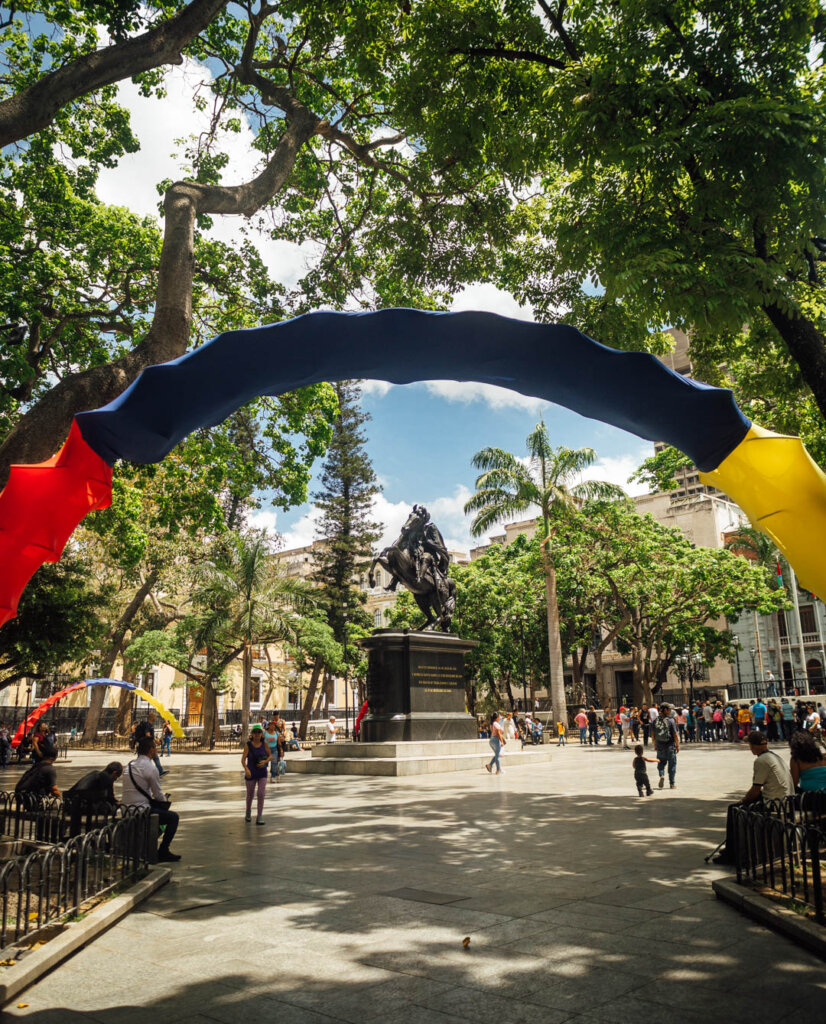
In the afternoon, head to Parque del Este to admire the striking modern skyline of Caracas, with its tall skyscrapers and contemporary architecture. The El Avila National Park, a majestic mountain overlooking the city, provides a stunning backdrop from there!
To end your day, head over to Altamira Suites Hotel and visit its 360 Rooftop bar for some of the top views of Caracas!
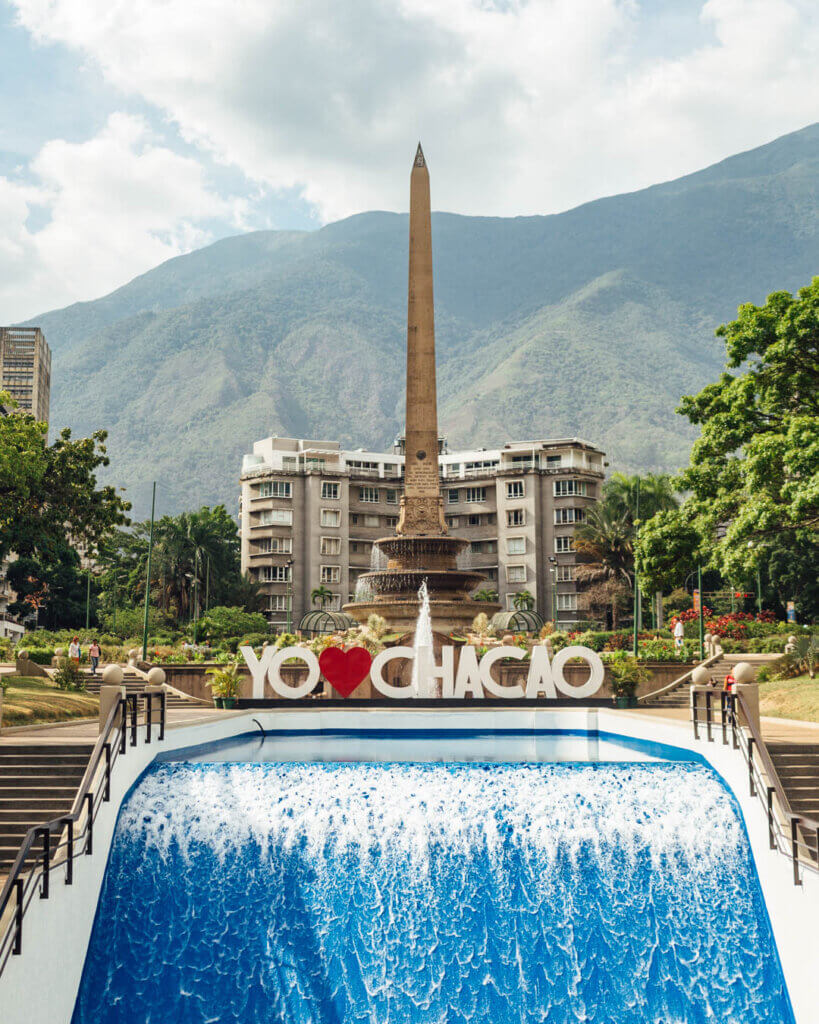
Day 15: Leaving Caracas
It’s time to leave this wonderful country.
To reach the Maiquetía “Simón Bolívar” International Airport, you have a couple of convenient options. One option is to call a Ridery cab, which typically costs around $25 from Altamira. Alternatively, you can take the metro to Bellos Artes and make your way toward the Alba Hotel or the nearby bridge. From there, you’ll find regular shuttle buses departing every 15 minutes to the airport. The journey, covering a distance of 21 km, shouldn’t exceed 30 minutes.
You’re two-week Venezuelan travel itinerary is completed and it hopefully has made your trip unforgettable!
Any questions about the trip? Give me a message on my Instagram @christintheilig !
Disclaimer: This article contains affiliate links. If you purchase using these links, I earn a small commission at no additional cost to you. I only recommend services and tools I know and trust myself.
Women Travel Essentials I Can’t Live Without
Travel insurance.
Having travel insurance that protects me no matter where I go has been an obligatory thing to have since day one. No matter if it was to study abroad, to go on a two-week vacation or start a full-time travel life – travel insurance is SO important. If you are looking for travel insurance to cover your next adventure, have a look at Safetywing to see if it suits you!
Travel Money Card
Are you still looking for the best option for your travels? Having a Wise travel money card that allows you to hold various currencies, has the lowest transaction fees and lets you withdraw money no matter where you are is worth GOLD. Wise has been my go-to choice for 4 years now and I wouldn’t go back to having only one credit card.
Get a Wise Card for FREE!
Pin for your future Venezuela trip!

"When people look at my pictures I want them to feel the way they do when they want to read a line of a poem twice". Robert Frank
Copyright © 2020-2024 · All Rights Reserved · Content Cannot Be Used Without My Permission · christintheilig.com

- DESTINATIONS
- EXPERIENCES

The Ultimate Adventure Guide to Venezuela
Hola amigos! Welcome to our Venezuela travel guide. We are Valery and Emmanuel. Two Venezuelans from Caracas. We met each other while working for Soco Adventures , our adventure travel agency.
Let us tell you about our beautiful country. The people here are always happy. Despite the adversities, we always try to look on the brighter side of life. We’ve had the pleasure of meeting many Venezuelans across the country – from indigenous populations to people from small towns.
One thing we know is that people are always happy to meet you and share with you what they have. It’s an honour for us. When we travel we try to donate money to small communities too. Interacting with the people of Venezuela makes us come back happier and more in love with our country each and every time.
Exploring all Corners of the Beautiful Venezuela
We started traveling through Venezuela two years ago. I guess we have covered around 80% of the country now. However, we do think that less is more sometimes. It’s nice to travel deeper into each place that we visit.
Venezuela is small: 916.000km2. You could experience the best of the best of the country in around two-three months max. For us, we also have other responsibilities when we travel like our adventure travel agency. So we can’t be traveling full-time. We utilise weekends and small trips of 7-10 days to visit the most amazing destinations of Venezuela.
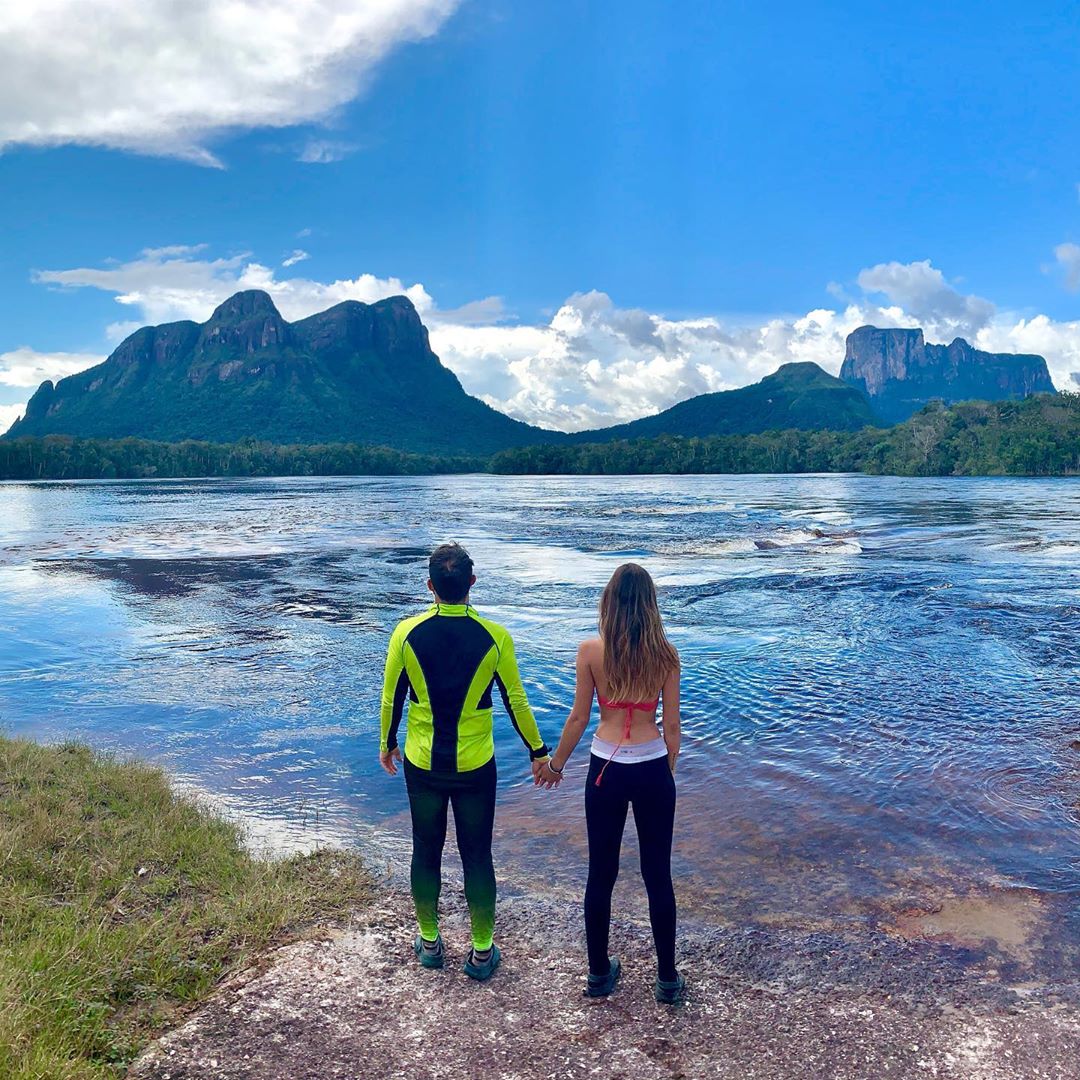
Venezuela Travel Guide: Visit Angels Falls and Mount Roraima
We both have different favourite places in Venezuela. Valery’s favourite is Angel Falls . It’s the highest waterfall in the world at a staggering 979m. The feelings and sensations of navigating the river to reach the base camp are indescribable! Honestly, you have to see it in real life for yourself. Truly a magical place that should be included in every Venezuela travel guide!
In Emmanuel’s case, Mount Roraima is his favourite. This Tapuy or “Big Rock” requires seven days of trekking and camping. After three days you can touch the wall and reach the top at 2800 metres above sea level. The views are simply spectacular.
All the effort of hiking for more than 30km to reach the top and seeing the magic of our planet – it’s an amazing experience! Exploring the top of Roraima and seeing the diversity of its landscapes is a huge WOW moment. You can see more about this destination in the YouTube video we made below.
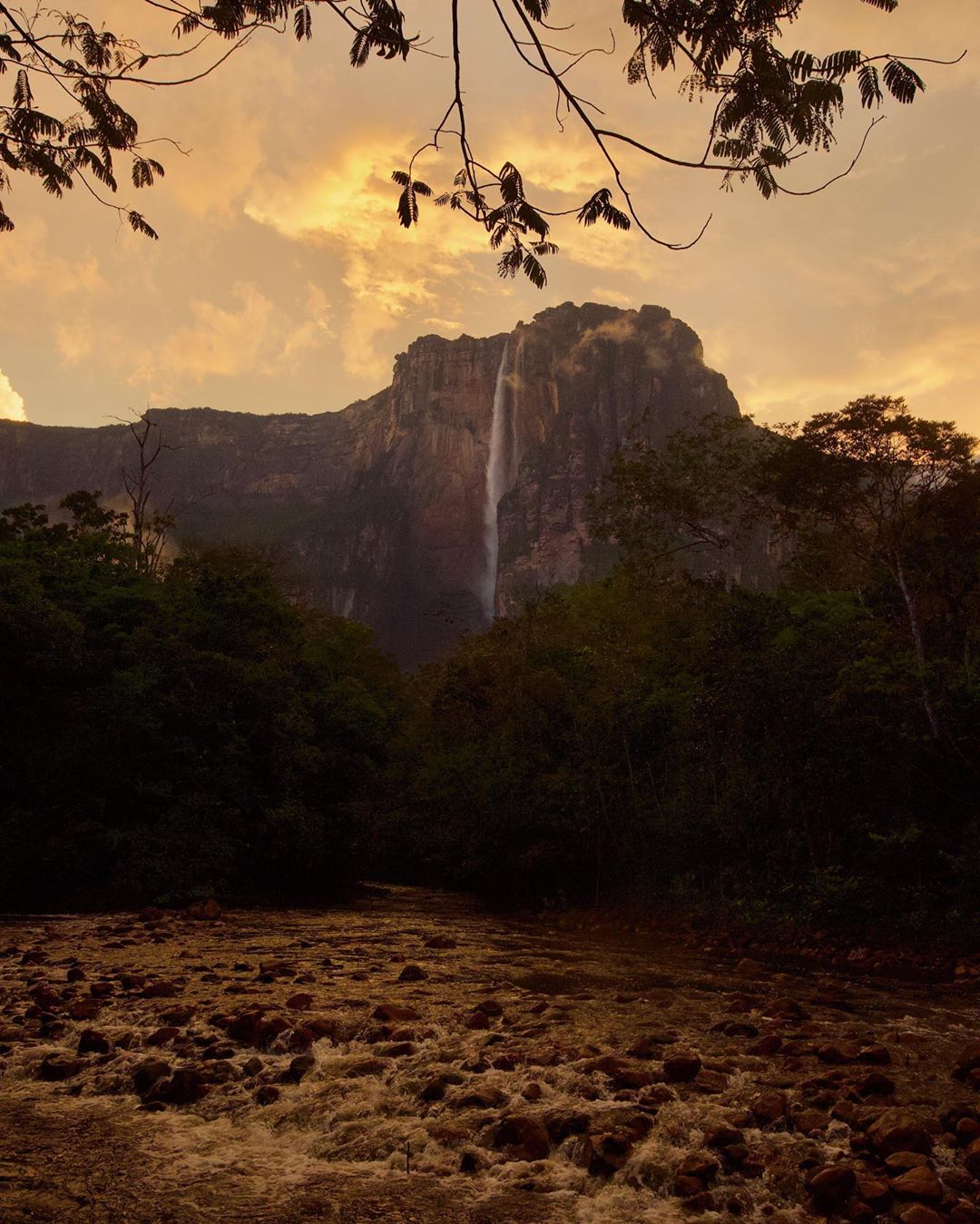
Venezuela Travel Guide: Top 5 Experiences
Our number one recommendation for our Venezuela travel guide is (of course) Angel Falls. It’s one of the most amazing places on earth. Emmanuel has visited 30 countries in the world and for him there is no place that quite compares to Angel Falls.
We review a lot of places on Google and if you see the interactions we’ve had on our Angel Falls review, you’ll realise that it’s not a common destination. Not only because of the height of the waterfalls, but also because people don’t tend to visit Canaima National Park in general.
Honestly, we are blessed to have Angel Falls in our country. The best way to visit is to contact a tour agency. We recommend our adventure travel agency . We create custom trips to all parts of Venezuela. This is one of our most popular trips that we do. We pick up tourists from the airport and stay with them for their entire stay in our country.
Our second experience is Mount Roraima. As mentioned above, this magical place actually looks like a floating island as the plateau sits 7000 metres above the forest. The mountain is surrounded by three different countries: Venezuela, Brazil and Guyana.
If you want to scale the cliff walls, you will need to have experience in climbing and mountaineering. However, there is a path up which is more suited for everyday hikers who have a decent level of fitness.
Coming in third on our list is Los Roques. This archipelago of more than 50 islands located on the Caribbean coast is pure paradise. The most popular island is El Gran Roque which is the only island where people live (the airport is situated here too). Other islands you should explore are Francisqui, Nordisqui, Madrisqui, Crasqui and many more!
La tortuga island is another must-do island destination. It’s located just three hours from the coast of Venezuela. No one lives here and it’s pure untouched island paradise. Our final recommendation is to do a road trip to Falcon. More details on this unique destination below.
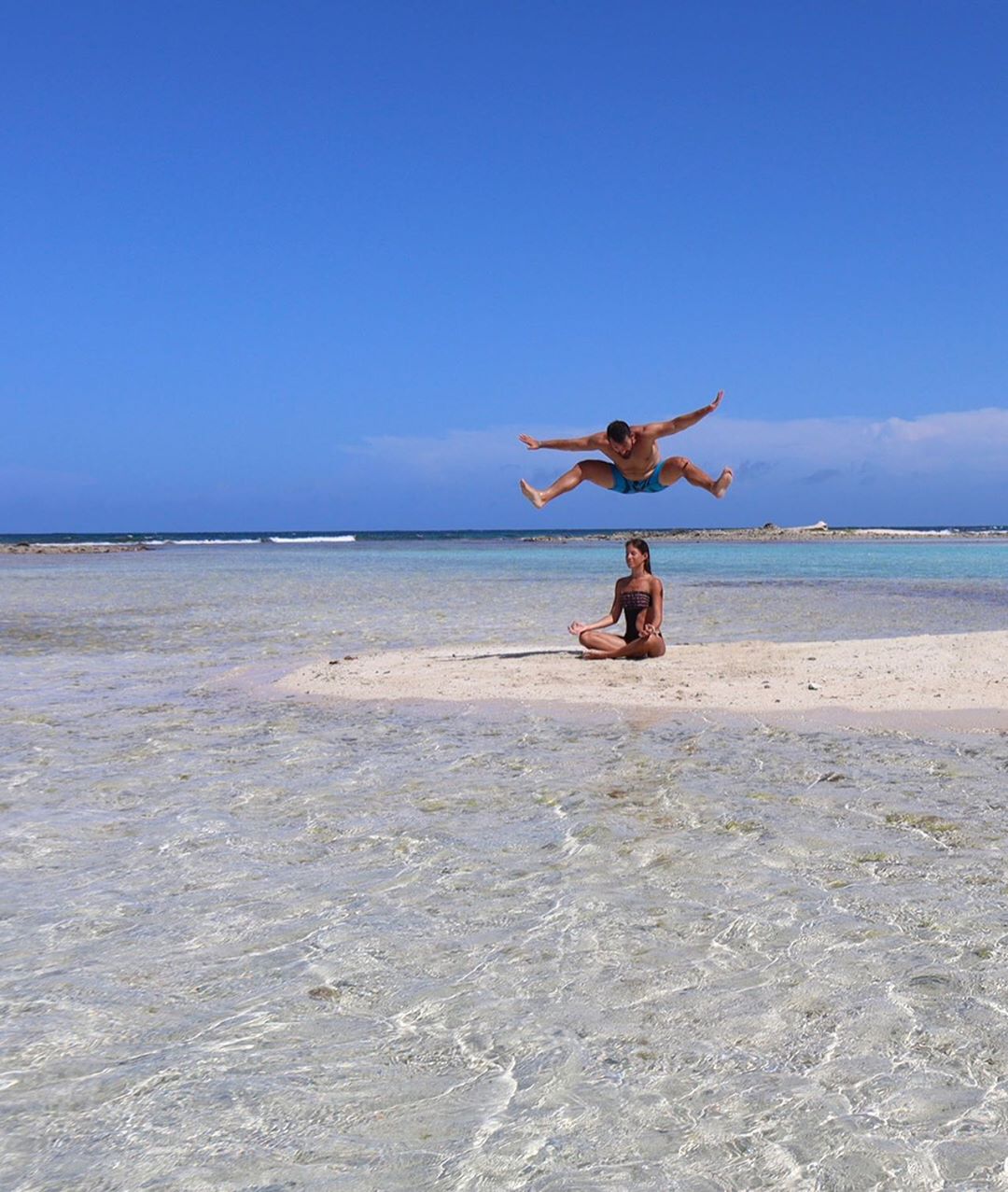
Las Salinas de las Cimaraguas in Falcon State
One of the most beautiful places to visit in Falcon State is Las Salinas de las Cumaraguas. At the beginning of this road trip, you pass through a road of palm trees and you start to feel like you’re entering paradise.
Then you can go to Tucacas and visit Morrocoy National Park. Next you go to the desert at Médanos de Coro and trek it’s dunes and take some amazing pictures. You can also practice sandboarding which is a lot of fun!
After tearing up the sand of Coro, head to Adicora – the wind paradise. This is the perfect beach for kitesurfing. Drive for a further 20 minutes and you’ll reach your main destination: Las Salinas de lals Cimaraguas. Seeing those amazing pink and salty waters for the first time will totally blow you away!
You can visit the salt lakes all year round. The best time to visit during the day is from 11am – 2pm because this is the time when the sun is shining brightest. The pinks are more intense and colourful during this time. These vibrant colours are created from bacteria (nothing bad) under the water that, mixed with sunlight, produces the pink colour.
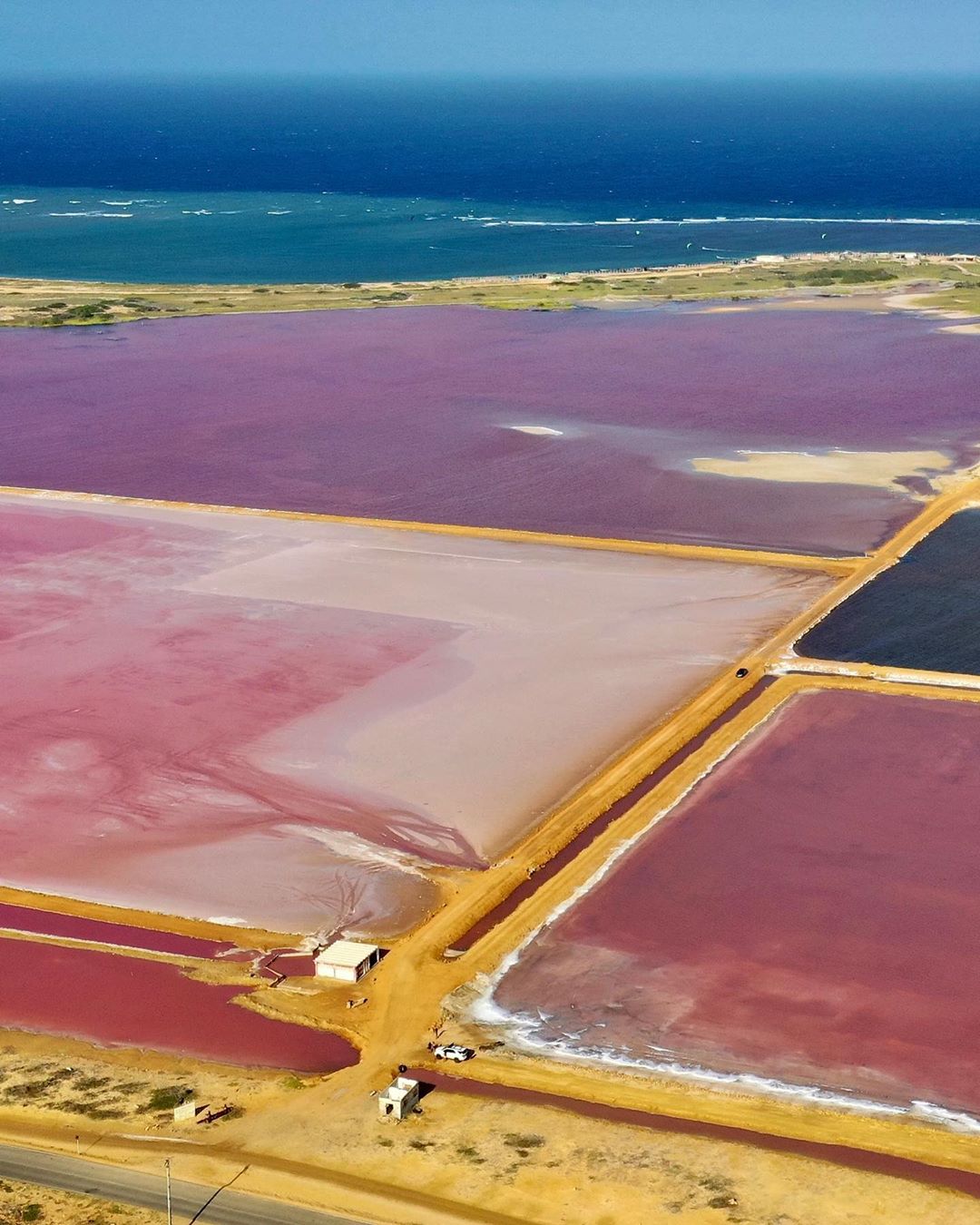
Venezuela Travel Guide: Where to Find the Best Beaches
In our top 5 experiences of Venezuela we mentioned some destinations with amazing beaches like Los Roques, La Tortuga Island and the Falcon State with its Morrocoy National Park. The best beaches are probably located in these three different destinations.
But honestly, there are several other places with stunning stretches of beach too like Choroni, La Blanquilla Island, La Orchila Island, Margarita Island and Cubagua Island.
Venezuela is a country with the biggest Caribbean coastline. It’s located on the equator line, so there’s not just beautiful places but also lovely weather. Sunny days and warm waters year round – isn’t that just perfect?!
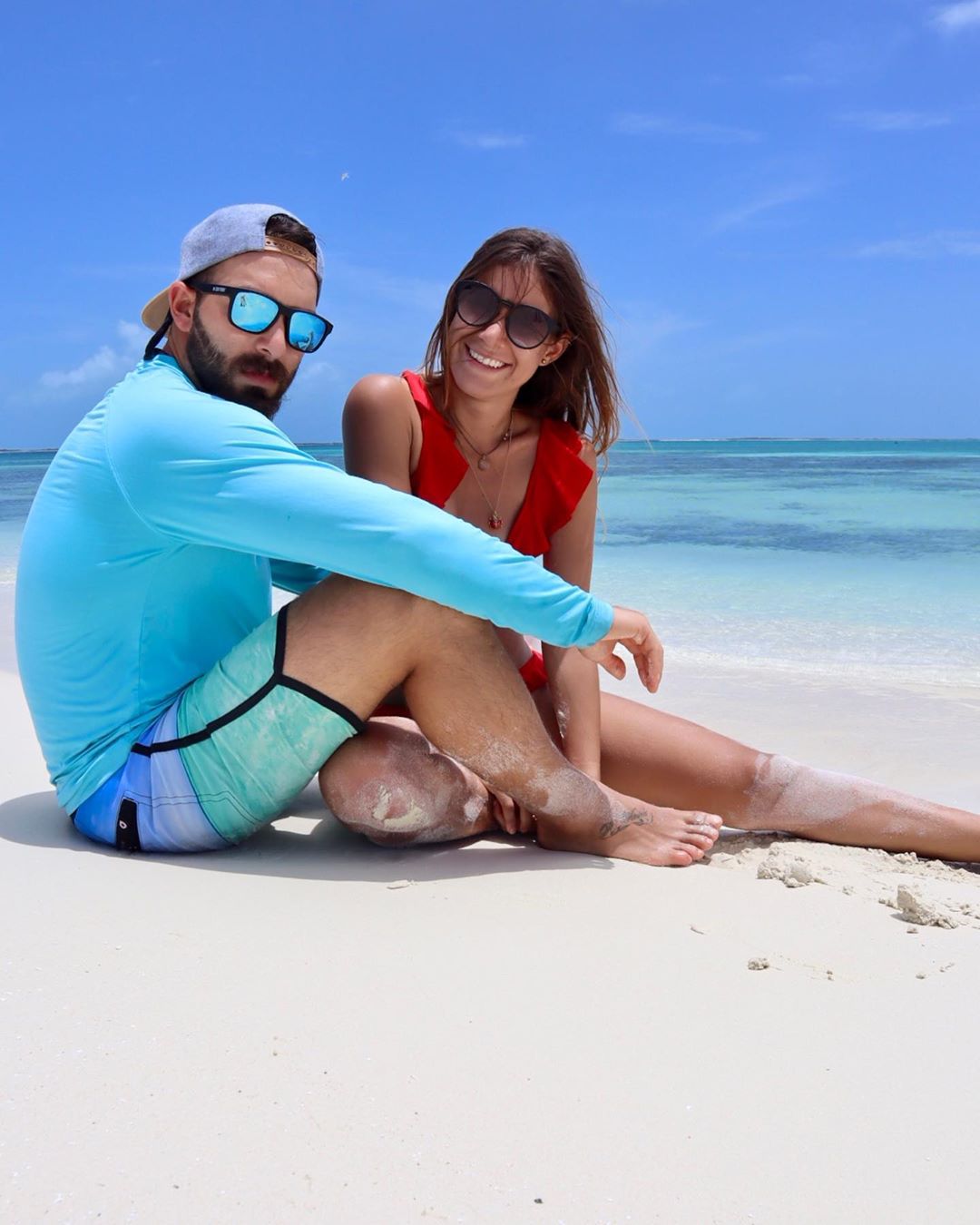
Our Most Cherished Travel Memory in Venezuela
It’s hard for us to have one single favourite travel moment in Venezuela because we live by the motto: “the best trip is the next one”! We always try to live every moment to the max in each day of our lives. However, one moment that comes to mind was from September last year when we were invited to explore Angel Falls.
We visited the falls and its surroundings for 10 days. It wasn’t the easiest trip since we had to do a lot of walking. We met many indigenous communities and did a lot of photography and videography work.
The best moment was when we went to the base at Angel Falls. Our guide asked us if we wanted to touch the wall of the Auyantepui (the big mountain or rock where Angel Falls is located). For context, on regular tours, you reach a viewpoint located 3km away from the exact location of the waterfall.
As we started to walk towards the waterfalls and feel the immense vibrations, we just started crying in gratitude for the opportunity to be there. We showered in the base of Angel Falls with water coming straight down from the top, over 900 metres of free fall!
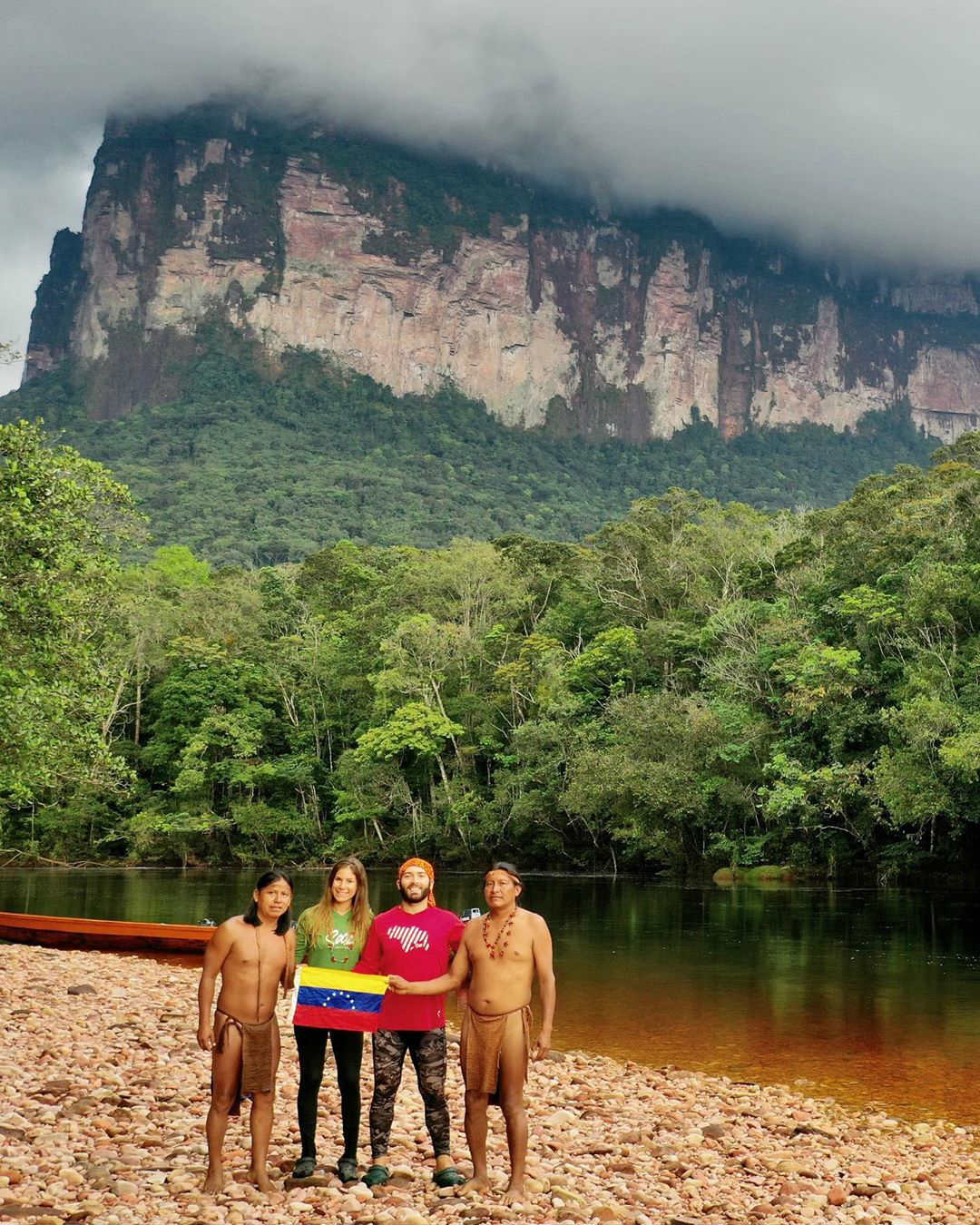
Venezuela Travel Guide: Taste the Delicious Food
Venezuela has several typical meals that you can find everywhere. The most recommended food is the Arepa. It’s like a salty corn doughnut cake that you open and can fill with chicken, beef, cheese, and whatever you like! Anything fits inside a Venezuelan Arepa.
Cachapa is another favourite with sweet corn dough that’s slightly bigger than the Arepa. It’s best eaten with pork, cheese and sweet plantains inside. If you come in December you can also try the Hallaca which is like a Mexican Tamale filled with chicken, pork, steak, vegetables and Venezuelan seasoning all wrapped in plantain leaves. Yum!
Venezuela Travel Guide: Is it Safe to Visit?
The safety of traveling here is a controversial theme to talk about. It’s probably the most requested topic in any Venezuela travel guide. Social media and the news has shown only the worst parts of our country. It’s obviously the stuff that gets the most attention to sell advertising.
However, Venezuela is an amazing country. For sure, it’s not 100% ready to embrace mass tourism but we are on the way. You will find it a safe country if you want to visit the tourist destinations. People are respectful and embrace other cultures.
It’s a shame that politics has destroyed the economy and much of the society in Venezuela. Many people find themselves in poverty because of this. There are dangerous areas where we recommend tourists don’t visit (at least by yourself). Although, those areas are neighbourhoods far away from tourist spots.
We have been affected by politics in things like the quality of our roads and the price of gas at gas stations. Apart from that, if you take precautions (like the ones we recommend in our YouTube videos) then you will not only be safe but Venezuela will be one of your favourite countries for sure!
What you Need to Know Before you Go
Our number one tip for our travel guide to Venezuela is to try contact people who live here before you arrive. We are always here to help. Do not exchange your currency at the airport to bolivars (our currency) because they always pay you way less than the real price.
Try to get in touch with adventure travel agencies. It’s the best, safest and most exclusive way to visit the most incredible places in Venezuela. Be prepared to fall in love and stay forever in this amazing country.
Thanks for reading our Venezuela travel guide! We hope it has inspired you to visit one of the most beautiful countries on earth. Feel free to get in touch with us if you have any more questions or would like to book a tour with our agency: Soco Adventures!
BY VALERY & EMMANUEL IG: @DOSLOCOSDEVIAJE IG: @SOCOADVENTURES
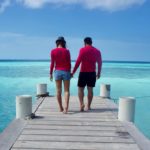
Author: Valery & Emmanuel
Travel couple from Caracas who run the adventure travel agency in Venezuala called Soco Adventures.
Related posts

Leave a Reply Cancel reply
Your email address will not be published. Required fields are marked *
Save my name, email, and website in this browser for the next time I comment.
Post comment
Travel experiences
Accommodation.
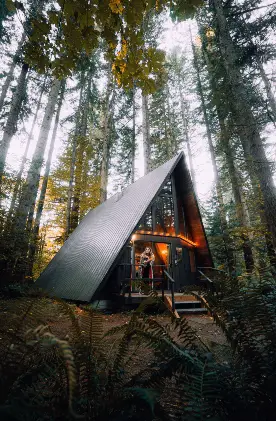
Beaches & Islands
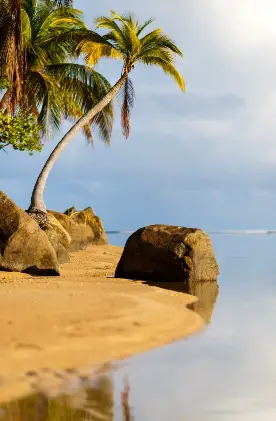
Food & Drink
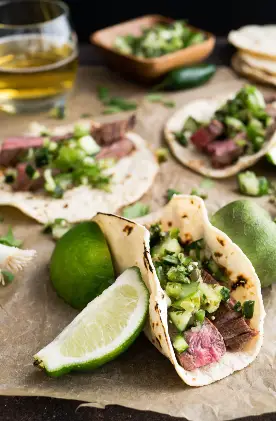
Historical Sites

Living Abroad
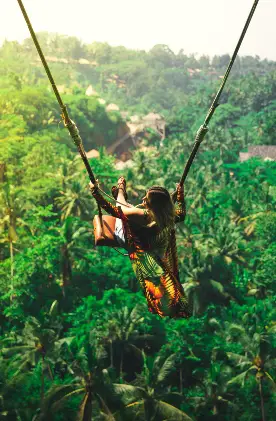
National Parks
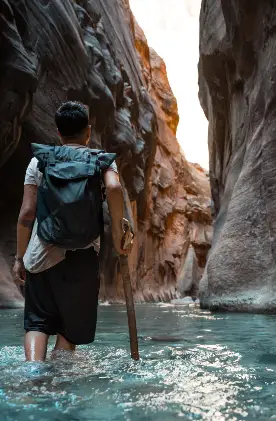
Towns & Villages
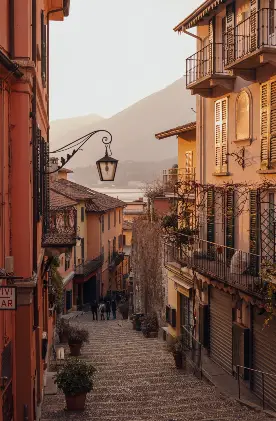
Travel Tips
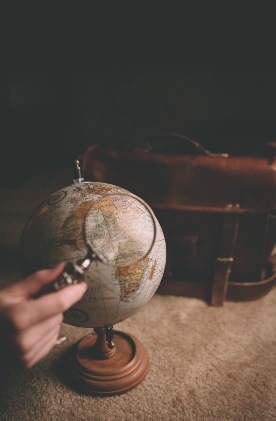
Sign up to our newsletter
- 3 Other destinations
- 4.1 Terrain
- 4.2.1 Venezuela in the 20th century
- 4.2.2 Venezuela under Hugo Chávez (1999 - 2013)
- 4.2.3 Venezuelan crisis (2013 - present)
- 4.3 Electricity
- 4.4 Holidays
- 4.5 Tourism information
- 5.1 Visa requirements
- 5.2 By plane
- 6.1 General
- 6.2 By train
- 6.5 In cities
- 10.2 Handicrafts
- 10.3 Food and drink
- 16 Stay safe
- 17 Stay healthy
- 19.1.1 Mobile phones
- 19.2 By net
- 19.3 By mail
Venezuela used to be one of South America's most politically and economically stable countries, but since the 1980s, it has been in the news for all the wrong reasons and is unsafe to travel to. A long, winding history of gross economic mismanagement and ineffective governance has completely battered the country and the country has been experiencing its worst ever humanitarian crisis since the mid-20th century.
Venezuelans are known for their tolerance, hospitality, and zest for life and you can expect a warm welcome from them.
Regions [ edit ]

Cities [ edit ]
- 10.5 -66.916667 1 Caracas – Being the capital and the largest city in Venezuela, Caracas is known for being one of the most cosmopolitan and modern cities in South America. There are lots of places to visit, such as theaters, malls, museums, art galleries, parks, well-conserved colonial architecture and even gourmet restaurants.
- 11.417 -69.67 2 Coro – The first capital of Venezuela and a city of rich colonial architecture, a unique natural scenery and tourist attractiveness. Its historical downtown is considered as a cultural World Heritage Site.
- 8.088279 -63.553555 3 Ciudad Bolívar – Stop-off point for flights to Angel Falls, and a comfortable stopover to Brazil.
- 8.366312 -62.649681 4 Ciudad Guayana – Dominated by heavy industry, it is Venezuela´s most organized city and the main gateway to the Orinoco Delta and the Gran Sabana. It is locally still known as either Puerto Ordaz or San Félix.
- 10.65 -71.633333 5 Maracaibo – Venezuela's second largest city, swelteringly hot and built on oil.
- 10.246944 -67.596111 6 Maracay – Once the capital of Venezuela, now home to the main military garrison.
- 8.6 -71.15 7 Mérida – A charming university town in the Andes mountains, popular for outdoor activities.
- 10.2 -64.633333 8 Puerto La Cruz – The city to go to if you want to visit the beaches in Eastern Venezuela.
- 7.766667 -72.233333 9 San Cristóbal – A leafy industrious city in the Andes mountains, bordering Colombia.
Other destinations [ edit ]
- 10.506944 -67.606389 2 Choroní Beach ( Playa Grande or El Malecon )
- 11.8575 -66.7575 3 Los Roques Archipelago ( Archipiélago Los Roque )
- 10.986944 -63.935556 4 Margarita Island ( Isla Margarita )
- 10.261389 -64.48 5 Mochima National Park ( Parque Nacional Mochima )
- 10.856 -68.306 6 Morrocoy National Park ( Parque Nacional Morrocoy )
- 8.17 -68.88 7 Los Llanos ( The Plains )
- 6.25 -62.838333 9 La Gran Sabana ( The Great Savanna )
Understand [ edit ]

Venezuela is home to the world's highest waterfall, Angel Falls and the second longest river in South America, the Orinoco. It also has the longest coastline to the Caribbean sea. Venezuela is the world's fifth-largest oil exporter and also has vast untapped reserves of natural gas. Ecologically, Venezuela is considered among the 20 Megadiverse countries of the planet; more than 40% of its national territory is covered by protected areas.
Terrain [ edit ]
Andes Mountains and Maracaibo Lowlands in the northwest; central plains (llanos); Guiana Highlands in the southeast. Nueva Esparta islands in the northeast
History [ edit ]
Venezuela was inhabited by Pre-Columbian peoples when it was claimed as a possession of the Spanish Empire by Christopher Columbus during his third voyage in 1498.
Venezuela was one of the three countries that emerged from the collapse of Gran Colombia in 1830 (the others being Colombia and Ecuador). For most of the first half of the 20th century, Venezuela was ruled by military strongmen and the country was largely underdeveloped, depending mainly on agriculture.
Venezuela in the 20th century [ edit ]
During World War I, large, massive, and plentiful oil and gas reserves were discovered in Lake Maracaibo. This proved to be pivotal for the country — standards of living markedly improved, the country became more industrialised, the country received a great deal of immigrants from all over the world, and the country enjoyed an economic boom that lasted well over several decades.
Overreliance on oil and gas reserves soon proved to be Venezuela's undoing — the economy was badly damaged by the sudden shift in global oil prices during the 1980s, culminating in economic collapse, dissatisfaction with the government, and widespread political and social unrest. A number of banks became bankrupt in the mid-1990s, further complicating matters.
Venezuela under Hugo Chávez (1999 - 2013) [ edit ]
The collapse of confidence in the government led to Hugo Chávez being elected president in the late 1990s.
Chávez rewrote the constitution of the country, and initiated the creation of a Bolivarian Republic, i.e, a country's whose principles are based on the beliefs and ideals of Simon Bolivar. Chávez created Bolivarian missions aimed at improving economic, cultural, and social conditions, and implemented a number of socialist and protectionist policies. High oil prices in the early 2000s brought about some form of economic buoyancy.
While these actions and policies made Chávez a popular figure among many Venezuelans, it became increasingly apparent by the 2010s that the Chávez government was poorly managing the country – inflation was high, there were occasional shortages of food and supplies, and the government still depended a lot on oil and gas reserves. Poverty, corruption, and crime increased year by year, sowing the seeds for the Venezuelan crisis.
Venezuelan crisis (2013 - present) [ edit ]
Chavez died in March 2013 and was succeeded by his vice president, Nicolas Maduro, a bus driver turned trade union leader turned politician.
Maduro has continued all of his predecessor's policies, causing the country's worst ever humanitarian crisis to date. Basic supplies of food and medicine are scarce, violent crime has skyrocketed, businesses have been forced to shut down, and thousands of Venezuelans have been pushed into poverty.
Life for the vast majority of Venezuelans has become incredibly miserable, and many have since emigrated in search of better opportunities elsewhere. Many Venezuelans feel there's no hope or future left for their country, although a small portion of people feel that things will change in due time.
Electricity [ edit ]
Venezuela uses a 60 Hz and 120 V power system. The power plugs are identical to those used in North America (referred to as A and B type power plugs).
Power supply is not stable in the majority of the Country. There are shortages of several hours and sometimes they can last days, depending on the area, time of the year and climate events. For this reason, many facilities and private homes install backup power generators if they can.
Holidays [ edit ]
- January 1: New Year's Day
- January 14: Feast of the Divina Pastors
- February 12: Youth Day
- February 20: Federation Day
- March 21: Slavery Abolition Anniversary
- April 19: Independence Movement Day
- July 5: Independence Day
- July 24: Birth of Simón Bolívar
- September 8: Birth of the Virgin Mary and Feasts of the Virgin del Valle and Our Lady of Coromoto
- October 12: Day of Indigenous Resistance
- December 8: Immaculate Conception and Loyalty Day
- December 25: Christmas
Christmas is celebrated as a religious event. The unofficial start of the Christmas festivities is after the celebrations of "Feria de la Chinita", the second half of November, with various religious activities, processions, and music. In many places, neighborhoods get together for the "patinatas" night festivals, events usually sponsored by the local church but organized be the people. In some neighborhoods there is the "Parranda" where people go from house to house with music and Christmas songs, expecting some food and drinks in return.
Tourism information [ edit ]
- Venezuelan Ministty of Tourism .
Get in [ edit ]

Visa requirements [ edit ]
Citizens of the following countries may not require a visa to visit Venezuela for tourist purposes only for up to 90 days (a tourist-card will be issued instead): Andorra, Antigua & Barbuda, Argentina, Australia, Austria, Barbados, Belgium, Belize, Brazil, Bulgaria, Canada, Chile, Costa Rica, Denmark, Dominica, Finland, France, Germany, Greece, Grenada, Hong Kong, Iceland, Iran (max. 15 days), Ireland, Italy, Jamaica, Japan, Korea (South) Lithuania, Liechtenstein, Luxembourg, Malaysia, Mexico, Monaco, Netherlands, Netherlands Antilles, Nevis, New Zealand, Norway, Paraguay, Poland, Portugal, Russia, San Marino, Spain, St. Kitts, St. Lucia, St. Vincent & The Grenadines, Sweden, Switzerland, Taiwan, Trinidad & Tobago, United Kingdom, and Uruguay. Business travelers almost invariably require a visa to be issued before entry.
In Caracas, passengers pass through immigration in the arrivals hall before going to baggage claim. Officers will check your passport and may ask questions. If a customs officer or anyone asks about your purpose of visit, tell them you are only there to visit, tourism. At baggage claim you will be required to match the baggage sticker on your flight ticket to the bar code on your bag before you hand over your tax form to customs officials.
There will be many individuals who approach you after your arrival offering assistance with locating a taxi or trading currency. It is best to not interact with anyone who approaches you. Even airport officials with proper identification may attempt to lead you to other areas of the airport to trade currency on the black market. When taking a taxi from the airport, always settle on a price before getting into the cab, and only use taxis that have the official yellow oval seal.
By plane [ edit ]
The main international airport is Simon Bolivar International Airport ( also known as Maiquetia airport ), ( CCS IATA ) in the Vargas state. It is approximately a 30-minute ride from Caracas. Buses are available during the day, departing from Parque Central and Avenida Lecuna bus station next to Calle del Sur. Buses run from 7AM-6PM. A taxi ride from the airport will cost US$5-7, or US$6-8 at night. There are international flights to Maracaibo, Porlamar and Valencia, but the choices are very limited.
To Caracas you can travel nonstop from Latin American, Caribbean and European cities. Direct flights from/to the U.S. and Canada have been suspended or terminated.
From Europe, there are nonstop flights from Madrid (Air Europa, Estelar, Plus Ultra), Paris (Air France), Rome (Estelar), Tenerife North (Plus Ultra), and Lisbon (TAP). Iberia flies from Madrid with a technical stop in Santo Domingo. With Turkish Airlines you can fly from Istanbul with a short stopover in Havana.
Aeropostal, CONVIASA, Avianca, Copa Airlines, Lloyd, LATAM and Aerolíneas Argentinas provide flights to the rest of Central America and South America.
Copa Airlines has a daily service from Caracas, Maracaibo and Valencia to Panama and connections to all South America, Central America and USA.
For international departures (at Maiquetia Airport), the airport tax is US$23-53.49, and the departure tax US$21.40-9.20. These taxes are paid at the airport, although many airline tickets might include these taxes.
It is still a good idea to keep at least US$50 on hand when departing from Venezuela. If the fees increase, or you are required to pay both the airport and departure tax, you can head into the main lobby area where many businessmen will eagerly buy US dollars. If you are stuck without cash, you can ask airline employees to charge your credit card and provide you with cash to pay the airport tax. Ask for 'efectivo' when employing this strategy.
For domestic flights (at Maiquetia Airport), there is an airport tax. Aeropostal Alas de Venezuela, Santa Bárbara Airlines, Avior Airlines, Conviasa and Aserca Airlines are the major domestic airlines in Venezuela.
By car [ edit ]
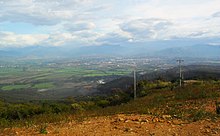
Venezuela has road links with Colombia and Brazil . The road crossing to Brazil, not far from the frontier town of Santa Elena de Uairén , is a long way from most tourist destinations in Venezuela and so not a common point of entry. Border controls are tight and all travelers arriving from Boa Vista are expected to have visas. The Venezuelan consulate in Boa Vista is on Av Benjamin Constant.
Venezuela's main connection with Colombia is from Cúcuta to Venezuela's frontier town of San Antonio del Táchira , which is about 50 km from the busy Andean city of San Cristóbal . For a day visit to Cúcuta no visa documents are required but border controls are otherwise very tight with frequent searches. The border area can be dangerous and visitors should pass through quickly.
In 2012, border controls were fairly relaxed from Venezuela to Colombia; it was possible to take a local bus directly from San Cristobal to Cucuta. As locals do not need to stamp their passports, the bus did not wait for third-country nationals undertaking the migration procedures. Smuggling of subsidised Venezuelan goods into Colombia became commonplace before oil prices collapsed in 2014; this flow has now reversed as Venezuela has been gripped by widespread shortages of basic goods. This has led to clampdowns at the border, and crossings have been sporadically closed.
If you are leaving Venezuela by land from San Antonio to Cucuta, you are obliged to pay the departure tax, so do not change all your bolivares in Venezuela.
Get around [ edit ]

General [ edit ]
Travelers in Venezuela are obliged to carry identification. There are military checkpoints on many roads, so while traveling by car or bus keep your passport handy, ideally you should keep a color photocopy of your passport. Should your passport be stolen, this will facilitate procedures with your local consulate. The military presence is constant, yet is not usually cause for concern. That having been said, there are corrupt officials. It is wise to keep a close eye on your belongings when, for instance, bags are being checked for drugs. A soldier of the Guardia Nacional (National Guard) sometimes plants drugs to solicit a bribe or steal valuables. Penalties for drug use are severe, and the burden of proof falls on the accused, the police may also demand bribes using the same modus operandi.
There is only one rather short intercity rail line in Venezuela, which leaves three options for travel inside the country: car rental, using buses, and using cars-for-hire. Drivers in Venezuela are generally aggressive and unconcerned by traffic regulations. The traffic in Venezuela is very bad, the drivers are aggressive and all drivers want to be the first. Thus, car rental is not recommended in general. The very cheap fuel prices make this option fairly economical. The expensive part of renting a car will be the insurance. Fuel prices as of Aug 2018 remained fixed at 1 BsF per litre, which meant that a million Imperial gallons (4,500,000 L) was worth about US$1 at black-market currency exchange rates. The Venezuelan government is looking to eliminate these generous subsidies, but any change to the status quo will incur strong political backlash.
Do not underestimate the sheer chaos of Venezuela's traffic. The often ignored road rules state that you must drive on the right unless overtaking and give way to traffic coming on to a roundabout. Drivers frequently top 160 km/h (100 mph) on intercity highways. Laws requiring car occupants to wear seat belts are not always complied with.
Traffic lights are often ignored, especially in the night, not for lack of patience, but drivers do not like to stop the car as they can be robbed while stopped. Motorcycles (moto taxis) are sometimes seen transporting up to five people, usually without helmets, which adds to the dangers of the road.
At Venezuelan crosswalks, pedestrians do not have the right of the way as they do in the U.S. and many European countries. If you slow down or stop at a crosswalk to allow a pedestrian to cross, you could cause an accident with unsuspecting motorists.
By train [ edit ]
There is a only a single line of some 40 km (25 mi) operated by the state railway connecting Caracas and Cúa via Charallave as of 2023, so this mode of transportation is practically not an option.
By bus [ edit ]
The bus system is extensive and extremely affordable (in part due to the low price of fuel). Bus terminals are hectic, but it is usually easy to find a bus to any major city leaving within a short amount of time. Short bus rides (2 hours) may cost US$3-7, and even extremely long bus rides (9 hours) will only cost US$10-35. The larger buses are typically air-conditioned. In fact, they are usually overly air-conditioned, so it is worth bringing a blanket with you. Buses are an easy and convenient way to get around the country. However, proper security awareness should be exercised as robberies occasionally take place on buses in cities and on highways. It is best to choose bus lines that use a metal detector and bag check to insure no passengers are carrying weapons of any kind.
If you decide to travel by bus a good option is Aeroexpresos Ejecutivo . They have their own terminal in a residential zone of Caracas (Chacao, Bello Campo), and baggage is checked on the buses (as in an airport). The buses are clean, safe and well-maintained, plus the drivers are trained to respect the speed limit (there are many accidents on regular buses on Venezuelan highways, most of them caused by speeding on poorly maintained roads). They are more expensive than a regular bus, but still cheap by American or European standards. You may pay with credit card and buy tickets in advance by phone. Aeroexpresos offers slightly more expensive options for many long routes that include semi-cama seating, chairs that recline extra, and allow for more comfortable sleeping on overnight trips.
For smaller towns, there may not be regular buses. In such cases, one can use cars-for-hire, called "por puestos." These are typically old and run-down vehicles, but they are affordable. They are more expensive than buses, typically costing US$5-9 per person for a one- or two-hour ride. The main problem is that they typically wait to have a full car (4 or 5 passengers) before undertaking a route. The driver will usually try to convince you to pay for the extra passengers if you want to leave right away. The cars are popular, however, and one does not usually wait long for a car to fill up. Por puestos are identifiable by signage bearing the name of the streets or destinations they typically drive along or stop at. Avoid traveling alone in a por puesto and avoid 'pirates', unofficial taxis that may intend to rob foreigners.

A large and paved road network (which comprises approx. 82,000 km) make Venezuela an attractive country for exploring with your own car.
Many roads are in good condition but there are also gravel and dirt roads for which an off-road vehicle is recommended – especially during the rainy season from May to October. This is why it is important to travel with a good road map (e.g. Venezuela Laminated Map by Berndtson & Berndtson ) and to be well informed about distances, road conditions and the estimated travel time. On the web, the site of cochera andina publishes information on nearly 120 routes in the country.
You can rent a car, usually for US$20-50 a day, plus insurance and legal liability. This may make you think twice about renting a car, especially when considering the fact that renting a car with a driver usually costs the same.
Fuel price is officialy fixed and subsidized by the government at 0.5$/litre and in other cases sold for a more subsidized price for locals. It is not available everywhere in the coutnry and because of scarcity you may find it from resellers with prices ranging from 1$/litre in the informal market; there are many filling stations in the main areas and cities. For outlying areas, you should fill the tank before you leave or take a reserve canister with you. In the mountains, fuel consumption often increases to over 15 L/100 km.
An international driver's license is needed to drive in Venezuela. Police will often ask for the license as well as for the frame or motor number during routine checks. Traffic rules generally comply with the international standard. But do not underestimate the sheer chaos of Venezuela's traffic. Be attentive when driving in Venezuela. Note that there are many police and military control on the interstate roads that will inspect your documents or vehicle, and many will try to take a bribe, try to avoid this. Filming the police and military is legally allowed in Venezuela (as of 2023).
The often ignored traffic rules state that you must drive on the right unless overtaking and give way to traffic in a roundabout. Although the maximum speed limit is 80 km/h outside the city and 60 km/h within the city (at night 50 km/h) local drivers frequently top 160 km/h (100 mph) on intercity highways. The law obligates car occupants to drive with fastened seat belts – which is regularly ignored. If you are in a traffic jam, other drivers will try to pass. Be aware also that motorcycles are sometimes transporting up to five people, without helmets. Try to avoid travelling at night, but if you do, pay special attention: streets and cars as well as bicycles often have poor lights. Even "good" roads may have unexpected and deep potholes. For this reason, and for security issues in general, like crime, long-distance intercity car travel is not recommended during dark hours. Keep in mind that cellphone coverage is scarce, so it's recommended to download offline maps for routing.
Good sign-posting is only found on the main roads. Common and especially important road signs are:
- Curva peligrosa: "Dangerous curve"
- Sucesión de curvas: "Winding road"
- Reduzca velocidad: "Reduce speed"
- Conserve su derecha: "Keep right"
In cities [ edit ]
Travel within cities is usually via taxi. Taxis are more expensive than any other form of transport, but still affordable when compared to North American or European equivalents. The taxis do not have meters and will charge more at night. This is normal in Venezuela, however all prices are flexible in the Venezuelan economy, so it is a good idea to negotiate the fare for the ride up front. Tipping is not expected and not necessary. The driver considers the tip as part of the fare they are charging and will factor that into the negotiations.
Local buses exist, and usually connect the terminal to the city centre. Bus routes usually remain a mystery to the uninitiated and you can try to read the signals in the windows (going to-coming from).
Caracas has a clean, modern and cheap metro system [dead link] , which is being expanded. While armed robberies are almost unheard of in the metro, pickpocketing is rampant. Typically, delinquents will aim to distract the passenger and then another member of the group will remove the wallet, or bag in the opportune moment. It is best to keep bags in front of you and avoid unsolicited contact with strangers.
Talk [ edit ]
Spanish is the official language of Venezuela, accompanied by numerous indigenous languages (usually never heard except in the Amazon region). Venezuelan Spanish is also heavily influenced by Italian , a result of the large influx of Italian settlers. Hand gestures derived from Italy are sometimes common, and many colloquialisms are borrowed from Italian (for example: instead of saying "cerveza", which means beer, youngsters find "birra" cooler, which is in Italian); Italian also influenced intonation of local Spanish dialect, particularly sing-songy sound. Outside of Caracas, English is not commonly spoken or even understood, and even within Caracas it is usually only spoken by the younger generations.

See [ edit ]
- Angel Falls in the Guiana Highlands and Canaima National Park .
- Los Roques with its crystalline beaches.
- Los Llanos and its spectacular wildlife.
- Mérida and its breathtaking Andes scenery.
- Caracas , the true urban jungle.
Do [ edit ]
Buy [ edit ], money [ edit ].
Venezuela's currency is the Bolívar digital (ISO code VED ), launched on 1 October 2021 to replace the Bolívar soberano at a rate of 1 million to 1. The Bolívar soberano (BsS) was launched in 2018 to replace the Bolívar Fuerte (BsF) at a rate of 100,000:1. The Bolívar Fuerte had replaced the old bolívar in 2008 at the rate of BsF 1 to 1000 old bolivars. One 2021 bolívar digital is therefore equivalent to 100 trillion 2008 bolivares. The Bolívar digital is not actually a digital currency, but has printed banknotes like its predecessors.
Even with the latest iteration of the bolívar, 2/3 of transactions within the country occur in U.S. dollars as of December 2021. Wikivoyage does not provide prices in bolivares. Prices expressed in US dollars may be shown as ranges because of the variance between low official and higher unofficial exchange rates.
Bolivars are not easily convertible either in or outside of the country. Banks (and the few bureaux de change) give Venezuelan currency at the official rate, but there is a thriving parallel market that trades for higher rates. These unofficial rates fluctuate depending on general demand for foreign exchange, inflation and political instability. Within the "parallel market" there are various exchange rates: the tourist, the black market (a bit higher but dangerous and uncomfortable), and the bonds brokerage one (high amounts in government bonds, when on sale). That highest one, which appears as reference on certain internet pages, is the government dollar bonds rate, inaccessible unless you buy thousands of dollars in government bonds through a Venezuelan brokerage firm. This last one determines the rate of the black market one and the tourist one. The black market should be avoided unless you are sure of the honesty of the people changing currency for you. They may be scammers, thieves or even police disguised as traders. The safest parallel exchange is the tourist rate which is normally provided by higher-level people in the tourism industry (hotel managers, posada owners, etc.) The rates vary around Venezuela and from week to week. The tourist rate rarely varies in time. Once you change you cannot change back to euros or dollars unless the tourist operator that exchanged for you is nice enough to take it back.
There are widespread shortages of food and basic goods in the shops; many essential medications are becoming unattainable.
Current parallel market rates and prices can be found on online, but the inflation rate is so high that not even websites will always be accurate. It is reported that Venezuelans use WhatsApp groups to set rates and prices. Venezuelan currency is also traded on eBay outside of Venezuela at various price points between the parallel black market rate and the official government rate and are marketed as collectible items than as spending money for travel. Buying before departure will provide some spending money until you can find somebody trustworthy to exchange money in Venezuela. The difference between exchanging on the black market and the official government exchange rates is huge.
Visa and MasterCard are widely accepted, American Express and Diners Club are usually accepted at upscale restaurants, hotels and shopping centers. Merchants always ask for ID before making a credit card transaction (a passport will suffice). ATMs exist all over the country. They hand out only bolivars at the official exchange rate. Maestro debit cards are the most accepted but Visa debit cards are often not accepted because they are a "fee-scam" for the sellers (appears as "Debit" for the buyer and as "Credit" for the seller), and some ATMs also ask for the last two digits of Venezuelans' ID numbers as an added security precaution, causing problems for foreigners with no ID number tied to their bank account.
It is best to carry small change rather than large bills as many traders, in particular taxi drivers, rarely have change. Tipping taxi drivers is not customary and can appear strange. Be a little wary of cab drivers as almost all of them are exploiting tourists, particularly from the airport to Caracas. Use only the official airport taxis (black Ford Explorers), which have a vending spot inside the airport. Buy your ticket there, first checking the fee according to the destination displayed on the counter , not asking the teller or the cab drivers directly. You can also get airport pick-up but it would be more expensive (mostly luxury hotels). For a safe taxi service in Caracas, you can use "Teletaxi", which you can set at ☏ +58 212-9534040 . Please ask the fee by phone before ordering the service.
At restaurants, tipping is usually minimal. If a 10% service charge is included then some extra small change can be left on top of the total, or if not included then a tip of only 10% is customary.
Handicrafts [ edit ]
Hammocks and some dark wooden handicrafts can be found throughout Venezuela, as well as gaudy painted statuettes of big-busted women. Some areas such as Falcón state have a tradition of excellent glazed pottery.
Food and drink [ edit ]
Fine Venezuelan rum and chocolate are on sale at the airport.
Eat [ edit ]
Venezuela is experiencing a severe food shortage, and whatever food is available tends to be very expensive.
Arepas, thick corn tortillas which are split and stuffed with myriad fillings, are the quintessential Venezuelan dish. The most famous variations are the "reina pepiada" (shredded chicken salad with avocado) and “domino” (stuffed with black beans and shredded white cheese). Hallacas (Venezuela's homegrown version of the tamale, with meat, olives, raisins covered in cornmeal and wrapped in plantain leaves to be steamed) are a popular Christmas dish. Cachapas (corn pancakes often topped with a salty cheese called "telita" or "queso de mano"), empanadas (savory pastries) and the ubiquitous "perros calientes" (hot dogs) are popular street food. For slow food, try delicious fish meals, or a shrimp soup known as “cazuela de mariscos”.
The traditional Venezuelan lunch is pabellón, and consists of rice, black beans, and meat, with a side of fried plantain slices. The above dishes are known as "comida criolla", or Creole food.
Venezuela is a leading producer of fine cacao beans and Venezuelan chocolate can be excellent. The El Rey brand has consistent quality.
Drink [ edit ]
To some tastes, especially those who prefer stronger and complicated beers, Venezuelan beers may seem thin and watery. The most popular beer brand is Polar, which is available in a low-calorie version (Polar Light), light version (Polar Ice), or premium version (Solera). Zulia and Regional are other beers available throughout the country. Whisky is very popular among Venezuelans, particularly for special events. Venezuelan-made rum is generally dark and of very good quality. Among the best is the "1796" brand from Santa Teresa. It is a Solera rum. Others popular brands of rum are Pampero "caballito frenado" and Cacique.
Venezuelans are heavy drinkers and will often go through a case of beer during vacation days, starting before breakfast, only to carry on with a bottle of rum or whisky come nightfall.
A popular non-alcoholic drink is called "chicha Andina," which is made from rice or corn flour.
Malta or Maltin is a carbonated non-alcoholic malt drink sold alongside regular soft drinks, although it is also manufactured by the Polar company.
Venezuelan coffee is excellent, but make sure you are asking for proper coffee (machine-made, 'de la maquina'), otherwise you might be served a 'negrito' or 'guayoyo', which can be anything from weak filter coffee to coffee-smelling brown water.
Sleep [ edit ]
In Caracas, there is a good selection of 5-star hotels, although these are predictably expensive. At tourist spots elsewhere in Venezuela, guest houses or B&Bs, known as posadas are usually the best option, each with an individual style and usually offering breakfast or dinner if requested. Posadas can vary enormously in price and quality. Youth hostels are very scarce.
The beds in many hotels (mostly up to the mid-range levels) are nothing more than mattresses on concrete slabs that resemble box springs. Depending on what your sleep preference is, they may not be the most comfortable for you. Something for you to consider when looking for a hotel to stay at.
Learn [ edit ]

There are great universities throughout the country, both private and public. Caracas is the city with the most universities, including the Venezuelan Central University ( Universidad Central de Venezuela , UCV) which has 60,000 students and is an architectural attraction in its own right since being awarded World Heritage Site status by the UN in 2002.
Before the current instability, Venezuela was becoming increasing popular as a destination for learning Spanish, with Mérida as the top destination. Cela Spanish School on Margarita Island offers intensive Spanish courses in different levels. Excursions and activities on Margarita Island are included in the Spanish course.
Work [ edit ]
Working hours are usually from 8AM to noon and from 1PM to 5PM, or from 9AM to noon and 2PM to 6PM. (8 hours per day, and 1-2 hours of lunch time). Most banks close at 3:30PM, except the ones located at shopping malls (as Sambil, CCCT, etc.) work after 3PM but probably will make a little charge by the transaction. Also in December when they stay open an extra hour to deal with the holiday rush.
Stay safe [ edit ]
Venezuela has its fair share of poverty, corruption, and crime. Venezuela has one of the highest homicide rates worldwide. It is necessary to be vigilant when in crowded cities, as pickpockets and muggers may be around. Most sections of large cities are not safe to walk at night. Stay in populated areas. Always travel by vehicle at night. The outskirts of many cities are very poor and crime-ridden, and are not appropriate for tourists. When in doubt, ask local inhabitants or taxi drivers whether an area is safe or not. In general, if one looks like a (presumably wealthy) tourist, these sections of town should be avoided. It is advisable not to wear expensive jewellery or watches. Take care with using the cellphone, taking pictures and unfolding maps in crowds. Pretend you know where you are going even if you aren't sure.
Always ride on a legal taxi (Yellow plates). The white plates taxis are not legal and may be dangerous.
Additionally, be wary of corrupt officials (police and National Guard). Some officials may demand bribes or otherwise extort voyagers. Keep watch of your belongings at all times. Despite all these recommendations, you are usually quite safe in Venezuela if you apply a little common sense, and avoid looking overly wealthy when traveling. Women with big purses should not walk around alone. Tourists should avoid walking long distances in the towns and cities unless you know where you are going. Where possible arrange vehicle transport. It is not advisable for female tourists to walk through poor areas or shanty towns without a local guide. It is greater risk of rape or sexual assault if they walk through these areas.
Above all, when you are in Venezuela it is very important to use common sense. If you follow the right precautions, you'll probably have no problem. Don't look at anybody the wrong way, and don't look too wealthy.
If you get mugged, don't resist, and avoid eye contact. Most muggers in Venezuela carry firearms and shoot at the slightest provocation. Keep calm and give the mugger whatever they want. Failure to do so is quite often deadly. Also, reporting a mugging to the police is seldom worth the trouble: it's best to forget it as muggers are only rarely caught.
Despite all the issues with insecurity, you may avoid most problems by either staying in the tourist areas or visiting the less tourist areas with someone that lives in the country.
Also, Venezuela has an interesting policy towards cannabis. You may possess up to 20 g, but anything more can get you thrown in prison for a long time. Even though this policy is quite liberal, you should keep all cannabis use private, to not draw unwanted attention.
Avoid long distance car travel at night, since many highways are unsafe then. Venezuelans are usually ready to help you if you have a problem. However, they probably won't dare to stop for you in the dark, as they would have good reason to fear being assaulted.
The Venezuelan-Colombian border hosts more frequent kidnappings, and cross-border violence. Travel near the border is discouraged.
Stay healthy [ edit ]
Due to the U.S. blockade, there is a severe shortage of medical supplies in Venezuela, so you may have difficulty getting adequate treatment in an emergency. Ensure that you are covered by travel insurance that includes medical evacuations, as being evacuated to a neighboring country may be the only way to get proper treatment/
You may have some diarrhea issues adjusting to the food in Venezuela. You should preferably buy bottled water and not drink from the tap, but iced drinks and salads are generally fine (depending on the water supply quality of your native country). Note that food will go off more quickly in the tropical climate.
You usually find street vendors by highways, who sell food and who don't always have much knowledge of hygienic food handling practices. Use common sense when selecting what to eat in the street. Mind, that fresh food and mayonnaise may go bad fast due to the local climate.
As elsewhere in the tropics, health risks include getting sunburnt and tropical diseases .
Respect [ edit ]
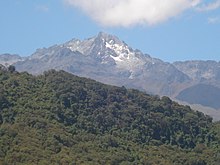
Most Venezuelans are laid-back regarding racial issues, since white or creole persons blend naturally with natives and Afro-Venezuelans in everyday life (education, living, politics, marriage). So the word "negro" can be used regardless of who's saying it, or who is being referred to in this way. Expressions like "negrito" or "mi negro" are often used as a term of endearment. You could hear someone calling "negra" to a woman, regardless of the race of the person. And in general, Afro-Venezuelans don't find it offensive, as they are simply variations on the Spanish word for "black". Similarly, don't be offended if someone calls you "flaco" (thin) or "gordo" (fat) as these may also be used fairly indiscriminately, and often as a term of friendliness.
Differences between Brits, Americans, or Europeans are not perceived by most Venezuelans. Hence, you can expect to be called "gringo" even if you are, say, Russian. Don't let this offend you as a non Spanish-speaking visitor.
Venezuelans, like Colombians, Nicaraguans and Panamanians, have a very amusing way of pointing to objects by pouting their lips and lifting their chin, so don't assume that people are blowing kisses to you when you ask for directions.
Another important point to be kept in mind is that the Venezuelan society is severely split between "Chavistas" (those who support former President Chavez) and "anti-Chavistas" (those who oppose to him), so it is strongly advisable not to talk about him and/or his politics unless you are sure on which side your Venezuelan friends are.
Since the 2010s, Venezuela has been experiencing a large-scale, multi-dimensional economic, humanitarian, and political crisis. The crisis has deeply affected the lives of many, and it has caused a lot of Venezuelans to feel absolutely frustrated with the way things are and their government and hopeless about the future of their country. You're unlikely to cause offence by asking about the crisis, but it is advised that you approach the subject with a modicum of respect and empathy.
Connect [ edit ]
By phone [ edit ].
Venezuela has international country telephone code 58 and three-digit area codes (plus an initial '0'), and phone numbers are seven digits long.
Area codes beginning with '04' - e.g. 0412, 0414, 0416 - are mobile phones, while area codes beginning '02' - e.g. 0212 (Caracas), 0261 (Maracaibo) are land lines.
A single emergency number 171 is used in most of the country for police, ambulance and firefighters.
The international phone number format for Venezuela is +58-(area code without '0')-(phone number)
- To dial to another area code: (area code starting with '0')-(phone number)
- To dial to another country: 00-(country code)-(area code)-(phone number)
- Directory enquiries/information (in Spanish): 113
- Emergency service for mobile phones: (in Spanish): 911 (Movistar), 112 (Digitel), *1 (Movilnet)

Public payphones use prepaid cards which cannot be recharged but are easily available in shopping centers, gas stations, kiosks, etc. Phone boxes are common in the cities and do not accept coins. The vast majority are operated by the former state monopoly, CANTV, although some boxes operated by Digitel or Movistar do exist, particularly in remote areas. CANTV prepaid cards can be used only in their booths.
More popular today are the ubiquitous 'communication centers' or clusters of phone booths located inside metro stations, malls, or like a normal store in the street. Most of these communication centers are operated either by CANTV or Movistar, and offer generally cheap phone calls from a normal phone in comfortable booths equipped with a seat. A log is made of all your calls and you pay when exiting the store.
Many street vendors or buhoneros also offer phone calls from portable (antenna-based) land lines set up at improvised stalls. Callers are charged by the minute.
Mobile phones [ edit ]
Mobiles operated by Movilnet, a division of CANTV, start with the 0416/0426 code and use the CDMA 800 MHz system and GSM/HSDPA 850 MHz. Rival Telefónica Movistar, formerly Telcel, start with 0414/0424 and use both CDMA & GSM/HSDPA (GSM/HSDPA 850 MHz). Digitel is another operator with a GSM/HSDPA (GSM/HSDPA 900 MHz) network and its numbers start with 0412. It is possible to buy a pay-as-you-go SIM card for Digitel's GSM phones, but make sure your phone is unlocked. A pay-as-you-go Digitel card is working straightaway when bought from any official retailer.
Movilnet phones are not able to send text messages to most European networks. A Digitel phone may send a text message to almost any European network; Movistar may let you send a text message to any European network but is less reliable than Digitel for this purpose.
You may use your phone with a foreign SIM card in roaming. Check: www.gsmworld.com or call to your operator for roaming information to Venezuela. Movilnet and Movistar will require quad-band phones for European users, Digitel will work with any European phone. Tourists from other than European countries should check their phones if the phone will work with the above bands.
By net [ edit ]
Internet cafés are increasingly common, often incorporated in the above-mentioned 'communication centers'. Even small towns usually have at least one spot with more or less decent connections.
By mail [ edit ]
Venezuela's state-owned postal service is slow, unpredictable and not widely used. Post offices are few and far between, although they are still probably your best bet for sending postcards back home. For mailing within Venezuela, courier services such as MRW, Domesa and Zoom are the most popular. These usually guarantee next-day delivery!
- Has custom banner
- Has mapframe
- Maps with static images
- Maps with non-default size
- Has map markers
- Has caution box
- Articles with dead external links
- Has caution box with no date
- Has Geo parameter
- South America
- All destination articles
- Outline countries
- Outline articles
- Country articles
- Pages with maps
Navigation menu

Your full Wanderlust guide to travel in Venezuela
With more beauty queens than anywhere else and the highest waterfall in the world, Venezuela sure is easy on the eye. Christopher Columbus described the south-east of the country as “paradise on earth”.
Venezuela offers amazingly diverse experiences, from delving into the Amazon rainforest to taking a dip in the gently lapping Caribbean sea. In the west is Los Llanos, the great plain where local flora and fauna – such as scarlet ibis and Orinoco crocodile – share their territory with cattle and llanero cowboys.
Further west, at Mérida, you can be whisked off your feet by the highest cable car in the world as it glides up through the mist-swirled peaks of the Andes. Pull on your hiking boots and march out onto the grassy trails of the páramo and the highland pastures studded with wild flowers.
In the east, where Venezuela meets Brazil and Guyana, the Gran Sabana – watered by the mighty cascade of Angel Falls – soars to the flat-topped tepui, including Roraima, the 'lost world'.
A stop on your Venezuelan itinerary should certainly be Mochima National Park on the coast, where you can hire a boat and chug round the clusters of islands until you find a deserted cove where you can drop anchor and spend a day padding across your own beach. Or perhaps head to the spectacular Los Roques archipelago, with miles of pristine white-sand beaches and crystal-clear water.
- Capital city: Caracas
- Population: 28.7 million
- Money: bolívar soberano
- Int dialing code: + 58
- Languages: Spanish & Castillan
- Visas: If you’re arriving by air, you can enter for up to 90 days on a tourist card issued on arrival. You must have a valid return ticket. If you’re arriving overland or by sea, you must get a visa in advance from your nearest Venezuelan Embassy or Consulate.
- Voltage: 120 V
- Time: GMT - 4
Further Reading
When to go to venezuela.
Venezuela is generally considered to be a year-round destination. The dry season (December to April) is more pleasant for travelling but the mighty waterfalls in the Gran Sabana of the south-east look more impressive during the wet season.
International airport
Simon Bolivar International Airport (CCS) is 27km from Caracas
Getting around in Venezuela
Most Venezuelans use buses to get around and services between major centres are regular and cheap. Go for servicio ejecutivo or bus-cama for extra comfort. Shorter distances are covered by large cars known as por puestos , carros or carritos which ply a fixed route and leave when full. Renting a car (and filling it with petrol) is cheap in Venezuela but driving standards are poor. Several airlines offer domestic flights. Venezuela is not a good place for cyclists.
Venezuela accommodation
Venezuela isn’t short of accommodation but there are almost no hostels or organised campsites . Posadas (family-run guesthouses) are a good bet if you’re on a budget as many of the cheaper hotels rent out rooms by the hour. At the top end, Caracas and Isla de Margarita have the most options. Note that walk-in prices are usually cheaper than those online. Only the most expensive hotels accept credit cards.
Venezuela food & drink
Arepas are a national favourite – dense disks of white maize flour that come baked or fried with a variety of fillings and sit heavy on the stomach. Pabellon criollo is a robust plate of shredded beef, often accompanied by plantanos (cooking bananas), caraotas negras (black beans) and rice. Orinoco river fish are a delicacy, but best enjoyed close to the source. Coffee drinking is an art form; a zingy negrito (espresso) will kick start your day, but ask for it ‘ sin azucar ’ (without sugar) if you don’t share the nation’s sweet tooth.
Health & safety in Venezuela
Check with your GP or local travel clinic about vaccinations and malaria prevention. Yellow fever and dengue fever are a risk. Crime is a problem in Caracas: try and leave your money and valuables somewhere safe before walking the streets. Venezuelans go a bit Wacky Races behind the wheel so take extra care when crossing the road and never assume that drivers are going to stop.
Our recommendations for travelling in Venezuela
- Climb the tepui (flat-topped mountain) Roraima for stunning views from a ‘lost world’
- Head upriver and overland in Venezuela to the highest waterfall in the world: Angel Falls
- Swim with turtles in beautiful Caribbean archipelago Los Roques
- Relax with some pampering massages between shopping trips and beach visits on Margarita Island
- Pick up some Chocolates El Rey: they will change your perception of chocolate forever
- Explore Los Llanos, watching out for giant anteaters lumbering across the savannah

Related Guides

Frontier and expedition

Latin America

Outdoor adventures

Wildlife and safaris
Related articles, loading more items, loading trips.

Join our newsletter
Get the very best of Wanderlust by signing up to our newsletters, full of travel inspiration, fun quizzes, exciting competitions and exclusive offers.
- Backpacking Venezuela Travel Guide (2024)
By Joan Torres 6 Comments Last updated on April 29, 2024
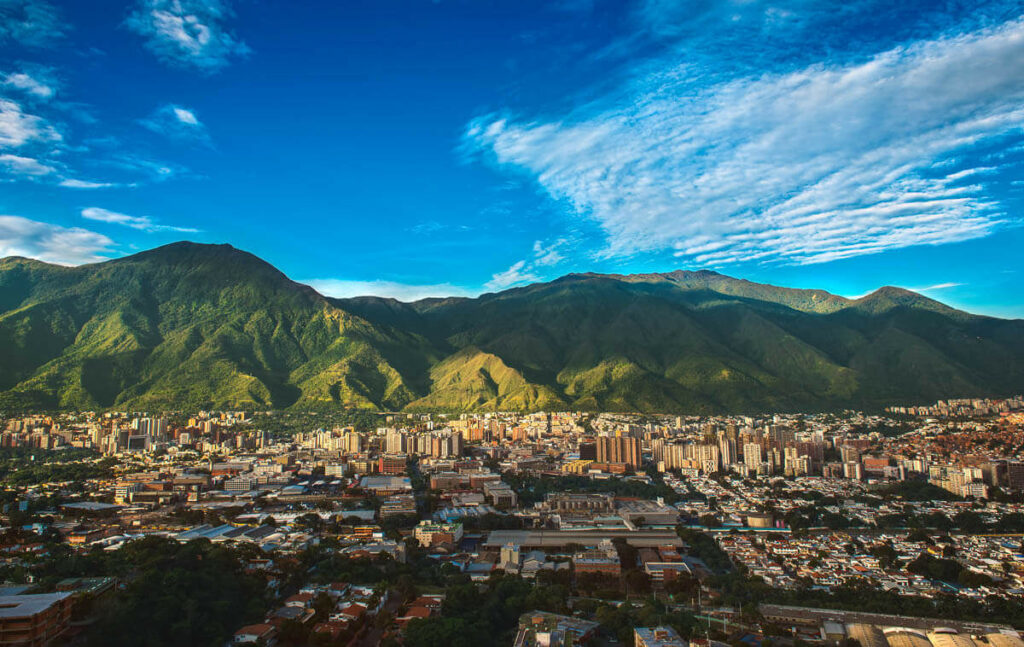
Arguably, Venezuela might be the best country for travel in the whole of South America.
Blessed with the longest coastline in the Caribbean, the tallest waterfall in the world and the least unexplored part of the Amazon, Venezuela is packed with wilderness highlights.
While you might be thinking that every country in the continent is filled with jaw-dropping attractions, what I truly enjoyed about traveling in Venezuela is that there is no other Spanish-speaking country in the continent which is also so raw and authentic.
Yet Venezuela doesn’t come without its own travel difficulties and obstacles, so in this guide, you will learn how to travel in Venezuela , including tips on safety, money, accommodation, getting around and much more.
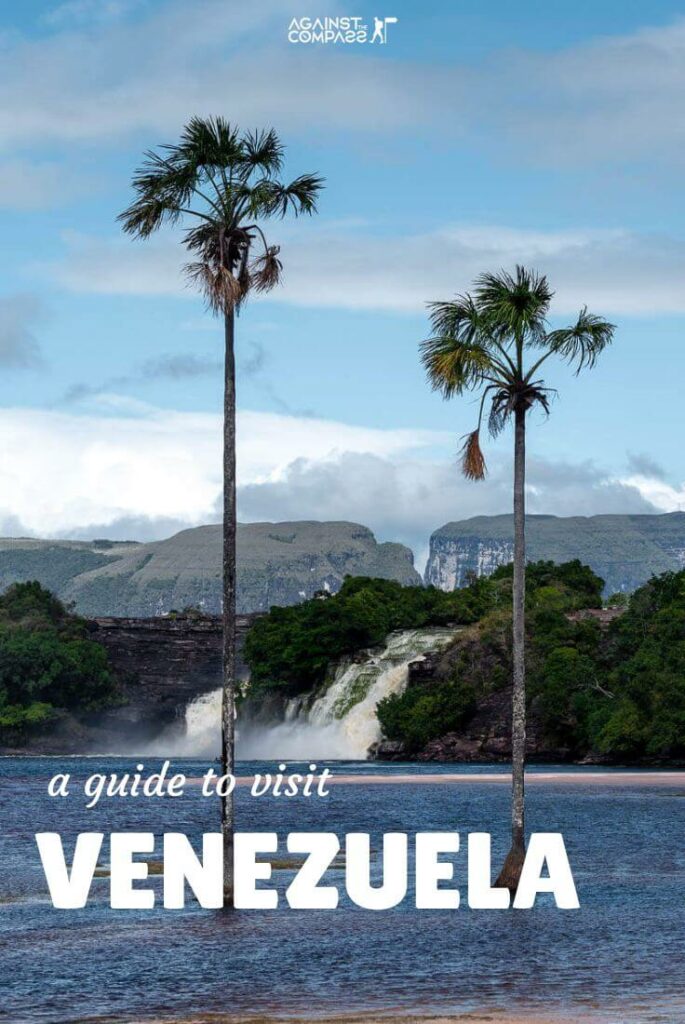
In this Venezuela travel guide, you will find:
Table of Contents
- Venezuela Today
- Is it safe to travel?
- How to get visa
- Travel Insurance
- Money & Budget
- Best time to visit
- Top Experiences
- Independent Travel
- Transportation
- Accommodation
- Venezuelan People
- More Information
our recommended travel insurance for Venezuela
With its Backpacker plan, IATI Insurance is the best insurance for any kind of adventurous destination, like Venezuela
📰 Venezuela today
Can you travel to Venezuela?
Similar to Iraq or Somalia , Venezuela has an incredibly bad reputation for being one of the most dangerous countries in the world.
Venezuela, nevertheless, has never experienced suicide bombings or war-related problems. What it did have was a problem with high rates of violent crime, inflamed by one of the worst and longest-lasting economic crises in the world.
Venezuela’s economy is fully dependent on oil and is managed by extremely corrupt leaders with absolutely zero incentives, all fueled by the impementation of extreme Communist laws and policies that saw the country experience 10,000% inflation and a shortage crisis that lasted nearly 10 years, until 2019, a crisis that brought hundreds of Venezuelans close to starvation because they couldn’t even find a bag of rice in the supermarket.
Venezuelans have suffered what is not written, and listening to their stories should be an unmissable part of your trip , as much as visiting the Angel Falls.
Today, the situation isn’t great but with the stabilization of their currency and the significant improvement in security, local people are feeling more optimistic and enthusiastic about their futures.
In my opinion, there hasn’t been a better time to travel to Venezuela than now.

⚠️ Is it safe to travel to Venezuela?
Is Venezuela safe for tourists?
Several years ago, Venezuela was one of the most dangerous countries in the world – in my opinion far more dangerous than countries like Afghanistan , Yemen or even Mali .
Express kidnappings, muggings and road assaults were part of everyday life for Venezuelans.
On Monday mornings, the main topic of conversation between colleagues at pretty much any office or university was about who got robbed or kidnapped over the weekend.
Venezuela was so dangerous that even the Venezuelans’ habits shifted in cities, with streets clearing after 6 pm, since people preferred to celebrate and gather with friends in their own homes.
This terrible situation went on until around 2020.
Right now, traveling in Venezuela is safe, for the following reasons:

1. The Government took action against local mafias
Basically, by carrying out raids in specific shanty towns, targeting the organizations involved in kidnappings.
The police were very effective, but only because they went in and shot everyone indiscriminately, killing loads of innocent people at the same time.
2. Because of the crisis, kidnappings were no longer profitable business
Express kidnappings consisted of taking someone by force to make them empty their bank accounts, while threatening their and their family’s lives.
The problem however, is that Venezuela was suffering the worst of all inflations, so wealthy Venezuelans moved their fortunes to bank accounts in either Madrid or Miami, hence there was no way for them to transfers their funds, meaning the kidnapping business wasn’t very profitable any more.
Similarly, because of the crisis, ordinary Venezuelans weren’t carrying any money on them, mainly because the Venezuelan Bolívar was absolutely worthless, so mugging became increasingly difficult as well.
3. The thieves fled Venezuela to neighboring countries
Given the situation, many thieves decided to leave Venezuela, heading mainly to other Latin American countries such as Colombia, Ecuador or Perú.
Conclusion: Is Venezuela safe to visit?
Venezuela is safer to travel than it used to be, as all Venezuelans will tell you. But remember that still, this is rough and raw Latin America, so use your common sense: don’t display your valuables, don’t walk about alone after dark, etc.
Is Venezuela safe for Americans?
Yes, of course. Local people won’t judge you based on your nationality.
Also, it’s not like the USA has ever invaded and started a war in Venezuela, like they did in many Middle Eastern countries, so Americans can travel around Venezuela without fear.
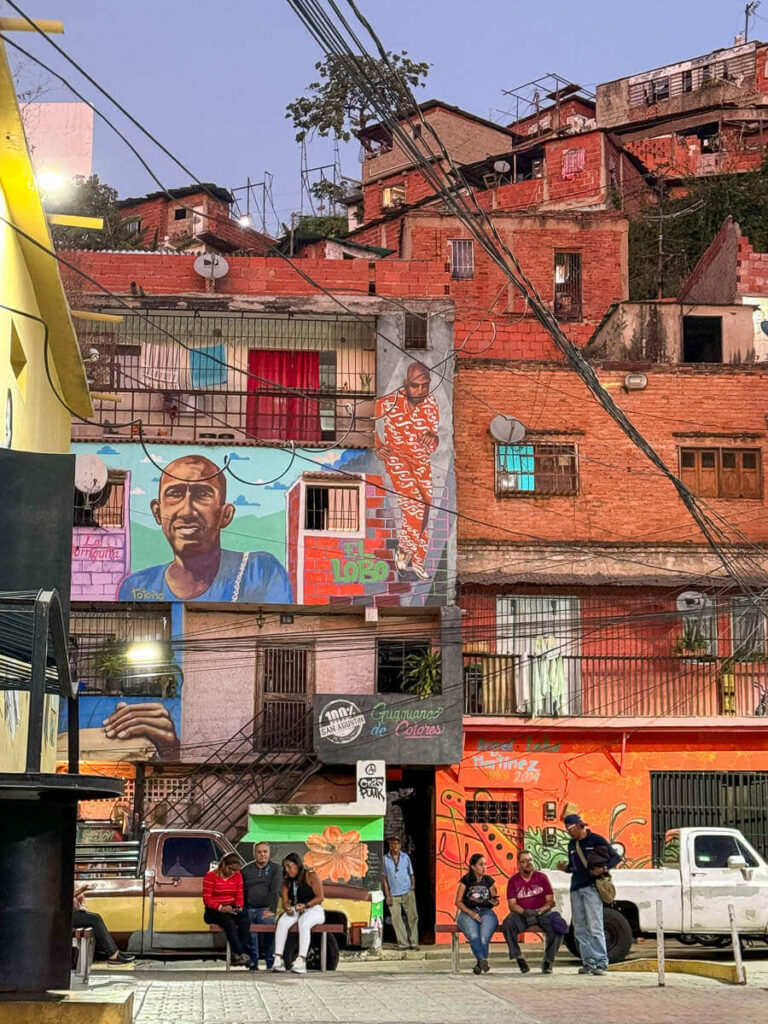
🪪 How to get a visa for Venezuela
Most nationalities can get a free visa upon arrival, allowing you to travel in Venezuela for 90 days. This rule applies at both international airports and land borders.
Can Americans travel to Venezuela with a tourist visa?
Americans – and also Canadians – are the exception to the rule.
They can’t get a VOA, so instead must apply at the Venezuelan embassy in either Mexico City or Panama City.
The process can take up to 5 months (no kidding!) and the rules change all the time.
Fortunately, there is a pretty active Facebook group where travelers share their experiences in securing a tourist visa for Venezuela.
The group is called Venezuela Visa Support .
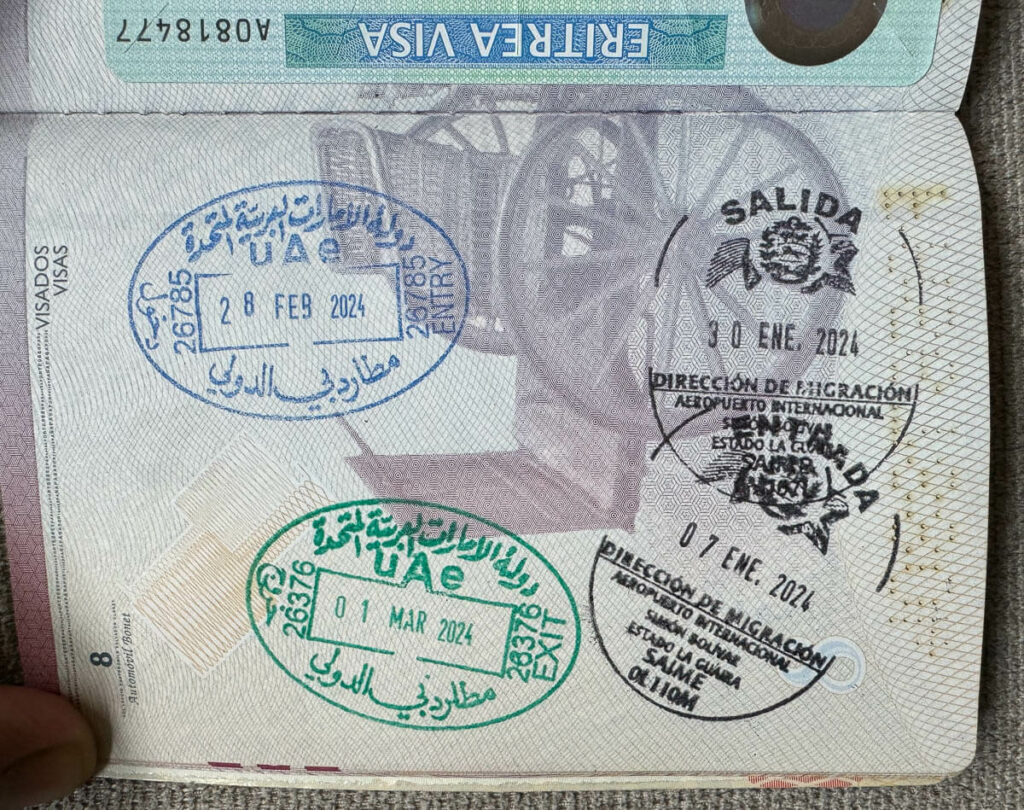
🚑 Travel insurance
Don’t travel to Venezuela without travel insurance. I recommend IATI Insurance because:
- One of the very few that covers travel in Venezuela.
- Different plans for all budgets.
- It covers senior citizens too.
- Readers of this blog can get a 5% exclusive discount

💰 Money & budget for backpacking in Venezuela
Money is a complicated matter when backpacking in Venezuela, there are so many particularities.
Here’s what you need to know.
The local currency is now in parity with the US dollar
In Venezuela, they use the Venezuelan Bolívar and approximately:
1 USD = 36 VES
I’m not an economist so I don’t know how this actually works, but after inflation of nearly 10,000% back in 2019, the Government of Venezuela managed to contain it by equalizing the Bolívar with the US dollar.
The Venezuelan economy is now completely dollarized
While the Bolívar is still in circulation, the US dollar is quickly becoming the main currency, and it can be used for any type of transactions.
At small local businesses, such as fruits & veg shops, or convenience stores, they’ll likely give you the price in Bolívares although you will always be allowed to pay in USD.
If something costs less than 1 USD, they will give your change in Bolívares.
Bring all your money in cash
You can’t really withdraw money from an ATM.
I mean, technically you can, but ATMs always give Bolívares and only up to a certain amount, which tends to be the equivalent of no more than 25 USD.
Therefore, do bring all your money in cash, and in US dollars.
Bring the smallest possible notes
This is the number one tip for traveling in Venezuela.
In Venezuela, nobody has change, but I am not talking about not having change of $100. I am talking about buying something worth $4 dollars, paying with a $5 note and not getting your dollar change because the guy from the shop doesn’t have any.
This didn’t happen just once, or twice, it was a constant nightmare that happened several times a day, every time I tried to buy something outside of Caracas.
There’s a shortage of cash in Venezuela. In Caracas you can pay by card virtually everywhere so this shouldn’t be much of a problem there, but outside of the capital it really is.
How are the locals dealing with it? Well, they don’t really use cash; instead they use Pago Móvil , a mobile app for instant payments that can only be used if you have a Venezuelan bank account.
I know it’s hard to bring $1 bills, but just try to bring the smallest possible notes.
You can’t get money out of ATMs but you might be able to pay by card
However, don’t rely on this.
For example, my Revolut Card didn’t work in Venezuela but my N26 did, even though both of them are Mastercard.
In Caracas, cards are accepted everywhere, but that might not be the case in other parts of the country. It’s just random, sometimes they do accept cards, sometimes they don’t.
How much does a trip to Venezuela cost?
Estimating the cost of traveling to Venezuela is difficult, since it really depends on where you go, and what activities you do.
On the one hand, there’s Caracas.
Caracas is super expensive. If you decide to stay in Chacao, which is the safest area in the entire city – pretty much the only place where you can walk around without any fear – then know that things will be ridiculously expensive, e.g. $100 for a basic hotel room, $15 for an average local meal and $60 for a meal in an international restaurant (nothing fancy).
Then there are the touristy places such as Los Roques, Canaima, Los Llanos, the Orinoco Delta and Roraima. These places are also super expensive, so you should budget around $150 a day depending on where you stay.
Check out our Canaima travel guide to find out how to reduce costs.
Mérida and Margarita are the only famous tourist havens that are pretty affordable, where you can find excellent accommodation for $30, and the food is cheap too.
Everywhere else is cheap. In Valencia for example, you can find decent accommodation for $20, and a good local meal for $4. Public transportation is also cheap, I don’t think I ever paid more than $10 for a long-distance bus.

⛅ Best time to visit Venezuela
Venezuela is a year-round destination, so the best time to visit will depend on what you want to do.
Traveling in Venezuela from July to October: the rainy season.
During the rainy season, all of the waterfalls in Canaima National Park will be at their fastest flowing, including Angel Falls , the tallest waterfall in the world and the country’s top tourist attraction.
It’s important to highlight that the rainy season in Venezuela isn’t one of those Asian monsoon seasons with hurricanes where it keeps pouring all day long. It’s more like heavy rain for a few hours a day.
This season, however, might not be ideal for visiting the coast and the islands of Margarita and Los Roques.
It will also be pretty cold in the mountains around Mérida and, while Los Llanos will be covered in lush green, it’s not the best season to spot anacondas and other animals.
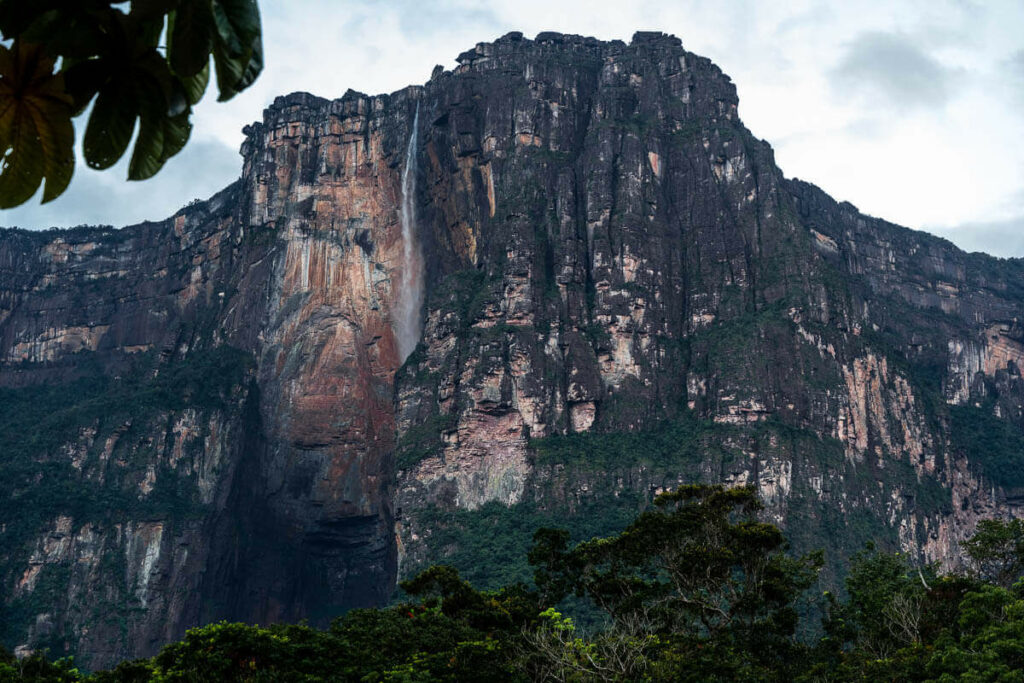
Traveling in Venezuela from November to April: the dry season
The dry season comes with its pros and cons as well.
For Canaima, be aware that the later you go, the less water you’ll find, so I don’t personally recommend going there in March or April.
On the other hand, the dry season is an excellent time to visit the islands, as well as for doing a safari in Los Llanos, including spotting giant anteaters and 5-meter anacondas.
Check our travel guide to Los Llanos for more information.
Venezuela travel tip: avoid local Bank Holidays In Venezuela, there are very few foreign travelers but domestic tourism is pretty big, especially during certain annual festivities. You may want to avoid traveling to Los Llanos, Canaima, Margarita or Los Roques during the following dates: Carnavales (February or March, depending on the year) Easter (March or April, depending on the year) Christmas Holidays July 5th and 24th
🛖 Top Experiences in Venezuela
Go on an anaconda safari.
Along with the Amazon, Los Llanos boatds with one of the largest populations of giant anacondas, and safaris to spot them can be easily arranged.
Check our travel guide to Los Llanos .
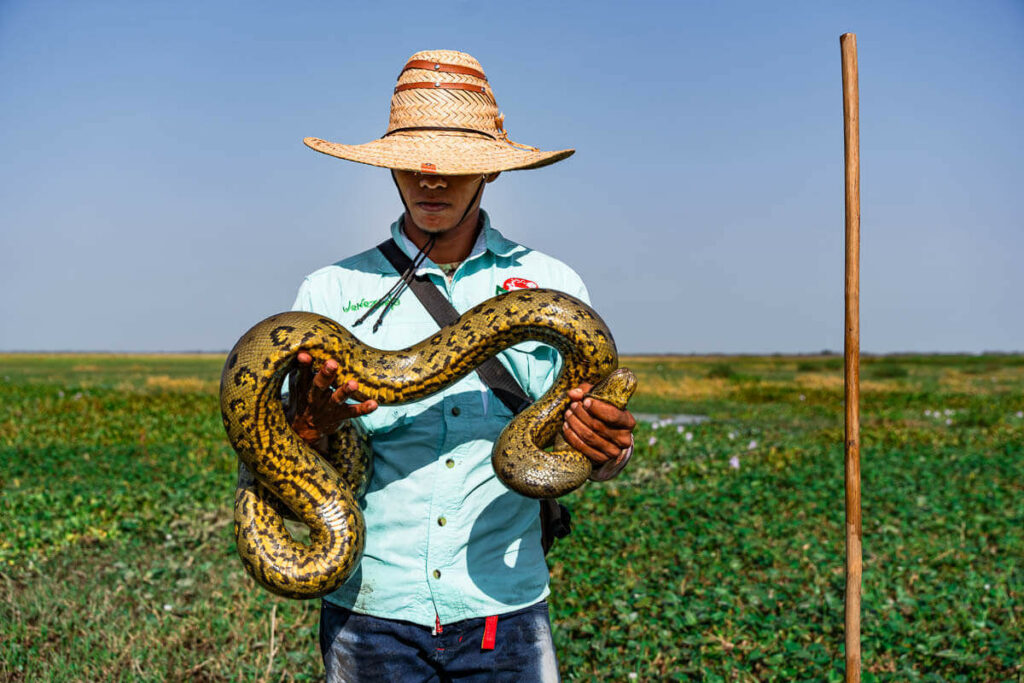
Explore Caribbean towns
The coast of Venezuela has a very distinct, very Caribbean culture, with the added advantage that it hasn’t been spoiled by foreign tourism – Choroní or Chacao being great examples.
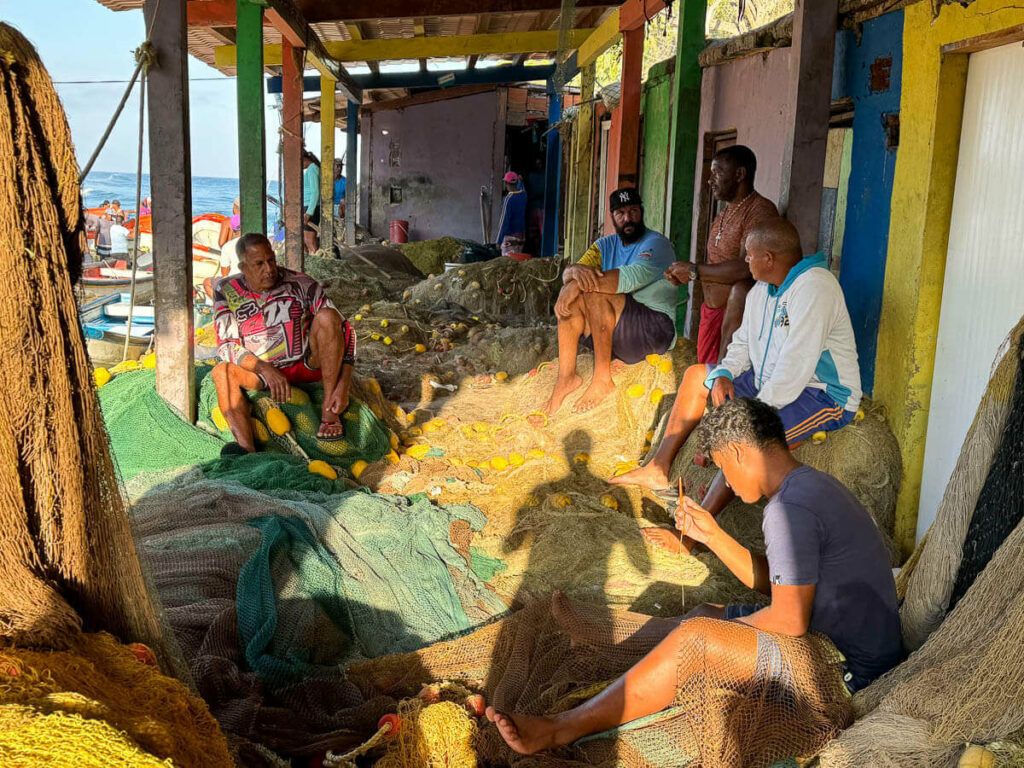
Visit the tallest waterfall in the world
Venezuela is home to the world’s highest uninterrupted waterfall (979 meters). This waterfall can be found in a stunning national park named Canaima, which is only accessible by flying in.
Check our travel guide to Canaima.
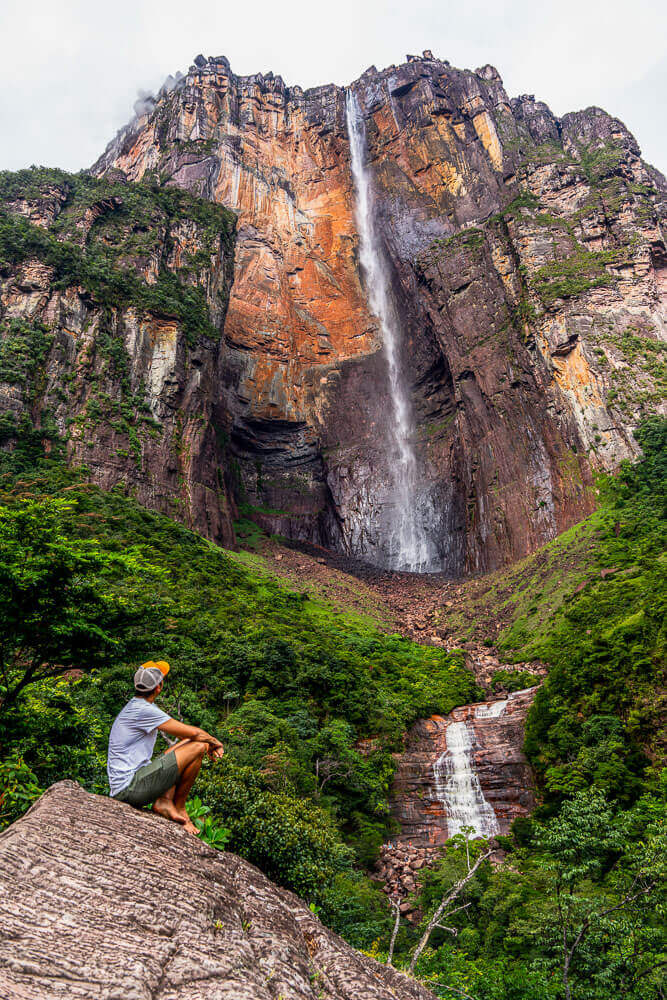
Venezuelan people
Venezuela has seen very few backpackers for the last 30 years, so expect to make friends everywhere – more than in any other Latin American country!
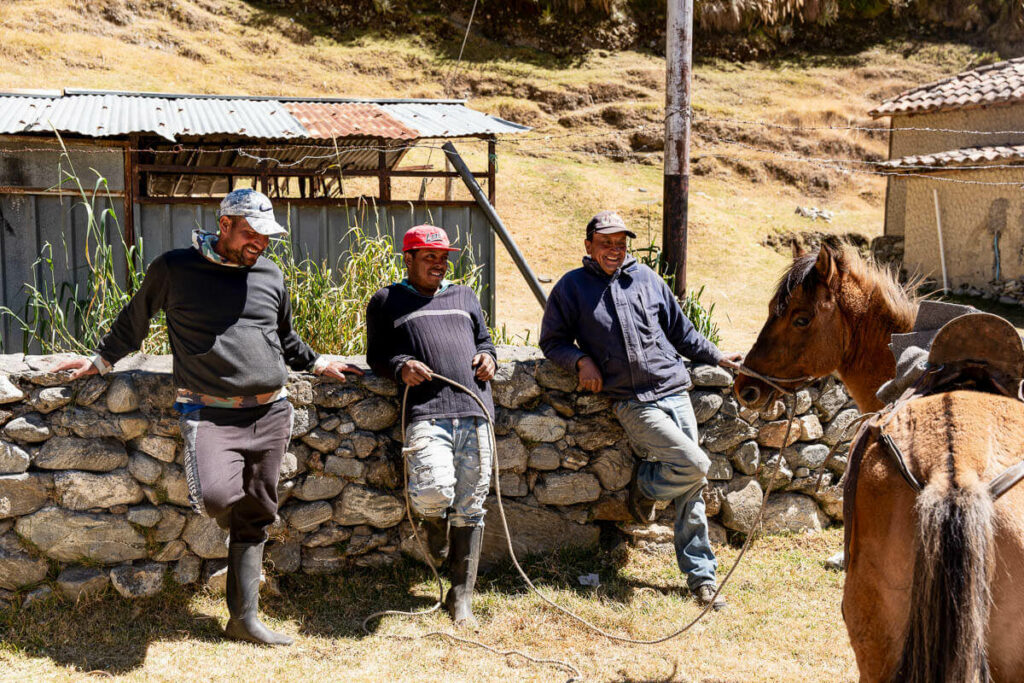
Backpacking in Mérida
Mérida is the best example of traditional Venezuela, old colonial villages built in the Andes that feel like stepping back in time.

🛫 Getting in: how to travel to Venezuela
How to fly to venezuela.
Maiquetía or Simón Bolívar International Airport is the main airport hub in Caracas.
To be honest, it’s a fairly small airport with few connections.
If coming from Europe, Madrid is by far the best hub. Check Iberia or Air Europa.
You can also fly from Lisbon (TAP Portugal) and Istanbul (Turkish Airlines).
There are direct flights from Moscow as well.
Alternatively, you can also fly from Colombia, Panamá or México.
How to travel to Venezuela over land borders
Venezuela shares a border with:
- Colombia: all borders are open and easy to cross
- Brazil: despite sharing a very long border, there’s only one proper border crossing at Paracaima, the rest being dense jungle.
- Guyana: there aren’t any roads connecting both countries, only jungle, hence there isn’t any official border crossing.
👨 Independent travel in Venezuela
I traveled around Venezuela for 25 days using public transportation.
Do you know how many backpackers I saw?
Zero, not a single one.
I did see foreign tourists in Canaima National Park , as well as a tour group in Los Llanos but not a single backpacker traveling independently around the country, not even in Mérida.
Venezuela is still perceived as a dangerous destination, few and far between are the travelers venturing here on their own, the reason being that it’s difficult to find any travel information about for it, e.g., there are barely any updated travel blogs on Venezuela.

🛺 Transportation: How to move around Venezuela
How to travel around venezuela by public transportation.
Transportation in Venezuela isn’t very different from other Latin American countries.
Each town will have its own bus terminal, from where you can catch a bus to other villages, towns and cities.
Wealthy Venezuelans will always tell you that traveling by bus is very dangerous and that you shouldn’t even think about doing it, but I found bus travel to be one of the most enriching experiences in Venezuela, especially on long distance journeys, where bus passengers tend to become friends.
It’s a great opportunity to get local insights from the segment of Venezuelans who have struggled the most, the people who can only afford to travel by bus.
In big cities like Valencia or Caracas, some routes offer different types of buses, from comfortable AC coach buses to crumbling mini vans without windows.
Venezuela travel tip: If traveling with an AC bus, do always bring one extra layer cause they tend to put the AC at 8ºC
There are no general rules for taking buses, it just depends on the specific route, and which terminal it departs from. Sometimes there is a proper bus schedule, sometimes they depart only when full. You might also be lucky to ride on a neat air-conditioned coach, or you might get a crumbling mini van without windows.
Where are the bus stations in Caracas?
Caracas is obviously the main hub for bus travel around Venezuela, and these are the main 3 stations:
Terminal La Bandera : buses that travel West of Caracas, including Valencia, Maracaibo, Los Llanos, Mérida or Amazonas State.
Terminal Antonio José de Sucre : buses traveling east of Caracas – Oriente, like Venezuelans say – including Barcelona, Bolívar State or Santa Elena.
Terminal Privado Aeroexpresos Ejecutivos : fancy buses for the most common destinations in Venezuela, including Mérida or Santa Elena. Buses here are more expensive, run less often and need to be booked in advance but they sell the idea of extra comfort and security. As a backpacker, I prefer traveling from either of the other 2 stations.
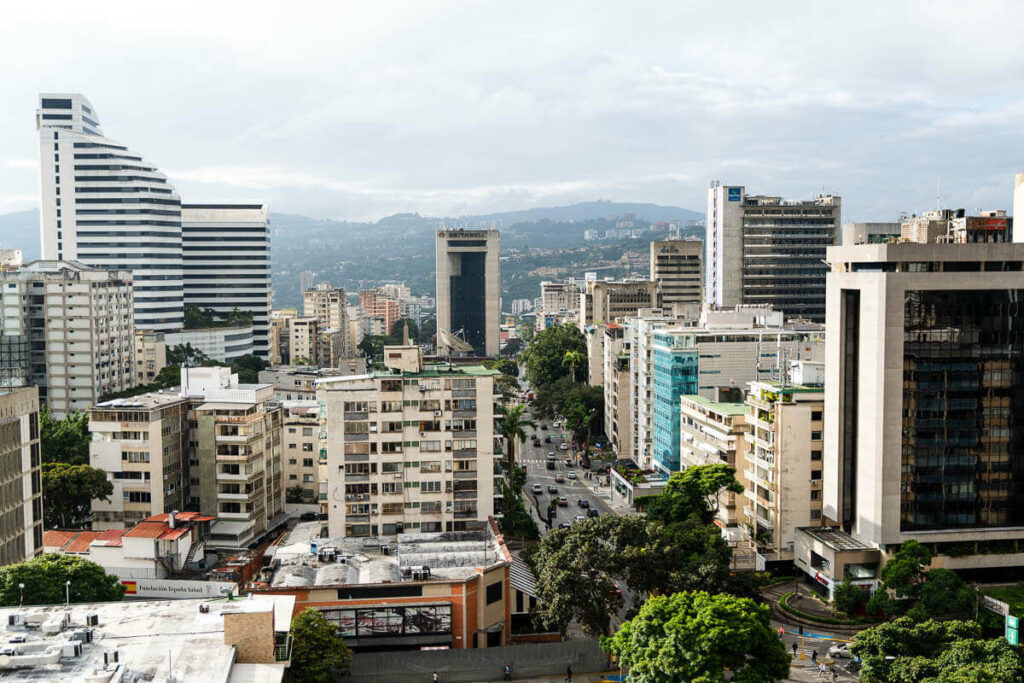
Traveling around Venezuela by shared taxi
In small towns with small terminals, where buses don’t run that often, it’s easy to find shared taxis as well.
You have to ask for a carrito a plaza .
Traveling around Venezuela by plane
Venezuela is a big country, so travelers with little time to travel in Venezuela might opt to take a domestic flight.
The problem, however, is that flights can’t be booked online; you must purchase your flight tickets at the respective office in the airport. That or look for a local travel agency to do it for you, for an extra fee.
Additionally, other than Los Roques and Margarita, flights between destinations don’t run every day, so you really need to plan your itinerary in advance.
Common domestic airlines are Avior Airlines , Conviasa and Laser Airlines .
Traveling around Venezuela with a Vehicle for Hire app
Yummy Rides and Ridery are the local versions of Uber, available in most cities across Venezuela, but they can also be used for long distance transportation.
🏨 Accommodation: where to stay in Venezuela
Booking sites such as booking.com are not very useful in Venezuela, since they only offer a few expensive options in Caracas.
The best way to look for accommodation in Venezuela is on Google Maps.
Look for a hotel, call them and ask for price and availability.
Local guest houses are locally known as posadas . They are usually cheap, averaging 20 USD a night without breakfast.
Posadas can be found virtually everywhere in Venezuela.
In touristy places such as Los Llanos, Delta del Orinoco, Canaima or Los Roques, you won’t find local posadas, and instead you will generally stay in lodges – which tend to always offer full board, especially since they are located in remote areas with no restaurants around.
👫 Venezuelan people
I found people in Venezuela to be extremely friendly.
The experience is similar to Colombia, let’s say, but many Venezuelans have barely interacted with a foreigner before, creating an extra incentive for them to meet foreign tourists.
I was the first Spanish person to ever talk to many Venezuelans across the country, especially people in their 20s or 30s. They had only heard Castilian Spanish accents in movies, in La Casa de Papel (Money Heist), or on YouTube, so that was the perfect ice-breaker for any conversations.
One day, I was walking along the promenade of Choroní when I approached a group of Venezuelans having a good time, with a portable fridge packed with beers.
“Are you selling beer? ” I asked.
“No, but here’s one for you “, – he answered.
It was 8 pm and I ended up partying with them until 4 am.
Venezuelans love partying, drinking, loud music, dancing, having fun… and they will never hesitate to ask a stranger to join them.
Other than friendliness, Venezuelans are generally very conservative. Well, I wouldn’t say conservative but it is still a very traditional society. They’re very family-oriented and things like homosexuality, for example, are still taboo .
Don’t get me wrong; their opinion on homosexuality is different from the Middle East . You won’t go to jail and nobody is going to bother you, but a large number of people will think that it isn’t normal.
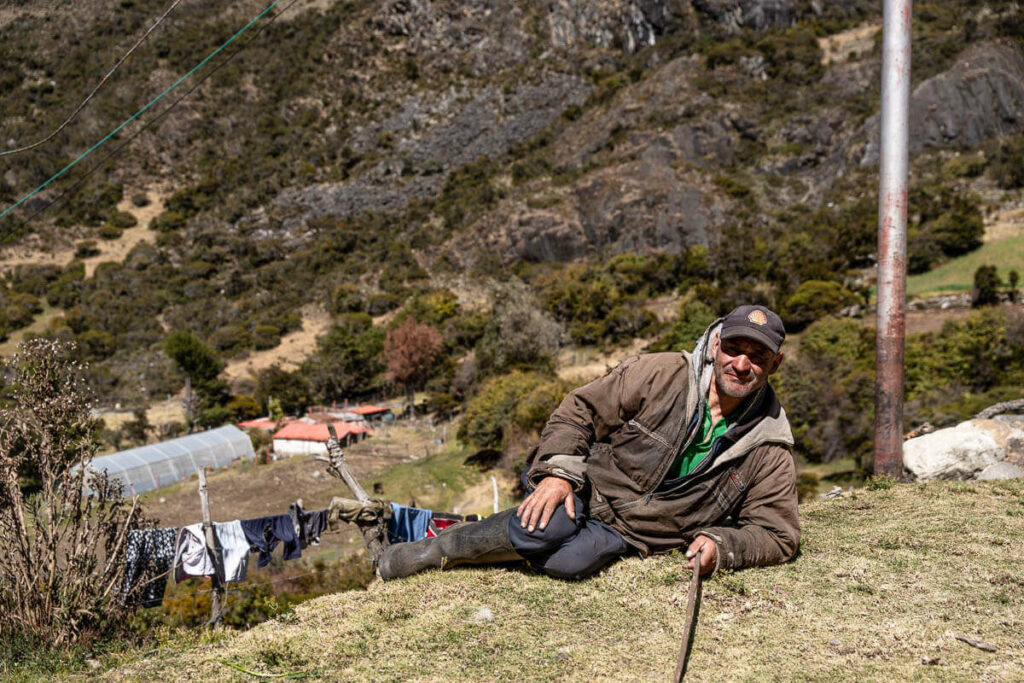
How many people have fled Venezuela?
Depending on which part of the world you’re living in, you may have noticed a massive influx of Venezuelans currently living abroad, who have fled their countries due to the economic crisis.
It’s quite noticeable in Spain, as well as in the USA, and other countries in Latin America.
People in their 20s, 30s and 40s are the one who left, and they have no intention to come back. This massive exodus of people is also noticeable in Caracas, where there isn’t much going on.
Spanish is the official language of Venezuela, and I strongly recommend learning at least some basics because very few Venezuelans can speak English, not even in Caracas, or within the tourism industry.
Even in Hato El Cedral in Los Llanos – where I met a group of people from Central Europe – they didn’t have any English-speaking guides, and they were only able to communicate with them because one guy in the group spoke fluent Spanish.
Other than Spanish, up to 40 different languages are spoken in Venezuela by the indigenous communities, according to the local census .
🍲 Cuisine: what are you going to eat during your trip to Venezuela?
The local food isn’t the reason you will be traveling to Venezuela, but it’s alright, cheap and the portions are huge.
Breakfast in Venezuela
Most Venezuelans will have breakfast at the bakery, where they eat different kinds of pastries, the most popular being cachito de jamón y queso, a yeasted bread filled with ham and cheese.
Surprisingly, many hotels and posadas don’t include breakfast, but a heavier breakfast would typically consist of cheese, eggs and arepa (corn bread)
National dish
Pabellón Criollo is the national dish in Venezuela, consisting of black beans, rice, meat and plantain, available in most local restaurants.

Other snacks
My favorite was cachapa , a slightly sweet Venezuelan pancake filled with cheese, but you can find it with many other fillings too.
Another popular snack is the stuffed arepa , available with all sorts of fillings as well, but usually cheese and meat.
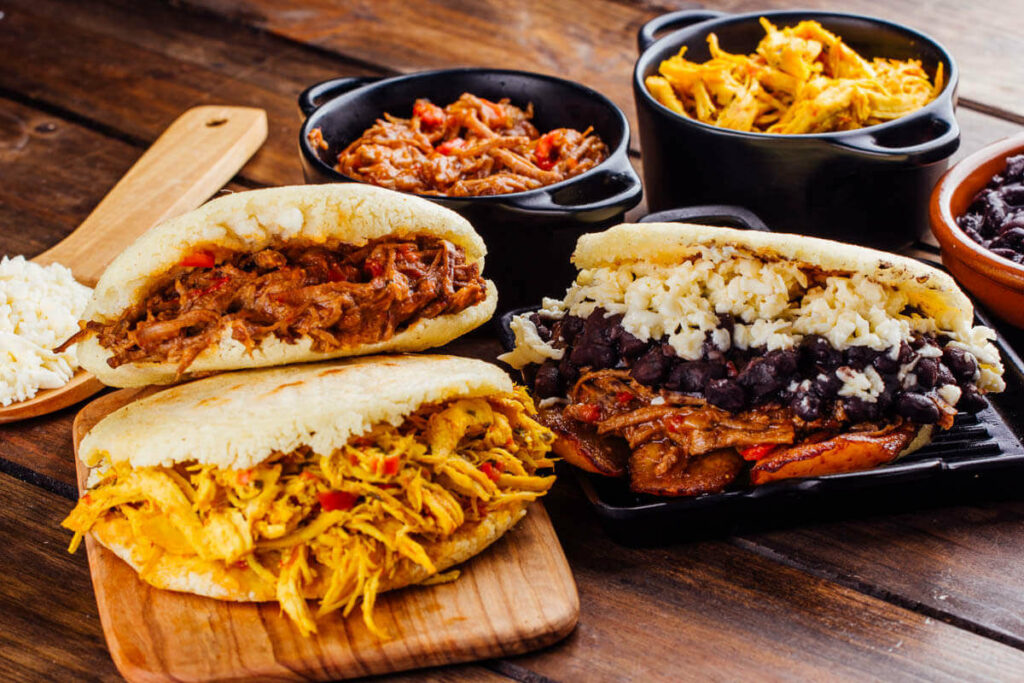
Beer in Venezuela
The cheapest thing you can buy in Venezuela is beer, which rarely costs more than 1 USD for a 20cl bottle.
Venezuelans like to drink it ice-cold, so anywhere you go, cold beer is guaranteed.
They have quite a few brands but Polar is the one that can be found everywhere. In fact, outside of Caracas and tourist sites, it’s difficult to find any others.
Internet in Venezuela
Venezuela has probably the slowest internet in all Latin America, here’s what you need to know.
Most hotels and posadas have Wi-Fi, with an OK connection.
In Canaima, many lodges have a StarLink receiver, which is good enough for simple browsing.
Internet data
You can easily buy a SIM card packed with internet data.
However, bear in mind that many areas of Venezuela, including Canaima or certain parts of Los Llanos and Mérida have very little coverage, and even in Caracas it’s a little bit slow sometimes.
I bought a Digitel SIM at their official store in the Chacao area.
Can you get an eSIM for Venezuela?
Yes, now you can get an eSIM with Airalo , which offers different packages for Venezuela.
However, I recommend getting a local SIM card, since eSIMs only offer internet service, but you might want to be able to call a local number, as explained in the accommodation section of this post.
❗More travel information for Venezuela
📢 In my Travel Resources Page you can find the list of all the sites and services I use to book hotels, tours, travel insurance and more.
All guides and articles for traveling in Venezuela destination
- How to visit Angel Falls
- How to visit Los Llanos
More travel guides from the Americas
- Haiti Travel Guide
- Haiti Itinerary
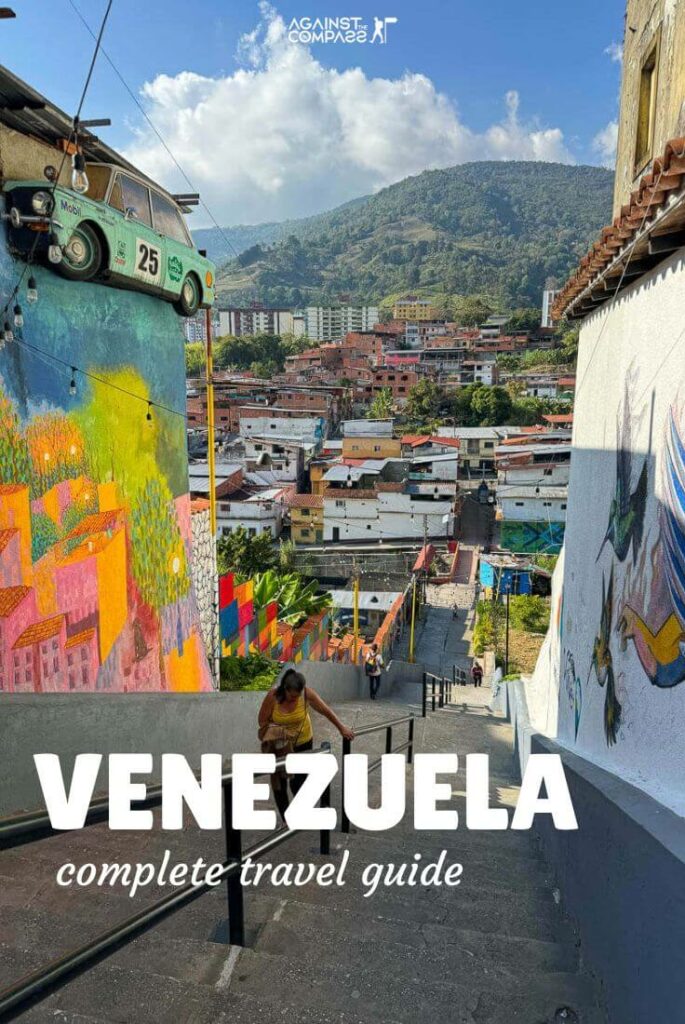
This is really useful – thanks for all the information. Could be a good time to plan my dream Mount Roraima ascent!
Haven’t been in that part of Venezuela, but it’s really in my plans!
Thank you for this priceless guide to Venezuela. It’s impossible to find any updated information -or any at all-. My only concern is about bringing all the money in cash (US dollars). I’m relieved that it’s much safer now and thieves have fled the country; however it’s a bit stressful carrying say $1,500 with you at all times.
Hi Diego, yes, I can understand all the inconvenience. I was actually carrying way more than that, since i was there for 25 days, not to mention laptop and camera gear!
Hi Joan, how would you rate the safety outside the big cities?
Much safer than in cities of course, but one must be careful anyways.
Leave a Comment Cancel reply
Your email address will not be published. Required fields are marked *
Notify me when new comments are added.
Join our Expeditions
From Syria to Iraq in Pakistan, Against the Compass is finally running expeditions to the most epic and off-the-beaten-track countries.
We have scheduled expeditions for every month of the year.
Latest posts
- How to Travel to Libya in 2024
- How to travel to Afghanistan during Taliban rule (2024)
- How to visit Los Llanos in Venezuela
- How to visit Angel Falls and Canaima National Park

Venezuela Travel Guide
Unique traditional cultures and varied landscape are found within Venezuela along with the largest lake and third-longest river in South America. The best region in the country for mountaineering, hill trekking and rock climbing is Sierra Nevada de Mérida. Music is the most distinct cultural escape in Venezuela with visual arts and handicrafts following in popularity.
Attractions
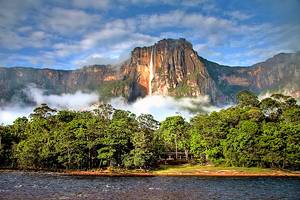
Our local experts can design your trip based on your preferences
Warning - You are using an outdated browser. Please upgrade your browser to properly view this website.

- Destinations
- South america
- Travel guide
Venezuela travel guide
This young, vibrant, and varied country, at once Caribbean, Andean and Amazonian, has fabulous natural treasures for beachcombers and adventurers.
In recent decades, Venezuela has gained a reputation as a thorn in the side of the United States. Led by the charismatic and divisive Hugo Chávez until his death in March 2013, and by his former vice-president, Nicolas Maduro, ever since, Venezuela is primarily known for its anti-globalization stance, romantically socialist vision for Latin America and the ability to spend oil revenue freely.
Natural attractions
However, it would be a shame if the country only gained international attention for its politics. With its diverse geography, ranging from the snow-capped Andes to vast plains with sprawling cattle ranches, from quaint villages to modern metropolitan areas with non-stop nightlife, it offers a huge variety of destinations and experiences. Venezuela has immense natural beauty, with virgin tropical rainforests inhabited by indigenous tribes, the Guayana region straddling ancient rock formations from which gush the world’s highest waterfalls, and more Caribbean coastline than any other nation.

Places to see in Venezuela
Colonial caracas, the capital.
The mountains of Waraira Repano form a dramatic backdrop for Caracas, home to some 5 million inhabitants. The hillsides ringing the metropolis are blanketed with haphazardly constructed ranchos (shanty towns), inhabited largely by illegal immigrants and poor rural people who have come to seek their fortune. The central valley and upscale residential areas of the east and south show a modern, dynamic and affluent side. Dominated by sleek but decaying skyscrapers, El Centro is the traditional heart of the city and Plaza Bolívar is the core of its historic zone. Its treasures include the 19th-century Capitolio, the 17th-century Catedral and adjacent Museo Sacro.
Visit the Museo de Caracas, which has a display of miniatures created by Raúl Santana depicting every aspect of life at the end of the 19th century, or the Iglesia de San Francisco, dating from 1575, with its walls lined with gorgeous gilded altars.
The excellent colonial art museum, Quinta de Anauco, in San Bernardino, is well worth a visit. Visitors can go up to the 52nd floor of the East Tower for 360-degree views of the city.
Andean adventures around Mérida
Venezuela's Andean landscape offers a stunning panorama of glacier-fed lakes bordered by colorful flowers, quaint villages with traditional architecture and wayside restaurants where you can savor trout or smoked cheese. Views of Venezuela’s snow-capped peaks, the highest of which is Bolívar, at 5,007 meters (16,427ft), can be enjoyed in the year-round spring-like weather of the city of Mérida.
The posadas around Plaza Las Heroínas (by the cable-car station) are the gathering places for those in search of mountain activities such as trekking, climbing, and paragliding. There are equipment rental, guides, and toyoteros – drivers of four-wheel-drive vehicles who take visitors to the remote mountain villages of Los Pueblos del Sur, or to entry points for excursions. Mérida has the world’s highest and longest cable car.
Diving and fishing at Parque Nacional Los Roques
The marine paradise of Parque Nacional Los Roques Archipelago is only 35 minutes by air from Caracas, although both day trips and overnight stays are expensive. Along with excellent diving and beautiful (but shadeless) beaches, Los Roques offers unparalleled game fishing.
While most people head directly to Barcelona and Puerto La Cruz, there are other great beaches en route, including the outer banks of the Laguna de Unare (enter via Boca de Uchire) and Puerto Píritu.
Barcelona, Anzoátegui state’s capital, has a well-preserved historic zone with such attractions as the Museo de Tradiciones, along narrow streets bordered by vintage architecture.
Margarita Island, the holiday isle
Isla de Margarita, less than an hour by air from Maiquetía or 2–4 hours by ferry from Puerto La Cruz, is the main attraction of the three-island Pearl group that constitutes Nueva Esparta state. Water temperature varies from 23°C to 30°C (73°F to 86°F) around the numerous white sand beaches. Activities include water sports, fishing and horseback riding.
The island is a real windsurfing hotspot – El Yaque Beach is considered one of the world’s top beaches for the sport.
With numerous historical sites, a rich tradition of crafts, shopping (the island has more than 2,000 duty-free shops), lodging ranging from intimate posadas to luxury resorts, a multitude of restaurants and lively nightlife, it is little wonder that Isla de Margarita has become a prime tourist destination.
See Angel Falls at Parque Nacional Canaima
On a spectacular lake with pink sands fringed by palms and a half dozen waterfalls, Canaima, one of the first areas in Venezuela to be developed for adventure travel, and a major tourist destination, is in the northwest corner of the 30,000-sq km (11,500-sq mile) Parque Nacional Canaima. This sector of the park is only accessible by air, and visitors can take day tours from Maiquetía, Porlamar, or Ciudad Bolívar, or stay overnight.
Canaima’s principal draw is its proximity to Angel Falls, named after the American bush pilot Jimmie Angel, who "discovered" them in 1935. The falls are the world’s highest, at 979 meters (3,212ft), of which 807 meters (2,648ft) are free fall, and cascade over the edge of Auyantepui, the park’s largest tepuy (table-top mountain), which covers 700 sq km (270 sq miles).
Weather permitting, visitors may get a look at the falls from the air. Excursions leave from Canaima in the rainy season, May to November, which is also when the falls are at their most dramatic.
Travel advice for visiting Venezuela
Entry is by passport and visa or passport and tourist card. If arriving by air, tourist cards (valid for 90 days) can be issued to citizens of the UK, the US, Canada, and Australia. Tourist visas are supposedly necessary to enter overland from Colombia and Brazil, but regulations sometimes change overnight, so double-check in advance with your nearest Venezuelan Consulate. It is a good idea to carry your passport with you at all times (be sure to have photocopies of all documents in a separate location in case of loss) as the police mount spot checks and anyone without ID may be detained.
It is advisable to book ahead from outside the country and pick hotels belonging to major international chains, though this makes budget options difficult to find other than on the internet. When calling hotels for reservations, ask for special packages, which may have major discounts. It is also better to seek bargains on Isla Margarita through travel agents.
US dollars can be exchanged for bolívares upon arrival at the airport and at casas de cambio in major cities, and ATMs dispense bolívares at the artificially inflated official exchange rate. Credit-card fraud is rife, even at large, well-known establishments. It is highly recommended that you seek advice from local acquaintances or travelers on internet forums about budget trips well ahead of arrival. At the official exchange rate, Venezuela is very expensive, irrespective of cheap flight offers to Margarita from Europe.
Every state has at least one airport for commercial flights, except for Delta Amacuro. Cheap bus transportation is found virtually everywhere. While gasoline is about the cheapest in the world, driving in Caracas is chaotic, slow, and potentially dangerous. It is less stressful to book tours. Driving in the interior is pleasant, and the roads are of good quality, apart from the potholes. A little Spanish will go a long way. Caracas is one of South America’s most congested cities, so the subway (Metro) is the fastest way of getting around.
Read more recommended places to go in South America...
Average customers rating

{{_ "pagesAdmin.destinations.overviewCulturalFeaturesIn"}} {{currentName}}
{{_ "pagesAdmin.destinations.overviewViewAllFeatures"}} {{currentName}}
{{_ "pagesAdmin.destinations.overviewHistoricalHighlights"}} {{currentName}}
{{_ "pagesAdmin.destinations.overviewViewAllHighlights"}} {{currentName}}

Travel Itineraries | Luxury Travel | Travel Tips
7 Ultimate Days in Venezuela | Travel Itinerary and Guide

Venezuela is one of the countries in South America well-known for its adventurous and beautiful natural wonders . From its landscapes to its bustling cities, most wanderers feel inclined to travel and experience the ambiance of Venezuela. One of the unique and enticing things about Venezuela is its stunning waterfalls. In this jam-packed schedule, we are going to explore the striking water features of Venezuela.
7 Day Venezuela Travel Itinerary – In Brief
Day 1 – reach venezuela | stay in ciudad bolivar, venezuela, day 2 – fly from ciudad bolivar to cainama, day 3 – boat riding to angel falls, day 4 – getting back to ciudad bolivar, day 5 – exploring kukenan river, day 6 – reaching the roraima falls, day 7 – the roraima summit and packing-up.
First off, a few reminders before starting this journey . It will be challenging to get a good sleep while sleeping in hammocks. It is advisable to bring mosquito nets to prevent from being bitten by mosquitoes. It also gets noisy, especially when the rain starts to fall. Since you will spend a long time sitting on hardwoods while riding on a curiara (a South American dug-out canoe), it is better to bring a cushion to prevent sore bums and stiff legs.
One Week Epic Venezuela Travel Itinerary and Guide
After arriving at Caracas, you will take a regional flight to Ciudad Bolivar, Venezuela. You can also find flights from Caracas going directly to Canaima if you prefer. The flight to Ciudad Bolivar should only take about an hour. Once you touch down, Ciudad Bolivar is a great place to explore. Touring the city, seeing their colonial-style architecture, and trying their cassava bread is a relaxing way to spend the day there. When tired, you can check into a hotel here to spend the night after the long trip. Take a rest from the long flight and eat dinner.
Departing from Ciudad Bolivar, you can visit the Angel Falls by riding on a twin-propeller plane for another hour flight over the tepuis of Canaima, then a short transfer to one of the lodges near Laguna de Canaima. Some lodges include your airplane transportation with their booking, which can be convenient. From the shores, you can enjoy the Hacha Falls and waterfalls in the dark lagoon.
After eating your lunch, you are on your first adventure to either Hacha Falls, Sapo Falls, or both. After crossing the lagoon, you will take a short hike to reach the top of Sapo Falls with the view of Canaima and feel the refreshing experience brought by walking a trail behind the falls. Staying at Sapo falls is a relaxing experience for those who want to go sunbathing or swimming. Afterward, you will return to your lodge to eat dinner and take a good rest.

On Day 3, you will now head to the outdoor camp of Angel Falls for your remote camping adventure. After taking your breakfast at the lodge, you will now take a short adventure hiking to Ucaima Port, then board a curiara rowing along the Carrao and Churun Rivers to the stunning Angel Falls. The boat ride can take four to six hours, depending on the river flow and water level. Note that boats can only reach Angel Falls during the rainy season (June to December), so plan accordingly!
As you ride on the curiara, you will be able to enjoy the scenery and the massive tepuis. Be prepared to get out of the boat a few times to hike when you pass through some rapids along Carrao! The confluence between the two rivers is also impressive, as the Carrao river suddenly opens up into a sprawling, pebbly space. You can also enjoy a picnic lunch on the river banks.
Once you switch to the Churun River, you slowly enter the Devil’s Canyon. Devil’s Canyon is the valley where we find Angel Falls. Reaching the end of the Devil’s Canyon, you can now see the stunning Angel Falls cascading around 979 m in height from the top of the Auyan-tepui to the Churun River. From Churun, you will have a one-hour trek to Mirador Laime and then go down to the rock pools to enjoy swimming at the base of the falls. End your day with delicious food at a camp in Angel Falls before resting.
On the fourth day of the trip, you will need to leave Angel Falls to explore Roraima. You will start your day by experiencing an exquisite breakfast while enjoying the magnificent view of Angel Falls. After enjoying the full breakfast and a sip of coffee, ride a boat traveling down to the rivers of Canaima.
After lunch, take a one-hour trip going back to Ciudad Bolivar. Arriving around mid to late afternoon, you will have the chance to explore the city of Ciudad Bolivar one more time since the scheduled private transfer or bus to Sta. Elena, your starting point for Roraima, will still be early in the evening. The ride should take around 10 hours for a private vehicle, so you would get a good rest during the travel.
On the fifth day of the trip, you can explore the exhilarating Kukenan river. Early in the morning, you will leave Sta. Elena by jeep. The drive will take approximately two to three hours going to Pareitepuy, a Pemón village. Pareitepuy will be the starting point for your trek. You first need to register at the local chief house and InParques (Natural Parks Office) to get permission to hike to the Kukenan River. The hike is going to take up to five hours.
This adventurous trail will allow you to enjoy two refreshing river crossings. The Kukenan River can be pretty challenging, depending on the water level. Rest assured that your guides will be helping you throughout the way. After this exhausting adventure, you can have your dinner and overnight in the tents at the campsite in Kukenan. You can choose either the Rio Kukenan or Rio Tek Camp to rest at, as they are pretty close to each other.

You are now on to your sixth day, and this day you will experience one of the famous natural wonders of Venezuela, the Roraima Falls. Some travelers opt to stay in Mount Roraima for up to six to eight days . The extra days give them time to further explore the area and hike to the tripoint at the top.
After having your breakfast at the Kukenan campsite, your long adventure will start as you trek past sprawling fields that, depending on the season, could be filled with orchids. The approximate uphill trek is two hours and then another two to four hours before you arrive at the base camp, which has fresh running water coming from the top of Roraima, also known as “The Ever Fruitful Mother of Streams”. Here is where the water of three of the largest rivers in the South originates. As usual, you will be spending your night in tents in Roraima.

You are now on the last day of your trip after spending your night sleeping in the exuberant forest surrounding the tepui. After having breakfast, you are now to trek the tropical rainforest with abundant plants such as bromeliads and tree ferns. It will take another two to four hours hiking the ramp of big rocks to reach the top of the plateau, named “Hotel Indio” Camp. At the top, you will feel like you have been to the moon. After this exhausting adventure, you will now eat your lunch at the campsite in Roraima before packing your bags to say goodbye.
Share this:
- Kale by LyraThemes.com.
Privacy Overview
Budget Venezuela Travel Guide 8 Ways to Save More Money
- Pinterest 290
Budget Venezuela Travel Guide includes 18 Important Travel Planning Tips that will allow you to see and do more on your budget. Learn how you can benefit.
Table of Contents
Welcome to the Venezuela Travel Guide! Very few countries can boast quite so diverse and spectacular natural beauty as Venezuela. From the stunning Angel Falls through to the Los Llanos grasslands, Los Roques archipelago, and the sumptuous Medanos de Coro desert – this country is the perfect match for any traveler with a hefty dose of wanderlust.
At the time of writing the Venezuela Travel Guide, the country is experiencing considerable internal problems – and a good proportion of international governments are advising their citizens to avoid all but essential travel to the country. Such issues are hardly new to Venezuela – and will hopefully pass quicker than the pessimists predict – and should not put anyone off visiting this country once tempers have cooled back down towards a ‘simmering level’.
Those who take the plunge to explore Venezuela can seriously fall head over heels for this gorgeous, fascinating, and delightfully welcoming country. Here’s everything you need to know about visiting Venezuela – be it next month or further down the line.
Budget Venezuela Travel Guide – What Are the Best Places to Visit in Venezuela?
Venezuela is best known for the Angel Falls – the highest uninterrupted waterfalls in the world – that flow from the Auyantepui Mountain. The exact height of the falls varies depending on the time of year, and we’d highly recommend making these the center point of exploring the rest of the Canaima National Park . Far too many visitors simply check out the falls for a day and skip on without appreciating the real beauty of the surrounding terrain (where you’ll still have plenty of views of the iconic falls).
Check out the many conservation charities and environmental agencies working around this region for some expert tours, sustainable accommodation options, and make the most of a well-developed network of hiking trails and campsites too. There’s also plenty of indigenous culture around the falls (incidentally still referred to by their original name – Kerepakupai Vená in closeby communities) so this is a handy place for checking out the more immersive aspects of Venezuelan culture too.
While the Angel Falls are certainly a showstopper when it comes to national attractions, Venezuela has much more to offer the more adventurously minded visitor. Time your visit right and Los Lanos (the plains) can deliver some sensational bird and animal watching – look hard enough and you may spot a caiman or even a rare jaguar. While you can explore this region yourself – it has some surprisingly decent infrastructure and good enough roads – tours may be the safest and most educational way of doing so. When the heat becomes too much make sure to head over to the simply stunning Los Roques Archipelago.
This is hands-down one of the best ‘hidden gems’ in Latin America for scuba/snorkeling and general waterside exploration. There are not many places to stay – plan this carefully – but the lack of too many exclusive resorts is certainly part of why this region is so wonderful to roam about and enjoy at leisure. Get it right and it could be the absolute highlight of any trip. When you feel the pangs for civilization head instead towards Choroni for some laid back small-city vibes.
Make sure to read Arthur Conan Doyle’s ‘The Lost World’ before heading out to Mount Roraima. This tabletop mountain inspired the sci-fi classic, and you’ll be blown away at how atmospheric this popular destination can be. You’ll likely be keeping an eye out for passing velociraptors as much as gazing in awe at the wonderful natural scenery and wildlife! As with Angel Falls, do your best to appreciate the surrounding environment and avoid the temptation for ‘checklist tourism’ – this place demands way more than a casual selfie. There are some outstanding sustainable eco-lodges in the area that – for once – do not blow an enormous chunk into anyone’s travel budget!
You may have noticed that most of the best sites in Venezuela lean towards the country’s natural splendor – and there are quite a few other places well worth taking the effort to see. The Mochima National Park focuses mostly on marine life and the forests/foothills around the Turimiquire mountains. Once again you really need to explore to find the best parts. Expect plenty of diving amidst shipwrecks, dolphins galore, nesting pelicans, and some lazy days hopping between truly unspoiled islands.
If you decide you wish for some more creature-comforts then consider a trip to glitzy Isla Margarita for plenty of beachside fun. It’s famous for kite surfing and has a wonderfully eclectic nightlife! Honorable mentions must also do to the amazing sand dunes of the Medanos de Coro National Park (weirdly accessible by taxi!) that are well worth exploring by camel or even by throwing in a little sandboarding for the more adrenalin minded.
You’ll find most of the more interesting museums in Caracas – but do be careful should you visit the city, as it does deserve it’s somewhat murky reputation. Visitors would be better off checking out the much more pleasant, colorful, and friendly towns such as Carupano, Porlamar (on Margarita Island), Merida, and Lechiria. We’ll discuss personal safety matters later in the Venezuela Travel Guide – but it is worth mentioning at this stage that the fragile Venezuelan travel economy does really look to deliver its best for visitors.
You’ll find most people are highly protective of travelers – and massively appreciate their willingness to visit their currently somewhat troubled country. Some parts of the country are currently no-go areas, but that applies to at most 10% of the total land. Follow your government’s advice and keep an eye on the situation. Time it right and you’ll enjoy one of the most gorgeous countries in South America in perfect tranquility!
Budget Venezuela Travel Guide – What Are the Best Things to Do in Venezuela?
As discussed above you’ll likely be spending plenty of time exploring the countryside, coastal regions, mountainscapes, waterfalls, and occasional golden desert during your spell in Venezuela. Besides a handful of mostly gorgeous coastal towns, there isn’t a huge amount to recommend the larger cities – at least not at the moment. Our advice would be to look at the various ways of making this country as accessible and safe as possible – and the best way of ensuring this is to take plenty of organized tours that currently cost very little indeed.
Even travelers on an absolute shoestring budget can enjoy a practically limitless experience in Venezuela at the moment – so make your money count in the right ways and spend it with locals scraping a living from occasional passing visitors. Pick the right tour/expedition and you’ll have an incredible time (hostels are a universally amazing resource for sharing tips of the best).
Chances are that you’ll spend plenty of time checking out the scenery and wildlife throughout your stay in Venezuela. One of the best aspects of this country is that you can quite easily pass from one National Park straight into another, and providing you plan accordingly you can cram a huge amount into a surprisingly modest timescale (not that we’d recommend you try and rush this country).
Try and take the time to appreciate that you’ll find waterfalls and wildlife practically everywhere – and that much as they try to promote specific attractions within the national parks they are all quite similar – not that that is a bad thing! Anticipate instead stumbling across opportunities that you didn’t expect pretty much wherever you go. Be prepared to interrupt that jaguar spotting expedition with the occasional scramble up a waterfall and you’ll literally get the picture.
Variety is the key to exploring Venezuela properly – so be ready to mix it up when hiking the mountains. Mount Roraima gets the headlines but visitors will also love the likes of Auyantepuy and El Pauji which offer more varied trails with the same degree of atmospheric wonder. The exact same is true of the beaches – take the opportunity to head a little further than the most popular sites and you’ll discover some majestic and utterly untouched stretches. We’d suggest that the beaches in Venezuela are quite probably the most perfect you’ll find in Latin America – check out Crasqui or Francisqui islands and you’ll be along the right path.
Taking advantage of the most random opportunities is what will make your Venezuelan adventure last long in the memory. The Merida Cable Car – by some distance the highest and longest in the world – serves as a perfect example. It is far less rickety than it looks and provides utterly amazing views around the surrounding landscape. Many safari expeditions choose to include a two-way trip on this providing they are passing nearby and make sure to take the opportunity if it is presented. Even if you do not have a head for heights this is the kind of unique adventure – where you write your own script – that personifies the ideal Venezuelan travel experience.
There’s really not a whole lot more we’d suggest visitors specifically try and squeeze into their Venezuelan travel itinerary. You’re best off approaching this country with an open mind and looking down the most unlikely avenues – chances are that you’ll find something amazing. Just like many other countries without a massive tourist economy you should not expect everything to be signposted or even that handy or accessible. Ask around, take advice from other visitors, and go with the flow.
Providing you pick the right guides and stick to the safer parts of the country you’ll be able to have a mesmerizing time here. Just be warned – time passes very quickly in Venezuela so allow for longer than you may expect.
Budget Venezuela Travel Guide – When is The Best Time to Visit Venezuela?
Choosing when to visit Venezuela can make a decisive difference. Should you want to see the various falls in their most tremendous splendor then look to visit over the rainier months that stretch between May and late November.
The later you push that (October/November) the closer you’ll get towards the ‘low season’ – meaning you can enjoy most of the gorgeous beaches in relative peace and quiet. We’d recommend this time of year if you want to see the best of the natural side of the country. Urban explorers may prefer the much livelier times of the year. Carnival season spans between February and March in most regions – although just remember that these festivities are not quite as prominent as they are during more peaceful times at the moment.
Budget Venezuela Travel Guide – Do I Need A Tourist Visa in Venezuela?
Even though your home government may well advise against visiting Venezuela at the moment, getting into the country is generally really easy with a couple of exceptions. Visitors from the EU, Canada, Australia, NZ, Japan and a good number of others do not need a visa and will have their passport (make sure it is valid for at least six months) stamped with a 90-day tourist permit upon arrival. American and Israeli citizens are still subjected to more scrutiny – a hangover from the Chavez days – and need to apply for an advance permit that costs about $30. Apply at your local consulate.
It is worth mentioning that visa extensions ought to be arranged as soon as possible and you’ll need to provide a good reason for why you want one, plus probably prove you have funds for sustenance and onward/homeward travel. Be careful to keep a close eye on your baggage when passing through land borders.
Budget Venezuela Travel Guide – What Currency Is Used in Venezuela?
The Venezuelan Bolivar – introduced in 2018 to try and limit rampant hyperinflation – has so far utterly failed to achieve this task. Prices are incredibly inconsistent in Venezuela and you’re best off using a combination of USD (wired into the country) or changing Brazilian or Colombian currency on the black market. Money is not easy to handle in Venezuela and really is the root of most of the country’s current problems – so plan for this accordingly. For the sake of convenience – we’ll estimate local prices in USD over the course of the Ultimate Venezuela Travel Guide. Remember that these are seriously liable to change!
Unlike the rest of Latin America, visitors should not use local ATMs – the exchange rate is utterly awful and there’s a good reason why many have armed guards posted nearby. You’ll need to use the black market – don’t worry, the government only chases those at the high end of the ladder – to get a reasonable exchange rate. Avoid official change desks.
Ask at your accommodation and understand that many guides, hotels, and so forth will accept online/international money orders as payment. Irritating as it sounds the Venezuelans are rather adaptable people and once you have figured out the ways that this works you should get to grips with it readily enough. Avoid credit cards at all costs – the exchange rates will be calculated on local values and you’ll be seriously out of pocket.
Get ready to carry a lot of banknotes while you are in Venezuela – and needless to say that makes money belts and secret wallets an essential factor in visiting this country at the time being. Use hotel safes wherever possible and try not to carry more currency that you’ll need to get by for a couple of days. One of the positive aspects of the black market is that once you have established a good source you’ll be set – and it really is not very difficult to do that.
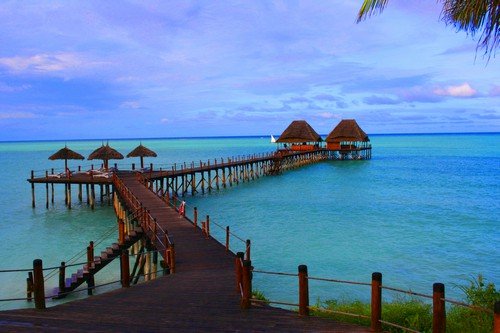
Budget Venezuela Travel Guide – Do I Tip In Venezuela?
10% is the standard tip in restaurants and you should feel tempted to consider leaving gratuities throughout your stay in Venezuela. You’ll be carrying plenty of banknotes and the local wages and prices are so staggeringly low you’ll feel morally obliged to do so. Make sure to tip tour guides, porters, room attendants, and so on wherever you can. Most of the people who do not ask for tips (the vast majority) are those working the jobs which are at the bottom of the ladder.
Budget Venezuela Travel Guide – What Kind Of Budget Do I Need In Venezuela?
Venezuela is so cheap to visit that it borders something close to the outrageous. It is absolutely plausible to spend days on the beach while staying in a local budget hostel, eating three basic meals a day, on a $10/day budget. Travel, more upmarket hotels, the lavisher end of the nightlife scene, and essential tours/expeditions will cost considerably more but are still not going to come anywhere close to what you’d pay for similar experiences in neighboring countries.
Remember that with your additional spending power comes a degree of responsibility. You’ll be spending way beyond what the average Venezuelan does over the course of a day – do not be outraged at being charges 10% more on meals and bus fares just because you’re a visitor. Use the black market wisely and try to find a money changer who uses it to supplement a family run business or hotel.
Here are three very approximate budget estimates for exploring Venezuela.
Budget ($10-20/day)
Hostels that cater to international visitors are often more expensive than locally run budget hotels – with the advantage that they’re excellent hubs for sharing information/tips and tend to be more secure, handier for changing money, and often very well located. We’d advise that even the most penny-pinching visitor tries to make use of locally owned hostels for these reasons – and prices rarely cost more than $10/night for a dorm bed anyway. Hotels are about the same for a double room but do not expect the Ritz, any kind of complimentary breakfast, or to be located in the handiest places.
We’ll cover transportation and getting around later in the Ultimate Venezuela Travel Guide, just be assured that prices are similarly low and even superior quality options (where available) rarely cost close to what you’d expect to pay in Colombia. Our advice here would be to only consider ‘doing Venezuela’ under your own steam if you are an experienced traveler who speaks good Spanish.
The vast majority of visitors will be better off making use of organized tours that are going to cost substantially more, with the added advantages of better security, transit arrangements, and local knowledge. Needless to say, that is going to substantially increase the costs of your Venezuelan adventure and leads us to…
Mid-Level ($50-70/day)
You’ll have days in Venezuela where you barely need to spend any money whatsoever – but those are going to be between days when you will be enjoying expertly managed local tours instead. Those are essential for the vast majority of visitors to enjoy the country securely – and the good news is that they are still amazing value. We’d recommend that most visitors stick to the best hostels and use the rest of their money to choose between the many high-quality tours operating throughout the country.
This is the key difference – you can spend a couple more bucks on a better quality meal, but really that is going to be inconsequential supplementary spending from most visitor’s perspective.
Prices vary depending on what kind of equipment (if any) is included/provided, transit costs, lodgings, and so forth. For a rough estimate, allow about $50/day for all-inclusive overland expeditions and perhaps closer to $80 if that includes sea sports and activities. Throw in some modest daily tips and that $70/day estimate is pretty close to what you’d be expecting to pay – and anticipate some really rather spectacular adventures!
High-End ($100+)
Luxury resorts do still exist in Venezuela – and you can expect to pay about a third or a quarter of what you would in neighboring countries. If that is your bag then the best way to arrange for these would be to pay for everything upfront and in advance. Remember to include any excursions in those costs and avoid the temptation to use your credit cards unless you want to be burning about 30% in exchange rates and commission.
Tempting as it could be to think of living the high-roller lifestyle in Venezuela it is really rather trickier than you may expect. Our advice would be to blow than bankroll by skipping the luxury end of the market and staying in some really progressive eco-lodges, usually as part of high quality and often internationally led tour groups. There’s plenty of specialist options that really can unlock the many wonders of the country – just remember that it’ll likely be a rather ‘sanitized’ perspective of the country that can put off some more worldly travelers.
Budget Venezuela Travel Guide – What Languages Are Spoken in Venezuela?
Venezuela is still home to at least 40 indigenous languages but you’ll find that Spanish is also universally spoken (at least as a second language). Basic English is now taught in some elementary schools and the language has enjoyed an upsurge in popularity recently, but visitors would still be well advised to try and learn some simple Spanish before they visit.
English is widely spoken throughout the travel/tourism industry but not so much in official agencies such as border control/immigration. Overall the language difference is only going to be an issue if you try and explore Venezuela entirely under your own steam. Those who stick to established routes and make use of traveler services/tours will not have any problems.
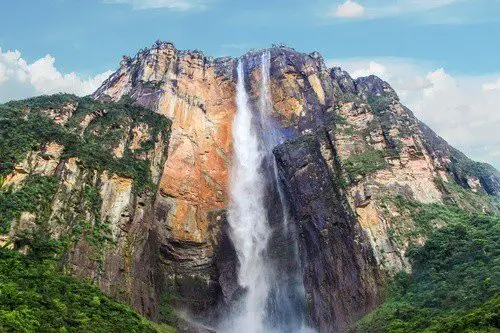
Budget Venezuela Travel Guide – What Religions Are Practiced in Venezuela?
Close to 90% of the Venezuelan people are registered as Christians and around 75% of that figure are Roman Catholics with the rest being mostly Protestants. The rest of the population (official statistics do not take into account ‘no religion’) follow Judaism, Buddhism, and a handful of other faiths. Despite the nation’s recent history religion still retains a considerable cultural power – although it is unlikely going to affect most visitor’s experiences within the country. Dress a little smarter than you may expect if visiting religious sites and practice any of your own beliefs respectfully.
Budget Venezuela Travel Guide – Practical Tips From The Venezuela Travel Guide
Since the death of Hugo Chavez back in 2013 Venezuela has endured a series of economic and social catastrophes. Inflation runs at one of the worst rates in the world, corruption is endemic throughout the country’s administration, crime rates have rocketed and political opponents arrested and imprisoned without the right to anything close to a fair defense. To say Venezuela is suffering some hard times at the moment would be a massive understatement – and these are fair reasons that explain why many travelers are currently understandably shy of dipping their toe inside the country.
The challenges facing Venezuela are substantial and tragic for those who have been lucky enough to experience the wonders of the country before these times of significant strife. While people do still visit the country – and in some roundabout ways now can be an excellent opportunity to do so – it is important to do so responsibly and in as safe a possible manner. Large parts of the country remain peaceful and visitors are unlikely going to be picked on just because they are from elsewhere. But property crime is an issue – and that is something we’ll talk about more closely in a moment.
Travelers who are experienced in tougher countries should still find Venezuela isn’t that bad compared to many others out there. With some luck, responsible travelers who showcase the indisputable wonders of the country and prove that Venezuela still loves to warmly receive visitors could help kickstart an upsurge in the popularity of the destination over the coming years. 20 years ago very few people visited Colombia – and now it is one of the hottest destinations in global travel. There is no reason why Venezuela cannot follow a similar path, but some people are still going to need to make those first positive steps forward.
Budget Venezuela Travel Guide – What About Health and Safety in Venezuela, Is It Safe?
It is important to take some serious precautions before visiting Venezuela. Crime is a substantial problem – in the same manner, that it is in most desperately poor countries – so take care in the cities, try and travel in groups, and stick to taxis at night. The vast majority of crime is money/property theft-related so don’t carry huge amounts of money, use hotel safes, make copies of essential documents, and follow your government’s local travel advice for which areas/districts are experiencing civil unrest. Keep well clear of policial demonstrations – these can flare up without much warning so keep alert at all times.
You should only plan to visit Venezuela at the moment if you are in good overall health. Medical services within the country are threadbare and even the best insurance (providing you can get some) will not guarantee that you’ll be seen urgently. Medications are at best thin on the ground – so the best advice if you fall seriously ill, injured, or lose priority medication in Venezuela would be to get out of the country as soon as possible. Take a comprehensive medical kit with you and ensure you are totally vaccinated against local risks of disease and infection. Keep an eye out for heat exhaustion, dehydration, and environmental hazards.
Remember that one of the many advantages of using tour services in Venezuela is that they’ll help avoid/prevent a good number of these problems that are going to present considerably higher risks to lone/solo travelers and groups. Tap water is not recommended anywhere in the country besides basic oral hygiene use.
Scary as Venezuela may seem at the moment the situation is constantly evolving. Large parts of the country are far safer than the cities and no riskier than what you’ll experience in other nearby countries. Our advice would be to approach Venezuela – at the moment – with a degree of sensible caution, but do not rule out the possibility of visiting entirely.
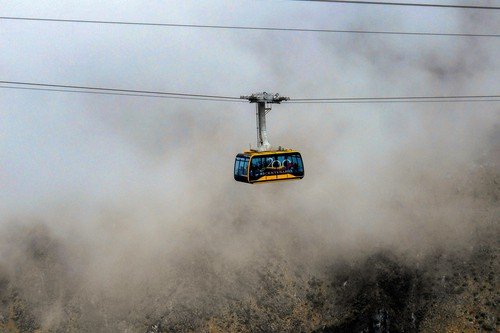
Budget Venezuela Travel Guide – What is the Best Transportation in Venezuela?
Venezuela used to be one of the easiest countries in Latin America to get around – but nowadays that is not quite the case. While internal flights do still run between the major cities, services are far more limited and the network is generally much patchier compared to before. Boat services out to the islands are also noticeably reduced although you’ll still find scheduled ferry services on popular routes and plenty of private charter vessels.
The vast majority of people will instead make use of the comprehensive bus network – and this can present some challenges, even to those used to using the roads in Colombia and Brazil. Security is a major concern – so keep an eye on your bags and try to avoid traveling at night through more remote regions.
Keep warm clothing in your daypack as the aircon is usually set to maximum levels, and politely refuse food/drinks when offered unless you are certain that whoever is offering them is legit and no risk. You can easily hire your own vehicle in Venezuela – the roads are in generally good condition – but the risks may not make it worth it. Even the Venezuelan police do not travel on certain stretches of road at night.
Given how cheap prices are throughout the country a good proportion of recent travelers have looked at using private cabs for secure, speedy, and more comfortable long-distance travel. You can easily hire a car with a driver for little more than $30/40 per day including fuel. If visiting as part of a group we’d strongly recommend this even if the prices you are quoted are substantially higher. The savings in time and effort will be worth a few bucks.
Budget Venezuela Travel Guide – What Are the Best Accommodations in Venezuela?
As discussed during the money and costs section of the Venezuela Travel Guide , accommodation options are abundant and universally cheap. Hostels certainly have an advantage over hotels although you should approach your choices with an open mind. Opting to stay with locally run and managed places – be it a B&B or small hotel – provides money to the local economy and this is the sort of country where you want to be doing that as much as possible.
You could haggle over prices but really it won’t be necessary unless you’re being utterly ripped off. There’s enough competition out there to make this an unlikely prospect no matter where you opt to stay. Make sure you understand the prices and remember than currencies have different ‘practical’ exchange values.
One thing you certainly will not lack in Venezuela is a choice in where to stay. You’ll rarely struggle to find somewhere with beds for the night, although given the security issues in the country at the moment it is convenient to know exactly where you are heading before you arrive in a new town.
Try and book either in advance before you arrive in the country, or a day or two ahead if you are taking a more relaxed/flexible approach to travel. Almost all hostels and a good proportion of hotels offer some kind of online booking system although you’ll find that being able to call ahead and speak Spanish is invaluable in securing the best accommodation as you go.
Budget Venezuela Travel Guide – How Can I Practice Responsible Tourism In Venezuela?
Where to begin? The first step must be to raise the profile of the country using your various social media platforms. Highlight the work that many aid charities and local foundations are performing against all the odds – and encourage your friends/followers to donate towards these causes. International currency can go a long way towards providing genuine help to people facing desperate times – so use it responsibly while also highlighting the many beautiful places you discover during your adventures.
Try and spend a proportion of your time touring the much forgotten indigenous regions. Venezuela does home some impressive relics, crumbling ruins, castles and so forth that are just screaming out for some more exposure and international attention. Visit these and stay within the more isolated communities as you travel about. Spend your money in the local markets when choosing out your souvenirs.
One of the indisputable highlights of visiting Venezuela at the moment is the simple fact that you’ll enjoy stunning beaches and only share them with a handful of other visitors. We really advise you to head a little further away from the most famous spots – you’ll almost always find that your money goes to needier communities who enjoy just as glorious an environment.
Perhaps the best overall way of being a responsible traveler in Venezuela is simply to visit and enjoy the country as much as possible. While there are challenges to exploring this country at the moment, it is nowhere near as dangerous or difficult as many people assume. Show the way and encourage others to follow in your footsteps!
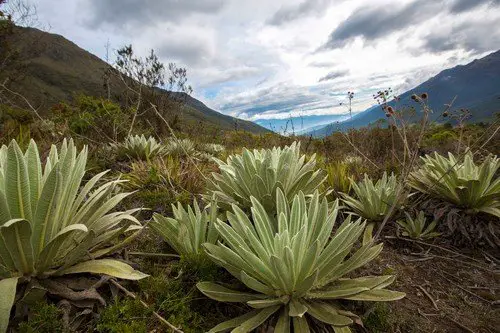
Budget Venezuela Travel Guide – What Food Should I Try In Venezuela?
Venezuelan cuisine is quite similar to what you’ll find in surrounding countries. Expect plenty of rice, corn, yams, beans, and grilled meat and fish! That being said, there are some standout regional classics that are well worth trying out during your travels.
Arepa is a kind of a cross between a tortilla and a bread roll, usually rolled folded over and stuffed with plenty of whatever ingredients are at hand. You’ll find these often made to demand and sold at invariably busy streetside stalls. Cachapa is another Venezuelan staple and arguably the ‘national dish’ – basically enormous corn pancakes topped with soft cheese, herbs, and fried meats. Tequinos are like deep-fried cheese sticks and just as delicious as they sound, while Pabellon Criollo is the equivalent of a ‘Sunday roast’ involving beans, shredded slow-cooked meats, vegetables, and often a thick luscious gravy.
While meat is often on the menu in Venezuela it can be surprisingly straightforward to get away with vegetarian and even vegan eating providing you aren’t too ‘fussy’. Those with intolerances and allergies should take care though as these are rarely very well understood.
Budget Venezuela Travel Guide – What Should I Pack for A Trip to Venezuela?
Durable clothing, good boots, money belts, electricity converters/battery packs, and a comprehensive medical kit are all highly recommended. High-quality replacement clothing and outdoors wear are hard to find in Venezuela so try and make sure you remember to pack these. A waterproof poncho is a good idea, as is a sleeping bag and hat/gloves depending on what you plan on doing and when you intend to visit. While you should securely upload your essential documents to the Cloud beforehand it is a good idea to keep a copy of these on a USB stick too.
Budget Venezuela Travel Guide – What Clothes Should You Wear In Venezuela?
The Venezuela Travel Guide recommends that you try and avoid looking too much like a stereotypical tourist while traveling around the country. Avoid wearing anything that will cause offense or attract attention – so try and stick to relatively rugged and hard-wearing clothes with long sleeves to add an element of additional environmental protection. Consider packing relatively smarter clothes for the occasional night out in the big city – but you won’t need to dress up much outside of the capital. Wear smarter and more respectful clothes when visiting nationally significant and religious destinations.
Budget Venezuela Travel Guide – What Are Some Interesting & Important Facts About Venezuela?
We hope you have enjoyed reading this Venezuela Travel Guide and understand that while this is a more challenging destination at the moment, you do not need to be some kind of ‘super-traveler’ to enjoy this remarkable country safely and in a positive manner. Venezuela is going through tough times at the moment and it’ll be fascinating to see this place develop once it has sorted out these issues.
There is so much going for Venezuela – so much untapped potential – that there is a very strong chance that soon enough it’ll become one of the hottest and most fashionable places in the world to visit. Anyone who wants to experience the best in the country before the masses descend should take a serious look – either as part of a regional tour or as a unique destination in its own right. Venezuela is a remarkable country and one that has a real habit or rewarding the openminded and adventurous visitor.
Let’s now wrap up the Venezuela Travel Guide with a few fun little facts about this amazing country:
▸ Unlike pretty much every other Latin American country Venezuelans prefer baseball to soccer (they love both!).
▸ ‘The Simpsons’ is still banned from TV for long-forgotten reasons.
▸ As is Diet/Zero Coke.
▸ Venezuela was the first country to abolish the death penalty for all crimes – they did so back in 1863.
▸ Bird spotting is no joke – the country has over 1400 species and is the 17th most biodiverse on the planet.
▸ Venezuela has only two recognized seasons – wet and dry. Otherwise, the weather is remarkably consistent!
▸ Kids can choose to attend classes during the morning or afternoon. Teenagers can opt to attend in the evenings instead.
▸ Despite the poverty and associated social problems, the literacy rate is an impressive 96%
▸ It also has one of the largest oil and natural gas reserves in the world.
▸ Only 22% of Venezuelan’s feel safe in their own country.
We hope you enjoyed reading the Budget Venezuela Travel Guide – and good travels! Contact us with any questions you may have about travel to Venezuela.
Now that you have read about Venezuela, what’s next? Let’s learn more about an Ecuador trip. Check out The Ultimate Ecuador Travel Guide
Related posts:
- Budget Uruguay Travel Guide 8 Ways to Save More Money
- Budget New Orleans Travel Guide 8 Ways to Save More Money
Budget Bolivia Travel Guide 8 Ways to Save More Money
- Budget Bermuda Travel Guide 8 Ways to Save More Money
- Budget Aruba Travel Guide 8 Ways to Save More Money
- Budget Paraguay Travel Guide 8 Ways to Save More Money
- Budget Bahamas Travel Guide 8 Ways to Save More Money
- Budget Ecuador Travel Guide 8 Ways to Save More Money
- Budget Barbados Travel Guide 8 Ways to Save More Money
Budget Argentina Travel Guide 8 Ways to Save More Money
Related posts.
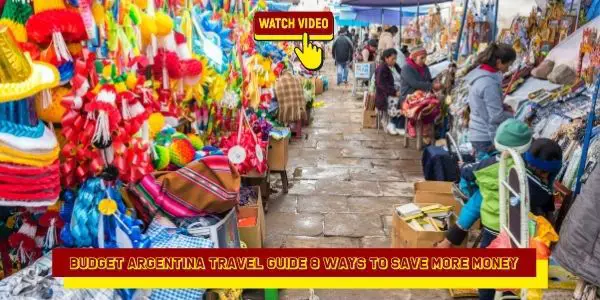
Update April 12, 2024
Information for u.s. citizens in the middle east.
- Travel Advisories |
- Contact Us |
- MyTravelGov |
Find U.S. Embassies & Consulates
Travel.state.gov, congressional liaison, special issuance agency, u.s. passports, international travel, intercountry adoption, international parental child abduction, records and authentications, popular links, travel advisories, mytravelgov, stay connected, legal resources, legal information, info for u.s. law enforcement, replace or certify documents.
Before You Go
Learn About Your Destination
While Abroad
Emergencies
Share this page:
Travel Advisory July 17, 2023
Venezuela - level 4: do not travel.
Reissued with obsolete COVID-19 page links removed.
Do not travel to Venezuela due to crime , civil unrest, kidnapping , and the arbitrary enforcement of local laws . Reconsider travel due to wrongful detentions , terrorism , and poor health infrastructure .
Country Summary: On March 11, 2019, the U.S. Department of State announced the withdrawal of diplomatic personnel from U.S. Embassy Caracas. All consular services, routine and emergency, remain suspended until further notice. The U.S. government has limited ability to provide emergency services to U.S. citizens in Venezuela. U.S. citizens in Venezuela who require consular services should try to leave the country as soon as safely possible and contact a U.S. embassy or consulate in another country.
Violent crimes, such as homicide, armed robbery, kidnapping, and carjacking, are common. Political rallies and demonstrations occur, often with little notice. Demonstrations typically elicit a strong police and security force response that includes the use of tear gas, pepper spray, and rubber bullets against participants and occasionally devolve into looting and vandalism. Reports from the Independent International Fact-Finding Mission document human rights abuses attributed to the Maduro regime, including torture, extrajudicial killings, forced disappearances, and detentions without due process and/or fair trial guarantees or as a pretext for an illegitimate purpose. Shortages of gasoline, food, electricity, water, medicine, and medical supplies continue throughout much of Venezuela. The CDC issued a Level 3 ‘Avoid Nonessential Travel’ notice on September 30, 2021, due to inadequate healthcare and the breakdown of the medical infrastructure in Venezuela.
The Department has determined that there is a risk of wrongful detention of U.S. nationals by the Maduro regime.
Regime-aligned security forces have detained U.S. citizens for long periods. The Maduro regime does not notify the U.S. government of the detention of U.S. citizens and the U.S. government is not granted routine access to those U.S. citizens.
Colombian terrorist groups, such as the National Liberation Army (ELN), Revolutionary Armed Forces of Colombia – People’s Army (FARC-EP), and Segunda Marquetalia, operate in Venezuela’s border areas with Colombia, Brazil, and Guyana.
Due to risks to civil aviation operating within or in the vicinity of Venezuela, the Federal Aviation Administration (FAA) has issued a Notice to Air Missions (NOTAM) prohibiting all flight operations in the territory and airspace of Venezuela at altitudes below 26,000 feet. For more information, U.S. citizens should consult the Federal Aviation Administration’s Prohibitions, Restrictions and Notices . Emergency medical evacuation flights between the United States and Venezuela may not be possible.
Read the country information page for additional information on travel to Venezuela.
If you decide to travel to Venezuela:
- Avoid all land border crossings into Venezuela on the Colombian border.
- Ensure you have a valid Venezuelan visa. Visas are not available upon arrival.
- Draft a will and designate appropriate insurance beneficiaries and/or power of attorney.
- Develop a communication plan with family and/or your employer or host organization. Establish a “proof of life” protocol with your loved ones, so that if you are taken hostage, your loved ones know specific questions (and answers) to ask the hostage-takers to be sure that you are alive (and to rule out a hoax).
- Have a contingency plan in place that does not rely on U.S. government assistance.
- Keep travel documents up to date and easily accessible.
- Avoid travel between cities, or between Simón Bolívar International Airport and Caracas at night.
- Do not take unregulated taxis from Simón Bolívar International Airport and avoid ATMs in this area.
- Consider hiring a professional security organization.
- Bring a sufficient supply of over the counter and prescription medicines for the duration of travel.
- Consider purchasing medical evacuation insurance.
- Visit our website for Travel to High-Risk Areas .
- Enroll in the Smart Traveler Enrollment Program (STEP) to receive Alerts and make it easier to locate you in an emergency.
- Follow the Department of State on Facebook and Twitter .
- Review the Country Security Report for Venezuela.
- Visit the CDC page for the latest Travel Health Information related to your travel.
- Review the Traveler’s Checklist .
- Be prepared for the high risk of indefinite arbitrary detention on specious charges without consular access.
Embassy Messages
View Alerts and Messages Archive
Quick Facts
Two pages, for visa and entry stamp.
Yes. You must get a Venezuelan visa before traveling to Venezuela. Visas are not available upon arrival. Note: U.S. travelers risk lengthy or indefinite detention for attempts to arrive at any Venezuelan border crossing without a valid Venezuelan visa.
Yellow fever vaccination required if coming from or transiting for more than 12 hours through Brazil.
USD 10,000 (or equivalent) or more must be declared.
Embassies and Consulates
U.S. Embassy Colombia Calle 24 Bis No. 48-50 Bogotá, D.C. Colombia Telephone: +(57)(1) 275-2000 Emergency: +(57)(1) 275-2000 Fax: No fax Email: [email protected] Website
The U.S. Department of State strongly recommends that U.S. citizens do not travel to Venezuela, and that U.S. citizens remaining in Venezuela depart immediately. More information can be found in the U.S. Department of State’s Venezuela Travel Advisory .
The U.S. Embassy in Caracas suspended operations on March 11, 2019, and therefore cannot provide protection or consular services to U.S. citizens in Venezuela. The U.S. Embassy in Colombia assists U.S. citizens in Venezuela when possible.
If you are a U.S. citizen in Venezuela in need of assistance, or are concerned about a U.S. citizen in Venezuela, please contact us in one of the following ways:
Email [email protected] ; or
Call us at +1-888-407-4747 (from the U.S. & Canada) or +1-202-501-4444 (from overseas).
Destination Description
Learn about the U.S. relationship to countries around the world.
Entry, Exit and Visa Requirements
The U.S. Department of State strongly recommends U.S. citizens do not travel to Venezuela. If you must travel to Venezuela, we recommend you avoid all land border crossings into Venezuela on the Colombian border. Detentions of U.S. citizens at formal or informal border crossings into Venezuela are common.
To enter Venezuela, you must have:
- A valid U.S. passport in good condition with at least six months of validity, and
- A valid Venezuelan visa. Visas are not available upon arrival.
Visas: The Venezuelan embassy and consulates in the United States are not open for visa processing. Contact the Venezuelan Embassy in Washington at 202-342-2214 for updates about the future availability of visa services. You must have the proper visa class and appropriate accreditation before traveling to Venezuela or face refusal of admission, expulsion, or detention.
Immigration officials often require proof of accommodation while in Venezuela, adequate means of support, and an onward departure itinerary. Use only official crossing points when entering Venezuela. You must obtain an entry stamp upon entry.
If you reside in Venezuela as a non-citizen, you must obtain legitimate Venezuelan residency documentation and renew your residency visa well in advance of expiration. Do not use intermediaries to purchase resident visas and/or work permits.
Traveling with Children: Venezuela’s child protection law mandates that minors (under 18) of any nationality who are traveling alone, with only one parent, or with a third party, must present extensive, specific, and notarized documentation granting permission for travel. Consult the nearest Venezuelan embassy or consulate for further information.
Dual Nationality: Venezuelan law requires Venezuelan citizens to enter and depart Venezuela using Venezuelan passports. If you hold dual U.S. and Venezuelan nationality, you must plan to travel between the United States and Venezuela with valid U.S. and Venezuelan passports. Dual-national minors are only allowed to depart Venezuela with both parents present or with a legal authorization signed by the absent parent in a family court.
Immunizations: Visit the CDC Traveler website for vaccination information, including Yellow Fever vaccination requirements. Carry your International Certificate of Vaccination (or yellow card) with you upon arrival or departure.
HIV/AIDS: The U.S. Department of State is unaware of any HIV/AIDS entry restrictions for visitors to or foreign residents of Venezuela. Be aware that HIV/AIDS medications, like other medications, are often not available in Venezuela.
Find further information on dual nationality , prevention of international child abduction , and customs regulations on our websites.
Safety and Security
Terrorism: Terrorist groups and those inspired by such organizations are intent on attacking U.S. citizens abroad. Terrorists are increasingly using less sophisticated methods of attack – including knives, firearms, and vehicles – to more effectively target crowds. Frequently, their aim is focused on unprotected or vulnerable targets, such as:
- High-profile public events (sporting contests, political rallies, demonstrations, holiday events, celebratory gatherings, etc.)
- Hotels, clubs, and restaurants frequented by tourists
- Places of worship
- Shopping malls and markets
- Public transportation systems (including subways, buses, trains, and scheduled commercial flights)
Terrorist groups such as the Revolutionary Armed Forces of Colombia – People’s Army (FARC-EP), Segunda Marquetalia, and the Colombian-origin National Liberation Army (ELN) have expanded in Venezuela in recent years. We are aware of reports of cooperation between FARC dissidents and the ELN in the areas of road/border checkpoints, forced displacement of communities, and narcotics trafficking.
For more information, see our Terrorism page.
Crime: Violent crime is pervasive throughout Venezuela. Venezuela has one of the highest homicide rates in the world, and kidnappings are a serious concern. Be alert of your surroundings at all times and take personal security precautions to avoid becoming a victim of crime. Maintain a low profile, travel in groups of five or more, and provide family or friends with your itineraries prior to departure.
Avoid police activity. Corruption within the police forces is a concern, and criminals may be posing as police officers or National Guard members. National Guard members may target U.S. citizens, especially at remote land border crossings, for bribery, extortion, or detention, possibly in collusion with criminal organizations.
Criminal gangs operate openly and with little repercussion, often setting up fake police checkpoints. Armed robberies, including with grenades and assault rifles, take place throughout the country, including in tourist areas and institutions such as banks and ATMs, national parks, shopping malls, public transportation stations, and universities.
Drugs: Do not attempt to bring any narcotics or controlled substances into Venezuela, or substances that may be confused with illegal drugs. Do not accept packages from anyone and always keep your luggage with you. U.S. citizens have been actively recruited to act as narcotics couriers or “drug mules.” Arrestees can expect extended jail terms under extremely difficult prison conditions.
Transportation: Do not use any taxis hailed on the street. Some taxi drivers in Caracas are known to overcharge, rob, injure, and even kidnap passengers. Use only radio-dispatched taxis from taxi services, hotels, restaurants, and airline staff. Do not use public transportation such as city buses and the metro (subway) in Caracas. If you drive, be aware of attacks in tunnels and avoid obstacles in the road.
Maiquetía International Airport: Only travel to and from Maiquetía International Airport near Caracas in daylight hours. Kidnappings, robberies at gunpoint, thefts, and muggings are common. Do not pack valuable items or documents in checked luggage. Individuals wearing seemingly official uniforms and displaying airport or police credentials have been involved in crimes inside the airport, including extortion and robberies. Make advance plans for transportation from the airport to your hotel or destination using a trusted party or dispatch taxi service.
ATMs: Most ATMs do not accept U.S. debit or credit cards, and malfunctions are common. Use only those located in well-lit, public places. ATM data is often hacked and used to make unauthorized withdrawals. Criminals target ATM users for robberies. Many ATMs do not have cash.
Demonstrations occur occasionally. They may take place in response to political or economic issues, on politically significant holidays, and during international events.
- Demonstrations can be unpredictable; avoid areas around protests and demonstrations.
- Past demonstrations have turned violent.
- Check local media for updates and traffic advisories.
International Financial Scams: See the Department of State and the FBI pages for information.
Internet romance and financial scams are prevalent in Venezuela. Scams are often initiated through Internet postings/profiles or by unsolicited emails and letters. Scammers almost always pose as U.S. citizens who have no one else to turn to for help. Common scams include:
- Romance/online dating
- Money transfers
- Grandparent/relative targeting
Victims of Crime: The U.S. government has extremely limited means of providing consular services to U.S. citizen crime victims in Venezuela. U.S. citizen victims of sexual assault are encouraged to contact the U.S. Embassy in Bogota. Report crimes to the local police at 171, and contact the U.S. Embassy in Bogota by emailing [email protected] or dialing +57 (1) 275-2000 or +57 (1) 275-4021 after hours. Remember that local authorities are responsible for investigating and prosecuting crime.
See our webpage on help for U.S. victims of crimes overseas .
- Help you find appropriate medical care
- Contact relatives or friends with your written consent
- Provide general information regarding the victim’s role during the local investigation and following its conclusion
- Provide a list of local attorneys
- Provide our information on victim’s compensation programs in the U.S.
- Help you find accommodation and arrange flights home
- If you are able to travel to a U.S. Embassy, we can replace a stolen or lost passport and provide an emergency loan for repatriation to the United States and/or limited medical support in cases of destitution
Domestic Violence: U.S. citizen victims of domestic violence are encouraged to contact the U.S. Embassy in Bogota for assistance.
Colombian Border: The area within a 50-mile radius along the entire Venezuela and Colombian border is extremely dangerous. U.S. citizens near the border are at risk of detention by Maduro regime authorities. U.S. citizens must obtain a visa to enter Venezuela legally. Visas are not available upon arrival. U.S. citizens attempting to enter Venezuela without a visa have been charged with terrorism and other serious crimes and detained for long periods. The Maduro regime does not notify the U.S. government of the detention of U.S. citizens and the U.S. government is not granted access to those citizens. Additionally, cross-border violence, kidnapping, drug trafficking, and smuggling are common. Some kidnapping victims are released after ransom payments, while others are murdered. Do not attempt to cross the land border.
Tourism: No formal tourism industry infrastructure is in place on any level. Tourists participate in activities at their own risk. Emergency response and subsequent appropriate medical treatment is not available in-country. U.S. citizens are encouraged to purchase medical evacuation insurance. See our webpage for more information on insurance providers for overseas coverage . Serious medical issues require costly medical evacuation complicated by restrictions on air travel to and from Venezuela. Air evacuations to the United States from Venezuela may not be possible.
Local Laws & Special Circumstances
Criminal Penalties: You are subject to local laws. If you violate local laws, even unknowingly, you may be expelled, arrested, or imprisoned. Individuals establishing a business or practicing a profession that requires additional permits or licensing should seek information from the competent local authorities prior to practicing or operating a business. Application of local laws can at times be arbitrary and/or politically motivated.
In Venezuela, it is illegal to take pictures of sensitive buildings, including the presidential palace, military bases, government buildings, and airports.
Drug trafficking is a serious problem in Venezuela and treated as such by Venezuelan authorities. Convicted traffickers receive lengthy prison sentences.
Furthermore, some laws are also prosecutable in the United States, regardless of local law. For examples, see our website on crimes against minors abroad and the Department of Justice website.
Arrest Notification: If you are arrested or detained, attempt to have someone notify the U.S. Embassy in Bogota immediately. See our webpage for further information.
Please note that the U.S. Department of State may not be informed of your detention, particularly if you also hold Venezuelan citizenship. Due to the suspension of operations of the U.S. Embassy in Caracas, consular visits to detained U.S. citizens are not possible. There have been instances of U.S. citizens in recent years who have been detained without being afforded due process or fair trial guarantees, or as a pretext for an illegitimate purpose, often due to their U.S. citizenship.
Currency and Exchange: Venezuela has started to allow dollarized commercial transactions and shopping, but policies and availability are subject to change. Some local businesses accept U.S. credit cards and electronic transfers through certain online vendors. “Black market” currency exchanges – often offering significantly favorable exchange rates – are technically prohibited under Venezuelan foreign exchange controls. Violators may be detained by Venezuelan authorities and face criminal penalties.
Wire Transfers: Wire transfers cannot be used reliably as a source of emergency funds, and receipt of funds is generally restricted to Venezuelan citizens and residents.
Counterfeit and Pirated Goods: Although counterfeit and pirated goods are prevalent in many countries, they may still be illegal according to local laws. You may also pay fines or have to give them up if you bring them back to the United States. See the U.S. Department of Justice website for more information.
Faith-Based Travelers: See the following webpages for details:
- Faith-Based Travel Information
- International Religious Freedom Report – see country reports
- Human Rights Report – see country reports
- Hajj Fact Sheet for Travelers
- Best Practices for Volunteering Abroad
LGBTQI+ Travelers: There are no legal restrictions on same-sex sexual relations or the organization of LGBTIQ+ events in Venezuela.
See our LGBTI Travel Information page and section 6 of our Human Rights report for further details.
Travelers with Disabilities: The law in Venezuela prohibits discrimination against persons with physical and mental disabilities, but the law is not enforced. Social acceptance of persons with disabilities in public is not as prevalent as in the United States. Expect accessibility to be limited in public transportation, lodging, communication/information, and general infrastructure. Accessibility is more prevalent in the capital city of Caracas than in the rest of the country.
The availability of rental, repair, and replacement parts for aids/equipment/devices as well as service providers, such as sign language interpreters or personal assistants, is limited.
Students: See our Students Abroad page and FBI travel tips .
Women Travelers: See our travel tips for Women Travelers .
All air passengers entering Venezuela must present a certificate of vaccination against COVID-19 (completed vaccination schedule) in either physical or digital format (with QR code), with the last dose administered at least 14 days prior to the entry date in Venezuela. If more than 270 days has passed since the last dose of a completed vaccination schedule, proof of a booster dose is required. In lieu of proof of vaccination, passengers must present a negative PCR-RT COVID-19 test result, taken within 72 hours of arriving. Please visit the U.S. Embassy’s COVID-19 page for more information on COVID-19 in Venezuela.
For emergency services in Venezuela, dial 171.
Ambulance services are:
- not widely available, depending on the individual’s health insurance, and training and availability of emergency responders may be below U.S. standards.
- unreliable in most areas.
- not equipped with state-of-the-art medical equipment.
Injured or seriously ill travelers may prefer to take a taxi or private vehicle to the nearest major hospital rather than wait for an ambulance.
Emergency medical evacuation flights between the United States and Venezuela may not be possible.
We do not pay medical bills. Be aware that U.S. Medicare/Medicaid does not apply overseas. Most hospitals and doctors overseas do not accept U.S. health insurance.
Medical Insurance: Make sure your health insurance plan provides coverage overseas. Most care providers overseas only accept cash payments. See our webpage for more information on insurance providers for overseas coverage. Visit the U.S. Centers for Disease Control and Prevention for more information on types of insurance you should consider before you travel overseas.
We strongly recommend supplemental insurance to cover medical evacuation.
Always carry your prescription medication in original packaging, along with your doctor’s prescription. Before travelling to Venezuela with prescription medications, travelers should research current Customs and Immigration restrictions in place at Venezuelan ports of entry.
Vaccinations: Be up to date on all vaccinations recommended by the U.S. Centers for Disease Control and Prevention. A Yellow Fever vaccination is required if coming from or transiting for more than 12 hours through Brazil. Carry your International Certificate of Vaccination (or yellow card) with you upon arrival.
Health Facilities in General:
- Do not depend on health care facilities in Venezuela for medical care. Serious medical issues require costly medical evacuation complicated by restrictions on air travel to and from Venezuela. Air evacuations to the United States may not be possible.
- Public medical clinics lack basic resources and supplies, including soap and water. In recent years, hospital infrastructure has deteriorated significantly, and medical staff are in short supply. Patients frequently must supply their own water, medication, and medical instruments to receive care.
- Adequate private health facilities are available in Caracas and other major cities, but health care in rural areas is well below U.S. standards. Many private hospitals and clinics are increasingly overcrowded and experience shortages of public utilities such as electricity and running water.
- Some private hospitals and doctors require cash payment “up front” prior to service or admission. Credit card payment and online transfers are sometimes available. If you cannot provide an up-front payment, you may be referred to a public institution.
- Medical staff may speak little to no English.
- Generally, in public hospitals only minimal staff is available overnight. Consider hiring a private nurse or having family spend the night with the patient, especially a minor child.
- Patients may be required to bear costs for transfer to or between hospitals.
- Psychological and psychiatric services are limited, even in the larger cities.
Medical Tourism and Elective Surgery
- U.S. citizens have suffered serious complications or died during or after having cosmetic or other elective surgery.
- Visit the U.S. Centers for Disease Control and Prevention website for information on medical tourism, the risks of medical tourism, and what you can do to prepare before traveling to Venezuela.
- We strongly recommend supplemental insurance to cover medical evacuation in the event of unforeseen medical complications.
- Your legal options in case of malpractice are very limited in Venezuela.
Pharmaceuticals:
- Some medical supplies are unavailable in Venezuela, and you should not expect to find all necessary medications in Venezuela. Travelers should carry over the counter and prescription drugs sufficient to cover the entire duration of their trips.
- Exercise caution when purchasing medication overseas. Pharmaceuticals, both over the counter and requiring prescription in the United States, are often readily available for purchase with little controls. Counterfeit medication is common and may prove to be ineffective, the wrong strength, or contain dangerous ingredients. Medication should be purchased in consultation with a medical professional and from reputable establishments.
- U.S. Customs and Border Protection and the Food and Drug Administration are responsible for rules governing the transport of medication back to the United States. Medication purchased abroad must meet their requirements to be legally brought back into the United States. Medication should be for personal use and must be approved for usage in the United States. Please visit the U.S. Customs and Border Protection and the Food and Drug Administration websites for more information.
Assisted Reproductive Technology and Surrogacy
- If you are considering traveling to Venezuela to have a child through use of assisted reproductive technology (ART) or surrogacy, please see our ART and Surrogacy Abroad page .
- There is no legal framework for foreigners or same-sex couples to pursue surrogacy in Venezuela. According to Venezuelan law, the birth mother of a child born in Venezuela is the legal mother. Surrogacy agreements between foreign or same sex intending parents and gestational mothers are not enforced by Venezuelan courts.
- If you decide to pursue parenthood in Venezuela via assisted reproductive technology (ART) with a gestational mother, be prepared for long and unexpected delays in documenting your child’s citizenship. Be aware that individuals who attempt to circumvent local law risk criminal prosecution.
Water Quality:
- Tap water is not potable, even in major cities. Bottled water and beverages are generally safe, although you should be aware that many restaurants and hotels serve tap water unless bottled water is specifically requested. Be aware that ice for drinks may be made using tap water.
- Expect frequent shortages in running water.
- Gastrointestinal illnesses such as severe diarrhea are common throughout the country.
Adventure Travel
- Visit the U.S. Centers for Disease Control and Prevention website for more information about Adventure Travel .
General Health
The following diseases are prevalent:
- Chikungunya
- Chagas Disease (Trypanosomiasis)
- Measles (Rubeloa)
- Leishmaniasis
- Schistosomiasis (Bilharzia)
- Travelers’ Diarrhea
- Use the U.S. Centers for Disease Control and Prevention recommended mosquito repellents and sleep under insecticide-impregnated mosquito nets. Chemoprophylaxis is recommended for all travelers even for short stays.
- Visit the U.S. Centers for Disease Control and Prevention website for more information about Resources for Travelers regarding specific issues in Venezuela.
Travel and Transportation
Road Conditions and Safety:
- Avoid driving in Venezuela. If you do drive, drive defensively, as most drivers do not obey rules.
- Do not drive at night outside major cities. Police and national guard checkpoints are mandatory, and criminals often set up fake checkpoints during nighttime to rob or kidnap victims.
- Road damage is not clearly marked.
- Traffic jams are common within Caracas during most of the day and are frequently exploited by criminals. Armed motorcycle gangs operate in traffic jams. Comply with demands as victims may be killed for not complying.
- Do not use buses due to high levels of criminal activity.
- Venezuela is experiencing severe shortages in gasoline, and you should plan accordingly.
Traffic Laws:
- Child car seats and seatbelts are not required and are seldom available in rental cars and taxis.
- Some Caracas municipalities have outlawed the use of handheld cell phones while driving.
- Stops at National Guard and local police checkpoints are mandatory. Follow all National Guard instructions and be prepared to show vehicle and insurance papers and passports. Vehicles may be searched.
Public Transportation: Subways, buses, trains, and other means of public transport in Venezuela do not have the same safety standards as in the United States.
See our Road Safety page for more information.
Aviation Safety Oversight: The U.S. Federal Aviation Administration (FAA) has assessed that Venezuela’s Civil Aviation Authority is not in compliance with International Civil Aviation Organization (ICAO) aviation safety standards for oversight of Venezuela’s air carrier operations. Further information may be found on the FAA’s safety assessment page .
The U.S. Department of Transportation issued an order suspending all nonstop flights between the United States and Venezuela. The Department of Homeland Security concluded that conditions in Venezuela threaten the safety and security of passengers, aircraft, and crew traveling to or from that country.
Due to risks to civil aviation operating within or in the vicinity of Venezuela, the Federal Aviation Administration (FAA) has issued a Notice to Air Missions (NOTAM) and/or a Special Federal Aviation Regulation (SFAR). For more information, U.S. citizens should consult the Federal Aviation Administration’s Prohibitions, Restrictions, and Notices . Emergency medical evacuation flights between the United States and Venezuela may not be possible.
Maritime Travel:
Mariners planning travel to Venezuela should check for U.S. maritime advisories and alerts . Information may also be posted to the U.S. Coast Guard homeport website, and the NGA broadcast warnings website .
Incidents of piracy off the coast of Venezuela remain a concern. Yachters should note that anchoring offshore is not considered safe. Marinas, including those in Puerto la Cruz and Margarita Island (Porlamar), provide only minimal security, and you should exercise a heightened level of caution in Venezuelan waters.
For additional travel information
- Enroll in the Smart Traveler Enrollment Program (STEP) to receive security messages and make it easier to locate you in an emergency.
- Call us in Washington, D.C. at 1-888-407-4747 (toll-free in the United States and Canada) or 1-202-501-4444 (from all other countries) from 8:00 a.m. to 8:00 p.m., Eastern Standard Time, Monday through Friday (except U.S. federal holidays).
- See the State Department’s travel website for the Worldwide Caution and Travel Advisories .
- Follow us on Twitter and Facebook .
- See traveling safely abroad for useful travel tips.
Review information about International Parental Child Abduction in Venezuela . For additional IPCA-related information, please see the International Child Abduction Prevention and Return Act ( ICAPRA ) report.
Travel Advisory Levels
Assistance for u.s. citizens, venezuela map, learn about your destination, enroll in step.

Subscribe to get up-to-date safety and security information and help us reach you in an emergency abroad.
Recommended Web Browsers: Microsoft Edge or Google Chrome.
Make two copies of all of your travel documents in case of emergency, and leave one with a trusted friend or relative.
Afghanistan
Antigua and Barbuda
Bonaire, Sint Eustatius, and Saba
Bosnia and Herzegovina
British Virgin Islands
Burkina Faso
Burma (Myanmar)
Cayman Islands
Central African Republic
Cote d Ivoire
Curaçao
Czech Republic
Democratic Republic of the Congo
Dominican Republic
El Salvador
Equatorial Guinea
Eswatini (Swaziland)
Falkland Islands
France (includes Monaco)
French Guiana
French Polynesia
French West Indies
Guadeloupe, Martinique, Saint Martin, and Saint Barthélemy (French West Indies)
Guinea-Bissau
Isle of Man
Israel, The West Bank and Gaza
Liechtenstein
Marshall Islands
Netherlands
New Caledonia
New Zealand
North Korea (Democratic People's Republic of Korea)
Papua New Guinea
Philippines
Republic of North Macedonia
Republic of the Congo
Saint Kitts and Nevis
Saint Lucia
Saint Vincent and the Grenadines
Sao Tome and Principe
Saudi Arabia
Sierra Leone
Sint Maarten
Solomon Islands
South Africa
South Korea
South Sudan
Switzerland
The Bahamas
Timor-Leste
Trinidad and Tobago
Turkmenistan
Turks and Caicos Islands
United Arab Emirates
United Kingdom
Vatican City (Holy See)
External Link
You are about to leave travel.state.gov for an external website that is not maintained by the U.S. Department of State.
Links to external websites are provided as a convenience and should not be construed as an endorsement by the U.S. Department of State of the views or products contained therein. If you wish to remain on travel.state.gov, click the "cancel" message.
You are about to visit:

Travel Guide
- Things to Do
- Getting There
- Getting Around
- Tips on Accommodations
- Tips on Dining
- Tips on Shopping
- Regions in Brief
- Suggested Itineraries
Planning a Trip in Venezuela
Visitor Information
Good tourist information on Venezuela is hard to come by. The country's Ministry of Tourism ( MINTUR; tel. 0800/887-4766; www.mintur.gob.ve) offers precious little in the way of information or help geared toward individual travelers, and their website is entirely in Spanish. Your best bet is to search the Internet, or deal directly with hotels and tour operators working in Venezuela. The following websites contain useful information pertaining to the country.
- http://lanic.utexas.edu/la/venezuela : The University of Texas Latin American Studies Department's database features an extensive list of useful links.
- www.embavenez-us.org : The website for the embassy of Venezuela in the United States has current information and a small section of links.
- http://english.eluniversal.com : The English-language site of one of the country's main daily newspaper, El Universal.
In Venezuela -- MINTUR (tel. 0800/887-4766; www.mintur.gob.ve) is the national tourism ministry. Its main office, located in Caracas at the intersection of avenidas Francisco de Miranda and Principal de La Floresta, is open weekdays during business hours. The staff can give you a basic map and some brochures for hotels and attractions; however, they are not really geared to serve as an information source for individual tourists.
For the best tourism information in the country, contact the established tourism agencies, including Akanan Travel & Adventure (tel. 0212/715-5433 or 0414/116-0107; www.akanan.com), Cacao Expeditions (tel. 0212/977-1234; www.cacaotravel.com), Lost World Adventures (tel. 800/999-0558 in the U.S. and Canada, or 0212/577-0303 in Caracas; www.lostworldadventures.com), and Natoura Adventure Tours (tel. 303/800-4639 in the U.S. and Canada, or 0274/252-4216 in Venezuela; www.natoura.com). Most bookstores and many hotel gift shops around the country stock a small selection of maps and useful books (some in English) on Venezuelan history, culture, and tourism.
Entry Requirements
You need a valid passport to enter Venezuela. Upon arrival, citizens and residents of Australia, Canada, Great Britain, New Zealand, and the United States who enter by air or cruise ship are issued a free general visa valid for 90 days.
If you plan to enter Venezuela by sea or land, it is advisable to try to obtain a visa in advance from your nearest Venezuelan embassy or consulate, although, in practice, this is usually not necessary. When applied for in advance through a Venezuelan embassy or consulate, the visa costs BsF65. However, you may be charged more depending on the processing fees and policies of your local embassy or consulate. I've heard reports that you may face an arbitrary charge of between BsF5 and BsF35 at some of the crossings along the borders with Colombia and Brazil.
Venezuela requires children 17 and under traveling alone, with one parent, or with a third party to present a copy of their birth certificate and written, notarized authorization by the absent parent(s) or legal guardian granting permission to travel alone, with one parent, or with a third party. For more details, contact your embassy or consulate.
Venezuelan Embassy Locations -- In Australia & New Zealand: 7 Culgoa Circuit, O'Malley, Canberra, ACT 2606 (tel. 02/6290-2967; fax 02/6290-2911; www.venezuela-emb.org.au)
In Canada: 32 Range Rd., Ottawa, ON KIN 8J4 (tel. 613/235-5151; fax 613/235-3205; www.misionvenezuela.org)
In the U.K.: 1 Cromwell Rd., London SW7 2HW (tel. 020/7584-4206; fax 44/020-7589-8887; http://venezuela.embassyhomepage.com)
In the U.S.: 1099 30th St. NW, Washington, DC 20007 (tel. 202/342-2214; fax 202/342-6820; www.embavenez-us.org)
You may bring into Venezuela all reasonable manner of electronic devices and items for personal use (including cameras, personal stereos, and laptop computers). Officially, you may bring in up to $3,000 worth of miscellaneous merchandise -- tobacco, liquor, chocolate, and the like. However, this is only loosely enforced. The guiding rule is to try to not attract the interest of immigration officials. Once their interest is piqued, they could decide to give you a hard time.
In January 2008, Venezuela changed its unit of currency from the bolívar (Bs) to the bolívar fuerte (BsF). The change simply involves chopping three decimal points off of the severely devalued bolívar. So BsF1 is equivalent to the old 1,000 Bs. The bolívar fuerte comes in paper bills of 2, 5, 10, 20, and BsF50, while there are coins of BsF1, as well as 1, 5, 10, 12.5, 25, and 50 céntimos. There are 100 céntimos (cents) to each BsF. Tip: Many taxis, small shops, and restaurants are reluctant (and sometimes unable) to change larger denomination bills, so it's always good to try to keep a few smaller notes and coins on hand.
Devaluation -- In January 2010, President Chávez announced a two-tiered devaluation of the Venezuelan currency. So called petrodólares ("oil dollars") would be exchanged at the new official rate of BsF4.30 to the dollar, while certain basic goods, materials, and medical supplies would be imported at the exchange rate of BsF2.30 to the dollar. What this means for tourists and visitors is that all credit card purchases will be billed at the new rate of BsF4.30 to the dollar. A black market still exists for changing hard currency, both dollars and euros, at rates above the official rate. Note that all prices in this book were current at the time of research, which occurred prior to the devaluation, and any prices listed in dollars were converted at BsF2.15 to the dollar.
Currency Exchange & Rates -- At the time of this writing, the official exchange rate was BsF4.30 to US$1. However, the black-market exchange rate is radically different from the official rate. At press time, the unofficial exchange rate was approximately BsF6.40 to the dollar. The most common place to exchange hard currencies for bolívares fuertes at the black-market rate is the Simón Bolívar International airport. While this is technically illegal, and you should be careful about whom you deal with, it is very common. Note that if you are dealing with a Venezuelan-based tour agency, be sure to ask if they would be willing to buy your dollars, euros, or pounds at a more favorable rate. They usually are willing and able to exchange currency for you, and this takes some of the risk out of dealing with an unknown entity at the airport.
Many banks do not exchange foreign currencies, and those that do often make the process cumbersome and unpleasant. But there are currency-exchange offices in most major cities and tourist destinations, as well as 24-hour exchange offices in both the national and international airport terminals at the Simón Bolívar International Airport. While the official money-exchange bureaus at the airport and around Caracas exchange at the official rate, you may find money-exchange offices (casas de cambio) in outlying cities and tourist destinations that give a better rate. All credit card purchases and ATM withdrawals are charged at the official exchange rate.
Getting the Most of Your Bolívares Fuertes -- Exchanging your dollars, euros, or pounds at the black-market rate will more than double your buying power. Prices in this book are listed at the former official exchange rate of BsF2.15 to the dollar. Most restaurants, tour agencies, and attractions set their prices in bolívares fuertes. On the other hand, many hotel prices, particularly at the higher-end hotels, as well as tours, are quoted in and pegged to the U.S. dollar. These hotels and tour agencies then use the current black-market rate to arrive at a bolívar fuerte price. For example, if a hotel charges $100 per night, the price in BsF will be roughly BsF640, which then converts to $149 at the official exchange rate. The bottom line is that if you use dollars or dollars exchanged at the black-market rate, you pay roughly $100; if, however, you use a credit card or exchange money at a bank, you'll be charged $149.
ATMs -- ATMs are readily available in Caracas and most major cities and tourist destinations. Cirrus (tel. 800/424-7787; www.mastercard.com) and PLUS (tel. 800/843-7587; www.visa.com) are the two most popular networks; check the back of your ATM card to see which network your bank belongs to. Use the toll-free numbers to locate ATMs in your destination. It might take a few tries, but you should be able to find one connected to either, or both, of the PLUS and Cirrus systems that will allow you to withdraw bolívares against your home bank account. However, these will be sold to you at the official exchange rate.
Traveler's Checks -- In an era of almost universally accepted bank and credit cards, traveler's checks are becoming less and less common. Most hotels, restaurants, and shops that cater to foreign tourists will still accept and cash traveler's checks -- some will actually change them for you at or near the going black-market exchange rate -- but most will only change them at the official exchange rate, and they often exact a surcharge as well. Money-exchange houses will only change traveler's checks at the official rate and usually charge an additional 1% to 5% fee.
Credit Cards -- Credit cards are widely accepted at most hotels, restaurants, shops, and attractions in all but the most remote destinations. American Express, MasterCard, and Visa have the greatest coverage, with a far smaller number of establishments accepting Diners Club. It is currently common practice to have to show a passport or photo ID when making a credit card purchase in Venezuela. Remember, credit card purchases are billed at the official exchange rate.
To report lost or stolen credit cards or traveler's checks, call the following numbers: American Express, call tel. 0212/206-2796 or collect to tel. 336/393-111; Diners Club, tel. 0212/503-2461; MasterCard, tel. 0800/100-2902; and Visa, tel. 0800/100-2167 or 0212/285-2510.
Peak Season -- November through February, when it's cold and bleak in Europe and North America, is the peak season in Venezuela, but you can enjoy the country any time of year. Venezuelans travel a lot within the country on holidays and during the school break lasting from late July through early September. It is often difficult to find a hotel room or bus or airline seat during these holidays, as well as during Christmas and Easter vacations. April through June is a fabulous time to enjoy great deals, deserted beaches, and glorious solitude in the more popular destinations.
Climate -- Venezuela has two distinct seasons: rainy (June-Oct) and dry (Nov-May). The rainy season is locally called invierno (winter), while the dry season is called verano (summer). However, temperatures vary principally according to altitude. Coastal and lowland areas are hot year-round, and temperatures drop as you rise in altitude.
Set at an altitude of some 1,000m (3,280 ft.), Caracas has an average temperature of 72°F (22°C), with little seasonal variation. Daytime highs can reach around 90°F (32°C) on clear sunny days. Nights get a little cooler, but you'll rarely need more than a light jacket or sweater.
Public Holidays -- Official public holidays celebrated in Venezuela include New Year's Day (Jan 1), Carnaval (the Mon and Tues before Ash Wednesday), Easter (Thurs and Fri of Holy Week are official holidays), Declaration of Independence (Apr 19), Labor Day (May 1), Battle of Carabobo (June 24), Independence Day (July 5), Birth of Simón Bolívar (July 24), Día de la Raza, or Discovery Day (Oct 12), and Christmas Day (Dec 25).
Telephone Dialing Info at a Glance
Venezuela's phone system features a standardized system of seven-digit local numbers, with three-digit area codes. Note that you must add a zero before the three-digit area code when dialing from within Venezuela, but not when dialing to Venezuela from abroad.
- To place a call from your home country to Venezuela, dial the international access code (0011 in Australia, 011 in the U.S. and Canada, 0170 in New Zealand, 00 in the U.K.), plus the country code (58), plus the three-digit Venezuelan area code (Caracas 212, Isla de Margarita 295, Mérida 274), plus the seven-digit phone number.
- To place a local call within Venezuela, dial the seven-digit local number. To call another area within Venezuela, you must add a 0 before the three-digit area code. If you are calling from a cellphone, or between competing cellphone companies, you must also add the 0 before the three-digit area code. For information, dial tel. 113; to place national collect calls, dial tel. 101.
- Dial 113 for directory assistance (most operators will speak English) and 122 to reach an international operator.
Health Concerns
Common Ailments -- Your chances of contracting any serious tropical disease in Venezuela are slim, especially if you stick to the major tourist destinations. However, malaria, dengue fever, yellow fever, hepatitis, and leptospirosis all exist in Venezuela, so it's a good idea to be careful and consult your doctor before a trip here.
Yellow fever, while very rare, does exist in some remote areas of Venezuela. A yellow fever vaccine, though not required, is often recommended and is good for 10 years. If you do get a yellow fever vaccine, be sure to carry a copy of the proof of vaccination.
Malaria is found predominantly in the jungle areas of the Amazonas and Bolívar states, as well as in the Orinoco Delta. Malaria prophylaxes are often recommended, but several have side effects and others are of questionable effectiveness. Consult your doctor as to what is currently considered the best preventive treatment for malaria. Be sure to ask whether a recommended drug will cause hypersensitivity to the sun; it would be a shame to travel here for the beaches and then have to hide under an umbrella the entire time. If you are in a malarial area, wear long pants and long sleeves, use insect repellent, and either sleep under a mosquito net or burn mosquito coils (similar to incense but with a pesticide).
Of greater concern may be dengue fever. Dengue fever is similar to malaria and is spread by an aggressive daytime mosquito. This mosquito seems to be most common in lowland urban areas, although dengue cases have been reported throughout the country. Dengue is also known as "bone-break fever" because it is usually accompanied by severe body aches. The first infection with dengue fever will make you very sick but should cause no permanent damage. However, a second infection with a different strain of the dengue virus can lead to internal hemorrhaging and may be life threatening. Take the same precautions as you would against malaria.
The most common health concern for travelers to Venezuela is a touch of diarrhea. The best way to protect yourself from diarrhea is to avoid tap water and drinks or ice made from tap water. Those with really tender intestinal tracts should avoid uncooked fruits and vegetables likely to have been washed in tap water, unless you can peel and prepare them yourself.
Vaccinations -- No specific vaccinations are necessary for travel to Venezuela, although it is recommended that you be up-to-date on your tetanus, typhoid, and yellow-fever vaccines. It is also a good idea to get a vaccination for hepatitis A and B.
Health Precautions -- Staying healthy on a trip to Venezuela is predominantly a matter of being a little cautious about what you eat and drink, and using common sense. Know your physical limits and don't overexert yourself in the ocean, on hikes, or in athletic activities. Respect the tropical sun and protect yourself from it. Also try to protect yourself from biting insects, using a combination of repellent and light, loose long-sleeved clothing. I recommend buying and drinking bottled water or soft drinks, although the water in Caracas and in most of the major tourist destinations is reputed to be safe to drink.
Blacking Out
Years of energy mismanagement and poor planning, coupled with severe drought in 2009, have crippled Venezuela's hydroelectric network and output. The government has declared a state of emergency and instituted a range of measures to curb electricity and water use, such as rolling blackouts and water shut downs. No one is immune; even hospitals and streetlights are periodically affected.
Note : This information was accurate when it was published, but can change without notice. Please be sure to confirm all rates and details directly with the companies in question before planning your trip.

- All Regions
- Australia & South Pacific
- Caribbean & Atlantic
- Central & South America
- Middle East & Africa
- North America
- Washington, D.C.
- San Francisco
- New York City
- Los Angeles
- Arts & Culture
- Beach & Water Sports
- Local Experiences
- Food & Drink
- Outdoor & Adventure
- National Parks
- Winter Sports
- Travelers with Disabilities
- Family & Kids
- All Slideshows
- Hotel Deals
- Car Rentals
- Flight Alerts
- Credit Cards & Loyalty Points
- Cruise News
- Entry Requirements & Customs
- Car, Bus, Rail News
- Money & Fees
- Health, Insurance, Security
- Packing & Luggage
- -Arthur Frommer Online
- -Passportable
- Road Trip Guides
- Alaska Made Easy
- Great Vacation Ideas in the U.S.A.
- Best of the Caribbean
- Best of Mexico
- Cruise Inspiration
- Best Places to Go 2024

A Short Guide to Traveling in Venezuela – How, Where & Frequently Asked Questions
When our friends found out that we are traveling to Venezuela , it wasn’t the usual reaction we get. They were pretty worried and in fact, advised us to bring our own tissue, water, and food. We took necessary precautions and brought supplies, just in case. But to our surprise, we didn’t really need to bring all of those.
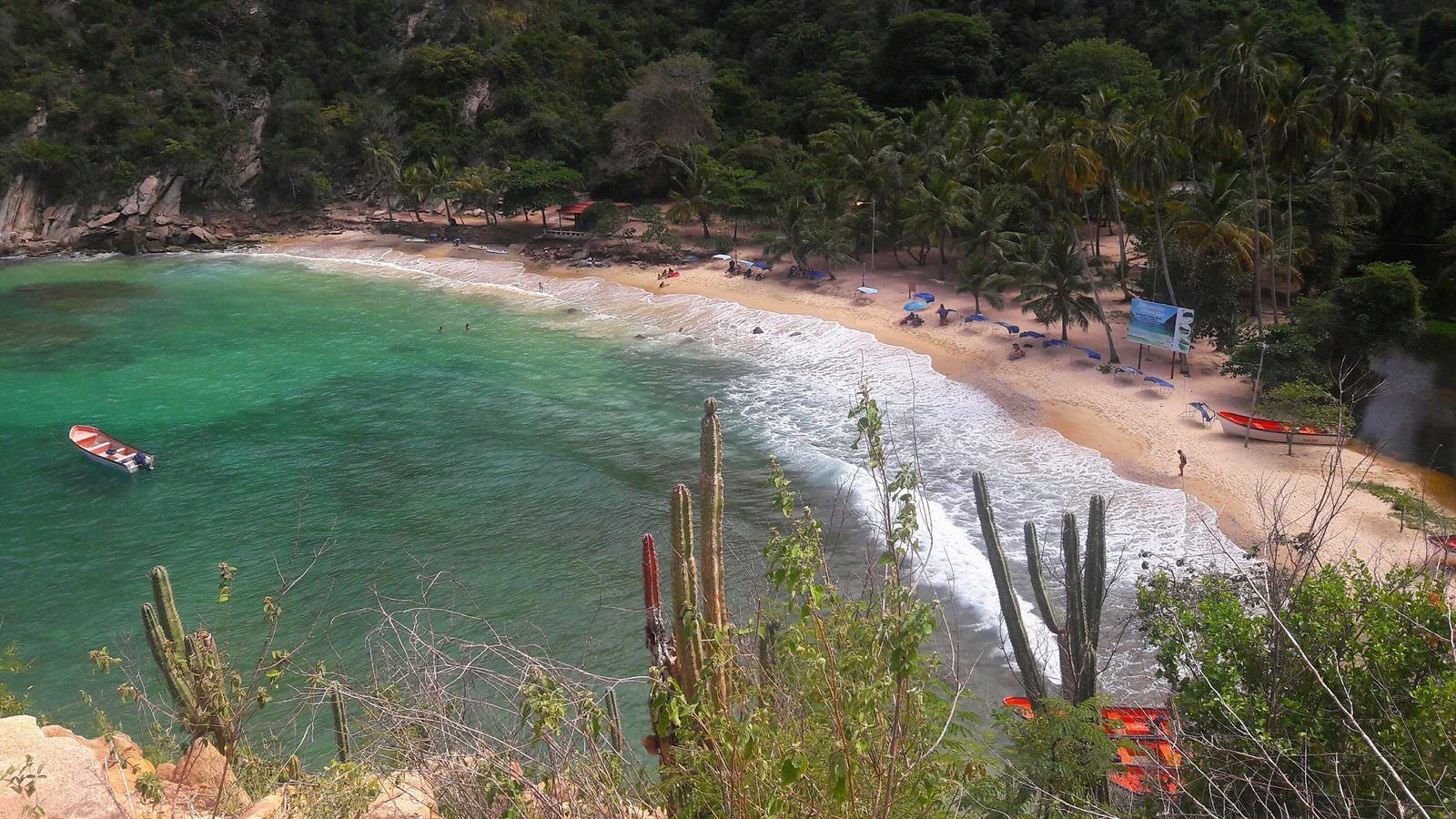
There were actually a lot of supplies available to us in Venezuela and our experience didn’t differ much from the other South American countries we’ve already visited, aside from the unique experiences the country itself has to offer. Of course, we’re not disputing that times are hard, economically and politically, for many Venezuelans, but as tourists there we felt like we had reasonable access to everything we needed.
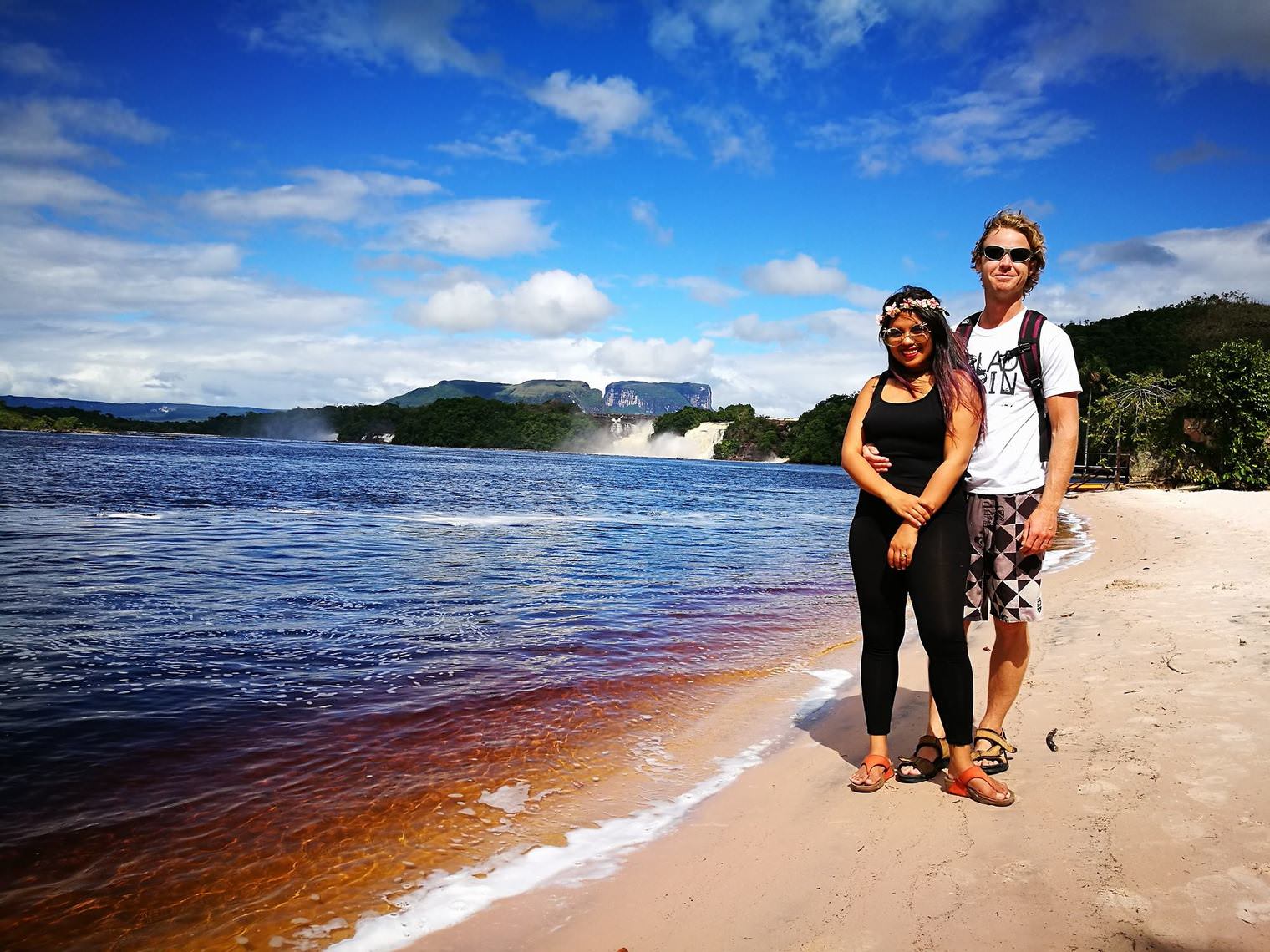
Venezuela is a federal republic on the northern coast of South America and has a population of almost 32 million. While political riots in the city can be frequent at times, we found it very safe to travel in the between the cities by both air and road. Even the random police checks on the highways were a simple experience and the officers inspecting the vehicle and our identification were polite, friendly and happy to have a casual chat with us in Spanish. Exploring Caracas itself is best advised with a knowledgeable guide, who understands where to go, when and how. The local people we met along the way were wonderful, traveling was extremely affordable and the raw, authentic beauty of the country actually made it one of our top must-visit destinations.
Questions and Answers about Venezuela
Where is Venezuela?

Venezuela is bordered by several different countries. You have Colombia on the west, Brazil to the south, Guyana on the east, and the island of Trinidad and Tobago to the north-east.
Is it safe to travel to Venezuela?
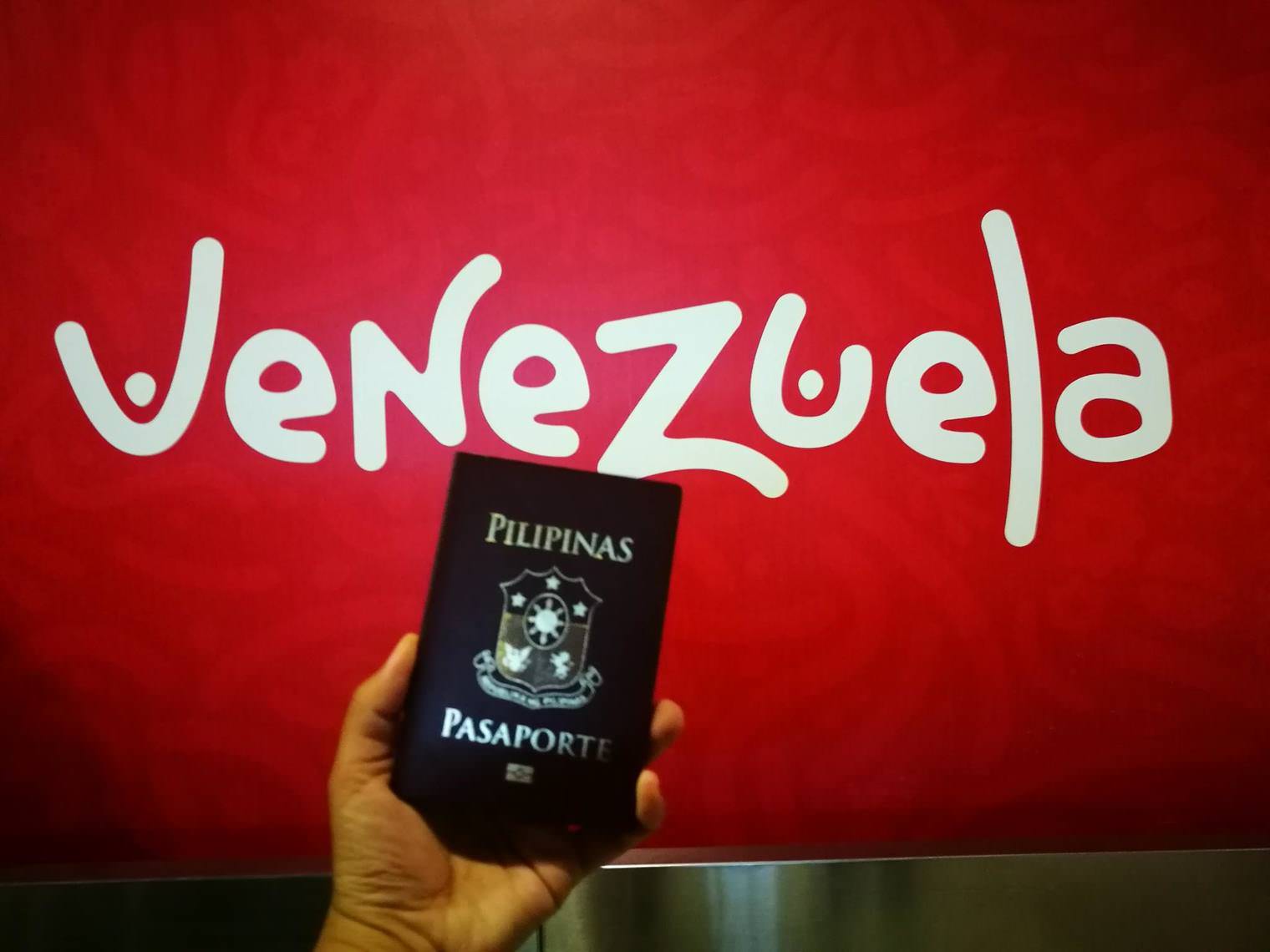
We can’t really say it’s perfect for solo backpackers and hitch-hikers at the moment, however, the condition of the country fluctuates, so what you read in the media is often reflective of something that happened weeks, months or even longer before. It’s important to find current information about what is going on at the time you’re planning to go there so that you can make an informed decision. Like in any part of South America, or the world for that matter, there are areas which you should stay clear of. We decided that we wanted to travel there with someone local who knows the country inside out, understands the situation and also knows how to use that knowledge to make a safe and exciting experience without feeling like a guided bus tour.
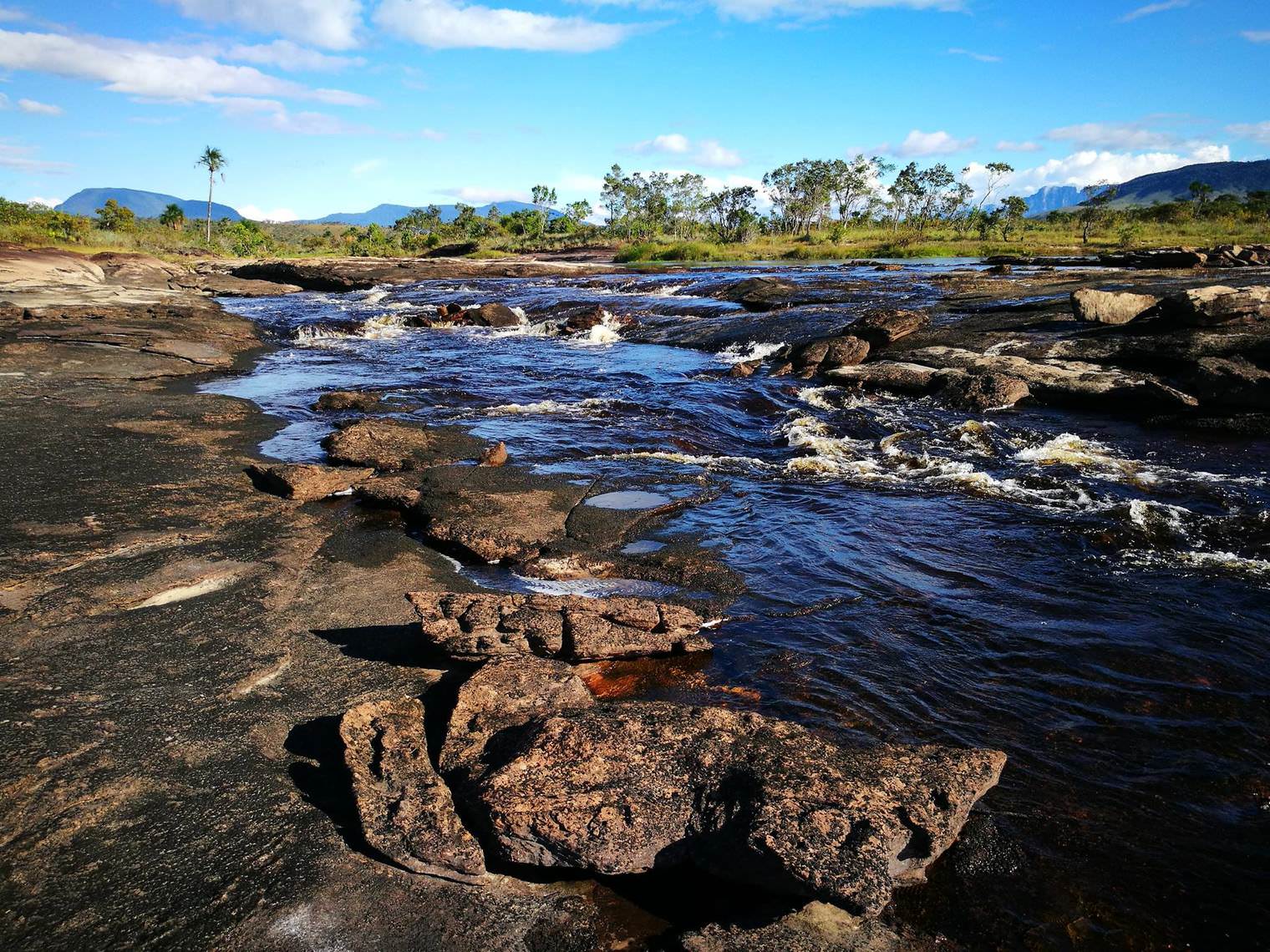
After a small amount of research we contacted Osprey Expeditions , who have been a leading guide and travel specialist in Venezuela since the 1990’s, have the the top Lonely Planet reviews and are the advisors of choice for travel writers looking to document Venezuela, even when government travel advisories tell you to stay away! Osprey Expeditions also offer tours and travel services all over South America.
How to Change Money in Venezuela?
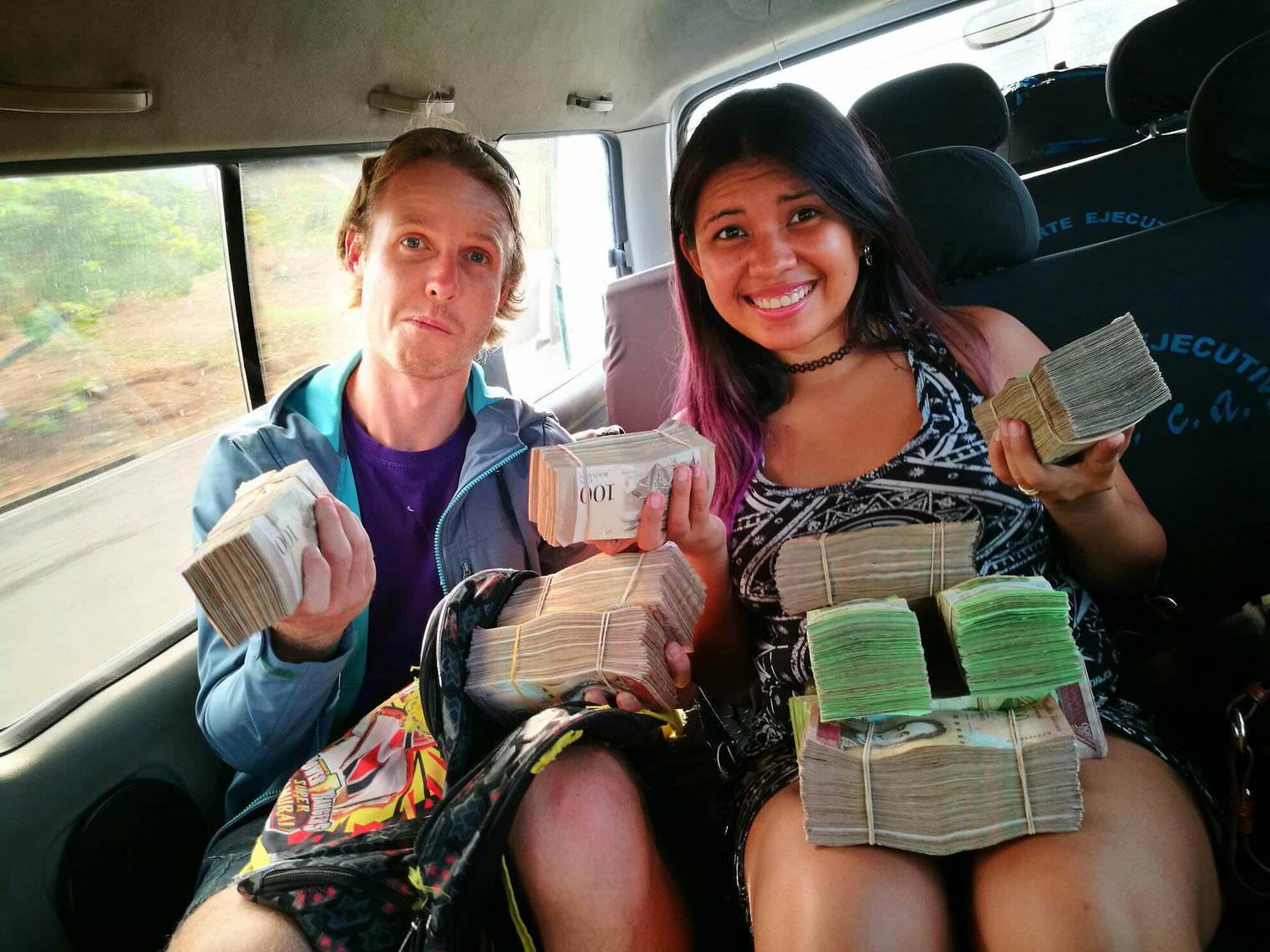
Money in Venezuela is an interesting phenomenon. An economy in depression and long term inflation mean that you can cover a double bed in $50 USD worth of Venezuelan Bolivars, that’s how incredible the exchange rate is! Part of the issue for tourists is that if you try to use your foreign debit or credit card in Venezuela, then the exchange rate the government is trying to set (unsuccessfully) will see you paying $50 USD for a cup of coffee, but technically, bringing in USD’s to exchange them into local currency at the actual market rate is… let’s just say… not allowed! The situation in Venezuela has seen some dramatic changes since we were there a few months ago, so we suggest doing some research on travel forums and contacting your chosen local operator there to give you the most current information.
What is Unique about Venezuela?
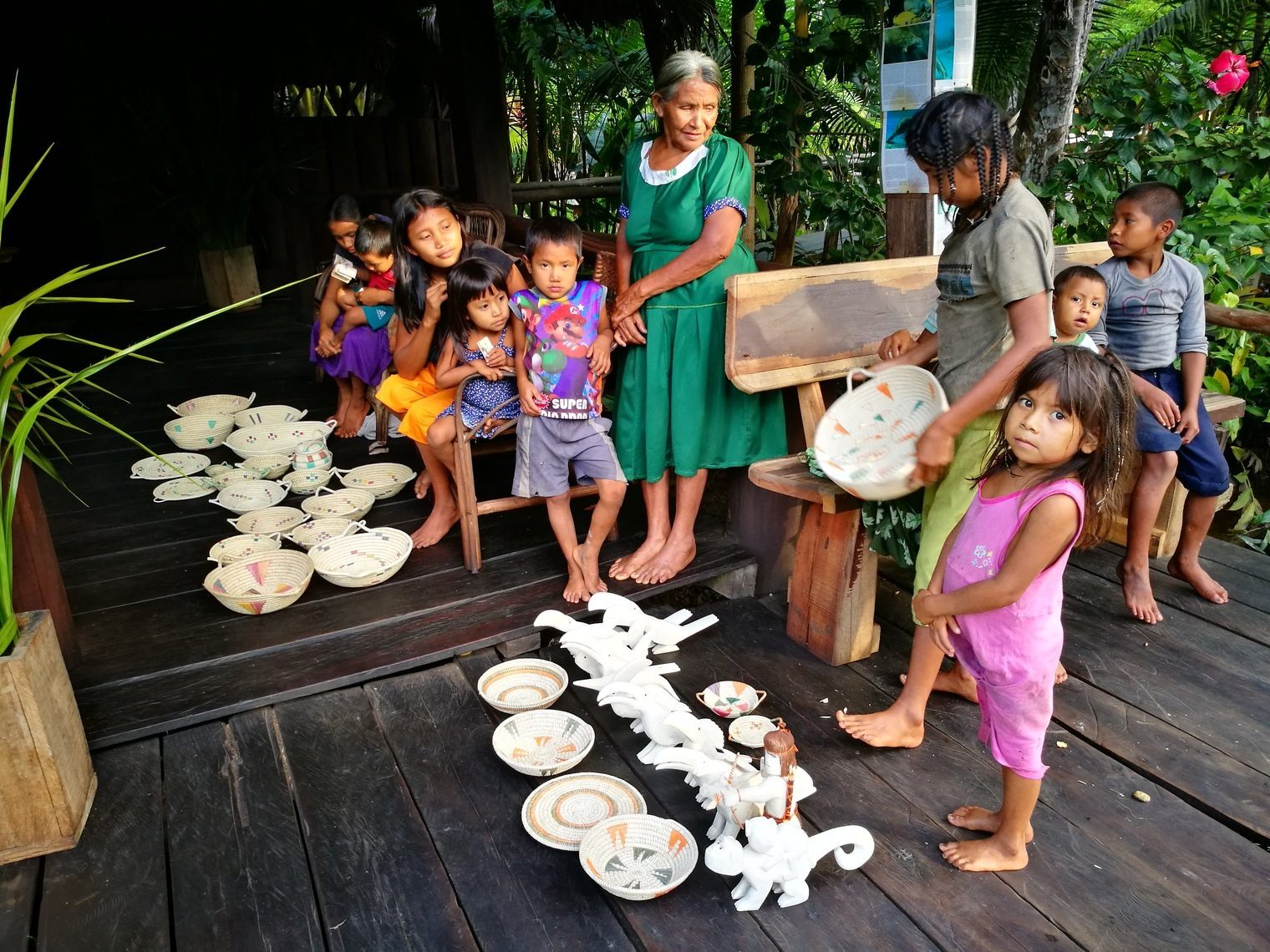
If you are a fan of Miss Universe, then you already know that Venezuela is home to some of the most beautiful women on the planet. But that’s not the reason we went there! I am not exaggerating when I say that they have great landscapes, beaches, and sights which can’t be seen anywhere else. Venezuela is also one of the most ecologically diverse countries in the world – mountains, forests, jungle, wetlands, tropical deltas, coastal wilderness – all densely packed with wildlife!
What is the culture of Venezuela?
Like most South American countries, Venezuela has a very rich culture brought by groups from different parts of the world. You can see minor influences from Italians, Arabs, Germans, and Portuguese to name a few. But in general, the Venezuelan culture has a very prominent Spanish and Caribbean influence.
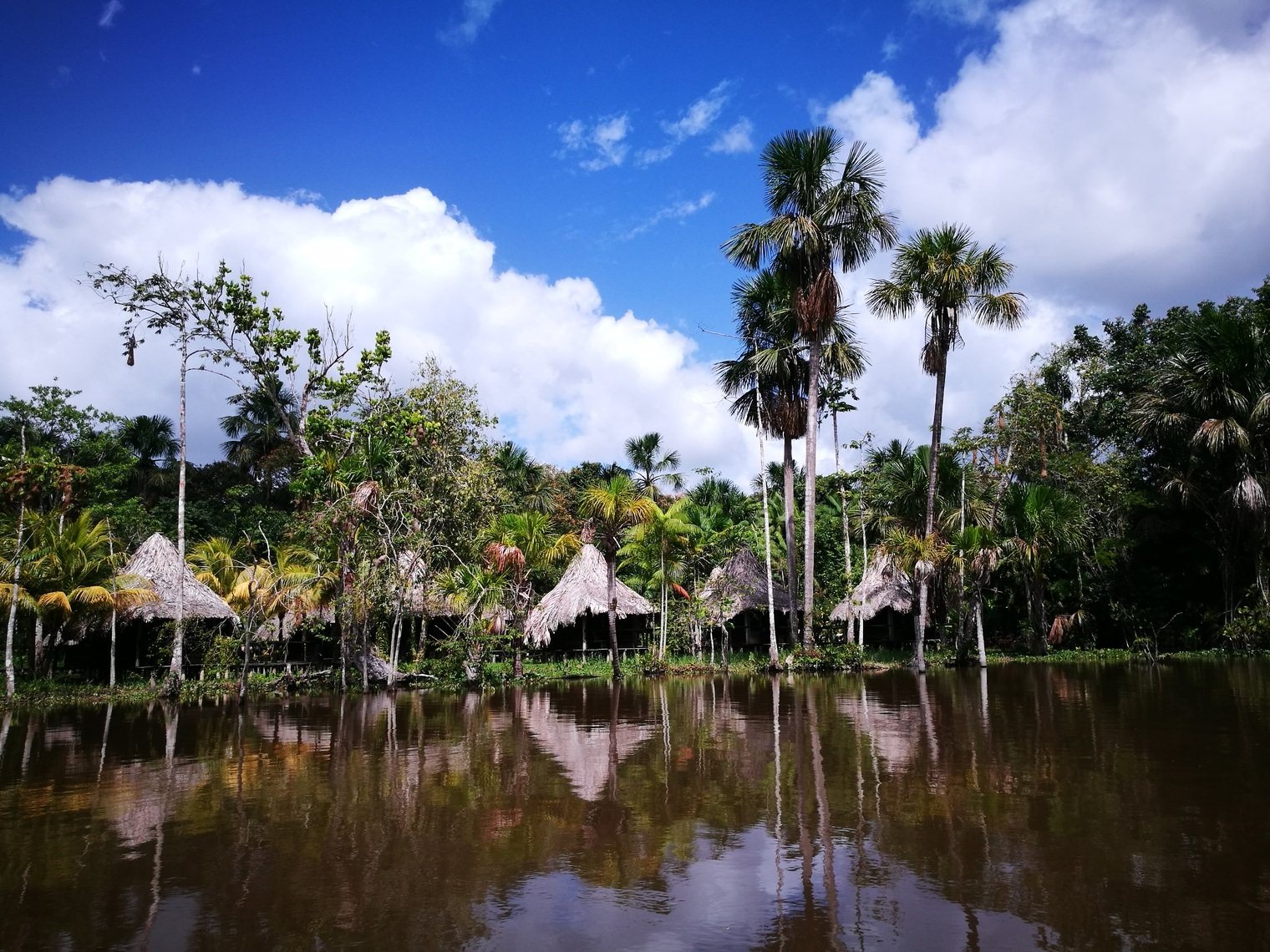
And if you are a baseball fan, then initiating a conversation with the locals wouldn’t be hard as baseball is the most popular sport in Venezuela.
It might surprise you to know that even with the political rifts in the country, Venezuelans are known as one of the happiest people on earth.
What is the Geography of Venezuela?
Venezuela is around twice the size of California. The country is shaped like an inverted triangle and has a 2,800 – kilometer coastline, which occupies much of the northern coast of the continent.
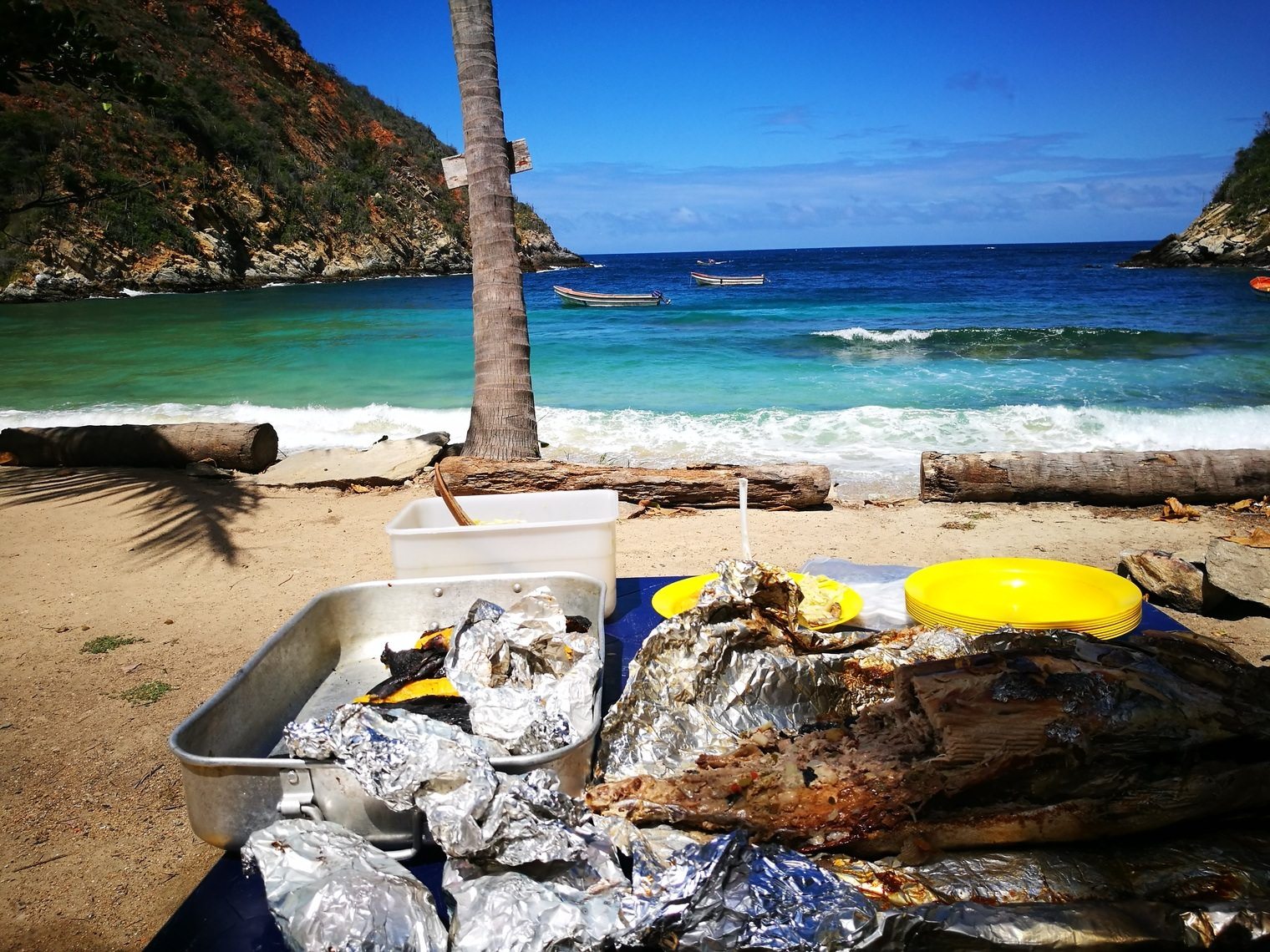
The climate varies wildly depending on your location, mostly due to altitude. The coastal areas are some of the hottest, but with the added benefit of a sea breeze. Lowland areas inland also have a very tropical climate with high temperatures and plenty of humidity. Moving up into the Andean mountains sees a decrease in temperature relative to the increase in altitude, where temperatures can drop to as low as 9°C (48°F). Like most tropical environments, Venezuela has a heavy rainy season, which is from May to December.
The mountain ranges in Venezuela create 4 distinct regions.
- The Maracaibo lowlands
- Mountainous regions in the north and northwest
- Orinoco Delta – A wetland and jungle region leading out to the Caribbean
- Guiana Highlands
There are over 10,000 rivers in the country, but the most significant is the Orinoco river being the 3 rd longest river in South America.
How to travel to Venezuela?
If you are planning to travel to Venezuela, here are some of the airlines that will take you to this amazing country.
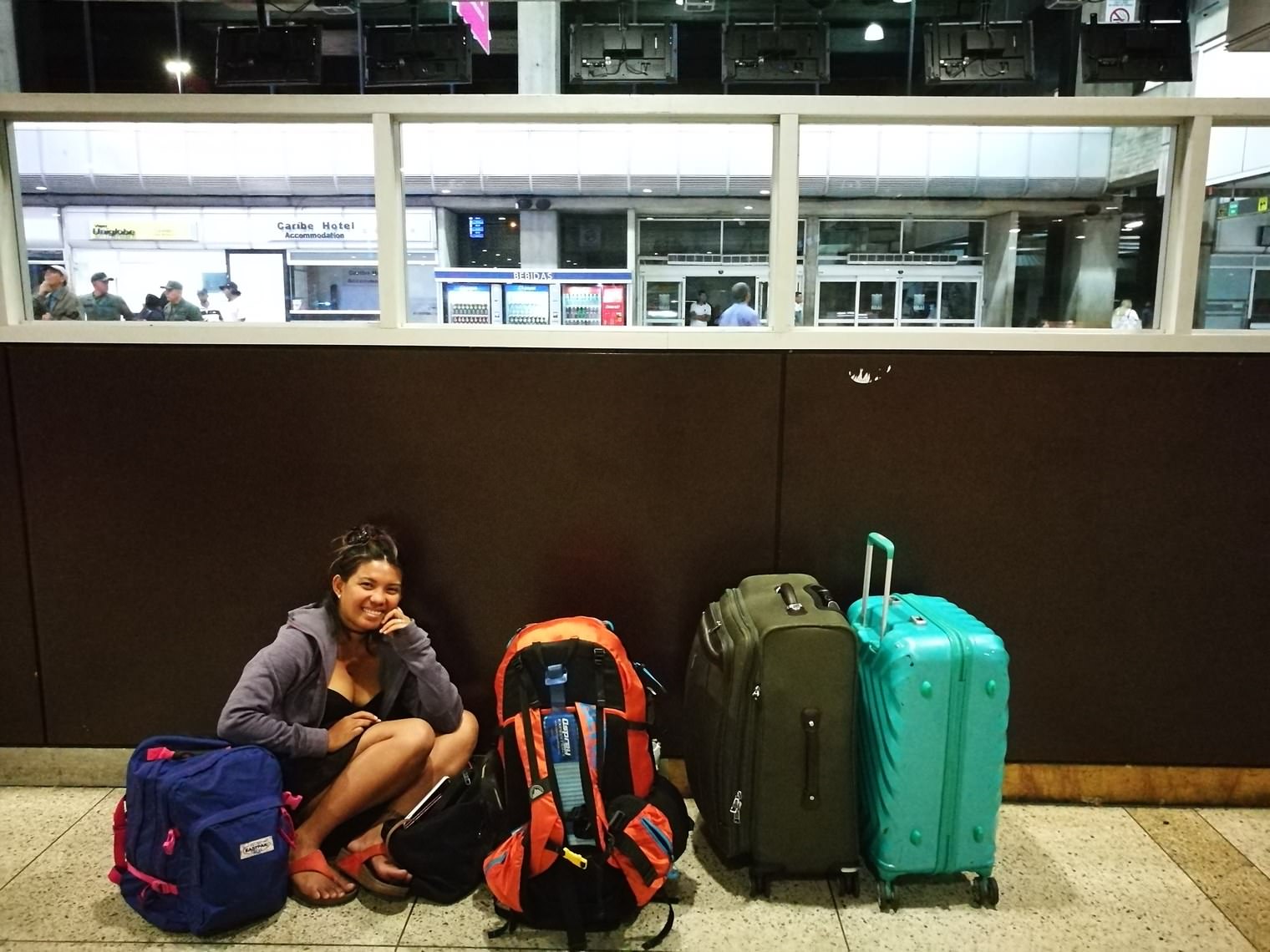
- From the USA – From Miami Florida, you can take non – stop flights going to Caracas via SBA and American Airlines.
- From London – There are no direct flights but you may take Air France, American Airlines, United Airlines and Avianca.
- From Dubai – If you are from the Middle East, specifically in Dubai, there are a number of flights going to Venezuela. Swiss, Air France, Lufthansa, British Airways, KLM are just a few of your choices.
- From Singapore – You may choose, Air France, Singapore Airlines or Lufthansa.
How to travel in Venezuela – Transport in Venezuela?
Public buses – As always, this would be the cheapest option. However, public buses do not have a good reputation when it comes to safety. Reputations are not always correct or in date, so make sure you find reliable information before making this decision
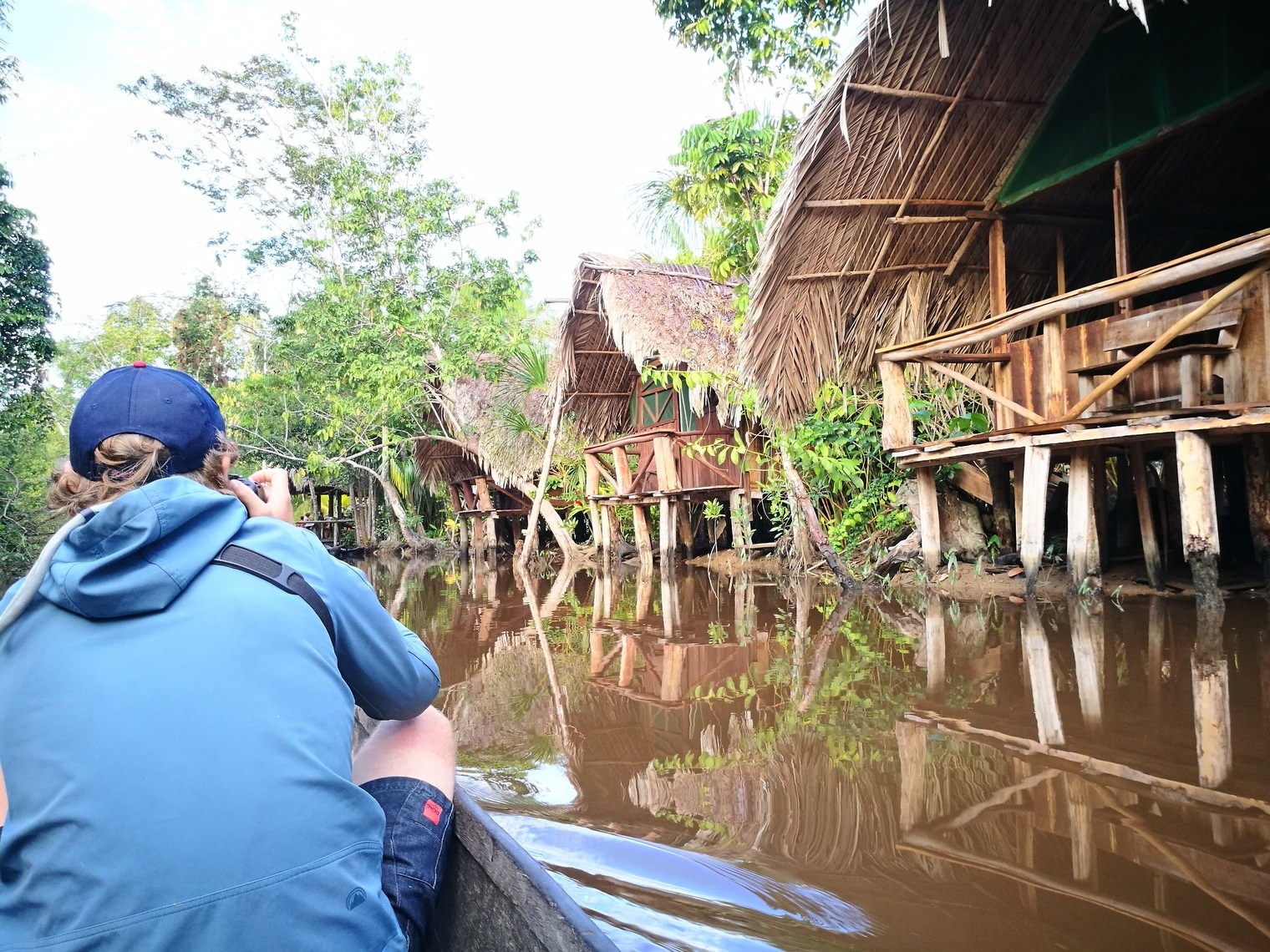
- Train – Caracas has a subway system if you still want to stretch your budget.
- Taxis – The taxis in Venezuela don’t have meters and in fact, there are a lot of unlicensed taxis. Make sure you negotiate a fixed fare before going inside the taxi. This is the most practical means of transportation.
- Private transfers – If you can spend more, then it is always best to have private transfers. Osprey Expeditions have a network of trusted drivers to pick you up and deliver you to hotels, airports or whatever your planned destination is.
What’s the food like in Venezuela?
When you go to Venezuela, the food is different from region to region. Some are influenced by European, West African and even Native American cuisines.
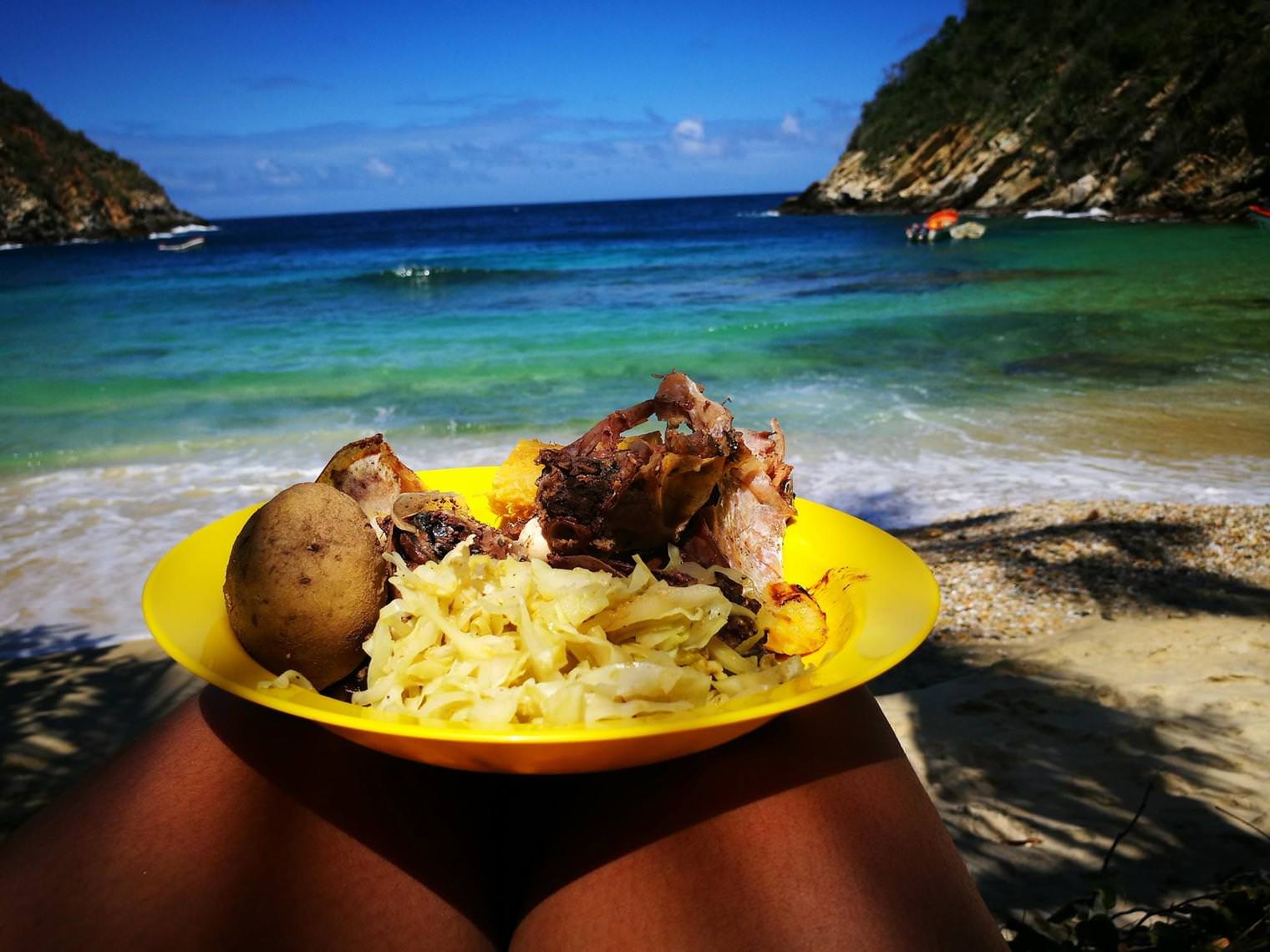
The staple foods in Venezuela are rice, yam, corn, and beans. For sides, these are potatoes, onions, squash, and spinach to name a few. Being one of the most fertile lands in the world, the country is able to cultivate a huge range of fruits and vegetables, much like neighbouring Colombia.
What is the weather like in Venezuela?
The different regions of Venezuela have different climates, which makes this country even more interesting.
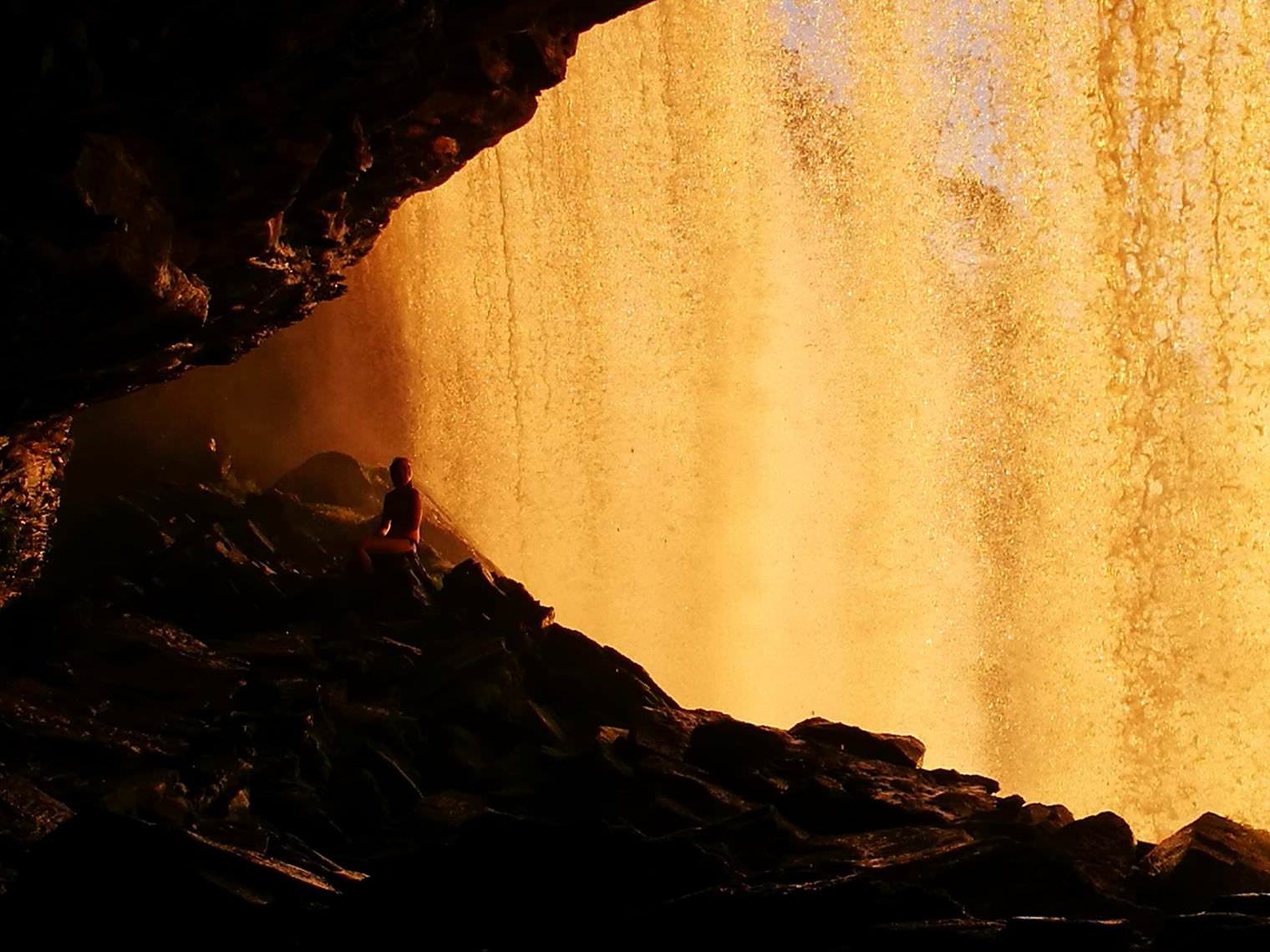
- Maracaibo Lowlands – Dry and hot
- Andes Mountains – Cooler in higher areas
- Central Plain fronting Orinoco Rivers – Warm
- Guiana Highlands (where you can find the world’s highest waterfall, Angel Falls) – Hot and humid
Important things to pack for a trip to Venezuela?
If you are about to pack your bags, here are some things you should keep for your Venezuelan adventure.
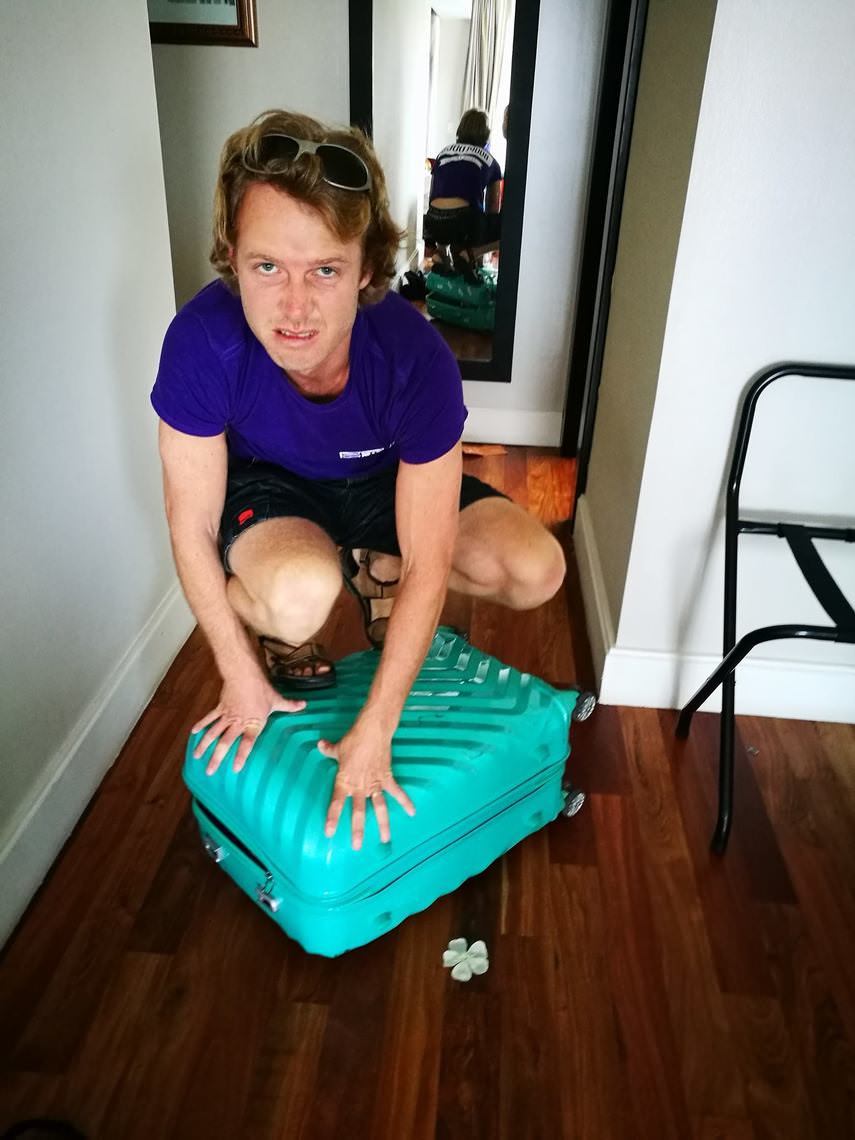
- Lightweight clothes – Cotton and linen will do you good.
- Sunscreen and hat – The sun is strong and you’ll burn faster than you think.
- Money belt – Or some other discreet storage device.
- Light jacket and umbrella – May to July are the rainy months
- Water – Once you arrive, keep plenty of water with you, especially on hiking trips.
Comfortable shoes – Much of Venezuela’s attraction is the great outdoors, so make sure you have outdoor shoes that let you enjoy it!
10 Amazing places to see and things to do in Venezuela!
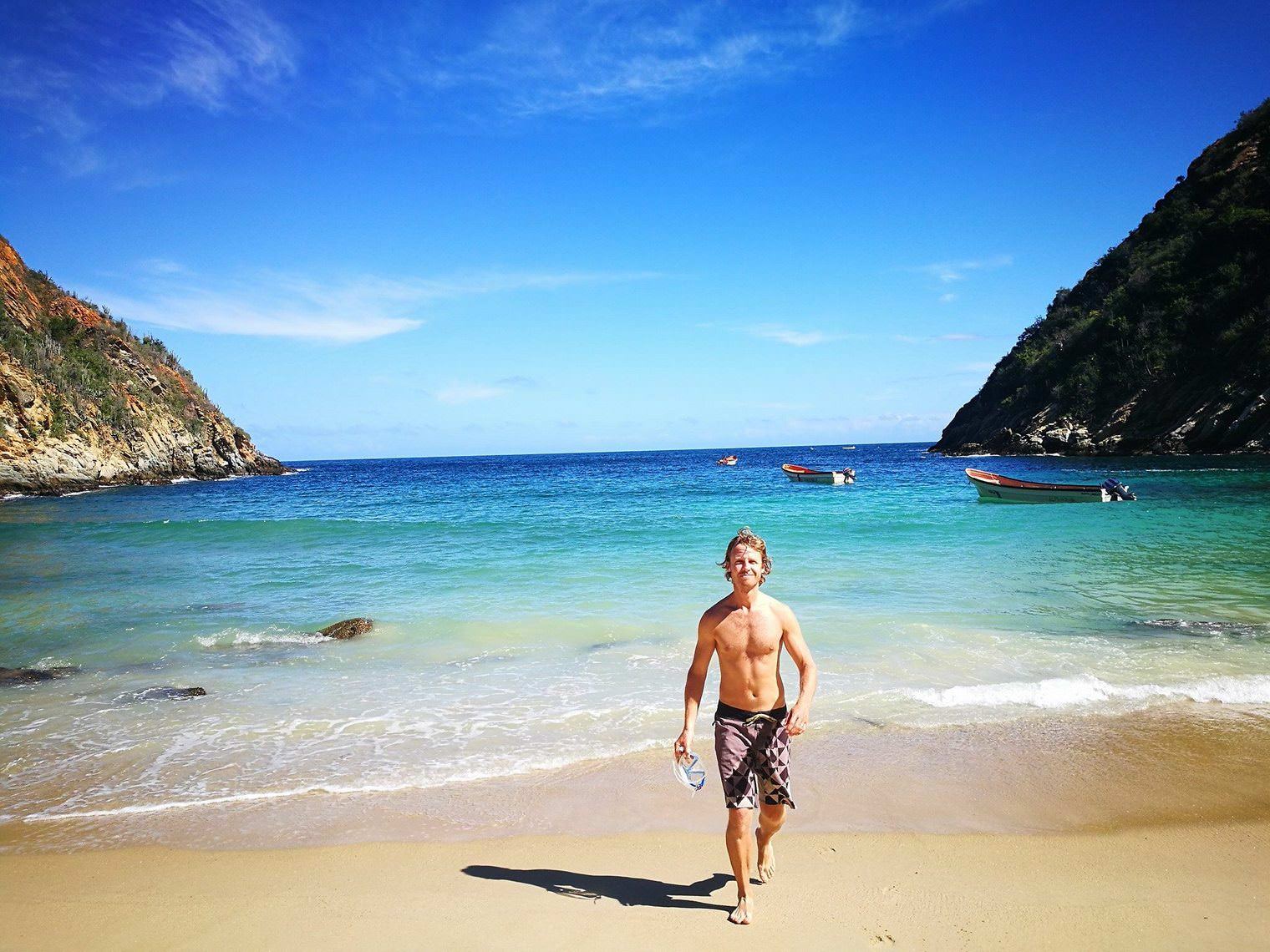
1. Caracas City Tour – This is a full day tour that will allow you to see the real capital city of Caracas behind the stories and news reports. You can even visit museums and ride a cable car at Avila National park.
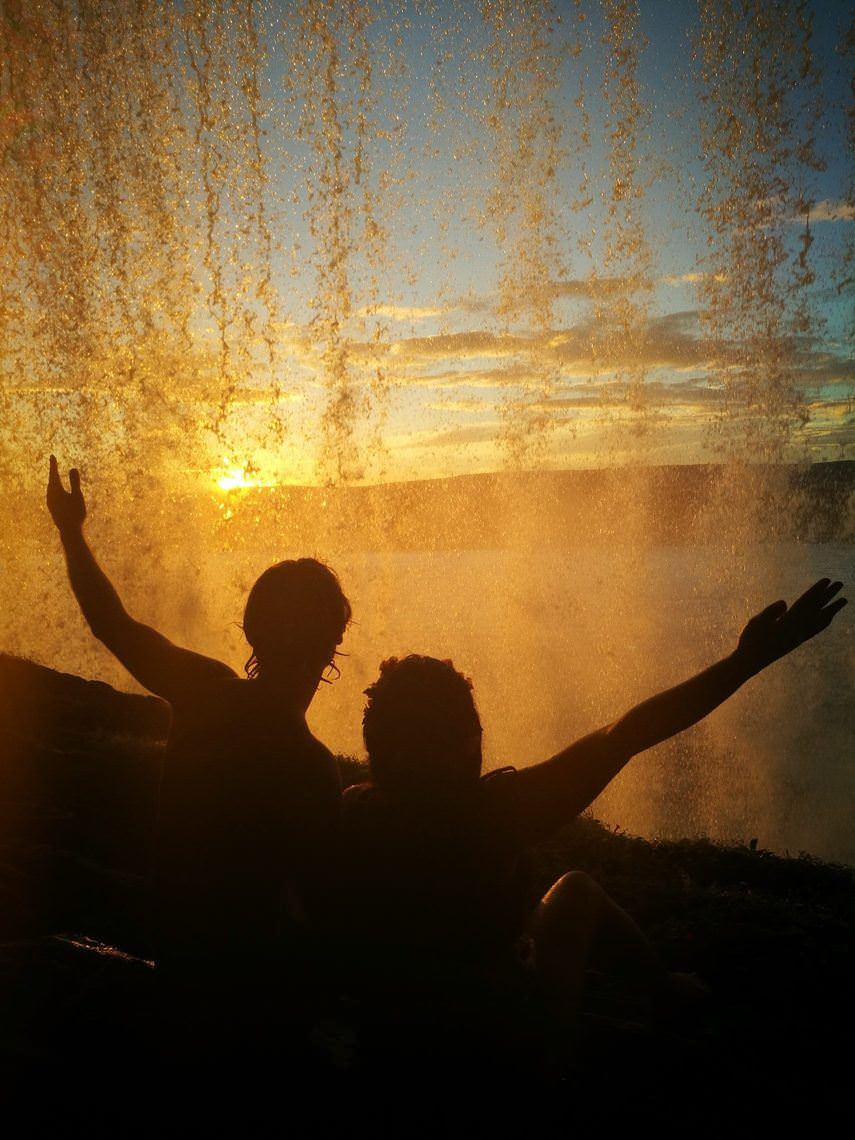
2. Angel Falls Expedition – It would be a mortal sin not to see Angel Falls when you are in Venezuela. You will get into the jungle and will set up a camp close to the waterfalls. The flight by light Cesna aircraft from Bolivar to Canaima National Park is an experience in itself!
3. Choroni and Henri Pittier National Park – This is just 3 hours away from the capital city. Enjoy the fantastic view of the waters and palm tree beaches. You can even go, snorkelling, paddle boarding and have fresh tuna barbecue on the beach!
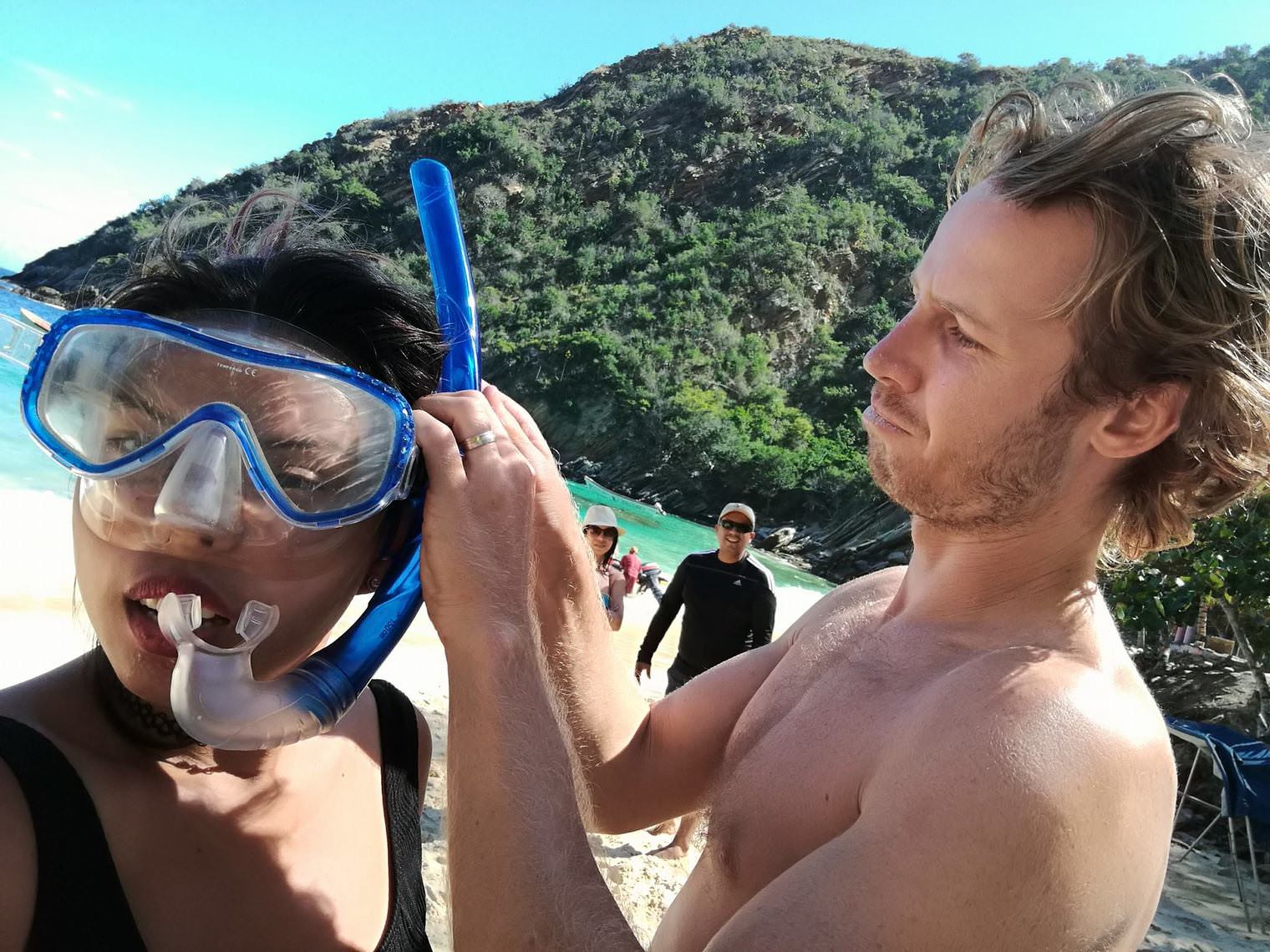
4. Roraima Trek – Go to the highest rock formation of Canaima National Park. This place is very sacred to the Pemon indigenous people and the rock stack itself is formed mostly from pure rose quartz.
5. Orinoco Delta – See the mangrove swamps and the virgin jungle of the Warao, where wildlife like monkeys, snakes, macaws, river dolphins, tarantula spiders and load more are so densely packed you won’t know where to look first! Compared to more frequented tourist destinations, the Orinoco Delta is seriously unspoiled and unique.
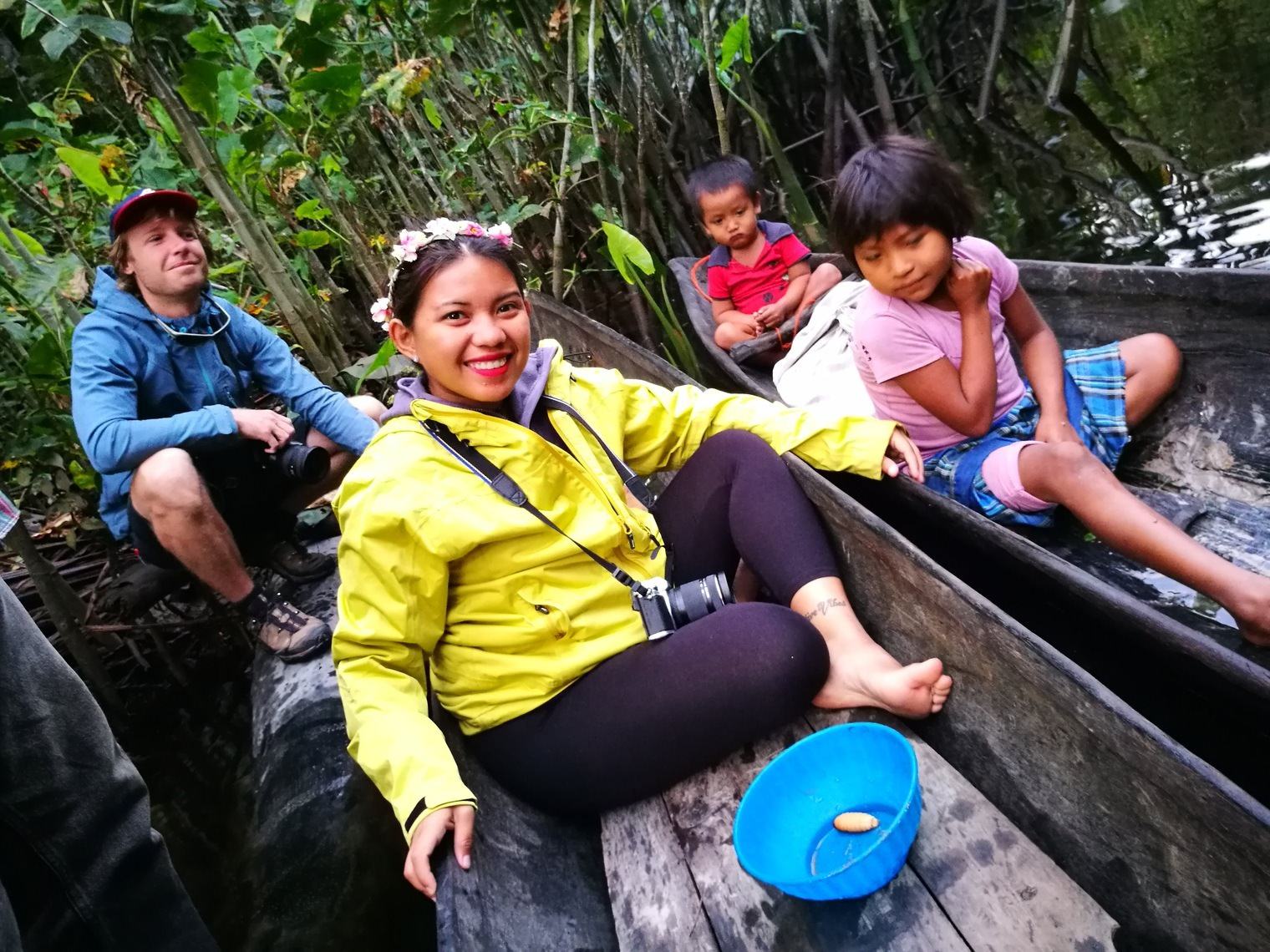
6. Los Roques Archipelago – This is truly a paradise! The coral reef formation and the white sand is like heaven under water.
7. Catatumbo Lightning – This phenomenon happens only in April to November. If you want to see and witness such beauty, you know which dates to book. Before you go, do some research on lightning photography to grab the best shots of this display of pure meteorological power!
8. Merida – This town is known to be the adventure-sports capital of Venezuela. You can go hiking, rafting, mountain biking or paragliding, to name just a few!
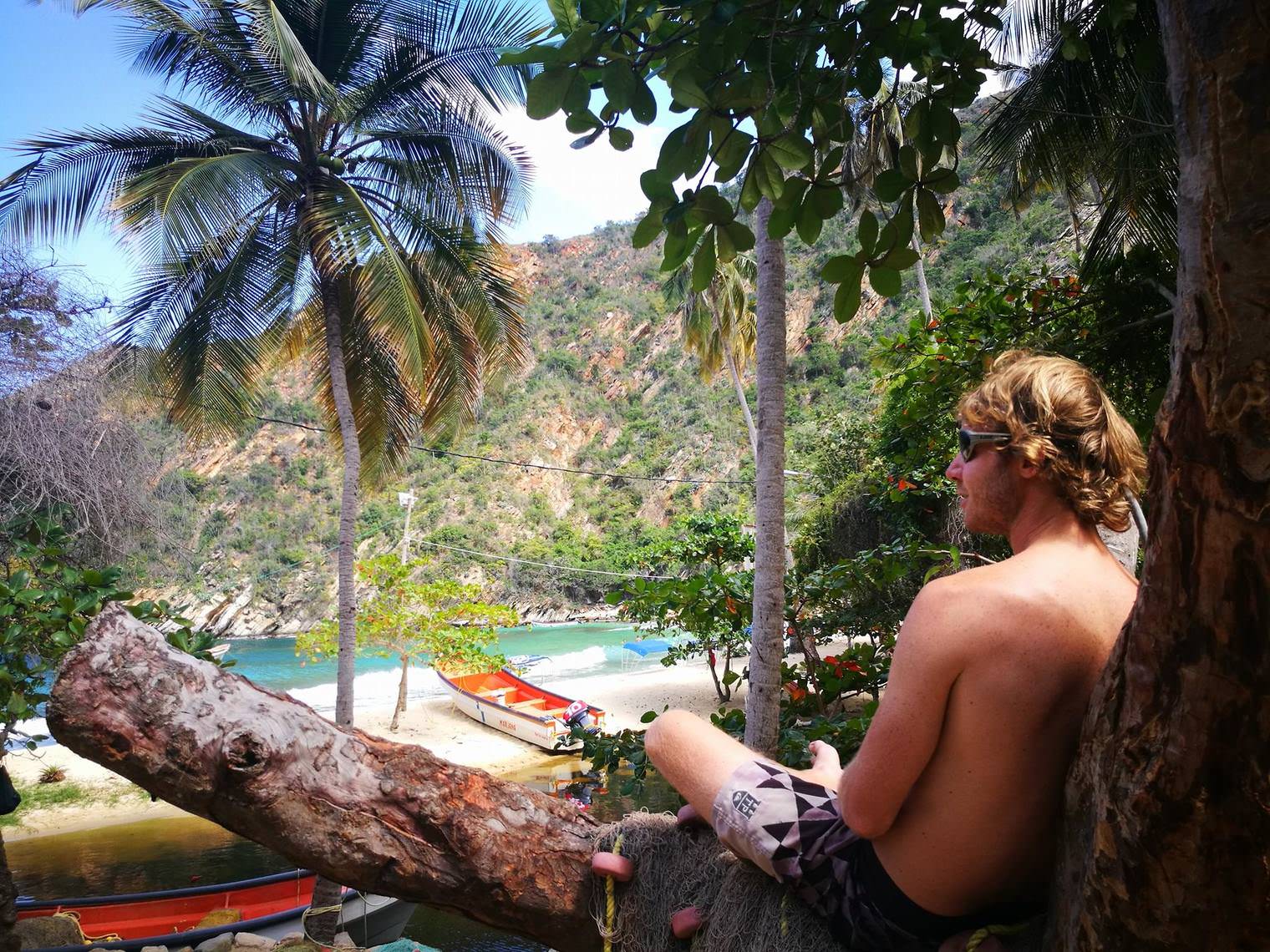
9. Isla Margarita – This is the best place if you want to see the most popular beaches in Venezuela. You can also try snorkeling and kitesurfing and there are a host of very affordable luxury hotels if you just want to relax and recover after all the hiking and exploring.
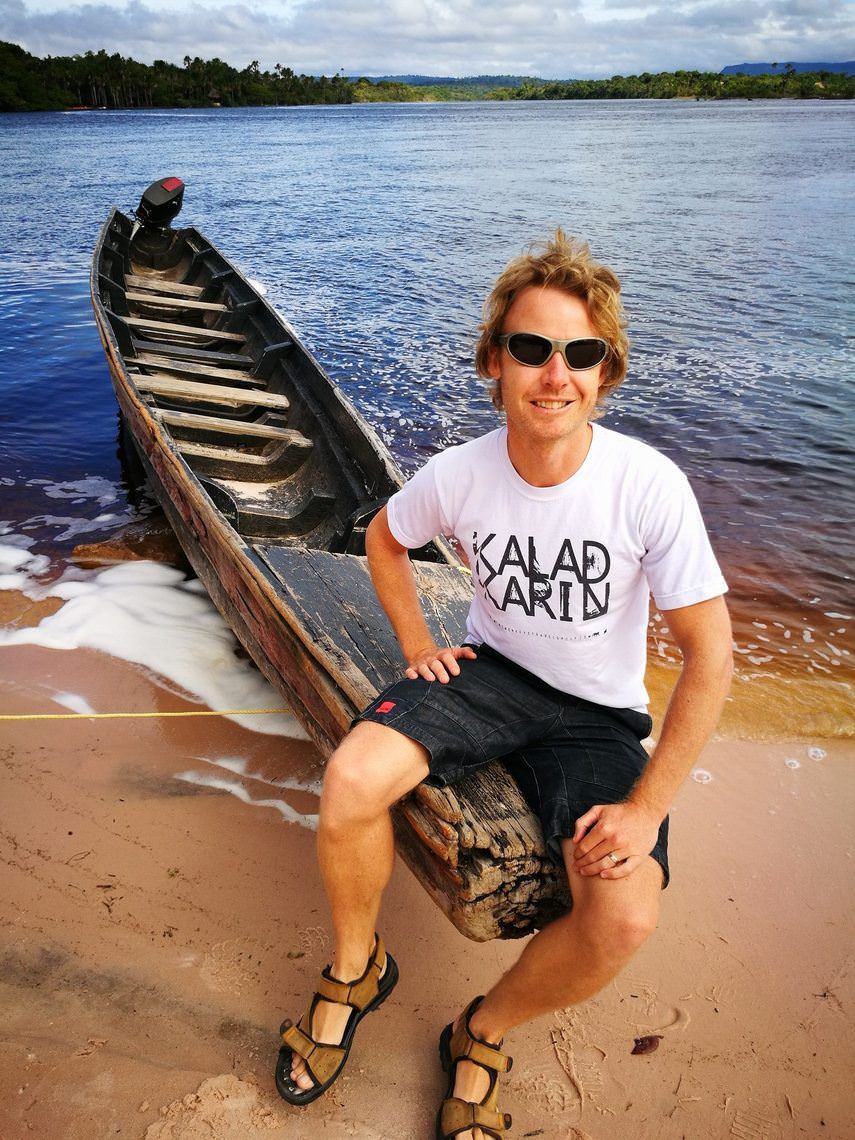
10. Pan de Azucar – Join this tour as it is considered one of the most interesting treks in the Venezuelan Andes mountains. Pan de Azucar peak is one of the highest peaks in the country.
Final thoughts on Venezuela
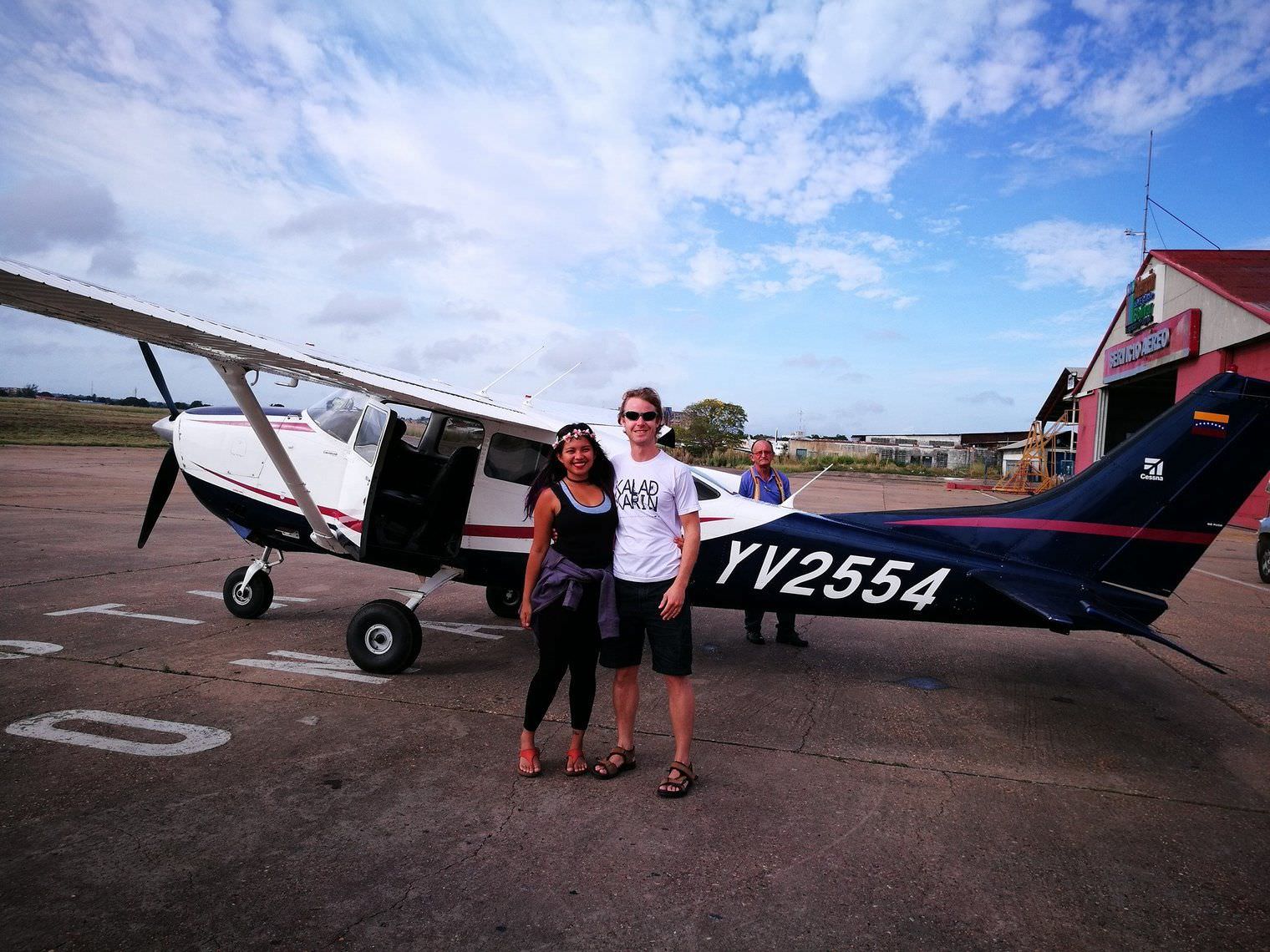
We all know that politically and economically, Venezuela is going through some of the toughest times in the history of the country’s existence, and we all hear the negative news and travel warnings portrayed in the media. We would be lying if we said that all of these things are untrue, or that there is zero risk in visiting Venezuela, but as with any country the risks are localised and are often not as constant or severe as they are made out to be. It is entirely possible to travel the country and be just as safe as you would in any other South American country, particularly if you plan your journey properly and work with a local specialist who can give you the best real-time information to help you make the right decisions.
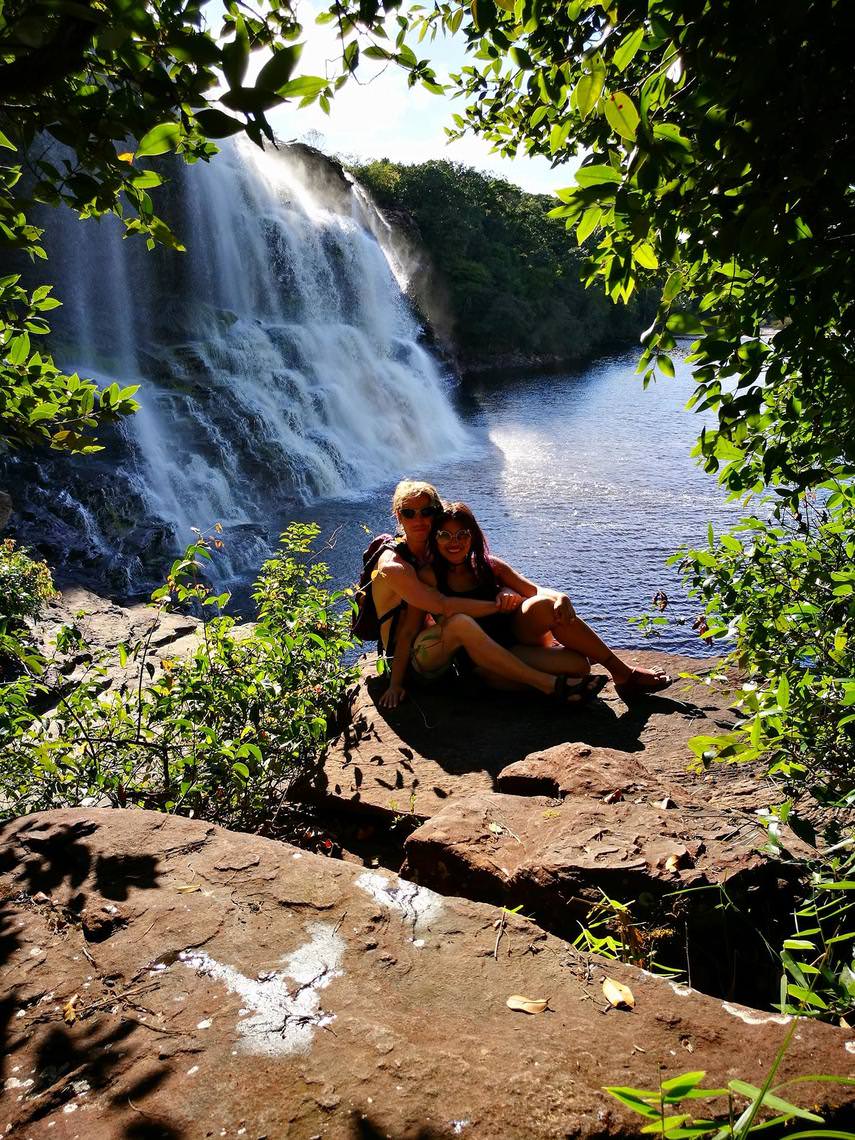
Give this beautiful country and its wonderful people a chance to show you things and offer you experiences that you will never forget and cannot be experienced anywhere else on Earth, and you will be rewarded with more than you can imagine!
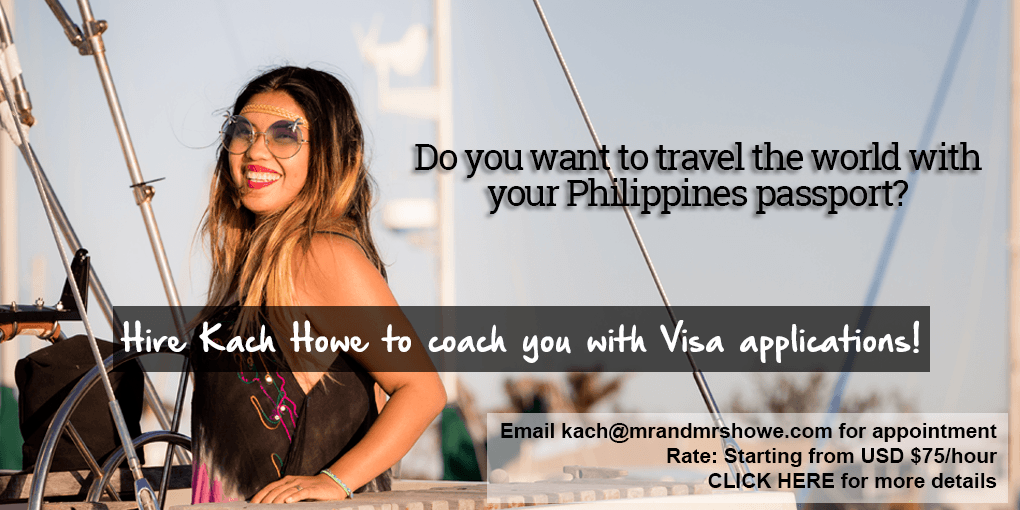
Leave a Reply Cancel reply
Your email address will not be published. Required fields are marked *
This site uses Akismet to reduce spam. Learn how your comment data is processed .
14 thoughts on “ A Short Guide to Traveling in Venezuela – How, Where & Frequently Asked Questions ”
Hi ive worked in venezuela 7 years ago and would like to return to visit. Do you have any services or recamendations for safe travels there?
The Country and people suck and there are much better places to go . I should have had my head examined before I went Bloody thieves . My bags were ransacked desperate pigs . My wife is Venezuelan and hates it their. Hope they all starve and Die!
I don’t think your disaster tourism is very ethical. At least help the local folks and don’t just go with the major tour providers. Stay with locals, hire local guides, and eat at mom and pop places.
Hi! Did you receive any paid advertising from the Venezuelan government for saying only good things about the trip and posting a lot of food pictures?
Nope not really.. we actually paid for our trip! =)
And we’re not investigative journalists.. we’re travel bloggers and focused on the positive vibes and things you can do safely! =)
So if I fly by air I should be able to get a visa to stay for at least 20-30 days right? And how do you travel around with bricks of Bs??? Like going to bars or clubs??? Do you just carry a back pack with bricks of Bs in it? Lol
now is very different the exchange rate change because a convert of the currency, if you want more information i’m happy to help i’m a living in venezuela, telegram: angel23as
Hi, I would love more info, I dont have the telegram thing….maybe u can ad me on facebook https://www.facebook.com/fizz.tf , Fizzah Mian
Thanks a lot for your well explained and detailed guide. Amazing pictures. Now it invites me to visit Venezuela. Peace
Hi thanks for the great advice. I heard they are not giving out visas so easy for Americans Do you know about this? Thank you
Is pretty easy i think is just a formality and to take like 50$ for the entry.
Hello, I really liked your post on Venezuela and the pics! I have been reading Lot about it lately and your description is a stark contrast to what I’ve been reading about the severe poverty and malnutrition of the people that live there. I was curious if you came across any of these things and if you were scrutinized heavily when you arrived since I hear they aren’t allowing food or foreign aid into the country.
Amazing post with cool photos. Certainly on my list of places to visit. Whenever I travel I use Avianca Airlines to book affordable plane tickets.
Loved your post! Cool Photos!! This is first time I am visiting your website and I find this post very very useful thanks for giving such a great information.. Regards!
COPYRIGHT DISCLAIMER: Many of the articles on Two Monkeys Travel Group are guest posts by a number of Approved Contributors and are hosted by Two Monkeys Travel Group. Approved Contributors control their own work and post freely to our site. This includes all text and images that they use within their own work. All contributors are instructed to follow internationally recognised copyright and intellectual property guidelines. Two Monkeys Travel Group takes its own responsibilities very seriously, so if you feel that any part of this work is abusive in any way, please send us an email so that we can investigate - [email protected]
DISCLOSURE: Please note that some of the links above are affiliate links. So when you make a purchase we sometimes make a small commission, at no extra cost to you. The cost to you remains the same, sometimes even cheaper if we have negotiated a special deal for our readers.We use all of the companies we have listed here and that’s why they are in this list, but of course we need to keep Two Monkeys Travel Group running as well as it can, which is exactly what you’re helping with if you do decide to buy or book something through an affiliate link! If you have any more questions about the companies we use or any other companies you’re looking at, just email us and we’ll be happy to help. Please see our full disclaimer page for more information.
Written by Kach Umandap
Founder of Two Monkeys Travel Group. Since 2013, Kach has visited all the 7 continents (including Antarctica) and 151 countries using her Philippines Passport. In 2016, she bought a sailboat and went on sailing adventures with her two cats - Captain Ahab & Little Zissou in the Caribbean for 2 years. She now lives in Herceg Novi, Montenegro where she's enjoying her expat life and living on a gorgeous Stonehouse. She writes about her experiences traveling as a Filipina traveler with a PHL Passport. Also tips on backpacking trips, luxury hotel experiences, product reviews, sailing & adventure travel.
5 Reasons Why You Should Visit TeamLab Planets in Toyosu, Tokyo
Al hamra residence – my best stay in the uae, anavrin ras al khaimah – the perfect retreat for corporate junkies, where to stay in the gambia [best hotels and resorts in the gambia], 8 best things to do in the gambia, west africa, related posts, florida roadtrip from orlando to fort lauderdale and miami, complete list of recommended cheap hotels in nepal, visita iglesia in camarines sur, philippines – 7 church in 7 days itinerary, a detailed guide for your journey to moroni, comoros, previous post, list of the best luxury hotels in chile, list of the best luxury hotels in madagascar, subscribe to our newsletter.
Receive tips on how you can live a sustainable long-term travel lifestyle!
- First Name *
- Email This field is for validation purposes and should be left unchanged.
Venezuela Travel Guide
Popular destinations, san francisco, new york city.
- Terms of Use
- Privacy Policy
- Your US State Privacy Rights
- Children's Online Privacy Policy
- Interest-Based Ads
- About Nielsen Measurement
- Do Not Sell or Share My Personal Information
- Nat Geo Home
- Attend a Live Event
- Book a Trip
- Inspire Your Kids
- Shop Nat Geo
- Visit the D.C. Museum
- Learn About Our Impact
- Support Our Mission
- Advertise With Us
- Customer Service
- Renew Subscription
- Manage Your Subscription
- Work at Nat Geo
- Sign Up for Our Newsletters
- Contribute to Protect the Planet
Copyright © 1996-2015 National Geographic Society Copyright © 2015-2024 National Geographic Partners, LLC. All rights reserved
- News for Kids
- Dominican Republic
- Netherlands
- New Zealand
- Papua New Guinea
- Philippines
- Puerto Rico
- South Africa
- South Korea
- Switzerland
- United Arab Emirates
- United Kingdom
- United States of America
- 7 Continents
- Australia/Oceania
- North America
- South America
- Chinese New Year
- Elections 2024
- Olympics 2024
- European Union
- Trivia & Quizzes
- Solar System Quiz
- Travel Reviews
- Travel Health
- Travel Links
Competition 2024
- Winners 2023
- Winners 2022
- Winners 2021
- Winners 2020
- Winners 2019
- Request A Correction
Venezuela For Kids
Interesting venezuela facts for kids.
Here are some interesting facts about Venezuela for Kids. These facts were chosen and researched by kids especially for kids .
Fun Facts about Venezuela for Kids
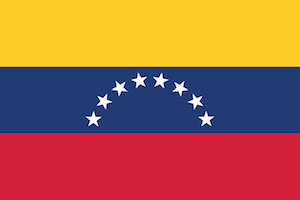
- Population : 30 million people live in Venezuela (2022)
- Capital : Caracas with 3 million inhabitants
- Name : Bolivarian Republic of Venezuela
- Government : federal presidential republic
- Official Language : Spanish
- Religion : more than 95% are Christians
- Literacy : 97% of the population over 15 years of age can read and write
- Currency : Bolivar Soberano
- National Symbols : the national colours: yellow, blue and red, and the troupial (national bird)
- National Day : 5 July (Independence Day)

- National Anthem : ' Gloria al Bravo Pueblo ', means in English: Glory to the Brave People
- History : The first indigenous people inhabited the land already 15,000 years ago. The first settlement by Spanish explorers was established in 1520. The name "Venezuela" is said to originate either from the Italian word for "Little Venice" which is Veneziola in Italian that was given to the area by the Italian explorer America Vespucci due to the stilt houses at Lake Maracaibo or from the indigenous people that called themselves Veneciuela . The country was a colony of Spain from 1522 until 1811 when Venezuela declared independence. The country only became fully independent in 1829, when Venezuela separated from Gran Colombia.
Venezuela for Kids | Geography
Where is Venezu ela? Venezuela is a country in northern South America. The country has the shape of a triangle and borders the Atlantic Ocean to the north. The Caribbean Sea is part of the Atlantic Ocean.
Land borders are shared with Brazil, Colombia and Guyana. The longest landborder is shared with Colombia.
The capital city of Venezuela is Caracas.
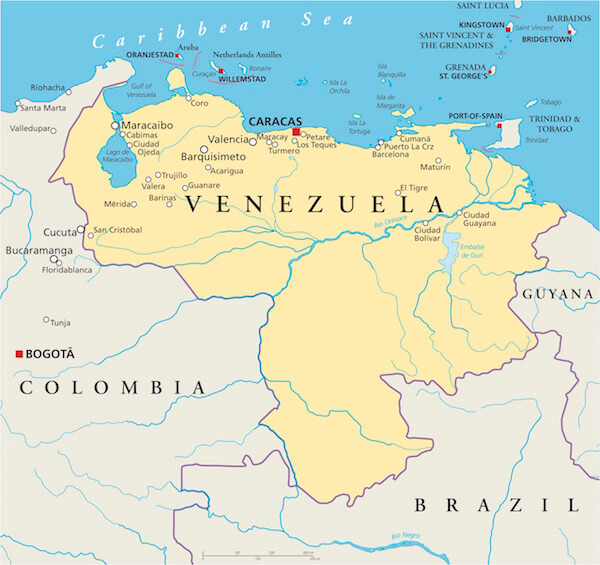
About 300 islands belong to Venezuela, these are located in the Caribbean Sea. Most of these islands are small and inhabited.
The climate of Venezuela is tropical, hot and humid, as well as more moderate in the mountainous regions of the Andes highlands.
A flight to Caracas takes about 17 hours from London/UK, or 8.5 hours from New York/USA.
Venezuela is more than twice the size of California/ USA or a bit larger than Germany and Spain combined or a bit smaller than Nigeria .
Venezuela for Kids | Geo Superlatives
- Venezuela is one of the 17 megadiverse countries in the world.
- Venezuela’s highest peak is the Pico Bolívar with 4,979m/ 16,335 ft.
- Venezuela does not only have very high mountains but is known also for the tepuis which are very unique table-like flat mountain landforms.
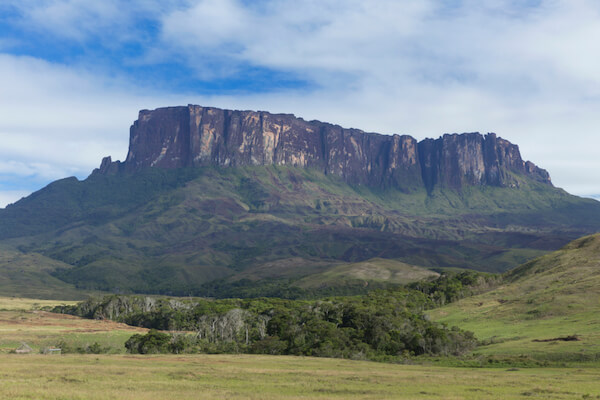
- The most important and largest river system in Venezuela is the Orinoco River.
- The Angel Falls, also called Salto Angel, are the world’s tallest waterfalls with 979 m/ 3,211 ft and are located eastern Venezuela.
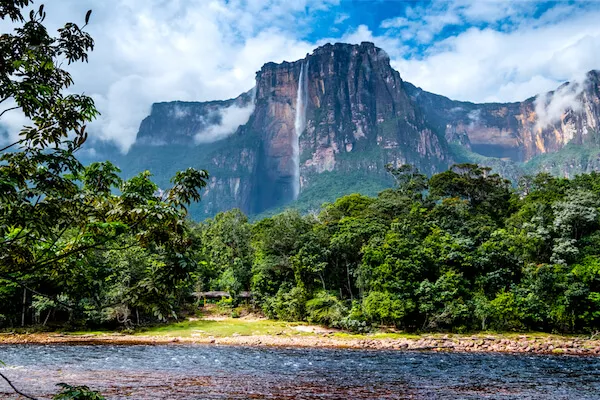
- Lake Maracaibo is often named the largest lake of Venezuela, however, it is more exactly an inland sea or bay of the Caribbean Sea.
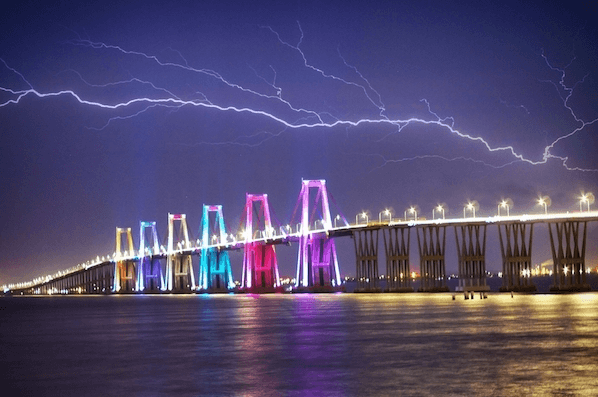
Lake Maracaibo is world's most active area for lightnings! Powerful storms at Catatumbo can reach up to 28 strikes per minute and often happen in the evening or at night. Some of these lightnings can last throughout the night.
Venezuela for Kids | Attractions and Landmarks
Besides the fascinating waterfalls, rainforest and 43 national parks, there are our some other awesome landmarks and attractions in Venezuela for families to explore:
- Los Roques is a chain of islands in the Caribbean Sea with about 250 coral reefs. There is a turtle sanctuary and lots of picturesque spots for swimming, snorkelling and diving in turquoise coloured clear waters.
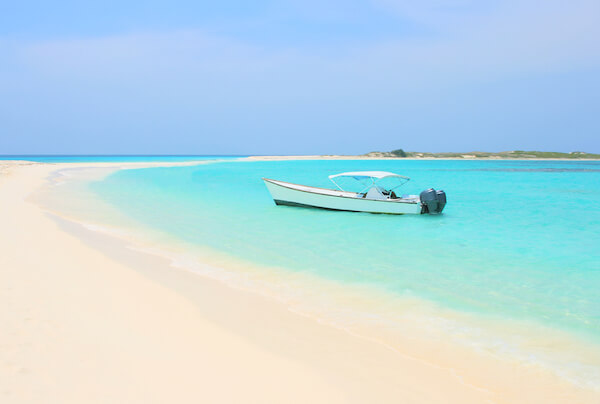
- The mountain town of Merida is known its beautiful colonial buildings as well as for the "Mountain Dreams" ( Montana de los Suenos ) fun park which is an attraction enjoyed by many families. The peaceful landscape in northwestern Andes region is a wonderful escape for many city dwellers.
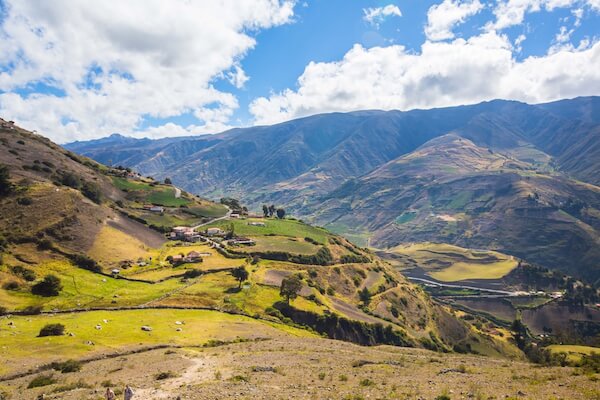
- Esfera Caracas 360 , in English called "Caracas Sphere", is a famous sculpture by artist Jesús Soto. The sculpture offers optical illusions when walking around it. The 'Soto Sphere' is seen as a symbol of the capital city.
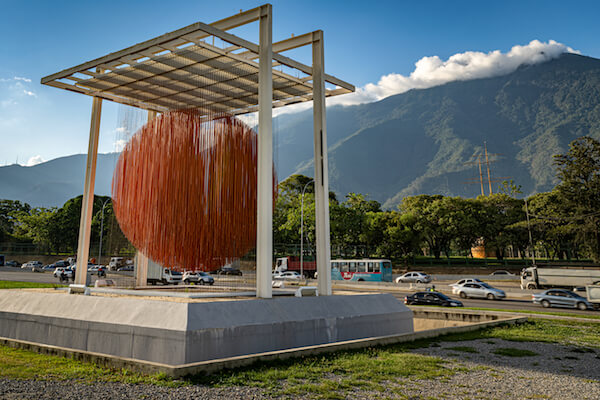
- The town of Coro is the oldest colonial town in Venezuela. The Cathedral was built already in 1525 and the town was the first capital of the country and still houses many colourful colonial buildings.
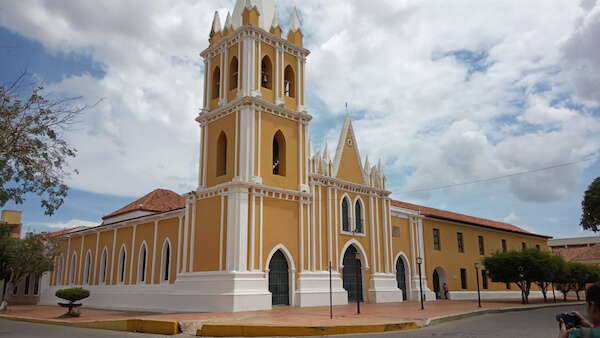
- The Medanos de Coro National Park near the city of Coro is famous for its huge sand dunes. The sanddunes can reach over 40 m/ 130 ft in height.
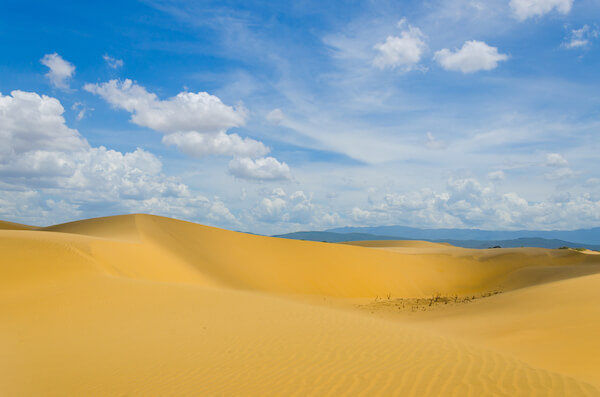
- The statue of the Virgin Mary of Trujillo is the highest statue in the Americas. It is taller than the Statue of Liberty in New York!
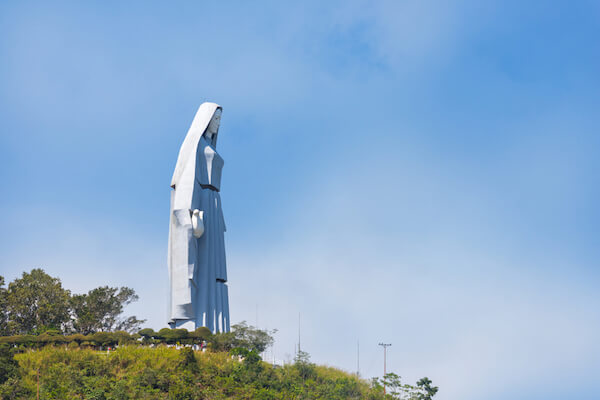
Venezuela for Kids | Venezuelan People
The region of today’s Venezuela was settled already about 15,000 years ago. Among the indigenous population of the area are the Timoto-Cuicas, the Kalina and the Mariche people.
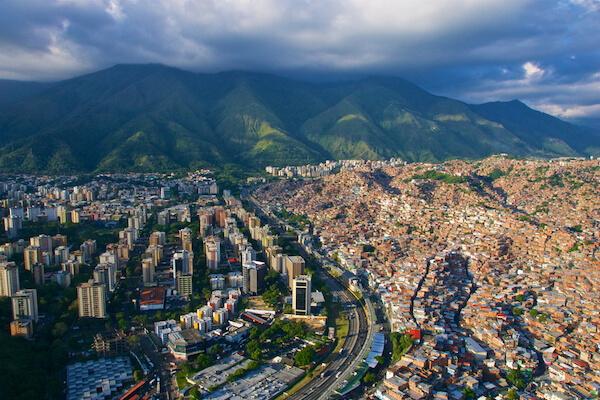
Caracas is the largest urban area in Venezuela and houses about three million people. Most of the Venezuelans live in the northern and western highlands.
Maracaibo and Valencia, which was the capital city for a short time in the 1830s, are other large cities with more than two million inhabitants.
Venezuelans enjoy being out and about such as in Caracas East Park, where there is also the Humboldt Planetarium, a zoo and a children's museum with a replica of the caravel of explorer Christopher Columbus.
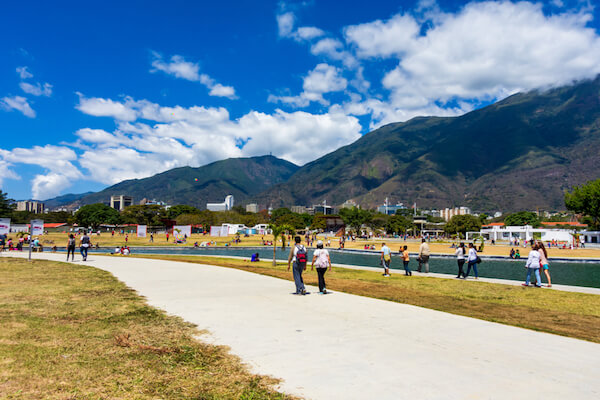
Education in Venezuela is free for children up to 15 years, however, in rural areas many schools do not have toilets, windows, proper classrooms. In remote areas access to a library or computers, are something most children only can dream of.
In Venezuela it is prohibited to manufacture, possess or sell violent video games and toys, still Venezuela is one of the most dangerous countries to live in.
The country is going through a bad crisis and many people are fleeing the country as poverty and crime is very high in many places.
The country has the highest murder rate of the world. The death penalty was competely abolished in Venezuela in 1893 and the maximum jail sentence is 30 years.
Venezuela for Kids | Venezuela Economy
The country has large resources of petroleum, natural gas and minerals such as iron ore or gold. Still the population in the country is very poor, almost nine in ten people suffer from poverty and hunger.
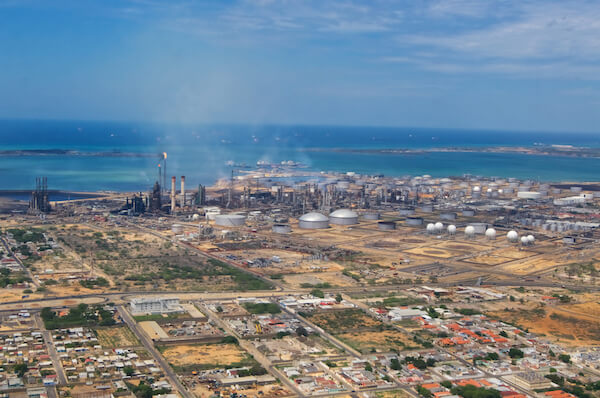
- Venezuela has the largest oil reserves in the world, about 18% of all oil reserves are held by Venezuela. The first oil field was drilled in Venezuela in 1914, however, due to the falling oil price, the economy suffers tremendously as almost all of Venezuela's exports are crude oil and refined petroleum products.
- The petrol price in Venezuela is the lowest in the world due to having high petroleum reserves.
- Venezuela also had the highest inflation rate in the world for several years. Prices in Venezuela doubled every 18 days! Now, with the Russian war in Ukraine, and thus having limited oil supply by Russia on the world market, inflation in Venezuela has decreased as Venezuela is able to export oil for higher prices.
- To counteract the hyperinflation, the Venezuelan government has introduced digital tokens in 2018. These tokens are called Petro, a cryptocurrency similar to Bitcoin . The name Petro refers to the backing of the currency by the national petroleum reserves.
- The main agricultural crops in Venezuela are sugar cane, corn, rice, potatoes or fruits such as bananas and pineapples
- The main trading partners of Venezuela are India, China and the USA.
Venezuela for Kids | Animals
The national bird of Venezuela is the troupial with its orange feathers.
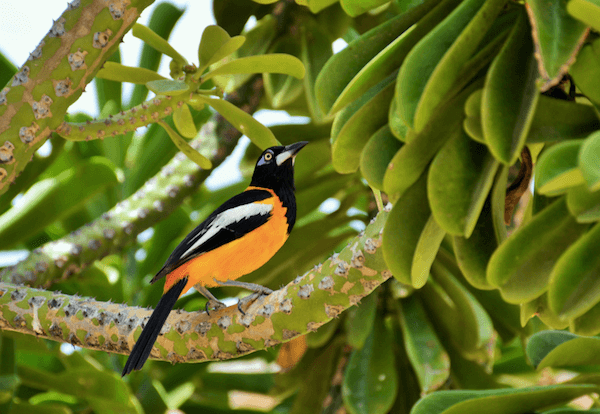
Venezuela has a rich wildlife. About 8,000 species of animals are endemic in the country. Endemic means that the animals originated and always lived in this country or region. Venezuela is one of the richest countries in regards to biodiversity (which refers to plants and animals).
Most of the mammals and bird species can be found in the tropical rainforests south of the Orinoco river.
Among the fascinating endemic mammals are jaguars, giant ant eaters, sloths, lizards, howler monkeys and capybaras.
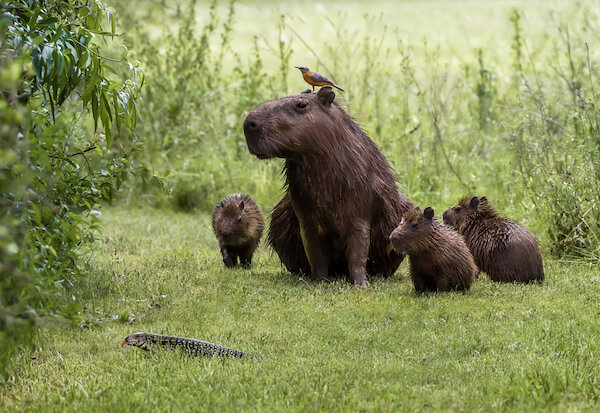
Capybaras are the world's largest rodents and grow up to 1.3 m/ 4.3 ft. Capybara's also live in Argentina .
Manatees can be found as well as Amazon river dolphins.
The crocodiles in the Orinoco river are among the largest crocodiles and smaller than the Nile and saltwater crocodiles. Orinoco crocodiles have a long and narrow snout compared to other crocodile species.
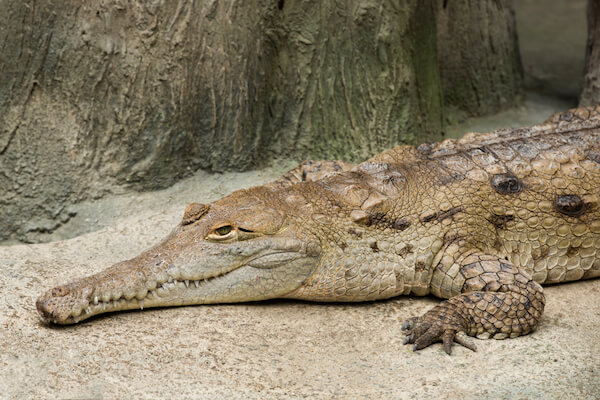
The critically endangered Orinoco crocodiles grow up to 6.6 m/ 22 ft.
Venezuela for Kids | Geo for Kids Useful Resources
- Agnieszka Gautier. "The Maracaibo beacon." NASA Earthdata . Last updated 19 April 2021. Last accessed 8 June 2022
- Arnaldo Espinoza. "The Untold Story of the Jesús Soto’s Iconic Caracas Sphere." Caracascronicles . 14 January 2019. Last accessed 8 June 2022
- Central Intelligence Agency. "Venezuela." World Fact Book. Update 19 May 2022. Last accessed 8 June 2022
Venezuela for Kids | Related Pages
We hope you enjoyed reading our Venezuela Facts for Kids. Make sure to bookmark this page, as we plan to add on more information to make this page even more interesting, not only for children:-)
Picture credits on this page: Images by SXC.hu and Shutterstock.com, Images: Statue of Peace Virgin Mary in Trujillo in Venezuela by Paolo Costa/shutterstock.com; Parque de Este by Giongi63/shutterstock.com
Return from Venezuela Facts to Kids World Travel Guide Homepage
Competition 2024 is open!

Events & Celebrations
Organisations, games & quizzes, travel tips, competition, recent articles.
Facts about Liberia for Kids | Africa Facts for Kids | Geography
Apr 25, 24 09:36 AM
UAE Facts for Kids | United Arab Emirates Facts | Geography | Travel
Apr 19, 24 04:33 AM
Argentina Facts for Kids | Geography | Attractions | People | Animals
Apr 12, 24 05:32 AM
More about South America
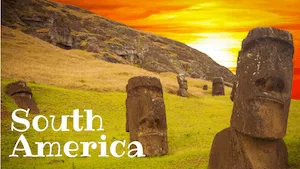
More about Countries in South America
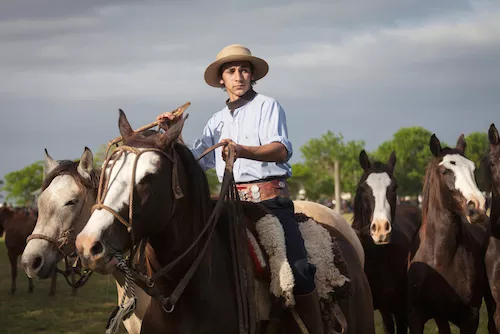
News for Kids!

Temperature in Celsius
Temperature in fahrenheit.

Winning Essays 2020
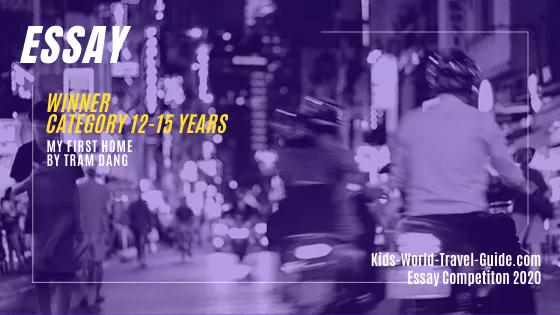
Winning Essays 2021

Join us on Facebook
Kids World Travel Guide
Brilliantly
Content & links.
Verified by Sur.ly
©Kids-World-Travel-Guide.com 2010-2024 | Created by Regina Gräff and KidsWorldTravels
All rights reserved | Privacy Policy | Disclaimer

A first-timer's guide to Napa Valley
Apr 28, 2024 • 11 min read
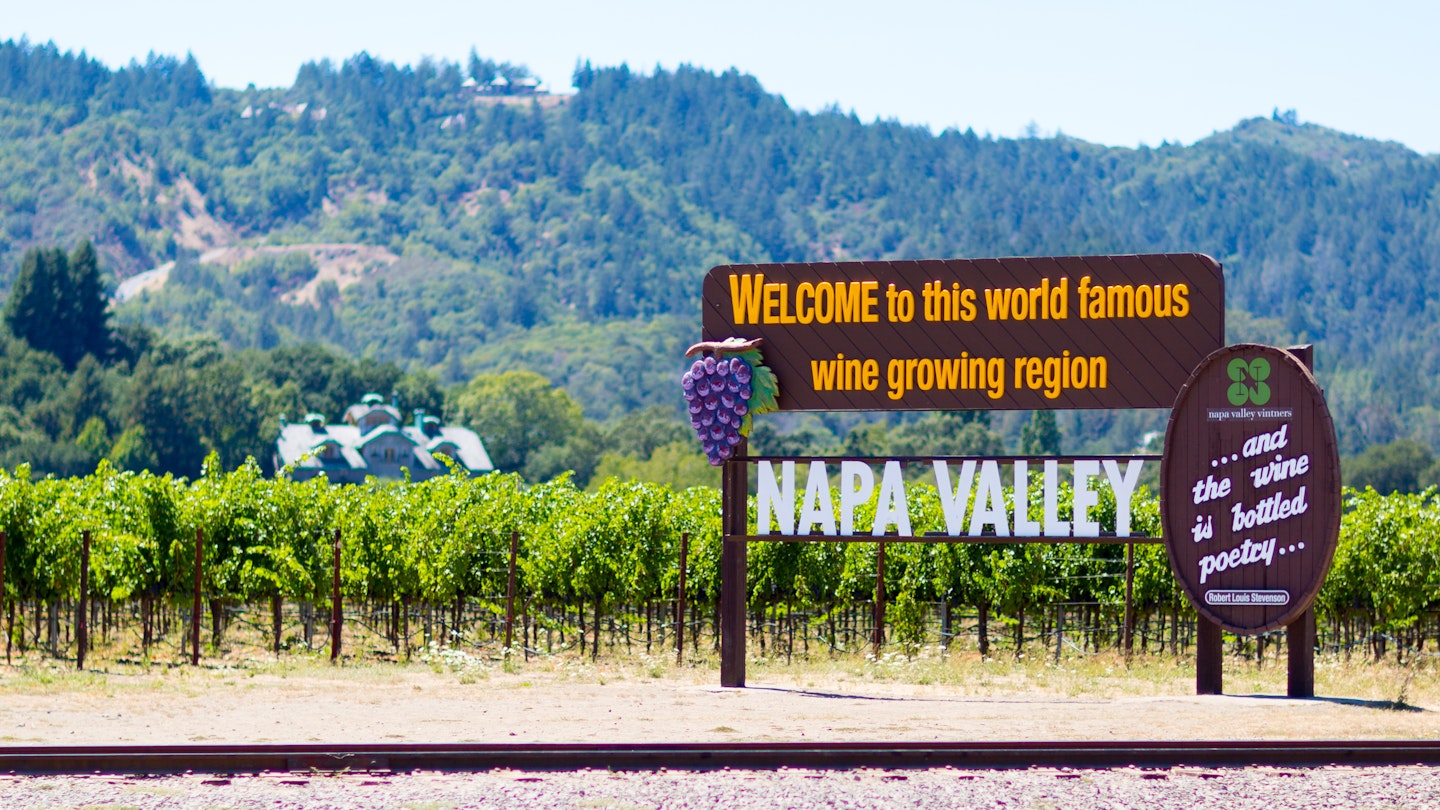
Get to know Napa Valley with our first-timer's guide © Cassiohabib / Shutterstock
Napa Valley is synonymous with luxury. Posh hotels, chef-driven restaurants and extravagant tasting fees cemented that reputation decades ago.
But at its core, Napa is farm country— a place where people dig in the dirt and make a living from the land. Despite all odds, this gives Napa a grounded feeling, even in its swankiest spaces. At the end of the day, visitors come to Napa Valley because they love food, wine and beautiful scenery. It’s a passion shared by the community of this incredible locale.
The five towns of Napa Valley (St Helena, Yountville, the city of Napa , Calistoga and American Canyon) are home to 16 wine appellations and more than 400 wineries. The options can be daunting to first-time visitors but we’re here to help. From mud baths in Calistoga to tips for visiting wineries, our first-timer’s guide to Napa Valley will give you everything you need to know to plan a trip here, including the best hotels, wineries, restaurants and activities.
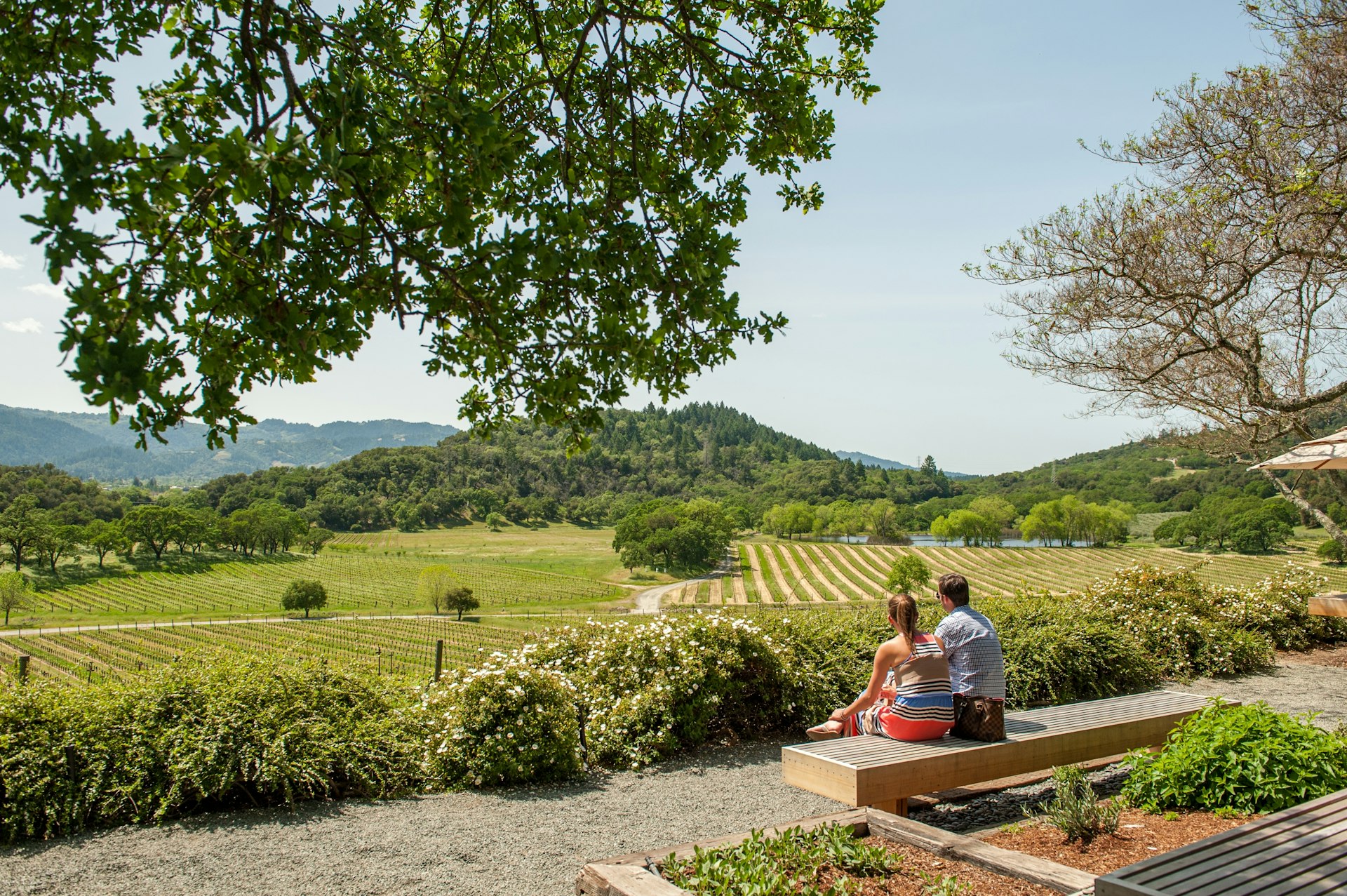
When is the best time to visit Napa?
It’s always a good time to visit Napa in our book, however, the timing of your trip will impact your experience. Peak tourist season is in summer when the average high temperature is 82°F. If you plan to visit this time of year, you’re unlikely to find any bargains. Make your reservations for lodging, restaurants and wineries as far in advance as you can.
Spring and fall are the next busiest times of the year. Spring brings average high temperatures of 68°F while in fall, high temperatures average 78°F. The lower, but still pleasant, temps are especially appealing for visitors who plan to hike, bike or engage in other outdoor activities.
Winter temperatures reach an average high of 60°F. This season gets the most rain (although this is California so there will still be plenty of dry, beautiful days). Since winter is the least crowded, it is the most affordable time to visit Napa with many hotels, resorts and spas advertising special packages and discounts off their regular rates.
How much time should I spend in Napa?
Set aside three to four days for your Napa Valley itinerary. This allows enough time to visit your top wineries and restaurants, plus time for other activities like spa treatments, hiking, lounging by the pool or riding the wine train.

What are the top things to do in Napa Valley?
Most people come to Napa to visit wineries – more on that later – but don’t overlook Napa’s exceptional culinary, wellness and recreation opportunities.
You can get filthy (in the best possible way) at the north end of the county in Calistoga. Calistoga is recognized around the world for mud made with a mixture of mineral-packed volcanic soil and water drawn from local hot springs. The two most common treatments involve painting it on your body or soaking in a tub of warm, nurturing mud. At least seven spas offer Calistoga mud experiences including the luxurious Spa Talisa at the Four Seasons Resort and Residences and the do-it-yourself mud bar at MoonAcre Spa and Baths .
Calistoga is also home to two of Napa Valley’s most unique natural attractions. The Old Faithful Geyser is a smaller, but still impressive version of Yellowstone’s most famous jet spout . In Calistoga, Old Faithful shoots hot water 30–80ft towards the sky every 10 to 20 minutes. Just outside of Calistoga at the Napa/Sonoma border, a three million-year-old petrified forest with 1.5 miles of hiking trails provides a fascinating glimpse at geological history.
No trip to the valley would be complete without a trip to downtown Napa’s Oxbow Public Market , a 40,000-sq-ft marketplace packed with locally sourced culinary delights. From California-grown olive oil at the Olive Press to artisan cheeses at the Oxbow Cheese and Wine Merchant , this is the place to stock up for a picnic or edible souvenirs. You’ll also find a bookstore, distillery, bakeries and restaurants. After you’ve finished browsing, find a seat on the riverfront deck out back to sample fresh oysters on the half shell from Hog Island Oyster Bar .
With menus centered around locally-grown ingredients, Napa is almost as famous for fine dining as it is for wine. Food this fresh is revelatory. A dish, such as fermented soy dip served with raw vegetables pulled from the ground at the Charter Oak , will ruin you forever for grocery store veggies. Other bucket-list dining experiences include the six-course prix-fixe chef’s tasting menu at La Toque , the daily tasting menu at the French Laundry , and Kenzo Napa , where seafood is flown in daily from the finest fish market in Japan. Please note that reservations at these restaurants are coveted, and should be made as far as possible in advance.
Don’t let these vaunted names fool you into thinking you need to spend a fortune to get a good meal in Napa. The valley is filled with scores of reasonably-priced restaurants including Heritage Eats in Napa where you can feast on comfort foods like a smoked ham bowl or white cheddar mac and cheese for less than $15 a person. For tasting menus, Thomas Keller’s ad hoc offers a daily tasting menu currently priced at $56 a person for lunch or $69 a person at dinner. The Gate House Restaurant at the Culinary Institute of America offers three courses prepared by student chefs for $35 at lunch or four courses for $45 at dinner (please note that restaurant prices are always subject to change).
For nightlife, the Blue Note Napa Jazz Club hosts an exciting mix of live performances ranging from household names to rising stars and tribute bands. It also holds the Summer Sessions outdoor concert series and the Black Radio Experience at the Meritage Resort and Spa . If you’re on the hunt for a good dive bar, Ana’s Cantina in downtown St Helena is the place for a game of pool, tunes from the jukebox and a stiff drink.
Other top activities in Napa Valley include hiking or biking the 12.5-mile Napa Valley Vine Trail , which will eventually extend 47 miles from Vallejo to Calistoga.

Tips for visiting wineries in Napa
Gone are the days when you can walk into virtually any Napa Valley winery and ask for a tasting without an appointment (or even a fee). Although there are a few wineries like Hall Wines in St Helena, where walk-ins are welcome, reservations are required at most wineries in Napa Valley. This helps ensure the wineries have adequate time to guide you through your tasting. From the guest's perspective, appointments are helpful when it comes to budgeting, arranging transportation and planning your Napa itinerary.
The average wine tasting fee in Napa Valley is $40 per person but it isn’t unusual for prices to climb to $200 or even more. Most wineries have a menu of tasting options, with standard tastings at the low end and premium experiences with food pairings, library wines, or guided tours commanding a higher price. Please note that the tip is not included in the tasting price so it will need to be factored into your budget.
Expect to spend at least 90 minutes at each winery (often longer for premium experiences). For this reason, it’s best to stick to no more than two or three tasting room visits a day. We recommend clustering each day’s reservations in the same area so you won’t have to rush between wineries. For instance, in the Stag’s Leap District, Cliff Lede Vineyards and Baldacci Family Vineyards are only a mile apart. Cliff Lede’s Backstage Lounge Tasting Room Experience offers an elevated tasting with premium wines in a room filled with rotating art and rare rock memorabilia. At Baldacci, the Cave Tour and Tasting Experience includes a cave tour and barrel tasting followed by a seated tasting paired with seasonal appetizers.
In the Rutherford area, Sullivan Winery is only half a mile from the Prisoner Wine Company . At Sullivan, the Merlot Mastery Tasting starts with a tour of the gardens and grounds before moving on to a seated tasting with two flights of its prized merlot accompanied by light bites. At Prisoner, you’ll find many culinary pairings including the Wine and Dim Sum Experience.
Attire is wine country casual. A pair of nice jeans, golf shirts, sundresses or casual blouses are the norm in Napa Valley. Do wear comfortable shoes, especially if you plan to walk through the vineyards or participate in a tour.
Expert tip: The Covet Pass offers complimentary tastings at seven Napa wineries and seven Sonoma wineries, plus additional discounts for a one-time fee of $150.

How to get around in Napa without a car
Napa Valley is 30 miles long and stretches at most 5 miles wide. In this sense, Napa is small and easy to navigate, but driving can be tricky in a destination centered around wine. Luckily, if you don’t have a designated driver there are several ways to get around Napa without a car.
The Napa Valley Wine Train offers several tasting journeys including a 36-mile roundtrip through gorgeous scenery to disembark for seated tastings at Charles Krug Winery and V. Sattui Winery . A four-course lunch is served onboard. You can also hitch a ride to three tasting rooms in an open-air San Francisco cable car on the Napa Valley Wine Trolley .
Many tour operators provide transportation to Napa wineries. Several, like Napa Valley Wine Country Tours , offer a choice between public group tours, which are less expensive, or private tours with a customized itinerary.
If you prefer to get around by foot, base yourself in the cities of Napa or Yountville. Napa has more than 50 downtown tasting rooms and there are 14 walkable tasting rooms in downtown Yountville.
Where to stay
If there was ever a place to treat yourself to a nice hotel, it’s Napa Valley. The region is home to some of the best hotels in the country, with grounds and accommodations so astonishingly beautiful you might not want to leave to go wine tasting (but definitely leave to go wine tasting). If you’re in the position to splurge our top picks are:
The Poetry Inn is an exclusive property with only five guest rooms and a small, on-site spa. The all-suite hotel is the epitome of privacy and luxury with huge guest rooms featuring private sitting areas, outdoor patios, and indoor and outdoor showers with stunning hillside or vineyard views. A gourmet multicourse breakfast is included with each stay. Poetry Inn is the only hotel in the Stag Leap district.
Meadowood Napa Valley in St Helena is set on a magnificent 250-acre estate with mature, oaks and native plants surrounding 36 suites and guest rooms with soaking tubs and private outdoor sitting areas. Hiking trails, tennis courts, swimming pools, a Wine Center and a tranquil spa ensure you’ll never lack activities during your stay.
Carneros Resort and Spa offers standalone cottages and homes surrounded by rolling hills and vineyards in Napa. Amenities include a luxurious onsite spa, two swimming pools, pickle ball courts with an adjacent Veuve Clicquot Champagne Bar and Lounge, a complimentary buffet breakfast, and access to Cadillac Luxury Vehicles during your stay.
If a mid-range hotel is better suited for your budget we recommend the Meritage Resort and Spa or Silverado Resort . The Meritage offers perks like a complimentary shuttle service to downtown Napa and a verdant lawn surrounded by tasting rooms and an upscale market. At the Silverado Resort, amenities include golf courses, bocce ball courts, a pool and a fitness center.
The most affordable lodging options in Napa Valley are generally found in American Canyon, which offers several reliable, reasonably-priced chains such as the DoubleTree by Hilton Napa Valley American Canyon and Holiday Inn Express and Suites Napa Valley American Canyon .

My favorite thing to do in Napa
When I come to Napa I love to take a class to enhance my appreciation of food and wine or learn a fun, new skill. I’ve never been anywhere else where classes are so varied and accessible, so I take advantage whenever I can. Often, these classes are offered directly through my hotel. The Wine Center at Meadowood Napa Valley runs classes ranging from introductory tutorials on Napa wine to advanced courses on subjects like the history of the wine label. Carneros Resort and Spa has a dazzling array of daily classes focusing on everything from sabering champagne bottles to pickleball.
The Culinary Institute of America is my hands-down choice for cooking classes with options for group or private instruction. I’ve also found classes offered at Napa Valley wineries. Bouchaine Vineyards regularly hosts an exciting roster of sessions on topics like pairing wine and cheese, blending wine and even falconry.
How much do you need to budget for a trip to Napa?
The amount you’ll need to spend on a trip to Napa is highly variable depending on your itinerary and even the season you choose to visit. Although it is generally considered a luxury destination, you can still plan an affordable trip to Napa with the tips and tricks in this first-timer’s guide. The numbers below are not definitive but will provide a general idea of how much it costs for budget-conscious, midrange, and luxury travelers to visit Napa.
- Hotel room for two: $100–1200 a night
- Rental home/Airbnb for two: $200–1000 a night
- Wine tasting fees: $25–250 per person at each winery (not including tip)
- Lunch for two: $30–100 per person
- Dinner for two: $100–300 per person (or more)
- Glass of wine: $13–50
- Bottle of wine: $108 average
- Group shuttle to wineries: $125 per person
- Private transportation to wineries: $600 (and up)
- Spa treatment: $100–400 per person (and up)
Explore related stories
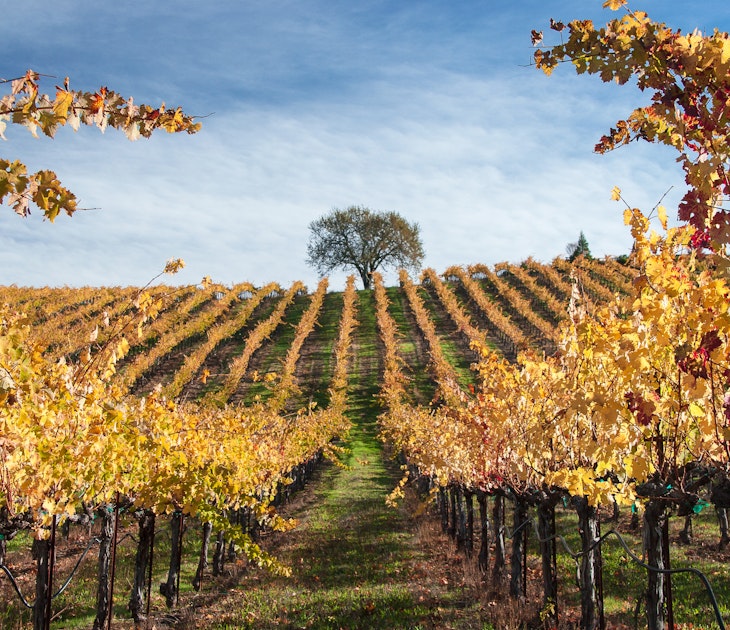
Destination Practicalities
Apr 30, 2024 • 13 min read
Sonoma County is home to 19 distinct wine regions and many different valleys. Here's what you need to know.

Apr 17, 2024 • 6 min read

Sep 14, 2023 • 5 min read
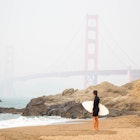
Sep 13, 2023 • 4 min read

Sep 11, 2023 • 8 min read
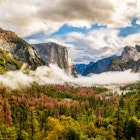
Jun 2, 2021 • 9 min read
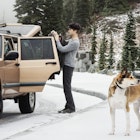
Apr 2, 2024 • 8 min read

Apr 11, 2023 • 9 min read
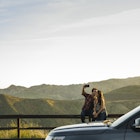
Oct 8, 2021 • 5 min read
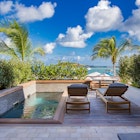
Sep 8, 2020 • 5 min read
PIP changes: Everything you need to know if you receive disability benefit
The government is looking at changing who is eligible for PIP, how decisions on it are made and the method by which recipients are compensated.

News reporter
Wednesday 1 May 2024 13:19, UK

The government has opened a consultation on the disability support system PIP (Personal Independence Payment), meaning eligibility criteria and other aspects of it could change.
Proposed changes come as part of the prime minister's pledge to reform the welfare system if the Conservatives win the next general election .
The criteria for getting PIP could change, as could the types of payments received by those who are eligible.
But what is PIP, who is able to get it, what is the government planning to change and who would be impacted?
Here's what you need to know.
What is PIP?
PIP is a tax-free payment given to people to help with the extra costs caused by long-term ill-health or disability.
More from UK

Hainault stabbings: Schoolboy killed in sword attack named as Daniel Anjorin - as family pays tribute to 'wonderful child'

Hainault stabbings: Police update on 'horrifically serious' injuries suffered by officers in sword attack

Manchester's Co-op Live arena cancels opening event minutes before start time
There are two parts to it:
- A daily living part - for those who have a long-term physical or mental health condition or disability
- A mobility part - for people who have difficulty doing certain everyday tasks or getting around.
It's possible to meet the criteria for one part or both parts, and payments vary for each.
Those who qualify for the daily living part are given either a lower rate of £72.65 per week or a higher rate of £108.55, and those who qualify for the mobility part either receive £28.70 or £75.75.
Who is currently eligible?
People aged between 16-64 can get PIP regardless of whether they work if they expect their difficulties to last for at least 12 months from when they started.
Those who have been told they may have 12 months or less to live can also apply and may get PIP more quickly.
Sufferers of both physical disability and cognitive or mental health conditions like anxiety can meet the criteria for both types of PIP.
There is no list of medical conditions that determine who qualifies for PIP. Instead, applicants are assessed on the level of help they need with specific activities.
For the daily living part, people might need help with things like:
- Preparing food
- Eating and drinking
- Managing medicines or treatments
- Washing and bathing
- Using the toilet
- Dressing and undressing
- Socialising and being around other people
- Talking, listening and understanding.
For the mobility payments, there is assistance for things like:
- Working out a route and following it
- Physically moving around
- Leaving your home.
How does the government make its decisions?
The Department for Work and Pensions (DWP) carries out an assessment to work out the level of help a person should receive.
A person's needs are judged on a points system whereby the more severe the impact in a particular area and the greater the help that is required, the more points a person gets and the more money they receive.
For example, an applicant will get two points on the daily living score if they need to use an aid or appliance (like a prostheses or easy grip handles on utensils) when cooking a meal, or they will get eight points if they cannot prepare food or cook at all.
Similarly for the mobility score, the applicant will get four points if they can stand and move between 50 metres and 200 metres, and 12 points if they can only move between one metre and 20 metres.
The answers are assessed by health professionals who then provide a report for DWP case managers with recommendations on what to give the applicant, if anything.
Applicants can provide assessors with additional medical evidence as part of a claim, but it is not a requirement, as a person's self-assessment about the impact their condition is prioritised when making a decision.
What does the government want to change?
It is looking at changing PIP in a number of ways, potentially affecting those who are eligible for it and the type of help those who are granted it will get. Below we summarise the key points in the consultation:
Different assessment model
The government is looking at introducing a new assessment model based entirely or partly on the diagnosis given to an individual.
It says it is considering whether "evidence of a clinical diagnosis made by a healthcare professional could provide a more objective assessment of need" than a self-assessment.
In other words, decision makers may look at what clinical diagnoses people have rather than asking applicants how it affects their lives.
Eligibility reform
This is an alternative to changing the assessment model.
The government says it may keep the current assessment, but change the questions so that they are less repetitive and to "ensure they are working as intended".
"Our aim would be to ensure that the criteria are fair and that we focus support on people with the highest needs and significant ongoing extra costs," the government states.
The government is also considering looking at changing the length someone needs to have been suffering for due to their disability before they become eligible for PIP, because "we know many people who have short-term illnesses can make a full recovery".
"We also know that during the early phase of an illness or condition, it is difficult to understand the full impact the condition will have on you," it says.
It has not specified the length of time this would change to. As it stands, people have to show that the negative effects of their condition have been present for three months before applying and that they are likely to last for another nine months after PIP is first given to them.
Changes to payments
In the current system, PIP claimants are given monthly cash payments which they can use as they see fit, whether that be things like aids and mobility devices, covering increased energy costs due to special equipment or paying higher premiums due to their condition.
The government says claimants often use the money for common household costs or some "view their PIP award as compensation for being disabled rather than as an award for extra costs".
With this in mind, the government is considering the following alternatives to cash transfer:
- Catalogue/shop scheme - where there would be an approved list of items from which disabled people could choose items at reduced or no cost
- Voucher scheme - where disabled people could receive vouchers to contribute towards specific costs
- Receipt-based system - where claimants buy approved aid, appliances or services for themselves and then provide proof of purchase to claim a contribution from the government
- One-off grants - a contribution to specific, significant costs such as for home adaptations or expensive equipment.
Aligning support
The government is considering merging PIP with the existing support people with disabilities get from the NHS and their local authorities.
This would mean instead of going through a separate PIP assessment, it would be linked with local support networks. The consultation does not go into detail about how this might work.
Why does the government say it wants to change PIP?
It says PIP caseloads and costs are "spiralling" as there are now 2.6 million people of working age claiming it.
There are 33,000 new awards for PIP each month, which it says is more than double the rate before the pandemic.
In its proposal, the government adds: "This is expected to cost the taxpayer £28bn a year by 2028/29 - a 110% increase in spending since 2019.
"This is in part fuelled by the rise in people receiving PIP for mental-health conditions such as mixed anxiety and depressive disorders, with monthly awards doubling from 2,200 to 5,300 a month since 2019."
It says its main three priorities through making changes are:
- Providing the right support to the people who need it most
- Targeting our resources most effectively
- Supporting disabled people and those with long-term health conditions to live independently and reach their full potential.
Announcing the consultation on 29 April, Work and Pensions Secretary Mel Stride told the Commons: "This government's priority is to make sure that our welfare system is fair and compassionate. Fair on the taxpayer, by ensuring that people of working age who can work, do work, and fair on those who are in most need of the state's help.
"We know that any additional cost arising from a disability or health condition, which PIP is intended to help with, can vary significantly and is unique to the individual circumstances."
He argued that changes to the current "one-size fits all" system will offer "bespoke support tailored to individual needs".
What do critics say?
Some believe the proposed changes are going to target people with mental-health problems and stop them getting PIP, and they have not been encouraged by the fact the government has not specified which conditions would be eligible for PIP under reforms.
Mr Stride suggested to the Times that people with "milder mental-health conditions" would no longer receive financial support, adding talking therapies, social care packages and respite care could be used as alternatives.
James Taylor, the executive director of strategy at disability equality charity Scope, called for an end to the "reckless assault" on disabled people and to fix the "real underlying issues".
"It's hard to have any faith that this consultation is about anything other than cutting the benefits bill, no matter the impact," Mr Taylor said.
The Disability Benefits Consortium (DBC) branded the consultation "cynical and cruel".
Speaking on behalf of DBC, Ceri Smith head of policy at the MS Society, said: "If the government truly wants a 'stronger, healthier and fairer society', they should start by addressing NHS waiting lists and fixing social care. Instead, this approach will punish disabled people and push even more into poverty."
How can I have my say?
You can view the consultation, which is open until 23 July, here .
Once you have read it, you can respond online via the government's form or by emailing [email protected]
The Rick Steves guide to life
Travel mogul. philanthropist. legal weed champion. the real rick steves is so much more complex than who you see on tv..

EDMONDS, Wash. — At first glance, it is hard to tell that Rick Steves is protesting.
In the center of his hometown, America’s favorite travel host is perched on the edge of a fountain roundabout engaging in some friendly civil disobedience. As cars circle the intersection, Steves smiles and waves, looking more like an Elf on a Shelf than an angry picketer. This is his way of reminding people he wishes they’d stop driving here.
Steves’s family moved to Edmonds when he was 12, and the 68-year-old is still happy to call it home. Rather than relocate to his beloved Europe, he dreams of bringing some European sensibilities to the edge of the Puget Sound, less than 20 miles north of Seattle.
When he’s not traveling around Europe, writing about Europe or running his multimillion dollar European tour company, the prolific TV host and author likes to squeeze in some local activism. The roundabout routine is his push to block off Edmonds’s very American Main Street for pedestrians. If you squint at it, you can see what Steves sees: this would be the perfect place for a lively town square.
“I like a lot of things about Europe but I love the urban energy of Europe. I love the piazza,” Steves said in a wistful tone you might recognize from PBS. “We don’t have a piazza.”
Unfortunately for Steves, the voting majority of the city does not love the idea of parking their SUVs farther away to shop. So despite his Boy Scout enthusiasm, the most famous man in Edmonds must keep up the perch-and-wave. This is not his only crusade.
Spend any amount of time with Steves, and you’ll encounter a total ham who loves a zany bit. But if you ask him about serious issues like car-free zones, he’ll bring up other causes that are dear to him: affordable housing, supporting the arts, creating senior centers for the elderly to age with dignity.
He’s anti-Trump and pro-cannabis. He does not care if that is bad for business.
The average Rick Steves fan has likely missed this side of him. On TV they see an always-sunny history lover who makes going abroad feel approachable for the average American. That’s an incomplete picture, like thinking you know Paris because you’ve seen the Eiffel Tower on YouTube.
Meet him in Edmonds, and he’ll fill in the rest.
It may look like a lot of gallivanting, but being Rick Steves takes a lot of work.
He spends three months of the year overseas, researching, writing, recording, refining tours, updating guidebooks. If he’s not planning or producing content, he’s often doing promotional events across the United States. This year Steves is celebrating the 40th edition of his first book, “Europe Through the Back Door.” Over the course of his career, he’s built a privately held company that generates $120 million in revenue a year, published 110 books, filmed 12 seasons of “Rick Steves’ Europe” and produced more than 750 podcast episodes.
“It’s just like coordinating a three-ring circus,” Steves said.
That is: really fun, sort of exhilarating and extremely complicated. To pull this off, Steves does not observe the French 35-hour workweek. He’s a workhorse with a reputation for keeping a frenetic pace year-round.
“It’s more of an American work culture,” Amy Duncan, Steves’s communications director, told me. “He’s an unapologetic capitalist but he is also a socialist.”
He makes enough money to fly first class, but he only sits in economy, claiming he doesn’t mind being cramped.
“It never occurred to me that I’m suffering,” he said. “As long as I’ve got an aisle and a seat that reclines, I’m happy.”
Actually, Steves believes airlines should only have one class. It’s part of his egalitarian worldview. He’s also anti-points and anti-miles, refusing to sign up for airline loyalty programs because he believes they bully us into complicating our lives.
Steves also enforces a self-imposed “ carbon tax ” on his tour company, which takes more than 30,000 people to Europe annually. For every customer, Steves invests $30 to atone for emissions created by their flights between the United States and Europe. Last year, that added up to $1 million donated to a portfolio of organizations, Steves said.
“I don’t need to be a slave to the quarterly profit statement. I want to be around and profitable in 10 years from now in a world that you can travel in that’s stable,” Steves said. “This is a smart investment and it’s an ethical expense that I should pay for.”
Rick Steves will tell you he’s motivated by making money; the more he can earn, the more good he can do with it.
“Vicarious consumption, that’s one of my things,” Steves said.
After amassing a windfall from the 2001 George W. Bush tax cuts for high earners, Rick Steves donated $1 million to support the local symphony and performing arts center. In 2005, he used retirement savings to buy a 24-unit apartment complex for the local YWCA’s use as transitional housing for women and children. He figured he’d eventually sell the complex and live on the earnings. About a decade later, he changed his mind and donated the complex valued at $4 million.
He also gave more than $4 million to help build the Edmonds Waterfront Center, a vibrant gathering place for seniors where his daughter had her wedding in 2021. And he gave another $2 million for a similar center in the nearby city of Lynnwood, which broke ground in mid-April .
“Rick puts his money where his mouth is,” said Nancy Leson, a former Seattle Times food critic who used to let Steves’s daughter babysit her son. She’s appreciated his regular presence in the community, like hosting events for local politics at his house and shopping at the farmers market .
“He changed travel,” local resident Karen Howe said on her way into the Waterfront Center with a friend. She’s used Steves’s guidebooks for years. “He’s introduced us to places that most of us would never think of going.”
Rick Steves hasn’t won his piazza battle, but he has brought European touches to Edmonds. At the Rick Steves’ Europe headquarters, there’s an E.U. flag hanging from the mocha brick facade. And gargoyles that drain rainwater, just like at the Notre Dame cathedral.
“Gargoyles scare away evil spirits,” Steves points out, unable to suppress his inner tour guide.
Here Steves employs more than 100 people: editors, audio producers, tour specialists and cartographers such as Dave Hoerlein, his first employee. That’s excluding the fleet of guides and drivers he contracts across the pond to shepherd tour customers.
Inside, he bounds through a maze of cubicles, his neck craned forward, always at an eager pace. His 6-foot frame appears leaner than previous seasons of his life, but his signature look is familiar. No, not khakis and a button-down. That’s vintage Rick. These days, he wears dark jeans and a button-down, plus a thin scarf and leather sneakers.
During a day of meetings, Steves’s fjord-blue eyes lit up at the minutia of the business. He went over new maps with Hoerlein. He and longtime co-author Cameron Hewitt addressed problems like finding a “less glitzy” stop on the Amalfi Coast that’s not Sorrento. They discussed whether a place is worth visiting after it’s gotten too popular, and Steves indulged in some gallows humor.
“It’s going to be like holding the corpse of a loved one who just died,” he said.
His critics argue the “Rick Steves Effect” can turn a charming village, restaurant or museum into a tourist magnet. Matthew Kepnes, the travel writer behind the blog Nomadic Matt , points to the Swiss town Zermatt, which he says Steves put on the map, and has since dealt with overtourism . You’re bound to bump into groups with Rick Steves guidebooks in Italy’s increasingly crowded Cinque Terre.
Whether Steves is actually to blame for changing a place is up for debate. There are plenty of destinations he’s covered that haven’t been inundated with swarms of Americans (see also: Gdańsk).
Steves says he assesses whether a place wants tourism, if it can handle it gracefully. If they don’t or can’t, he may mention it but not promote it.
He has faith — maybe too much — that his clients share his values.
“Does [my work] change the personality of a town? It can. Am I a dramatic impact on Europe? No,” he said.
“There’s a handful of places I really promote aggressively that I’ve had a serious impact on, but otherwise ... my travelers are the kind of people that take only pictures and leave only footprints ... they’re good travelers.”
You don’t have to spend much time in Edmonds to see why Rick Steves never considered leaving.
The city — population roughly 42,000 — sits on a majestic inlet. You can get to a major international airport in about an hour. The community is so courteous, it has an “umbrella share” program in case people forget their own on a rainy day. As Steves walks around town, he greets people by name. He lives within walking distance to both his favorite diner and a pétanque court, the French answer to Italian bocce. He plays bongos at his church on Sundays.
In 1967, Richard “Dick” Steves moved the family here because he was worried about Rick Junior.
“I was hanging out with dangerous kids and going down the wrong trail,” Steves said. Seriously.
His dad, an Army veteran, got by in the upscale suburb as a piano technician and importer. When Steves was 14, his parents dragged him on a work trip to Europe to visit piano factories; it was a radical experience that sparked his lifelong passion for travel.
Back in Edmonds, Steves started teaching piano, eventually turning his savings into trips abroad of his own — not only to Europe, but Turkey, Nepal, Afghanistan. He went to college nearby, earning degrees in European history and business from the University of Washington, where he played in the Husky Marching Band.
After graduation, Steves figured he could keep up his routine: give piano lessons during the school year, then travel during the summer. He started teaching travel classes in the same recital hall where his piano students performed. This was back when there was no internet and few guidebooks to consult for trip planning.
The classes were a hit. At 25, Steves turned his lecture materials into a 180-page book, and self-published “Europe Through the Back Door,” in 1980.
Four years later, he hosted his first European minibus tour group, serving as both bus driver and guide.
His businesses have evolved — his bus tours now take up to 28 travelers, a number Steves says is a sweet spot between making the tour more affordable yet enjoyable for customers and profitable for the company. But his mission has remained the same: to be the best resource for European travel and help Americans travel better.
“I just focus on that and I love it,” he said. “It takes my life out of balance — which is not good — but it lets me do a lot of stuff that I believe in and that’s good.”
Steves has been open about the challenges of being a travel mogul. As he built his empire, he was also raising a family. Being “married” to both took a toll. In 2010, Steves and his wife, Anne, divorced after 25 years of marriage.
Up the hill from his junior high, Rick Steves’s modest beige home offers a window into his many lives. There are family photos on the walls, from older relatives to his baby grandson, Atlas. He hosts political fundraisers on the sprawling deck. A painting of Kerala, India, nods to one of his favorite countries (people forget Steves did four editions of “Asia Through the Back Door”).
Next to his grand piano, there’s a stuffed creature that Steves calls his “Silver Fox” baring its teeth and wearing novelty sunglasses with cannabis leaves on the lenses — a nod to two of his interests: taxidermy and marijuana activism.
“It’s the civil liberties … it’s the racism … everything about it is wrong,” he said of keeping weed illegal.
As for the toothy fox, Steves doesn’t do typical souvenirs anymore, but he makes an exception for stuffed animals.
“The wooden shoes and the pewter Viking ships are so obvious,” he said. “I like to do something a little more organic and a little more striking and it takes me back there — I like it.”
He’s a very good piano player. He can also play the sousaphone and the trumpet — which he did regularly during the pandemic, performing taps for his neighbors at sunset.
Covid-19 was a nightmare for the travel business, but a miracle for Rick Steves’s love life.
After running in the same social circles for years, he and Shelley Bryan Wee, a prominent local bishop, started dating at the end of 2019. They had a lot in common. Both are progressive Lutherans. Both are divorced with adult children. But neither worked a typical 9-to-5, and one of them spent three months of the year in Europe.
Then lockdown happened. Steves, who couldn’t remember if he’d ever had dinner in the same place 10 nights in a row, spent 100 nights at the same table with Wee. It solidified their relationship.
“Shelley is a constant,” Steves said. He still struggles with the balancing act between work and love.
When the stars align and they’re both in Edmonds, Wee cooks, and Steves plays sous chef. They walk Jackson, Wee’s labradoodle, creating their own version of the passeggiata, Italy’s traditional evening stroll. They play table tennis before dinner.
When the world reopened, they started traveling together. They’ve made time for a few big vacations: a trip to Morocco, where they were caught in a windstorm that blew the windows out of their car; a luxury barge cruise through Burgundy, France, “that was embarrassingly expensive,” Steves confessed, followed by a week hiking in the Swiss Alps; and another hiking trip between remote lodges on Mont Blanc.
Before their first trip, Steves edited the contents of Wee’s suitcase, because packing light is part of his philosophy.
“What do you say?” she asked. “You’re talking to Rick Steves.”
Editing by Gabe Hiatt. Additional editing by Amanda Finnegan. Design editing by Christine Ashack. Photo editing by Lauren Bulbin. Videos by Monica Rodman. Senior video producer: Nicki DeMarco. Design by Katty Huertas. Copy editing by Jamie Zega.
More travel news
How we travel now: More people are taking booze-free trips — and airlines and hotels are taking note. Some couples are ditching the traditional honeymoon for a “buddymoon” with their pals. Interested? Here are the best tools for making a group trip work.
Bad behavior: Entitled tourists are running amok, defacing the Colosseum , getting rowdy in Bali and messing with wild animals in national parks. Some destinations are fighting back with public awareness campaigns — or just by telling out-of-control visitors to stay away .
Safety concerns: A door blew off an Alaska Airlines Boeing 737 Max 9 jet, leaving passengers traumatized — but without serious injuries. The ordeal led to widespread flight cancellations after the jet was grounded, and some travelers have taken steps to avoid the plane in the future. The incident has also sparked a fresh discussion about whether it’s safe to fly with a baby on your lap .
- You can still find affordable flights to Europe this summer April 18, 2024 You can still find affordable flights to Europe this summer April 18, 2024
- See how jamón gets made in the heartland of Spanish pork April 16, 2024 See how jamón gets made in the heartland of Spanish pork April 16, 2024
- What to know about Schengen zone, Europe’s ‘border-free’ travel system April 3, 2024 What to know about Schengen zone, Europe’s ‘border-free’ travel system April 3, 2024

The 24 Best Travel Tote Bags for Your Next Big Trip
Whether it's your only bag or a carry-on supplement, a travel tote will take your packing game to the next level.
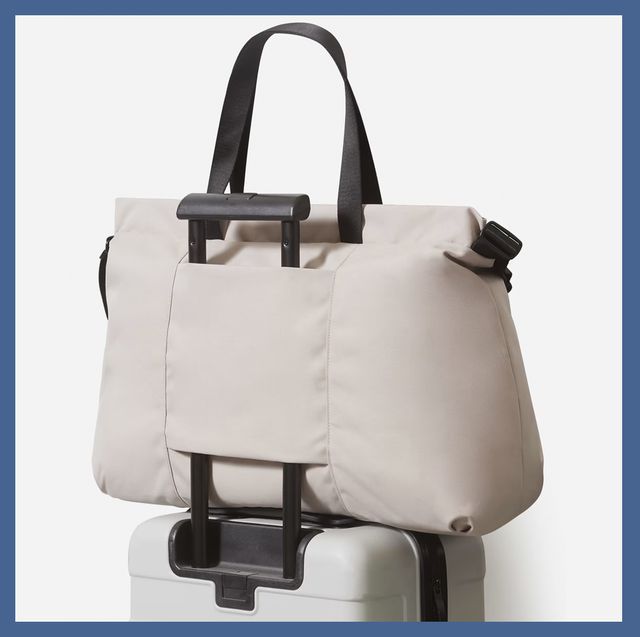
Every item on this page was chosen by a Town & Country editor. We may earn commission on some of the items you choose to buy.
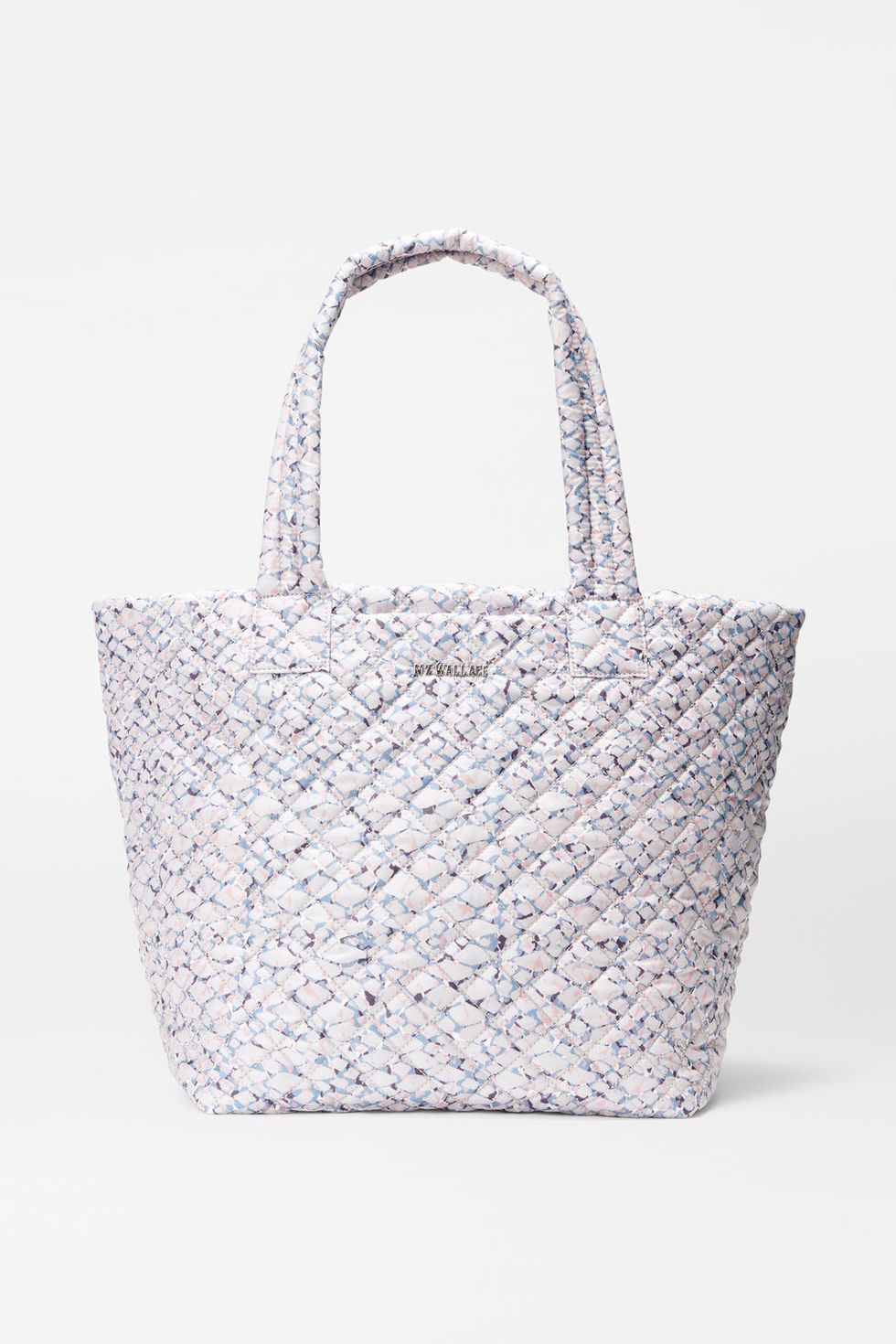
T&C Tried and True
Medium metro tote deluxe.

Separate Compartment for Organization
Lo & sons catalina deluxe tote.
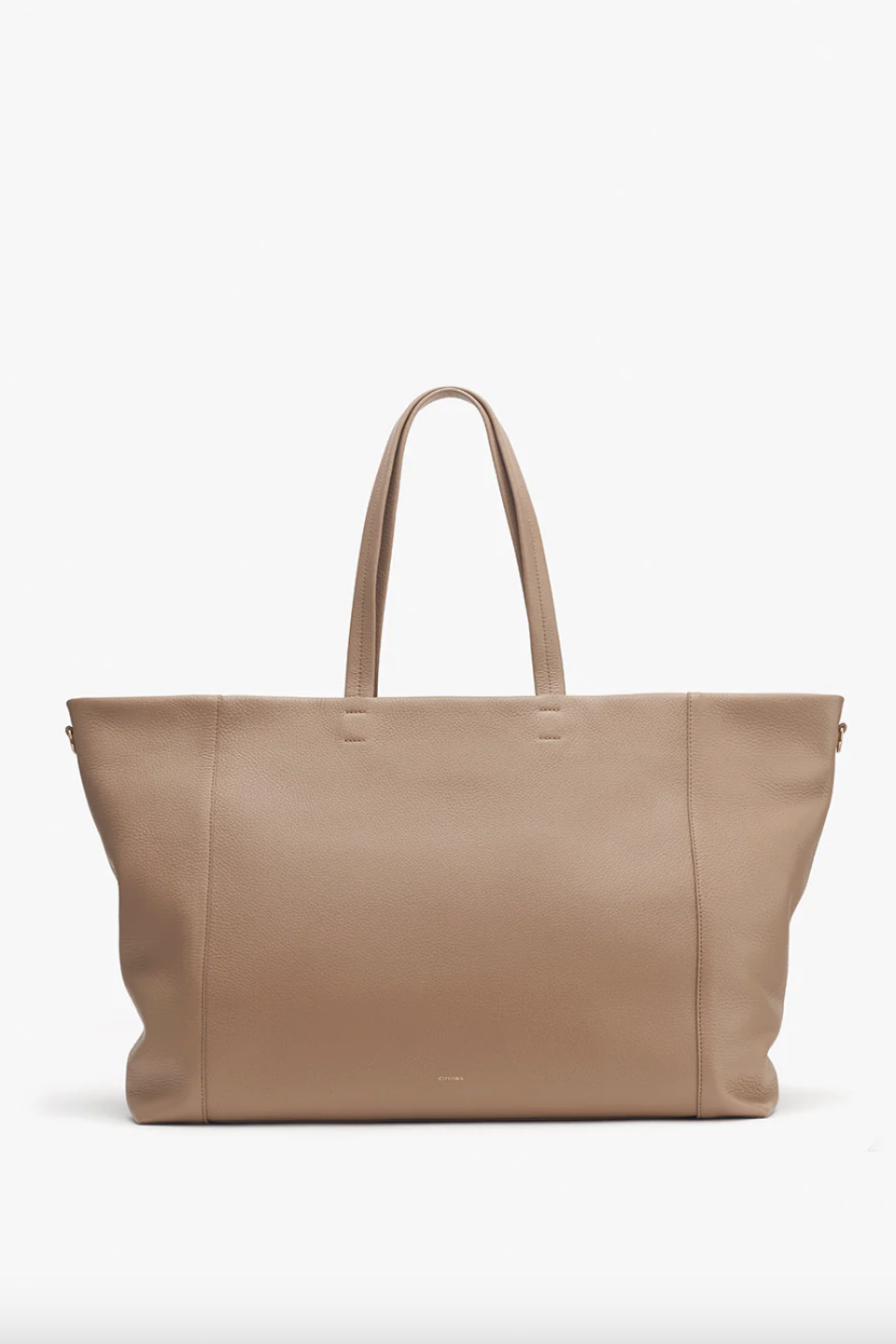
Luxurious Essential
Cuyana easy travel tote.
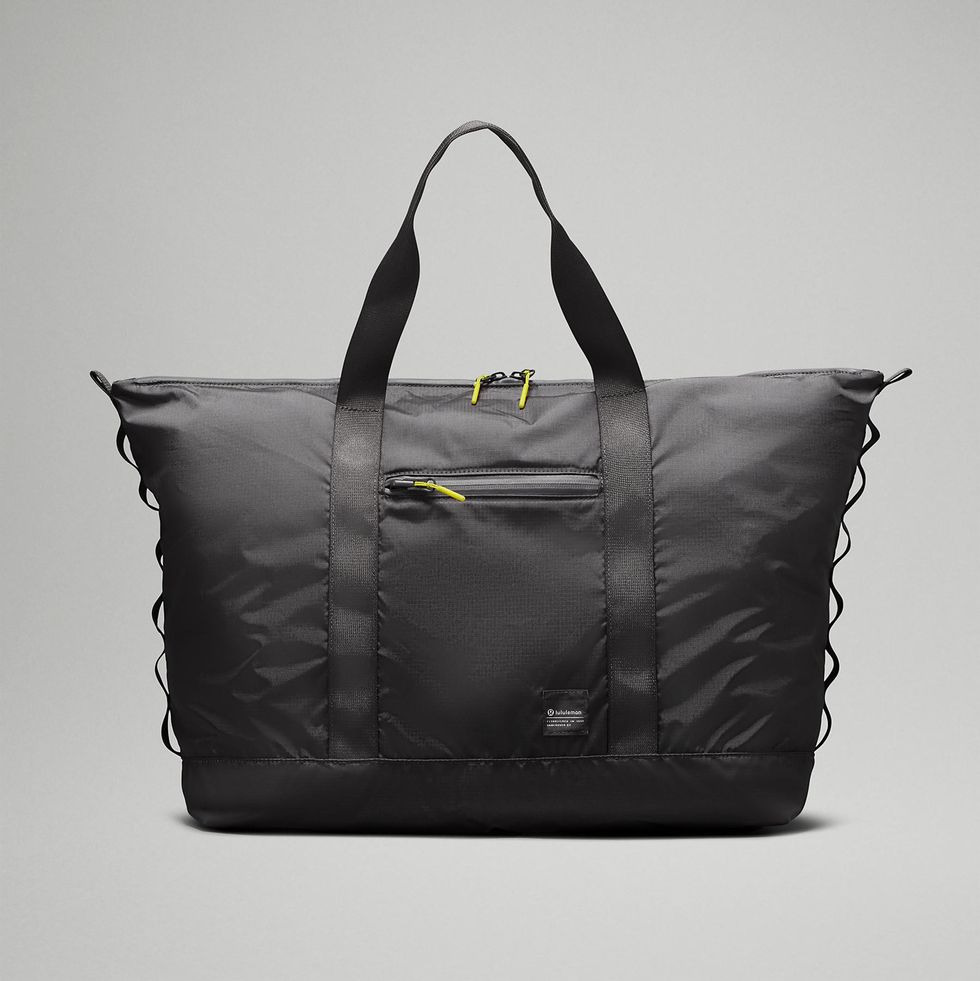
Folds Small for Easy Packing
Lululemon packable tote bag.
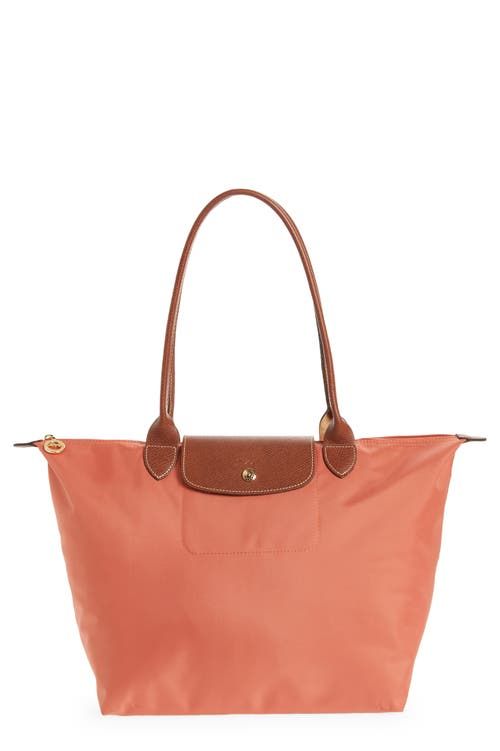
Classic Tote
Longchamp large le pliage tote.
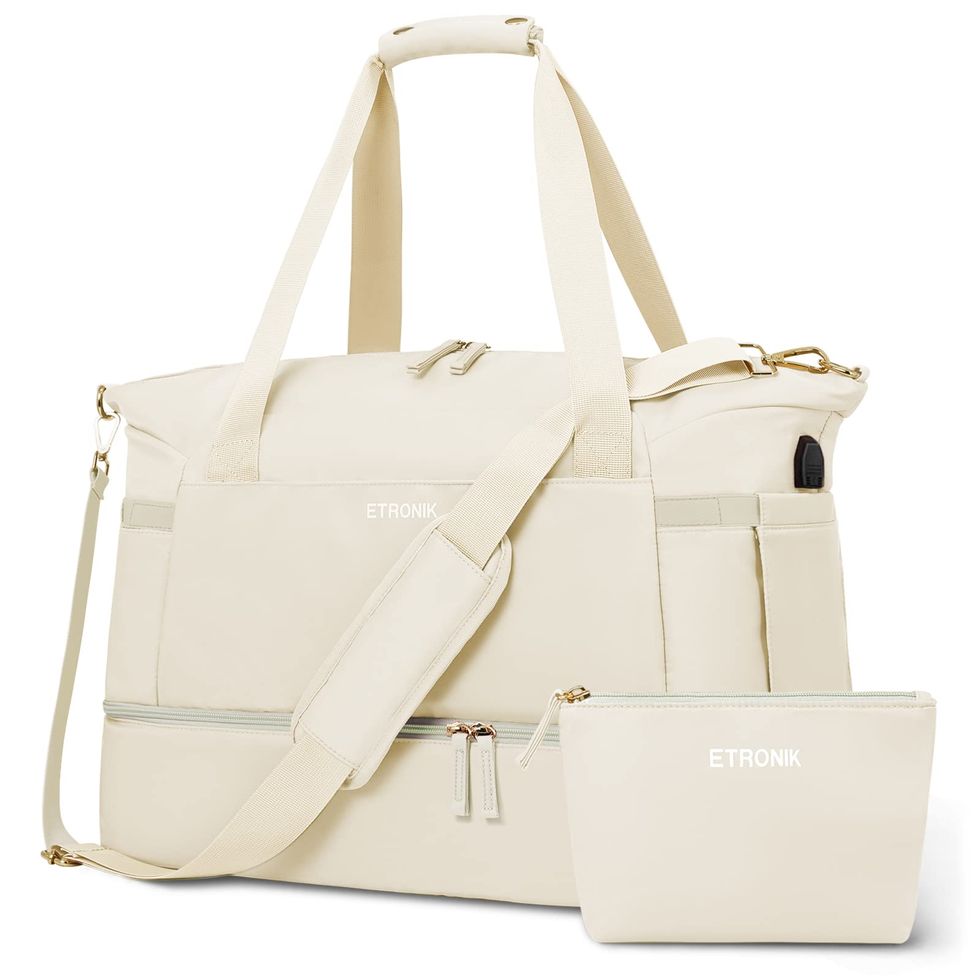
Everyday to Travel Tote
Etronik travel duffel bag with usb charging port.

Minimalist and Functional
The renew transit weekender.
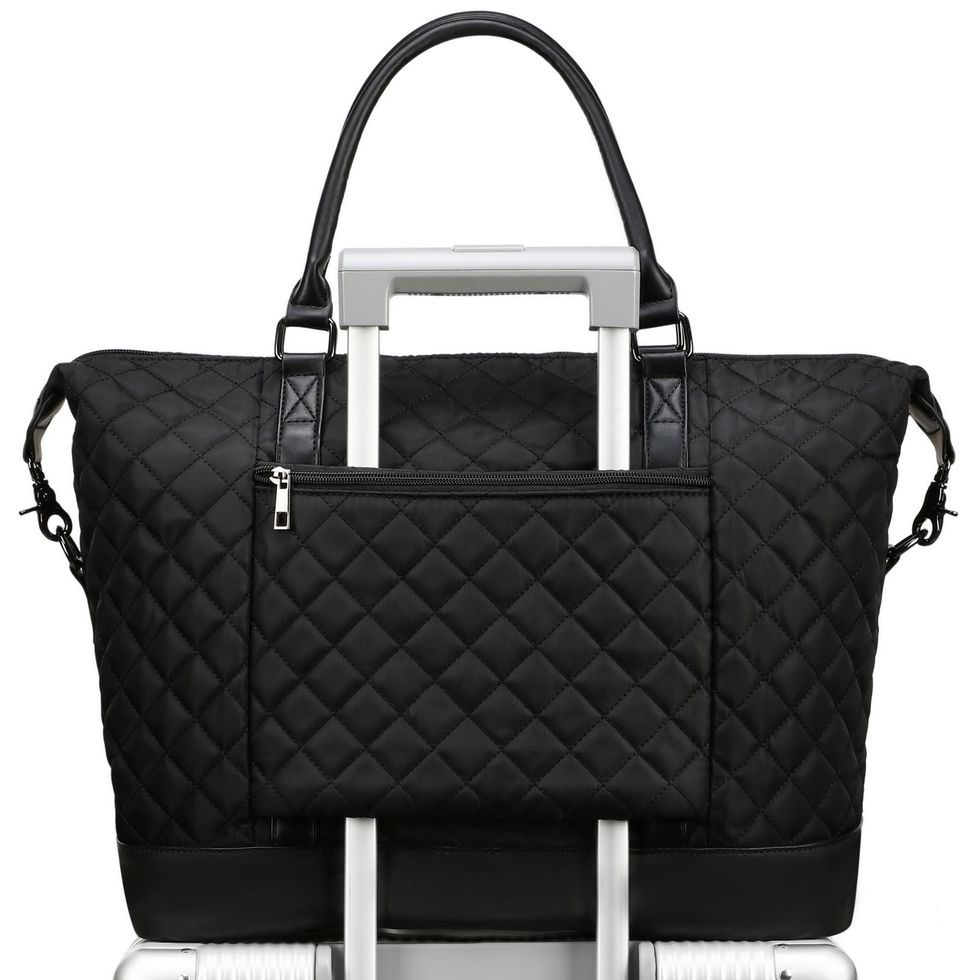
Bargain Bag
Bluboon travel tote bag.
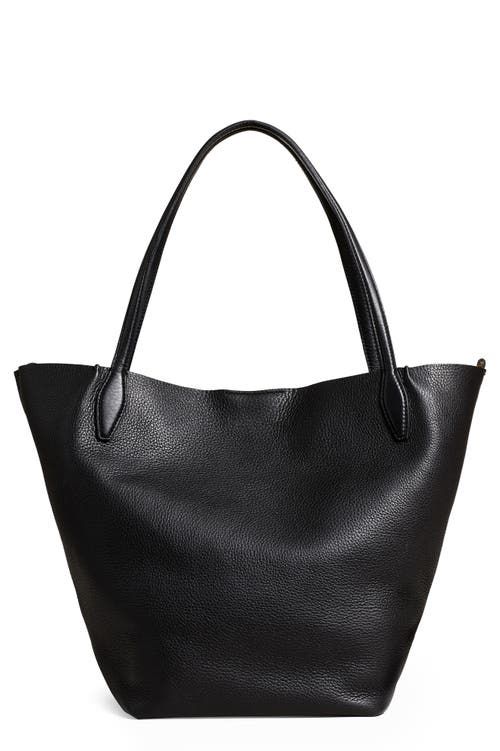
Madewell The Shopper Tote

Heavy Lifter
Boat and tote.
Whatever your travel needs for the season ahead, odds are that a good tote can make your packing life more organized, and less stressful—honestly, what more could you hope for? With that in mind, we've scoured the internet for the more durable, functional travel totes for every type of traveler, from the serial overpacker to the organization fiend. Here, our favorite finds for all of your journeys.
Perpetually trying to find space in your carry-on for one last thing? Meet what one T&C editor calls, "the personal item of every overpacker's dream." Featuring five exterior pockets, plus six on the interior and an detachably pouch, it will keep all of your travel essentials organized while it's sturdy-yet-lightweight construction makes it easy to tuck in "just in case" items to your hearts desire without overwhelming your arms.
The cushy, reinforced straps are easy on the shoulders, but it also has a detachable crossbody strap and a built-in sleeve to slip over the handle of your luggage if you don't feel like toting. It also comes in four sizes (we're fond of the medium for it's ability to hold oodles of stuff while still slipping neatly beneath the seat in front of you on a plane) and a seasonally-refreshed roster of more than a dozen shades, making it as stylish as it is functional.
Lo & Sons Catalina Deluxe Tote
For the "a place for everything and everything in its place" traveler, this tote has you covered with a zippered bottom pocket that's perfect for separating out toiletries or dirty shoes from the rest of your haul (an interior panel also allows you to open the bottom compartment fully, if you're craving a deeper bag.)
Available in recycled poly or sturdy canvas, at 15" x 14" x 7", it qualifies as a personal item for most airlines and has a handy luggage sleeve to pair with your suitcase. For those looking for larger options, it comes in four additional sizes as well.
Cuyana bags are a favorite of T&C editors and royals alike ( Meghan Markle is a big fan ) for their timelessly stylish silhouettes, buttery soft leather, and effortless functionality. This, their latest launch, is made specifically with travel in mind.
Crafted with lightweight, durable pebbled leather (currently available in four colorways) it offers ample interior space (a 37L volume, to be precise) plus two large pockets, a phone slip, and a key clip, as well as snaps for Cuyana devotees who want to mix in their System Flap Bag or System Zipper Pouch .
If you're more of a "shop when you get there" traveler, this bag brings the souvenir space without taking up lots of room in your primary bag. Water-repellant and roomy (it holds 32L by volume) it features rugged shoulder straps, plus an extra strap that lets it slip over the handle of roller luggage, and can fold into its own exterior pouch when not in use to make a tidy, handheld bundle.
Some things are classic for a reason. Case in point: this timeless Longchamp tote; just ask T&C 's associate shopping editor, Sophie Dweck, who's been carrying hers for over a decade . Made from sleek, easy-to-clean nylon that comes in a cornucopia of colors, it features a simple, spacious interior and strong leather straps that ensure it can stand up to anything your travels throw at it, and look good doing it.
Looking for a tote that's as useful in your day-to-day as it is when you're far away? This multi-use tote has racked up thousands of five-star reviews on Amazon for its versatility. A separate, vented shoe compartment makes it as friendly to gym sessions as beach trips, while its multiple pockets keep essentials organized. It also includes a luggage strap and a USB charging port so you can plug in your tech without rummaging through your bag for your battery pack, and comes in two sizes and almost 30 shades so it will match your travel style.
One reviewer writes: "I must say, it exceeded my expectations in every way! This bag is the perfect blend of style and functionality, making it a must-have for any woman on the go."
Type-A packers, take note: this 100% recycled polyester is all about options. Its four colorways can be worn crossbody, carried in hand, or over the shoulder, and include a zippered exterior pocket, a luggage sleeve, two water bottle holders, and a padded laptop sleeve—all with Everlane's signature modern minimalist vibe.
Available in 20 colorways and textures, this canvas tote features a luggage sleeve that also doubles as a tech pouch so your gadgets will always be at the ready. The sturdy construction and bargain price tag have made it a hit with reviewers, who site its roomy 16.5" x 9" x 14" size and comfort.
One reviewer writes: "I am so happy with this purchase! Reasonable price, large main compartment, and a few zip compartments to organize smaller items. Bag fits perfectly under airline seat, even when stuffed FULL. It stayed in place when I had it on top of my roller bag, and I noticed the shape of it kept it from making everything tip forward (which happened with my previous bag)."
For a travel bag that you can use as a purse all trip, this simple Madewell leather tote brings a perfect mix of style and space (12.75" x 12.75" x 7.5".) It even comes with an interior strap that allows you to change the shape, and doubles as a keyring.
True L.L. Bean lovers know that the brand's classic Boat and Tote bag is hard to beat—after all, it's been one of their signature styles since 1944. Crafted from rugged cotton canvas, it's tested to hold up to 500 pounds, so no matter how much you manage to overpack, this bag is guaranteed to take it on. And with four sizes and two interior lengths to choose from, as well as a dozen colors, there's a perfect one for all your needs.
Caraa Studio Tote
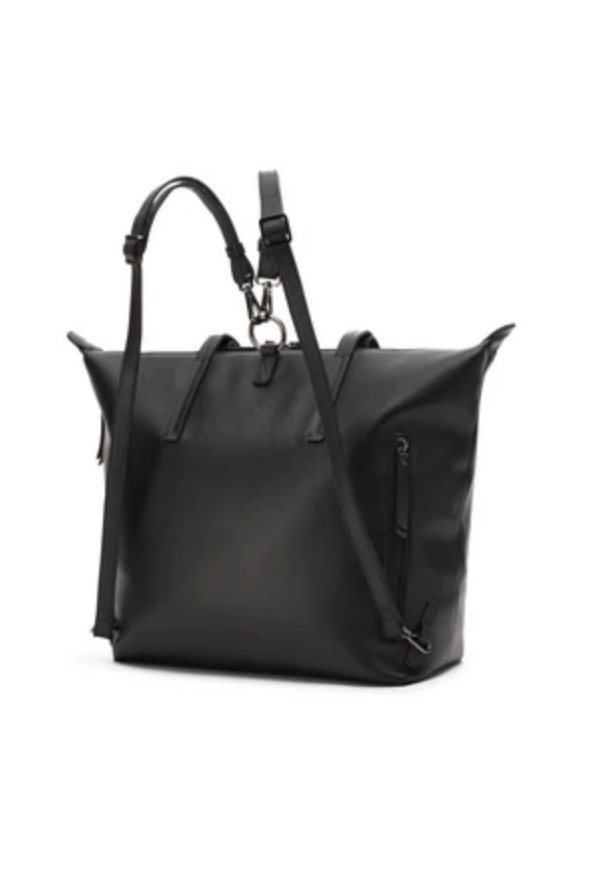
Whether you prefer a classic tote style or a backpack, this Italian leather bag gives you the best of both worlds. Along with the usual amenities (a slew of pockets, adjustable straps) it also has a collapsible waterproof shoe pocket for those days your travel plans call for a quick change.
More: The 18 Best Carry-On Travel Backpacks for Easy, Breezy Packing
Béis The Convertible Weekend Bag
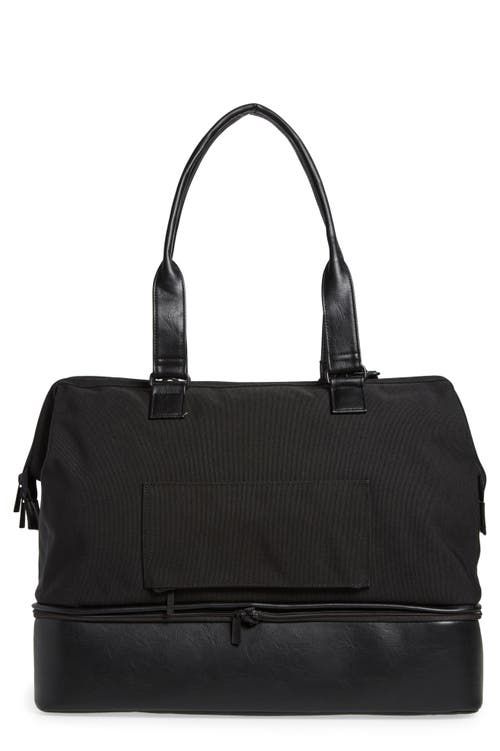
This tote brings two-for-one power with a removable bottom compartment that can be used as is, or as a separate packing cube. Easy to clean polyester and polyurethane make it a cinch to keep looking like new, with a built-in luggage sleeve and removable laptop sleeve give it plenty of function for that rush through TSA.
Tumi Voyageur Just in Case Packable Nylon Tote
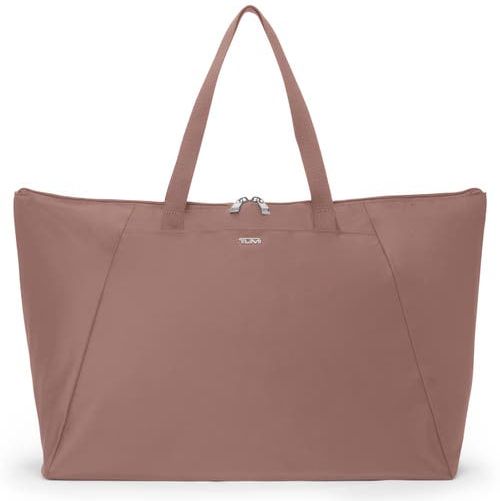
Some people pack an extra suitcase when traveling abroad. We propose this packable Tumi tote instead. It folds out to an impressive 8" x 14" x 8 size when fully opened and weighs less than a pound, so you can shop to your heart's content while getting those passport stamps.
More: The 13 Best Luggage Brands for Every Type of Traveler
Carhartt Legacy Tote East/West
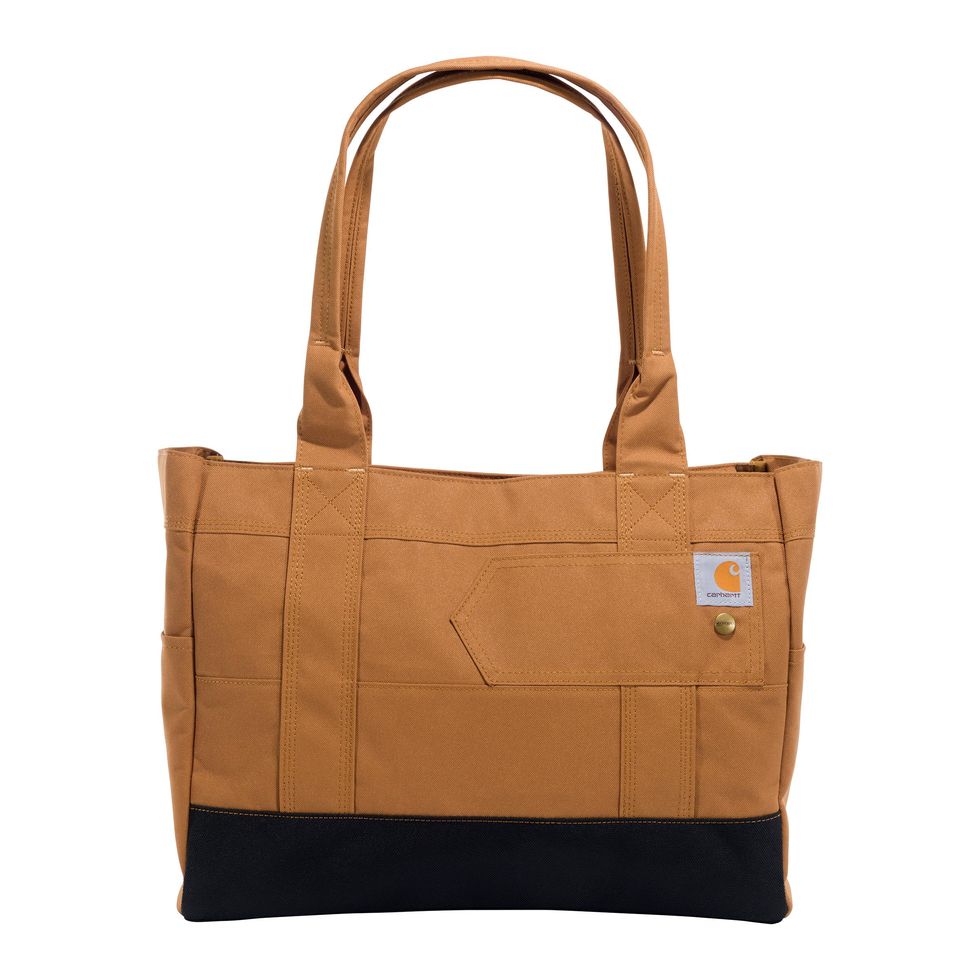
Built to work hard, this water-repelling polyester Carhartt bag is tough enough to handle all of your travel adventures. It includes two exterior pockets as well as an interior divider and pockets, so it's and functional on the inside as it is on the outside.
One reviewer writes: "Even better than expected! I used it as my personal item for a trip to Mexico…placed my purse, tablet, magazines, etc inside…lots of pockets! Hides dirt, wipes off easily, very well made."
Revive Nylon Large Tote

Available in five-shades, this nylon tote (made with fabric crafted from 27 recycled water bottles with recycled leather trim) has jumbo exterior slip pockets (plus three interior pockets and a keyring) and a built-in padded laptop sleeve to match its roomy interior with organization.
One reviewer writes: "Great color, roomy, lots of pockets to keep things organized and easy to locate. Perfect for work and travel. Very happy with it."
Dagne Dover Jemi Tote
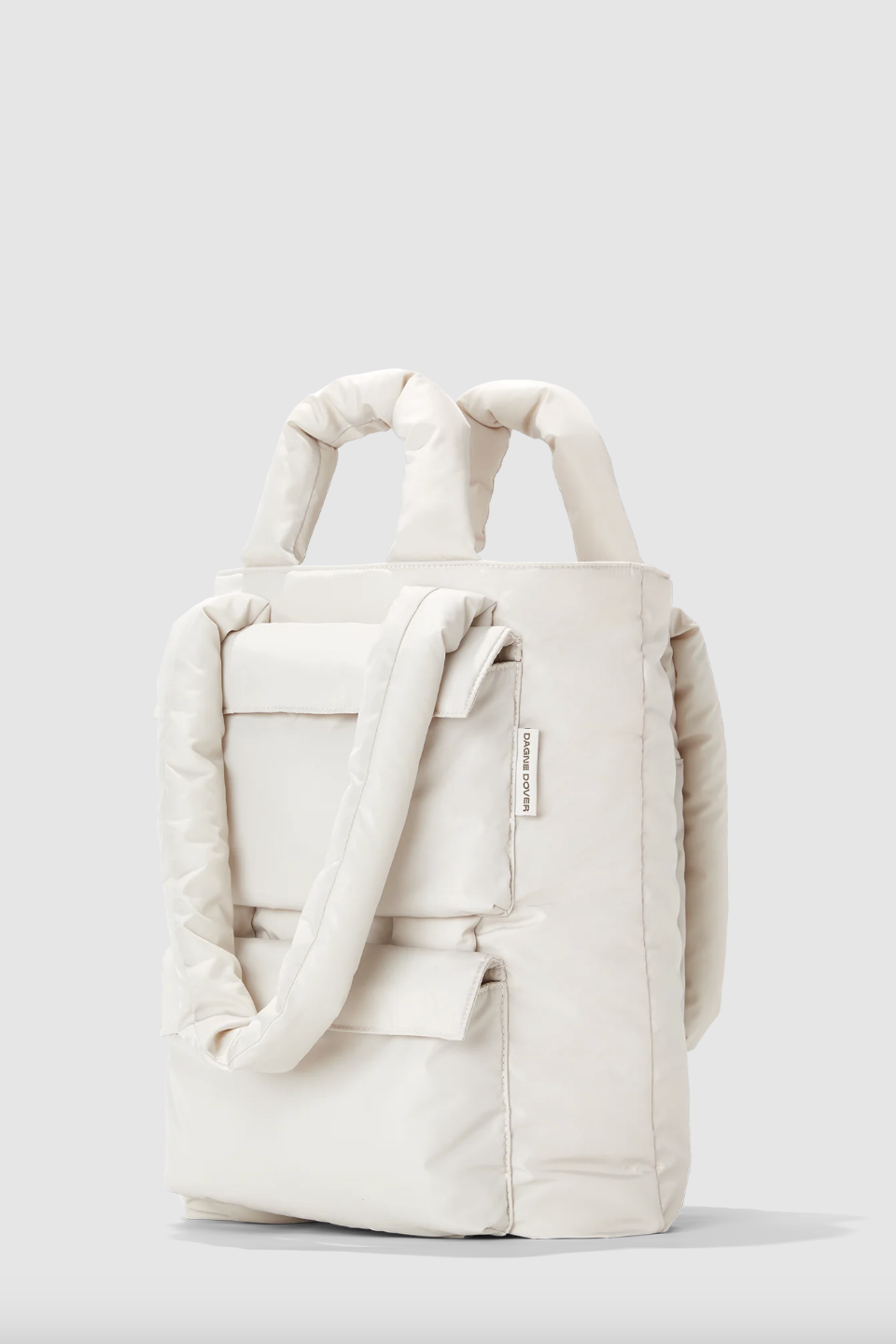
Want a travel tote that makes a style statement? Bring your puffer coat style to your bag with this versatile, vegan tote made from recycled plastic water bottles. At less than a pound and half (it holds 16.2 L volume), it's super lightweight, and has two sets of comfy handles—one for hand-held use and one for shoulder use—plus a luggage sleeve, so it's great no matter your travel style.
Naghedi Jet Setter Small Tote
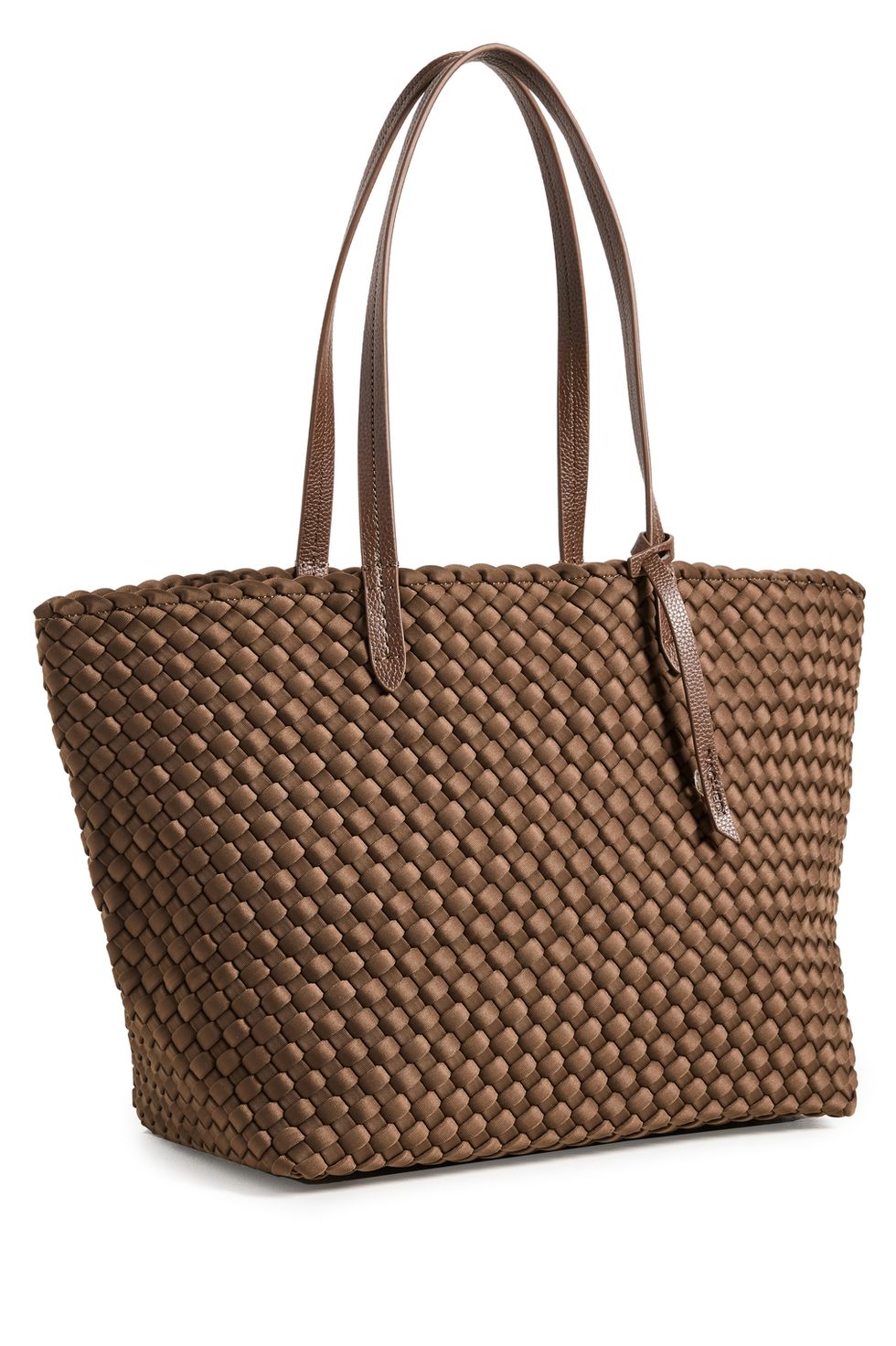
Fully lined, basket-woven neoprene brings beautiful texture to this travel tote, making it ideal for those situations when you have to go straight from the plane to an event. It also has a zip closure and zippered interior pocket to ensure that your stuff stays in place even on the wildest travel days.
Scout Travel Bag Large

You want all of the weight in your travel bag to be from your must-haves, not from the bag itself. This colorful version from Scout (it comes in half a dozen colors and patterns) is a featherlight 1 pound, yet can hold up to 65 pounds of your gear, and can fold flat when not in use. It also comes with a zipper pocket and reinforced bottom so everything you pack stays comfortable where you want it.
Barbour Medium Travel Explorer Leather Tote Bag
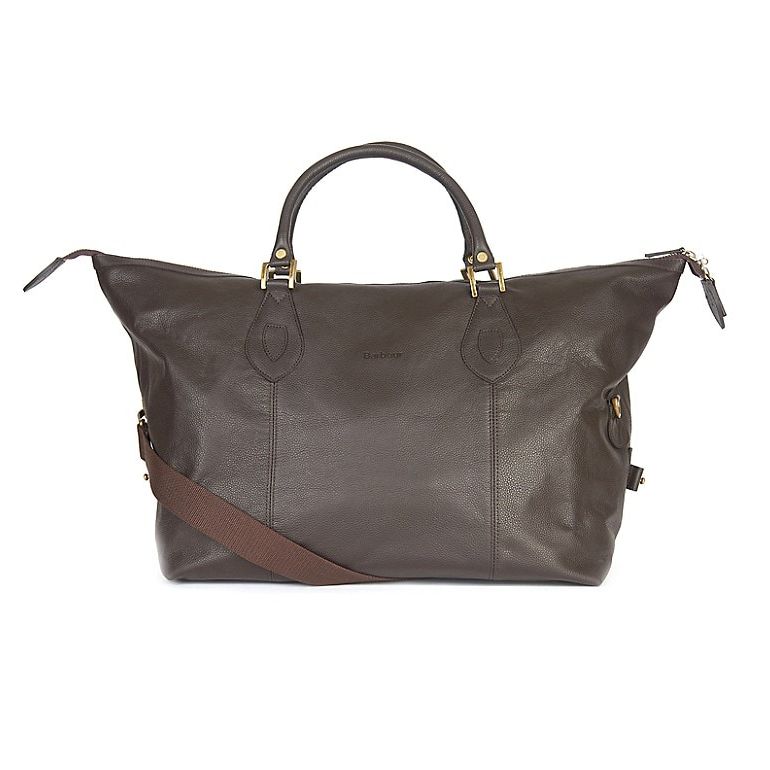
The biggest name in waxed cotton jackets brings their British heritage sensibility to travel with this luxe 100% leather tote. Measuring 17.72'' x 14.96'', it comes with sturdy top handles and an adjustable shoulder strap for comfortable carrying.
More: The 13 Best Luxury Luggage for Traveling in Style
WONHOX Large Travel Tote Bag
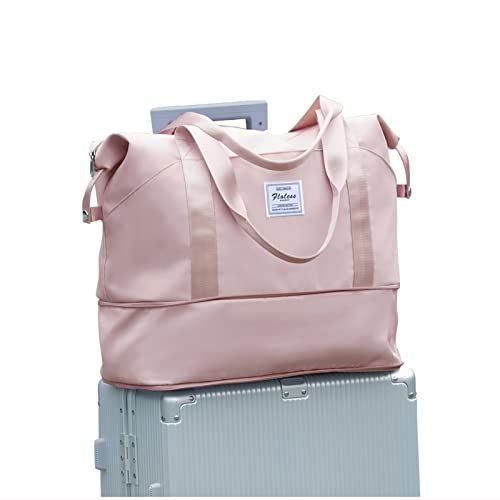
This waterproof travel tote features a luggage sleeve, three interior pockets, including a special compartment to separate wet and dry items (looking at you, still-damp swimsuit) and four external pockets, as well as a zip-open expansion on the bottom so your bag can be as big, or small, as you need.
One reviewer writes : "Schlepped this bag all over Europe and it holds a surprising amount of stuff! The little expander area on the bottom really helped me squeeze in a few extra souvenirs. The trolley sleeve is a MUST from now on. It hooks on to your roller suitcase so easily and is sturdy! I was throwing my baggage up on the train, in and out of taxis and through many airports easy peasy."

Lauren Hubbard is a freelance writer and Town & Country contributor who covers beauty, shopping, entertainment, travel, home decor, wine, and cocktails.

@media(min-width: 40.625rem){.css-1jdielu:before{margin:0.625rem 0.625rem 0;width:3.5rem;-webkit-filter:invert(17%) sepia(72%) saturate(710%) hue-rotate(181deg) brightness(97%) contrast(97%);filter:invert(17%) sepia(72%) saturate(710%) hue-rotate(181deg) brightness(97%) contrast(97%);height:1.5rem;content:'';display:inline-block;-webkit-transform:scale(-1, 1);-moz-transform:scale(-1, 1);-ms-transform:scale(-1, 1);transform:scale(-1, 1);background-repeat:no-repeat;}.loaded .css-1jdielu:before{background-image:url(/_assets/design-tokens/townandcountrymag/static/images/diamond-header-design-element.80fb60e.svg);}}@media(min-width: 64rem){.css-1jdielu:before{margin:0 0.625rem 0.25rem;}} Travel @media(min-width: 40.625rem){.css-128xfoy:before{margin:0.625rem 0.625rem 0;width:3.5rem;-webkit-filter:invert(17%) sepia(72%) saturate(710%) hue-rotate(181deg) brightness(97%) contrast(97%);filter:invert(17%) sepia(72%) saturate(710%) hue-rotate(181deg) brightness(97%) contrast(97%);height:1.5rem;content:'';display:inline-block;background-repeat:no-repeat;}.loaded .css-128xfoy:before{background-image:url(/_assets/design-tokens/townandcountrymag/static/images/diamond-header-design-element.80fb60e.svg);}}@media(min-width: 64rem){.css-128xfoy:before{margin:0 0.625rem 0.25rem;}}
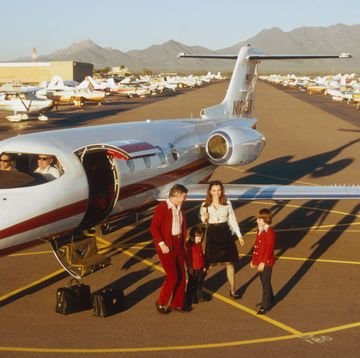
The Best Carry-On Backpacks for Every Traveler
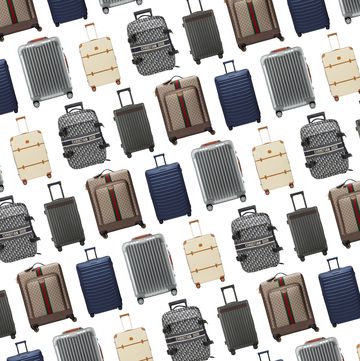
The Best Luxury Luggage for Traveling in Style
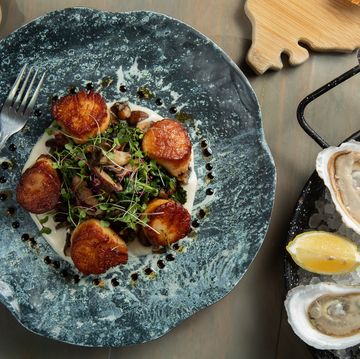
Where to Dine in Myrtle Beach, According to Locals
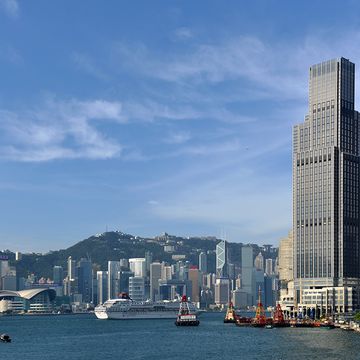
Best Room At… Rosewood Hong Kong

The Best Room at... Westin Palace Milan
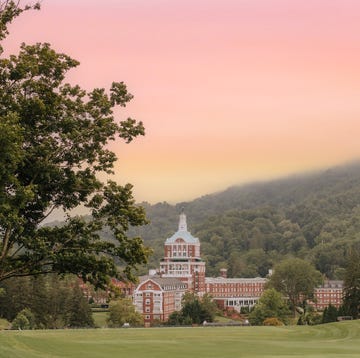
An Omni Homestead Resort Itinerary for Everyone
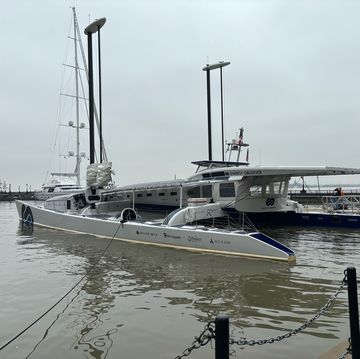
Step Inside an Experimental Hydrogen Boat

Best Room At... Hotel Chelsea

Best Room at Principe di Savoia
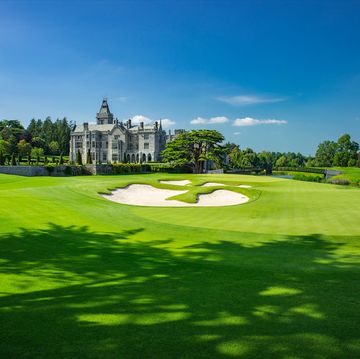
The Best Golf Course in Ireland Is at Adare Manor
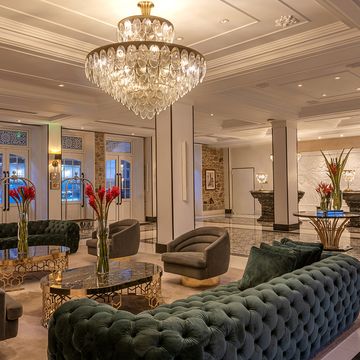
Best Room At... Hotel La Compañia
- Search Please fill out this field.
- Manage Your Subscription
- Give a Gift Subscription
- Sweepstakes
- Disney Vacations
The Ultimate Guide to Magic Kingdom, According to Disney Experts
Here's everything you need to know to plan the perfect day in Magic Kingdom, including the best rides, restaurants, and more.
Jacqueline Dole is a freelance food and travel journalist based in Maine. A lifelong New Englander, her work has appeared in Travel + Leisure , Food & Wine, TimeOut, Insider, Thrillist, Eater, and more. With a background as a pastry chef, she’s always on the lookout for the next best snack. She is a theme park enthusiast and expert, and embroidered hotel robes, amazing pools, and hot dogs are some of her favorite things.
Planning Your Visit
- Getting to Magic Kingdom
- Best Rides and Attractions
- Entertainment
Best Restaurants
- Magic Kingdom Itinerary
Tips for a Magical Day at Magic Kingdom
Valerie de Leon/Travel + Leisure
When the Magic Kingdom opened its gates on Oct. 1, 1971, it became an iconic place to not only see favorite Disney characters but to experience innovative attractions and visit lands carefully crafted to transport guests to another time or place. No trip to Walt Disney World would be complete without a visit to the Magic Kingdom. The most popular park at the Florida resort is also the most-visited theme park in the entire world, with more than 17 million visitors in 2022, according to the Global Attractions Attendance Report .
With this popularity comes crowds, so knowing how to best navigate the park is vital to ensure a great experience. “Walt Disney World is complicated in a way that's different from almost any other vacation destination. There are far more people who want to ride Disney's best rides and eat at Disney's best restaurants than there is ride and restaurant capacity for them. You'll need to make reservations for the popular rides and restaurants or risk not getting to them,” says Len Testa, co-author of " The Unofficial Guide to Walt Disney World ."
Ready to plan your trip? Here's everything you need to know to plan a perfect day at Magic Kingdom.
Meet the Expert
Len Testa is the co-author of "The Unofficial Guide to Walt Disney World."
Samantha Davis-Friedman is a theme park journalist and contributing writer of “Walt Disney World Hacks, Second Edition.”
Matt Stroshane/Walt Disney World
“The two things to consider when visiting Walt Disney World are crowds and weather,” says Testa. “Walt Disney World's crowds are typically lowest when public schools are in session. The best weather is generally between November and March, with daytime highs between 75 and 80 degrees.”
Tickets can be purchased as either single or multi-day passes, and you can add the Park Hopper option to visit multiple parks a day. Single-day ticket prices are dynamic and vary depending on the day and park you’re looking to visit, ranging between $134 to $189 for 2024. While park hours vary throughout the year, currently Magic Kingdom is open from 8 a.m. to 11 p.m.
Guests staying at Disney hotels (and select other hotels) can take advantage of Early Entry to enter the park 30 minutes before it officially opens. Guests staying at a Disney Deluxe Resort or other select hotels can enjoy Extended Evening Hours after the park closes on select nights.
Getting to Magic Kingdom
Valerie de Leon/Travel + Leisure
Guests cannot park outside of the gates of the Magic Kingdom and must park across the Seven Seas Lagoon at The Transportation and Ticket Center, otherwise known as the TTC. From there, guests can take a ferry or monorail to arrive at the park gates. “My motto is 'take the one that’s there' – sometimes that’s the monorail and sometimes it's the ferry. Either way, it’s nice to start the day without a wait (if possible) since there will certainly be plenty of waiting to come," says Samantha Davis-Friedman, theme park journalist and contributing writer of “Walt Disney World Hacks, Second Edition” .
Only Walt Disney World Resort buses and "Minnie Vans" (Lyft’s exclusive Walt Disney World car service offering select perks), can drop visitors off directly outside of the park. Third-party shuttles typically drop riders at the TTC.
Standard parking is $30 per day, preferred parking varies seasonally between $45 and $55 per day, and oversized vehicle parking is $35 per day. If you’re park-hopping, good news: Guests only need to pay one fee for a parking pass that is good all day at all four theme parks.
Guests staying at select Magic Kingdom area resorts can also take the monorail or a boat from their hotel.
Best Rides and Attractions
Younger guests shouldn’t miss out on the rides in Fantasyland, like The Many Adventures of Winnie the Pooh and Peter Pan’s Flight. Thrill-seeking visitors should make a point to ride Big Thunder Mountain Railroad, Space Mountain, and Tron Lightcycle Run . For fans of classic Disney, no trip is complete without a stop at The Enchanted Tiki Room, a ride on the Tomorrowland Transit Authority PeopleMover, and a spin through Walt Disney’s Carousel of Progress, which originally debuted at the 1964 New York World's Fair. Pirates of the Caribbean and The Haunted Mansion are perennial favorites among guests of all ages. And Tiana's Bayou Adventure is bound to be an instant hit when it opens this summer.
The best way to optimize time within the parks is to utilize Genie+ and Individual Lightning Lanes , an update on the previously complimentary FastPass system. These benefits come at an additional cost, but time in the parks is valuable and sometimes, it’s best to spend extra money to avoid lost time in line. The cost varies by park and date, generally ranging between $16 to $35 per day.
Testa recommends purchasing Individual Lightning Lanes (ILL) for sought-after attractions like Seven Dwarfs Mine Train.
Related: 58 Disney World Rides and Attractions, Ranked From Worst to Best
Entertainment
Let the Magic Begin and Mickey’s Magical Friendship Faire are stage shows that run several times throughout the day and feature Mickey and his pals, Tiana and friends from "The Princess and the Frog," and more.
The Disney Adventure Friends Cavalcade is an abbreviated parade that runs through the park and features characters from "Encanto," "Coco," and more. The Disney Festival of Fantasy Parade features incredible floats, a long list of characters, and a great soundtrack.
Happily Ever After is the park's current nighttime spectacular featuring projections, lasers, special effects, and of course, fireworks. While finding a spot in front of the castle is key if you want to catch the projections, the show is still extremely enjoyable when viewed from other, often less crowded, spots. My favorites are Tomorrowland and Fantasyland (and it's a bonus if you are onboard the PeopleMover or Seven Dwarfs Mine Train while fireworks are exploding in the sky above you).
Walt Disney World
Visitors looking to maximize their time in the parks should opt to order from quick-serve locations, preferably with mobile orders. Sleepy Hollow is a great stop for breakfast, offering an extremely popular fresh fruit waffle sandwich. Cosmic Ray’s Starlight Cafe is a reliable stop for burgers and chicken strips. It’s also home to Sonny Eclipse, a beloved animatronic performing lounge tunes all about his home planet Zork in the dining room. Casey’s Corner offers hot dogs, corn dog nuggets, and french fries. If you’re looking for non-fried choices, Columbia Harbor House serves New England-inspired seafood dishes.
Guests who want to get up close with their favorite friends can make a reservation for a character meal at Cinderella’s Royal Table to dine with princesses or The Crystal Palace for a meal with Pooh and friends. Other standout table-service restaurants are Be Our Guest, Jungle Navigation Co. LTD Skipper Canteen, and Tony’s Town Square Restaurant, thanks to a recent menu overhaul that makes it a fantastic place to enjoy a glass of wine on the patio, especially while a parade passes by.
Snack fiends, be prepared: there are a lot of can’t-miss Disney World foods , including pineapple upside-down cake topped with Dole Whip from Aloha Isle, cheeseburger spring rolls at The Spring Roll Cart, and the pepper jack pretzel from Cheshire Cafe.
Related: 30 Best Disney World Restaurants
Magic Kingdom Itinerary
Be ready to book your first Genie+ selection and join the virtual queue for Tron Lightycle Run at 7 a.m. If you miss the 7 a.m. window, there is another chance to join the Tron virtual queue at 1 p.m. from inside the park. If you’re staying on property, be ready to enter the park when Early Entry begins. Otherwise, be prepared to rope drop as soon as the park opens. Head to the most popular rides first to take advantage of the shortest lines you’ll likely see all day. Seven Dwarfs Mine Train, Peter Pan's Flight, Jungle Cruise, and Space Mountain develop some of the highest wait times as the day goes on. From there, tackle the park by land, and don’t forget to take your time and enjoy. Continue to utilize Genie+ to book return times for attractions — or if you’ve opted to pass on the additional purchase, keep an eye on wait times in the app to head to the shortest lines. Try to spot a parade along the way, and end your day with Happily Ever After.
- “Be at the park, admission in hand, 60 minutes before the official opening. On most days, Disney will let you into the park and allow you to line up for your first ride well before the park opens. This is a tremendous advantage over those who can't get up and out the door that early. You'll be well on your way to your second (or third) ride before most people have gone through the turnstiles,” says Testa.
- Be prepared for the weather. “No matter what time of year you go to Magic Kingdom, it will likely rain — and it’s always A LOT of rain. Because I have been caught unprepared for rain at Walt Disney World (more than once), I now carry a pair of inexpensive, lightweight flip-flops in my backpack. That way, I can quickly swap out my sneakers and socks to keep them dry (this works well on water rides too!),” says Davis-Friedman.
- If you plan on spending a lot of time at Magic Kingdom, consider splurging to stay at a neighboring hotel. Guests can walk directly to the park from Disney’s Contemporary Resort and Disney’s Grand Floridian Resort. This convenience will save you a lot of time and hassle if you plan on staying until the park closes.
- For those looking to avoid the post-fireworks crowds, consider watching them from the neighboring resorts. Diners at The California Grill located on the top floor of Disney’s Contemporary Resort have access to a viewing deck that pipes in the show’s sound, as does the beach at Disney’s Polynesian Village Resort.
- Some of the best parts of a day in Magic Kingdom aren’t just the moments of soaring through Big Thunder Mountain or passing by hitchhiking ghosts inside The Haunted Mansion; they’re the magical moments in between, like having a spontaneous dance party with The Country Bears or spotting the names of several key Imagineers on the windows along Main Street U.S.A.
More From Forbes
8 hotels with gallery-worthy art collections.
- Share to Facebook
- Share to Twitter
- Share to Linkedin
The Langham, Boston has more than 250 pieces of art.
These days, there’s no need to visit a museum to see otherworldly art when you’re on vacation. Many of the nation’s top hotels are dabbling in the illustrious world of collecting themselves. It’s not unusual for a boutique hotel to partner with a local gallery to display a rotating array of pieces or for a property to commission new works to unveil in its lobby or garden.
Here, we highlight eight properties that have such amazing art collections they could charge a separate fee to tour their halls.
The Langham, Boston
Art and history collide at The Langham, Boston, a Forbes Travel Guide Four-Star hotel with a collection curated by Richmond International. Many of the 268 pieces reflect a connection to the building (the property was once the Federal Reserve Bank of Boston ) or the surrounding area’s history. During a 2021 renovation, the hotel worked with the nonprofit Copley Society of Art to commission 60 new pieces, such as Samuel Gareginyan’s abstract portrait John Singleton Copley , displayed in the lobby. Hotel guests are invited to take a self-guided tour featuring videos and recordings of the artists who created the works.
Other pieces include N.C. Wyeth’s Abraham Lincoln mural, initially commissioned by the bank; eight portraits of the bank’s former presidents by Debra Keirce; and a 7-foot hanging wire sculpture of the Lady Liberty coin head by artist Lyle London.
"Safety" by Giuseppe Palumbo.
$300 Billion ‘Perfect Storm’ Bitcoin Price Crash Under $60,000 Suddenly Accelerates As Ethereum, XRP And Crypto Brace For Shock Fed Flip
The top 10 richest people in the world (may 2024), toyota s suv lineup is new and refreshed which one is right for you.
The St. Regis San Francisco
Given the Five-Star hotel’s location between two of the city’s famed museums, the San Francisco Museum of Modern Art and the Museum of the African Diaspora, it makes sense that it takes its art collection seriously. Everywhere you look in the hotel, from the patio to the lobby, you’ll find brilliant pieces.
Safety is a giant safety pin sculpture by Giuseppe Palumbo in front of the hotel. It represents support and solidarity for the repressed and marginalized. In the reception area, a painting titled Solitude by Randy Hibberd depicts an abstracted city nestled within San Francisco . Gold accents mimic the golden sunlight reflecting off the Bay. In the dining room, a dreamy landscape titled Mountain Mist by Janie Rochfort reflects a unique watercolor style. Rich olives and lighter pinks capture the fluid colors of a San Francisco sunset.
Eddie Perrote’s work can be seen at MacArthur Place Hotel & Spa.
MacArthur Place Hotel & Spa
Check out the artist-in-residence program at Sonoma ’s MacArthur Place. In partnership with Uprise Art, the Four-Star resort welcomes artists to stay and hosts open studios where they create art and explain their processes to any interested parties. The first resident of 2024 was New York-based abstract painter Eddie Perrote (March 31 through April 5). Painter Mia Farrington (May 19 to 24) and graphic sculptor Dan Covert (July 7 to 12) are next to call the hotel their temporary homes.
Art created during the residency becomes a permanent part of the hotel’s collection. MacArthur Place also partners with Aerena Galleries, a wine country gallery representing an impressive roster of emerging and established artists. Sculptures from Aerena, like a giant corkscrew by David Tanych and bronze wolf by Sharon Loper, are placed throughout the property.
The Aurora Inn offers many museum-quality moments.
The Aurora Inn
Philanthropist and entrepreneur Pleasant T. Rowland’s personal art collection is on display at this Upstate New York Four-Star charmer. Over 250 pieces hang throughout the guest rooms, hallways, restaurants and bathrooms, including works by Wayne Thiebaud, Helen Frankenthaler, David Hockney, Romare Bearden and Chuck Close. The entire collection is accessible thanks to an 80-page booklet showing each piece’s location on the campus.
Additionally, there are a number of pieces at the spa, from a series of florals, Big Blooms by Paul Lange, to a collage that makes up an Apple Tree by Jennifer Bartlett, that it feels like a modern museum.
The jaw-dropping "Resistance Reverb: Movements 1" by Lava Thomas.
HALL Arts Hotel
Appropriately sitting in the Dallas Arts District, Forbes Travel Guide Recommended HALL Arts Hotel features the extensive contemporary art collection of owners Craig and Kathryn Hall. The hotel largely works with a clean, modern aesthetic, with white walls everywhere, making for a fantastic way to showcase the art.
Lava Thomas’ Resistance Reverb: Movements 1 , a grouping of 600 pink tambourines, hangs in the lobby. It’s a gorgeous, glittering piece with fragments of political speeches excerpted from voices of women’s resistance spaced throughout, ranging from Sojourner Truth’s 1851 “Ain’t I a Woman” speech to Alicia Garza’s powerful “Black Lives Matter” message.
There are also paintings, more installations and photographs, some of which won the hotel’s photo competition. Learn more about the HALL Arts Hotel’s unique collection by participating in the exclusive art tour, taking place Thursday through Saturday from 4:30 to 5:30 p.m. with the property’s curator.
Fascinating pieces are everywhere you turn at The Nines.
The Nines, A Luxury Collection Hotel
More than 400 works are on view at Portland ’s The Nines, A Luxury Collection Hotel. Curated by Paige Powell, a former Andy Warhol confidante, the Forbes Travel Guide Recommended property’s collection has pieces from the likes of painter Chris Johanson, cartoonist John Callahan, filmmaker Gus Van Sant and emerging artist Nell Warren. A 35-foot hanging masterpiece, Bird Song by Melody Owen, is the grand stairwell chandelier. The work uses glass, LEDs and steel to illustrate the audio waves of bird songs native to the Pacific Northwest. It’s a breathtaking and original piece.
The Nines has also partnered with the Pacific Northwest College of Art to create abstract monotypes and silkscreen images throughout the guest rooms.
Shutters on the Beach
Santa Monica ’s Shutters on the Beach is a Four-Star getaway that feels more like a luxury beach house than a traditional hotel. With that vibe, it boasts a 28-piece collection of contemporary art curated by fine art adviser Cynthia Greenwald. Works from such luminaries as Ellsworth Kelly, Roy Lichtenstein and David Hockney are on view in the lobby, hallways and other public spaces.
One of Greenwald’s recent acquisitions, Coca-Cola Girl 1 by New York Pop artist Alex Katz, is displayed near the sundry shop. It’s a painting of a blond in a white swimsuit against a red backdrop that sparks thoughts of a leisurely afternoon at the beach. Much of the artwork exudes this same carefreeness, mirroring the beauty of the Southern California coast.
This Georgetown gem has a massive art collection.
Four Seasons Hotel Washington, D.C .
Significant works by Andy Warhol, Helen Frankenthaler, Fernando Botero and more are on view at this Five-Star gem in Georgetown . DTR Modern Galleries’ Jennie Buehler curated the 1,650-piece art collection, which includes modern acquisitions like Red Pears , a lush print by Northern Virginia-based painter Tanya Davis, and Paul Chojnowski’s Windows , a piece made by burning images into wood and paper.
Another head-turner in the lobby is Julia, Sara, Gary, Tiffany, Fabiana by Roni Stretch. The black and white portraits, covered in layers of opaque paint, converge to form images that are ghostly yet provocative.

- Editorial Standards
- Reprints & Permissions
You are using an outdated browser. Please upgrade your browser to improve your experience.
- Restaurants
- Best-of Guides
- MICHELIN Guide Ceremony
- My Favorites
- Subscribe to newsletter
- Booking partnership with OpenTable
- Booking partnership with Resy
- USA - English - USD
- In Photos: Every Three Key Hotel in New York City
The ins and outs of the most outstanding hotels in the city.
Hotels Travel MICHELIN Keys NYC hotels NYC

New York City by The MICHELIN Guide
See the New York City guide

In 2024, The MICHELIN Guide is announcing the first ever MICHELIN Keys — a brand new distinction that recognizes the most outstanding hotels across the world. Head here for everything you need to know about the new Key distinction, and visit this page to explore the full list of Key hotels in the United States.
The Three Key distinction is the highest hotel honor in The MICHELIN Guide. Earning One Key (80 properties) or Two Keys (33 properties) is difficult enough, but only 11 hotels earned Three Keys in the United States. Of those, four can be found in New York City. The Three Key hotels excel in all five criteria used to judge hotels by our Inspectors. But in this series , we thought it fitting to focus on just one of those criteria — the most photogenic of the five — architecture and interior design. Below, take a look at the interiors and exteriors of each of our four Three Key hotels in New York City.
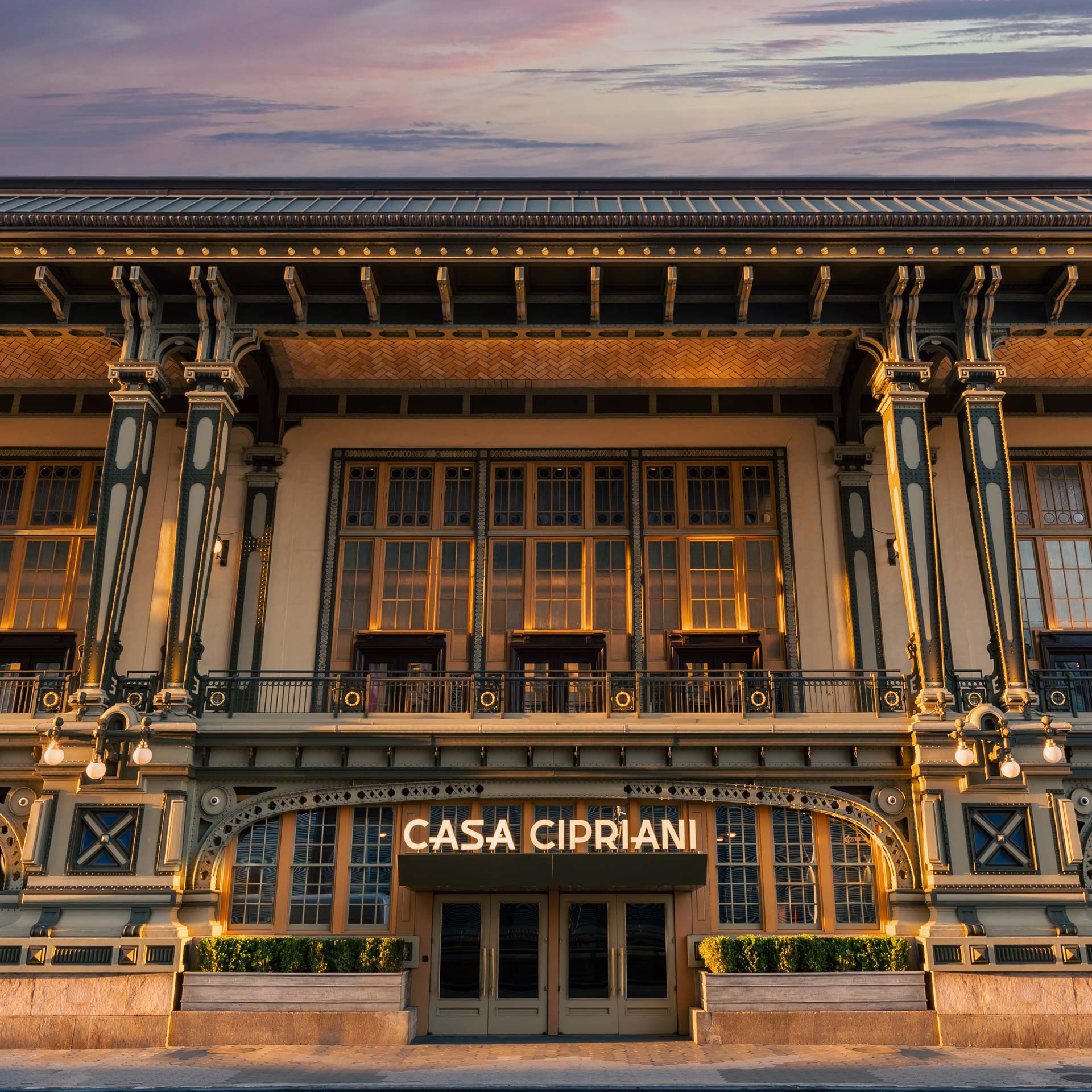
Casa Cipriani

Whitby Hotel

Aman New York

Crosby Street Hotel
Hero Image: © Aman New York

Rosewood Kona Village Breathes Luxurious New Life into Legacy
Ten years after a devastating tsunami destroyed it, Kona Village is back and better than ever.

Mikhail Baryshnikov's New York is an Ode to the City's Artists
The icon celebrates and champions the boldfaced names in the city from meat purveyors to Three Star chefs.

In Photos: Every Three Key Hotel in Spain
The ins and outs of the most outstanding hotels in the country.

Total Package: Key Hotels with Star Restaurants in Spain
21 spots that have it all in Spain.
Keep Exploring - Stories we think you will enjoy reading

Inside The Top Suite of Mallorca's Seaside Fortress Hotel
The “Sentinel Suite” at Cap Rocat is cut deep into the Mallorcan cliffside — where a cannon once sat guarding the sea.

Cristine Bedfor Is By Your Side in Menorca
Cristine Bedfor is charming, graceful, and generous. She’s a true bohemian and, if you find yourself in Menorca, a trustworthy confidant. She’s also a Key hotel.

The First MICHELIN Key Hotels: All the Keys in Spain
The MICHELIN Guide announces top honors for Spanish hotels in 2024.

The First MICHELIN Key Hotels: All the Keys in the United States
The MICHELIN Guide announces top honors for U.S. hotels in 2024.

The Most Outrageous Design Hotel In Miami
The Faena Miami Beach is a Two Key hotel with a $15 million gilded woolly mammoth.

A Brief Guide to All the Key Hotels in Washington D.C.
Seven hotels earned at least one MICHELIN Key in Washington D.C.

Inside the Top Suite of the Only Three Key Hotel in Big Sur
The so-called "Cliff House" has the views you're looking for.

SingleThread: The 5-Room Inn with Three Keys and Three Stars
Revered for its Three MICHELIN Star restaurant and biodynamic farm, the SingleThread Inn earns Three Keys for its tiny, food-driven hotel.
MICHELIN Guide

Use the app to find the best restaurants and hotels everywhere
Be the first to get news and update about the michelin guide.
MICHELIN Guide selections
The michelin group.
- Terms of Use
- Privacy Policy
- Legal Notice
Display settings
Customize your experience by easily adjusting display settings for territory, and currency to suit your preferences!
Member privileges
The Plus program provides upgrades and amenities at participating hotels. For this hotel, Plus members will receive:
Non-members can add the privileges at checkout through our 30 day free trial, cancellable at anytime.

IMAGES
VIDEO
COMMENTS
Your ultimate Venezuela travel guide, with tips, and things to see and things to do in Venezuela. Great for first-time and returning travelers. Rich with culture, history, and friendly locals, Venezuela is a chance to see something different. Located on the northern coast of South America, it is filled with many white-sand beaches, blue waters ...
Venezuela. South America. Venezuela, home to some of South America's most incredible landscapes, rightly has a terrible image problem at the moment. Hyperinflation has led to a dramatic drop in living standards and issues with the supply of basic goods, while personal safety, particularly in Caracas, is worse than anywhere else on the continent.
The best time to visit Venezuela as a tourist largely depends on your preferences and the type of experiences you seek, as the country has diverse climates and attractions. Here are two distinct seasons to consider: Dry Season (December to April): This is generally the most popular time to visit Venezuela.
About Venezuela. With its reputation for violence and political instability, many travellers opt to give Venezuela a wide berth. But those brave enough to visit this feisty South American nation will discover a country of extraordinary diversity and abundant natural beauty; a land of lofty Andean peaks, mysterious Lost World plateaus, wildlife rich rainforests, vibrant cities and idyllic ...
1) Salto Angel. Angel Falls, at 979 meters high, proudly boasts being the highest waterfall in the world. Located in the Venezuelan Gran Sabana, this is a place holding a sacred character for the natives. It is, without a doubt, the biggest out of all Venezuela tourist attractions.
Venezuela Travel Guide. 11 Top-Rated Tourist Attractions in Venezuela. 11 Top-Rated Tourist Attractions in Venezuela. Written by Lana Law May 4, 2020. Venezuela is a country of beautiful landscapes and surprising sights, from the coast to the mountain tops. Magnificent waterfalls tumble off table top mountains, and coastal towns and offshore ...
South America, Venezuela / May 22, 2023 by christin.theilig. Discover the hidden treasures of Venezuela's Caribbean Coast in this two-week Venezuela travel itinerary. In a land of enchantment and contrasts, expect to encounter pristine beaches fringed by lush jungles, colonial towns nestled amidst breathtaking landscapes, and vibrant cities ...
Venezuela Travel Guide: Visit Angels Falls and Mount Roraima. We both have different favourite places in Venezuela. Valery's favourite is Angel Falls. It's the highest waterfall in the world at a staggering 979m. The feelings and sensations of navigating the river to reach the base camp are indescribable!
Venezuela is replete with stunning natural wonders and sights such as countless national parks, magnificent waterfalls, and three UNESCO World Heritage Sites. The world's tallest waterfall, the Angel Falls (Kerepakupai Vená), is found here. Venezuela used to be one of South America's most politically and economically stable countries, but ...
Head upriver and overland in Venezuela to the highest waterfall in the world: Angel Falls. Swim with turtles in beautiful Caribbean archipelago Los Roques. Relax with some pampering massages between shopping trips and beach visits on Margarita Island. Pick up some Chocolates El Rey: they will change your perception of chocolate forever.
Check our travel guide to Los Llanos for more information. Venezuela travel tip: avoid local Bank Holidays In Venezuela, there are very few foreign travelers but domestic tourism is pretty big, especially during certain annual festivities. You may want to avoid traveling to Los Llanos, Canaima, Margarita or Los Roques during the following dates:
Venezuela Travel Guide. Unique traditional cultures and varied landscape are found within Venezuela along with the largest lake and third-longest river in South America. The best region in the country for mountaineering, hill trekking and rock climbing is Sierra Nevada de Mérida. Music is the most distinct cultural escape in Venezuela with ...
Venezuela travel guide. This young, vibrant, and varied country, at once Caribbean, Andean and Amazonian, has fabulous natural treasures for beachcombers and adventurers. In recent decades, Venezuela has gained a reputation as a thorn in the side of the United States. Led by the charismatic and divisive Hugo Chávez until his death in March ...
Get information on Venezuela Travel Guide - Expert Picks for your Vacation hotels, restaurants, entertainment, shopping, sightseeing, and activities. Read the Fodor's reviews, or post your own.
South America. A sprawling metropolis choked with traffic, Caracas incites no instant love affairs. The political and cultural capital of Venezuela is densely overpopulated and hectic, with a solid dose of crime and pollution. Few sections of the city are pedestrian-friendly, most are downright dangerous and after dark, it's strictly taxis only.
Day 1 - Reach Venezuela | Stay in Ciudad Bolivar, Venezuela. Day 2 - Fly from Ciudad Bolivar to Cainama. Day 3 - Boat Riding to Angel Falls. Day 4 - Getting Back to Ciudad Bolivar. Day 5 - Exploring Kukenan River. Day 6 - Reaching the Roraima Falls. Day 7 - The Roraima Summit and Packing-up. First off, a few reminders before ...
Welcome to the Venezuela Travel Guide! Very few countries can boast quite so diverse and spectacular natural beauty as Venezuela. From the stunning Angel Falls through to the Los Llanos grasslands, Los Roques archipelago, and the sumptuous Medanos de Coro desert - this country is the perfect match for any traveler with a hefty dose of wanderlust.
Call us in Washington, D.C. at 1-888-407-4747 (toll-free in the United States and Canada) or 1-202-501-4444 (from all other countries) from 8:00 a.m. to 8:00 p.m., Eastern Standard Time, Monday through Friday (except U.S. federal holidays). See the State Department's travel website for the Worldwide Caution and Travel Advisories.
South America Tours. Our Expert Travel Consultants have created a list of the Top 2 Venezuela Tours, highlighting Venezuela's most scenic sites, including the Caribbean coast, wondrous Angel Falls, and exotic Mount Roraima. Additionally, all our Venezuela vacation packages are customizable and can be combined with multiple destinations ...
Visitor Information. Good tourist information on Venezuela is hard to come by. The country's Ministry of Tourism (MINTUR; tel. 0800/887-4766; www.mintur.gob.ve) offers precious little in the way of information or help geared toward individual travelers, and their website is entirely in Spanish. Your best bet is to search the Internet, or deal directly with hotels and tour operators working in ...
10 Amazing places to see and things to do in Venezuela! 1. Caracas City Tour - This is a full day tour that will allow you to see the real capital city of Caracas behind the stories and news reports. You can even visit museums and ride a cable car at Avila National park. 2.
Travel. See Guide. Travel. See Guide. National Geographic's latest travel stories about Venezuela.
Fun Facts about Venezuela for Kids. Population: 30 million people live in Venezuela (2022) Capital: Caracas with 3 million inhabitants. Name: Bolivarian Republic of Venezuela. Government : federal presidential republic. Official Language: Spanish. Religion: more than 95% are Christians.
Don't let these vaunted names fool you into thinking you need to spend a fortune to get a good meal in Napa. The valley is filled with scores of reasonably-priced restaurants including Heritage Eats in Napa where you can feast on comfort foods like a smoked ham bowl or white cheddar mac and cheese for less than $15 a person. For tasting menus, Thomas Keller's ad hoc offers a daily tasting ...
Those who qualify for the daily living part are given either a lower rate of £72.65 per week or a higher rate of £108.55, and those who qualify for the mobility part either receive £28.70 or £ ...
After amassing a windfall from the 2001 George W. Bush tax cuts for high earners, Rick Steves donated $1 million to support the local symphony and performing arts center. In 2005, he used ...
This waterproof travel tote features a luggage sleeve, three interior pockets, including a special compartment to separate wet and dry items (looking at you, still-damp swimsuit) and four external ...
Tickets can be purchased as either single or multi-day passes, and you can add the Park Hopper option to visit multiple parks a day. Single-day ticket prices are dynamic and vary depending on the ...
Art and history collide at The Langham, Boston, a Forbes Travel Guide Four-Star hotel with a collection curated by Richmond International. Many of the 268 pieces reflect a connection to the ...
The Three Key distinction is the highest hotel honor in The MICHELIN Guide. Earning One Key (80 properties) or Two Keys (33 properties) is difficult enough, but only 11 hotels earned Three Keys in the United States. Of those, four can be found in New York City. The Three Key hotels excel in all five criteria used to judge hotels by our Inspectors.